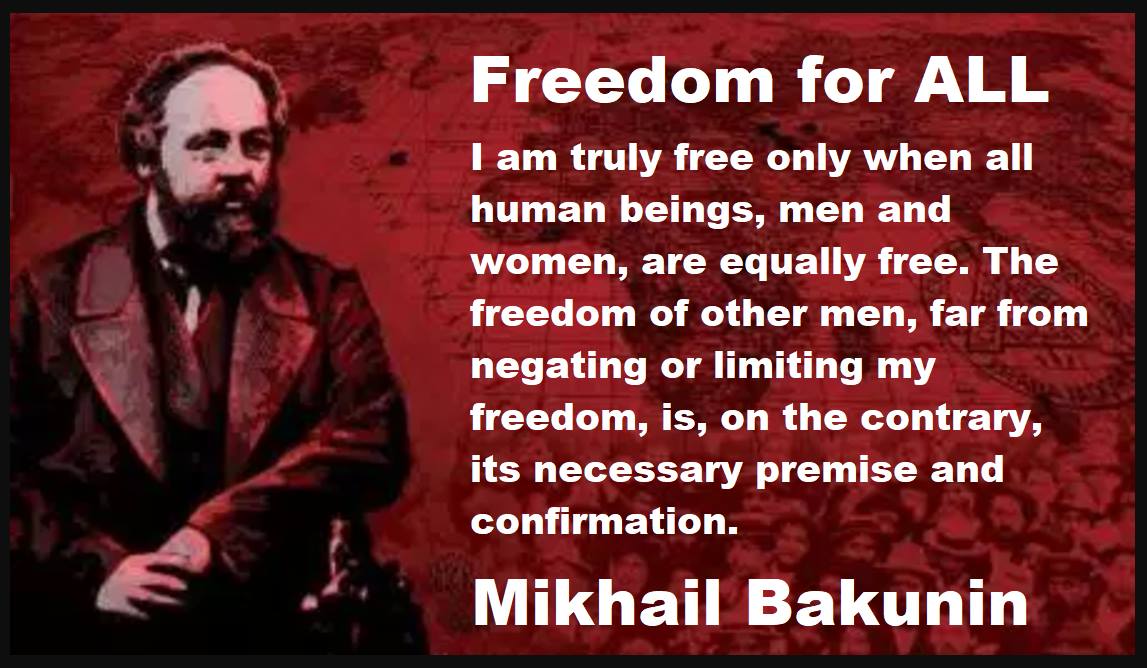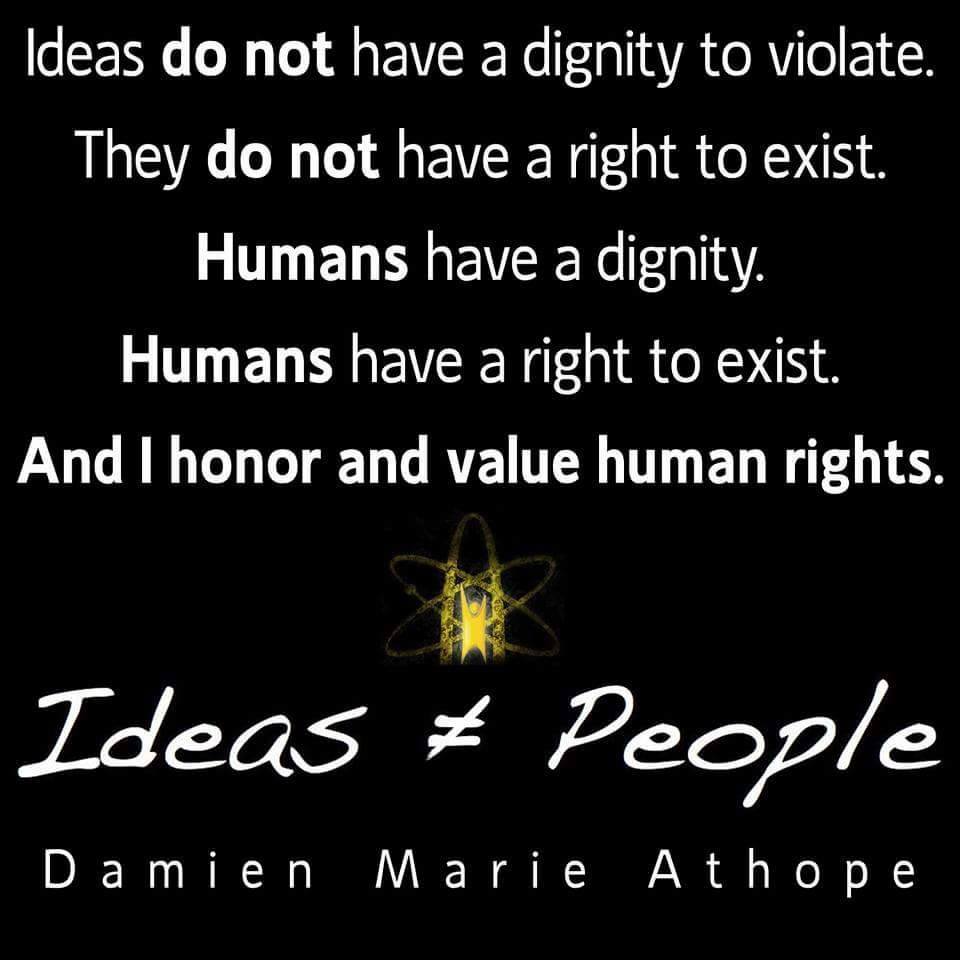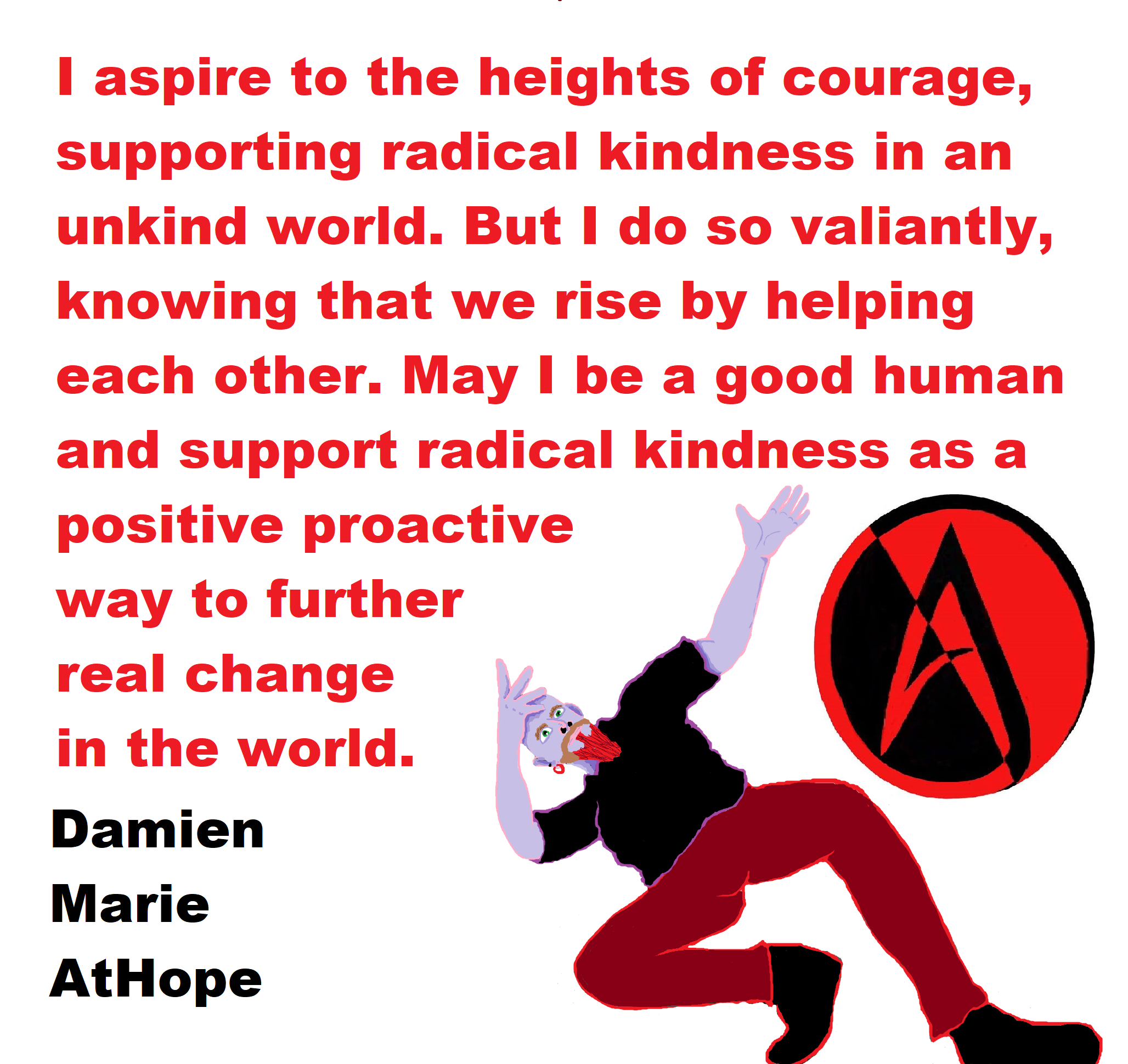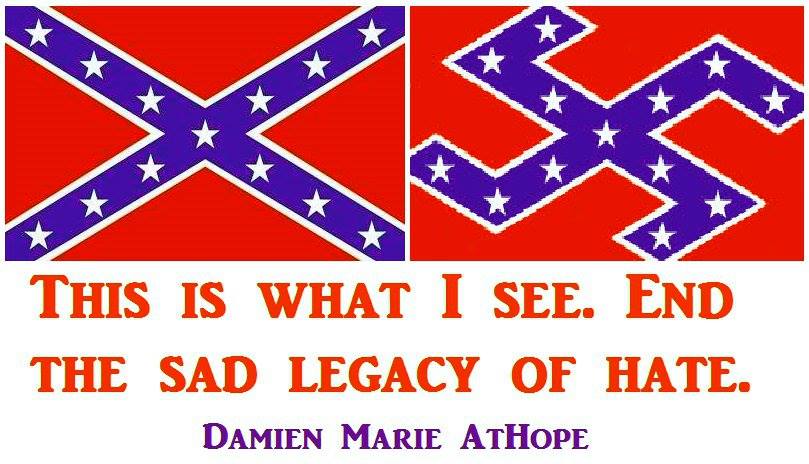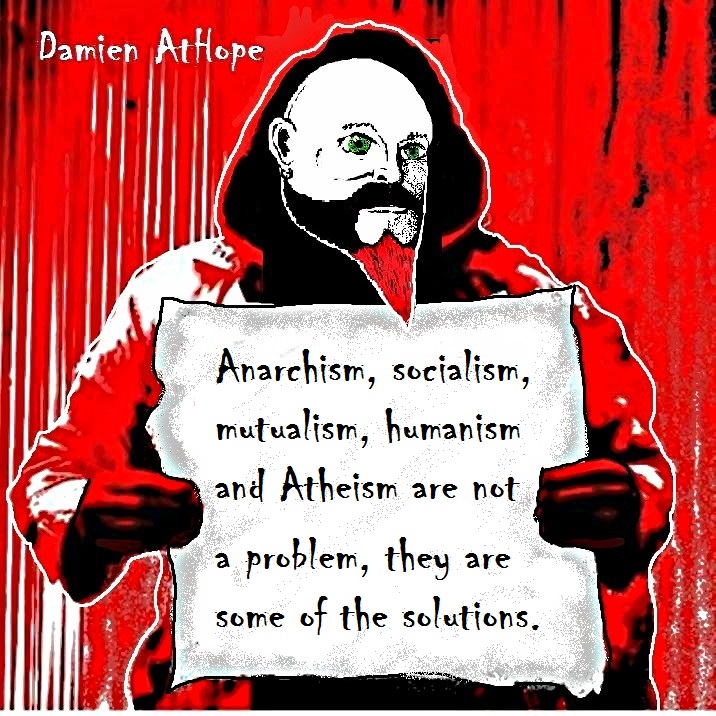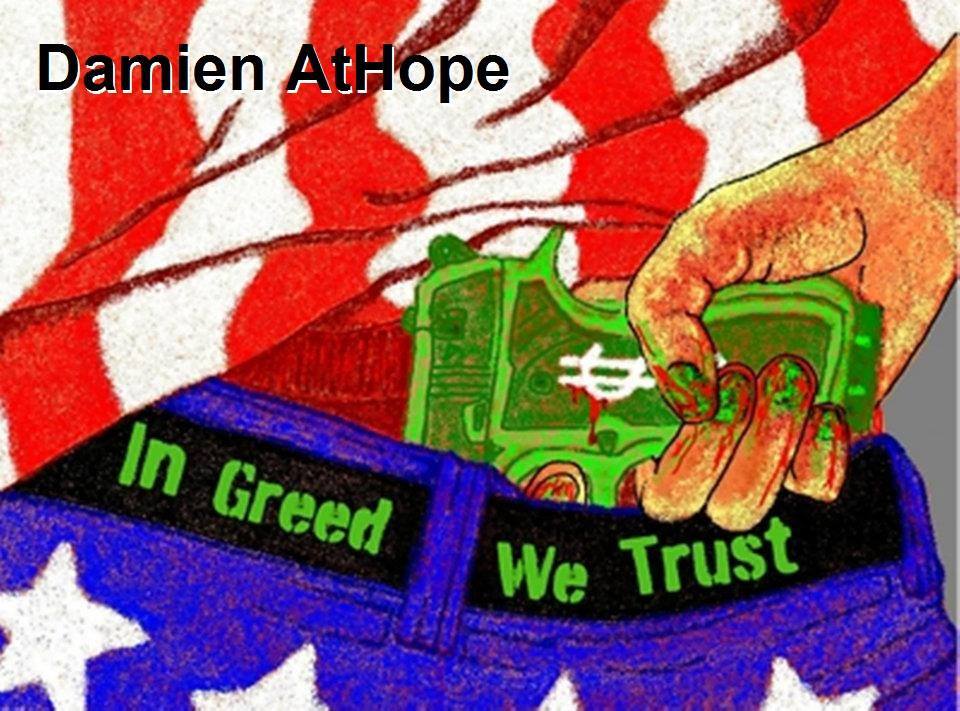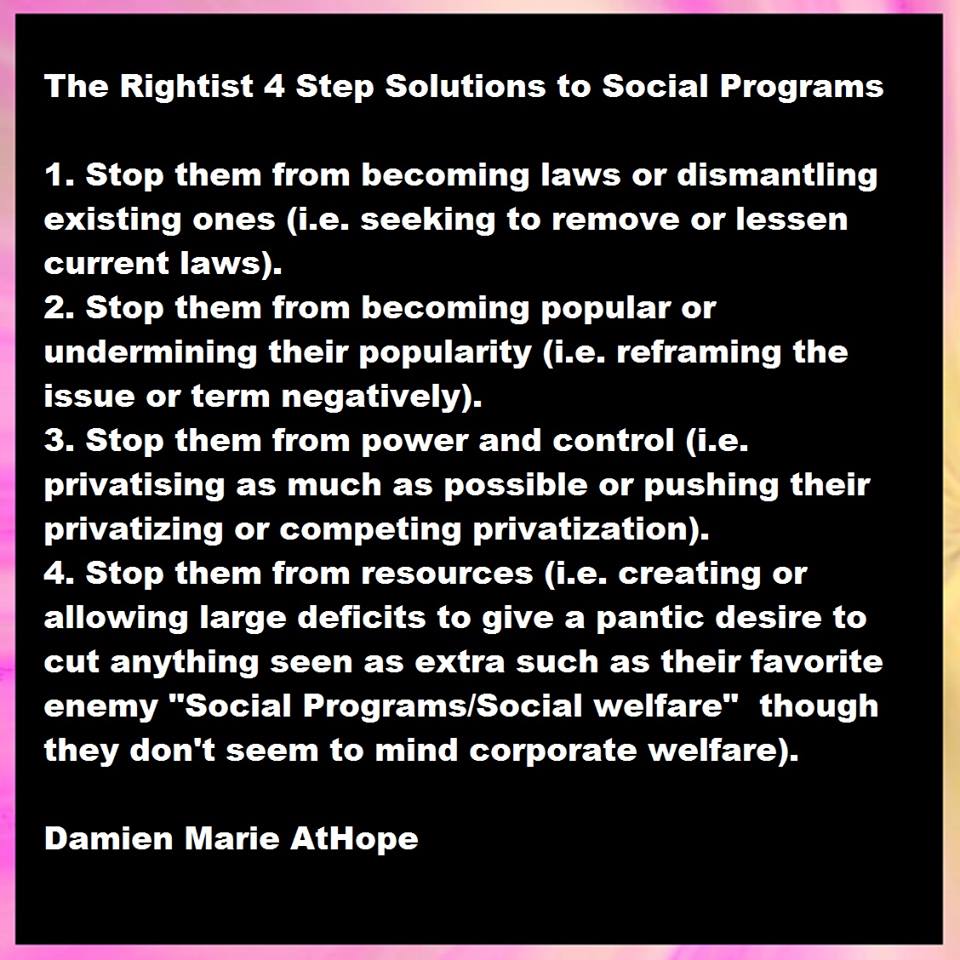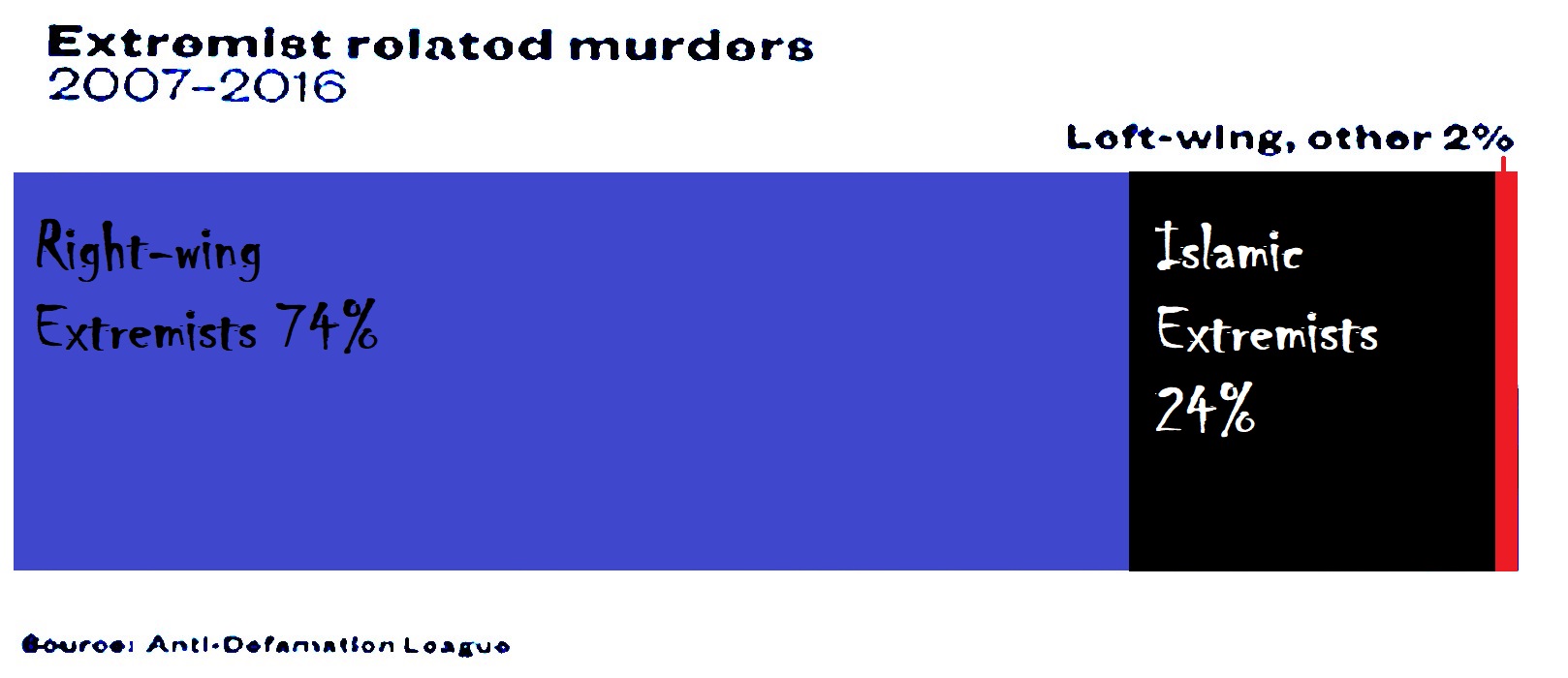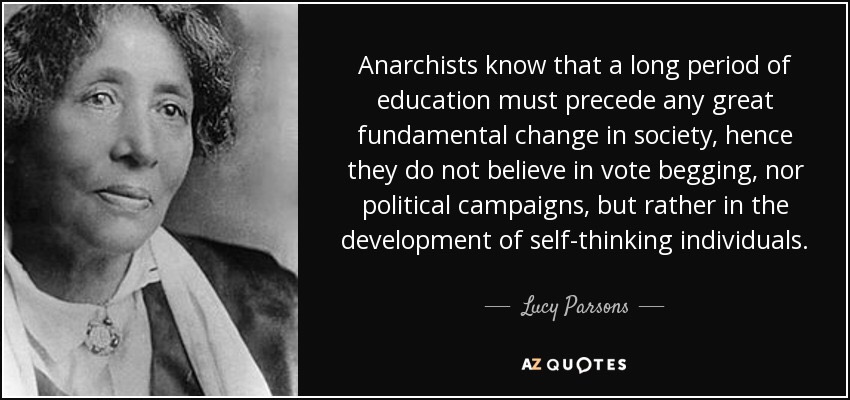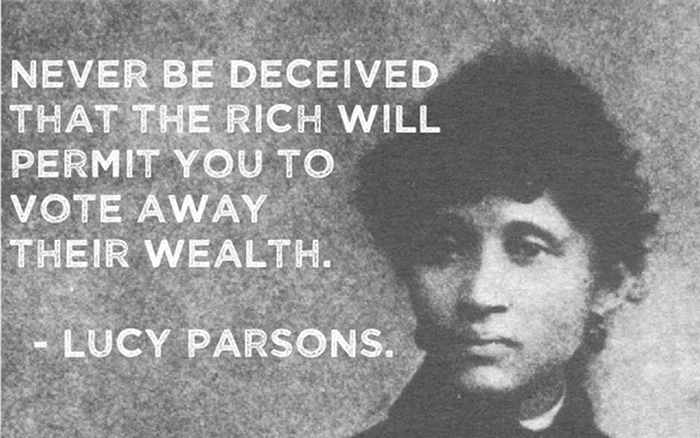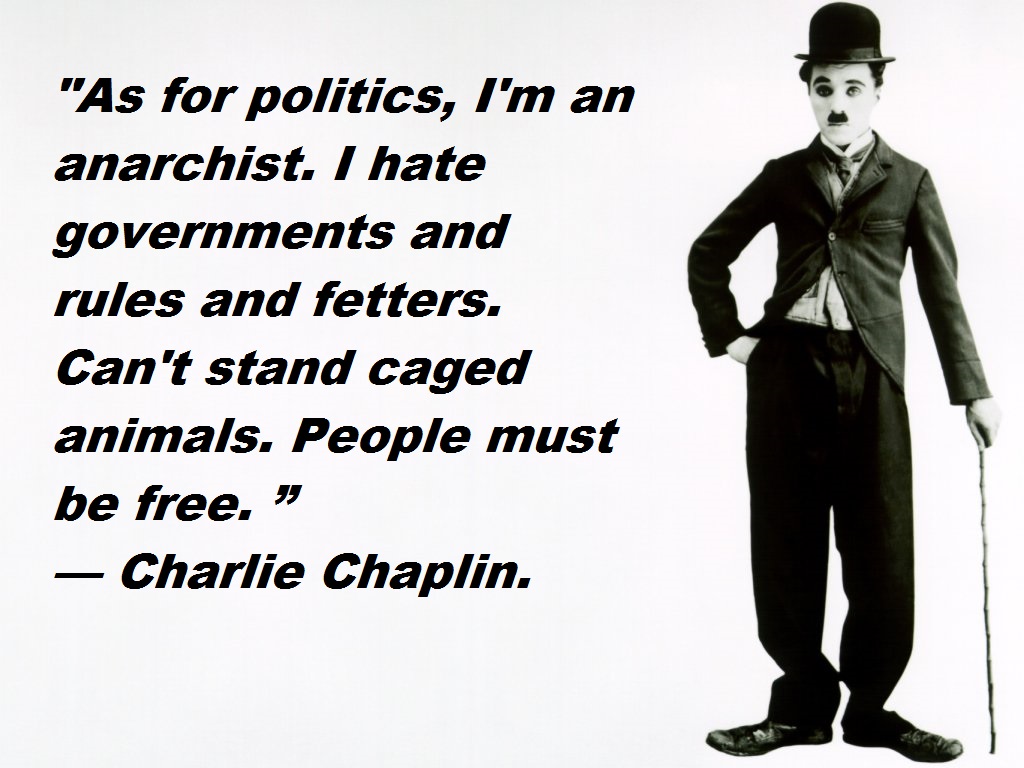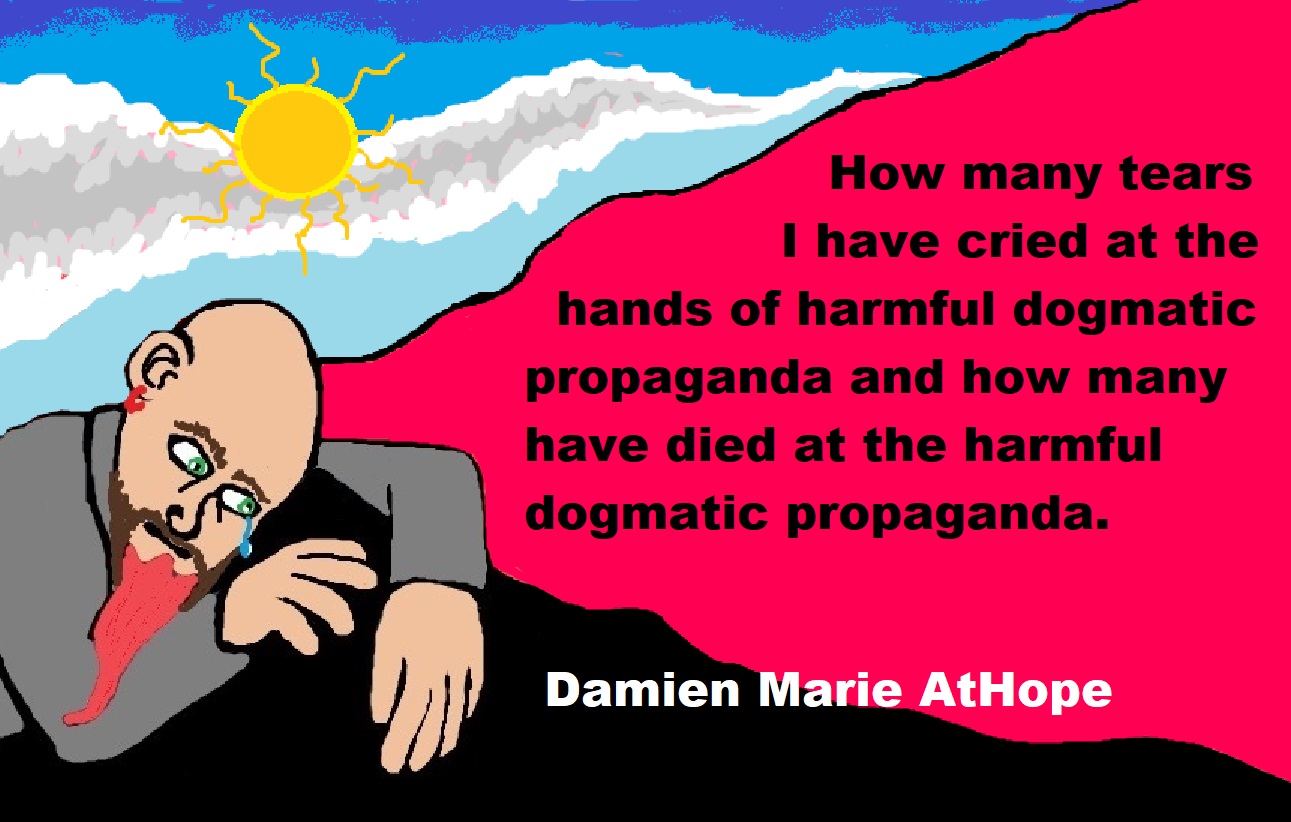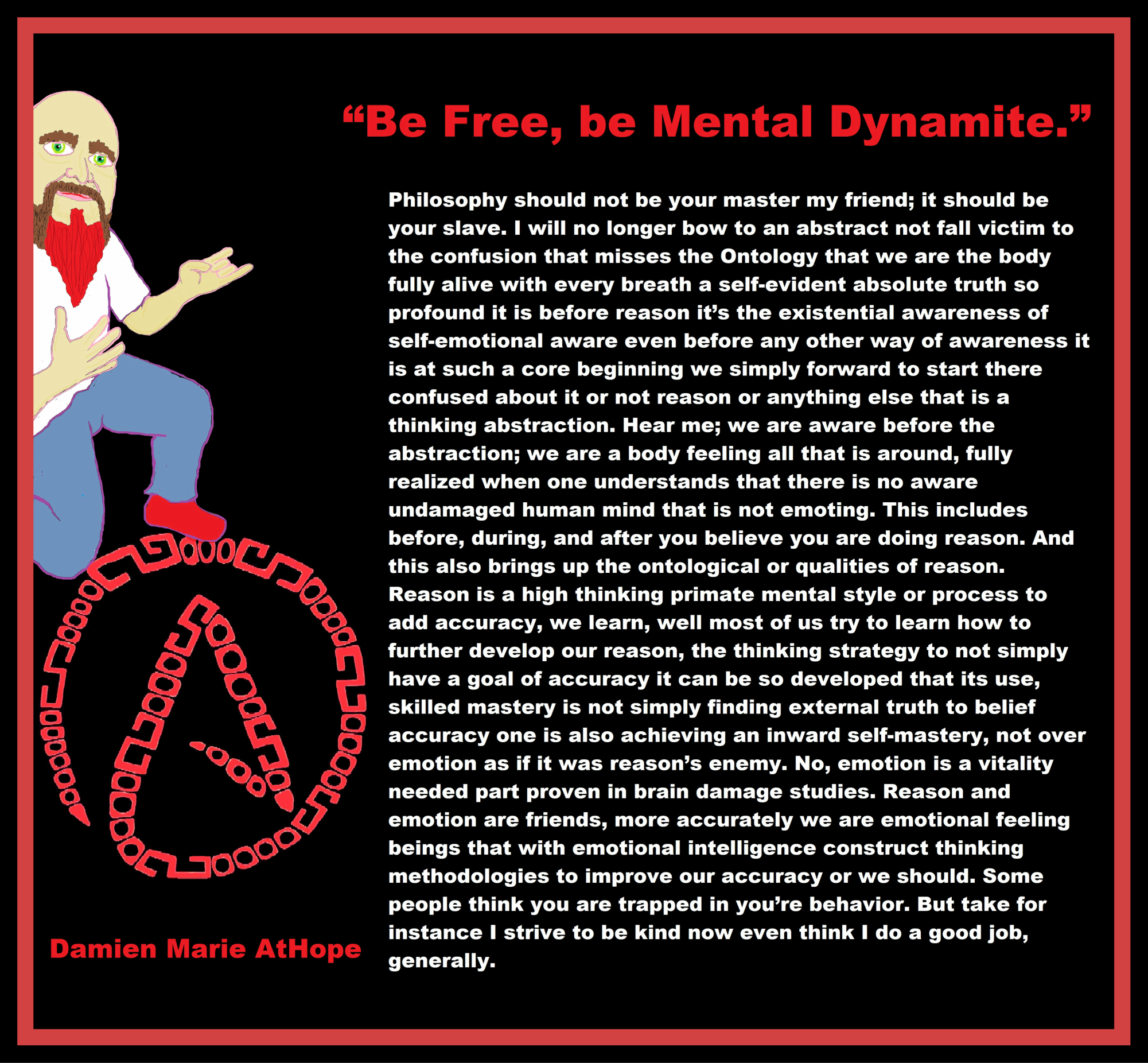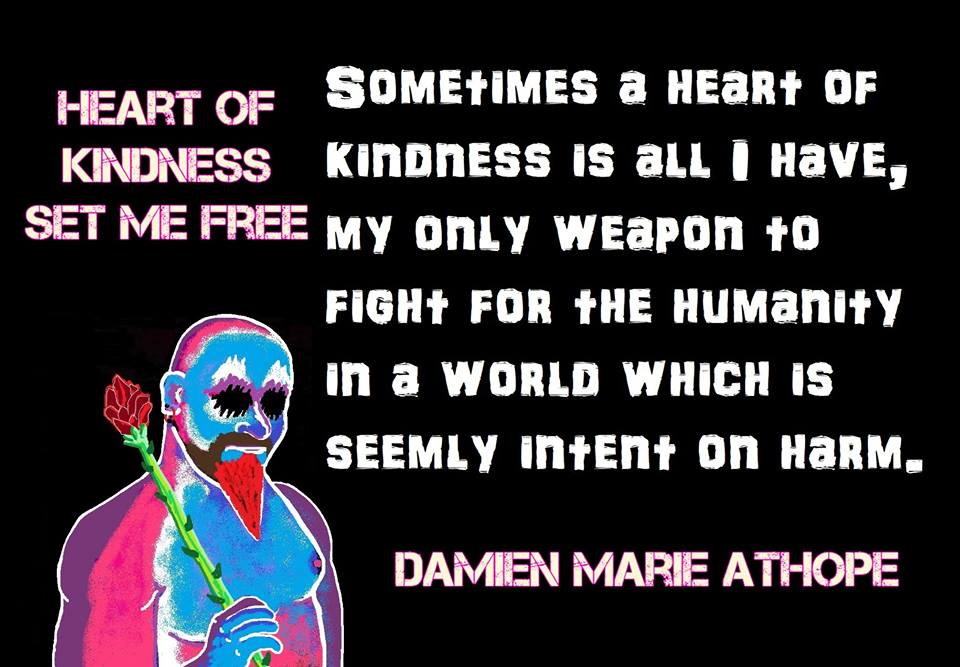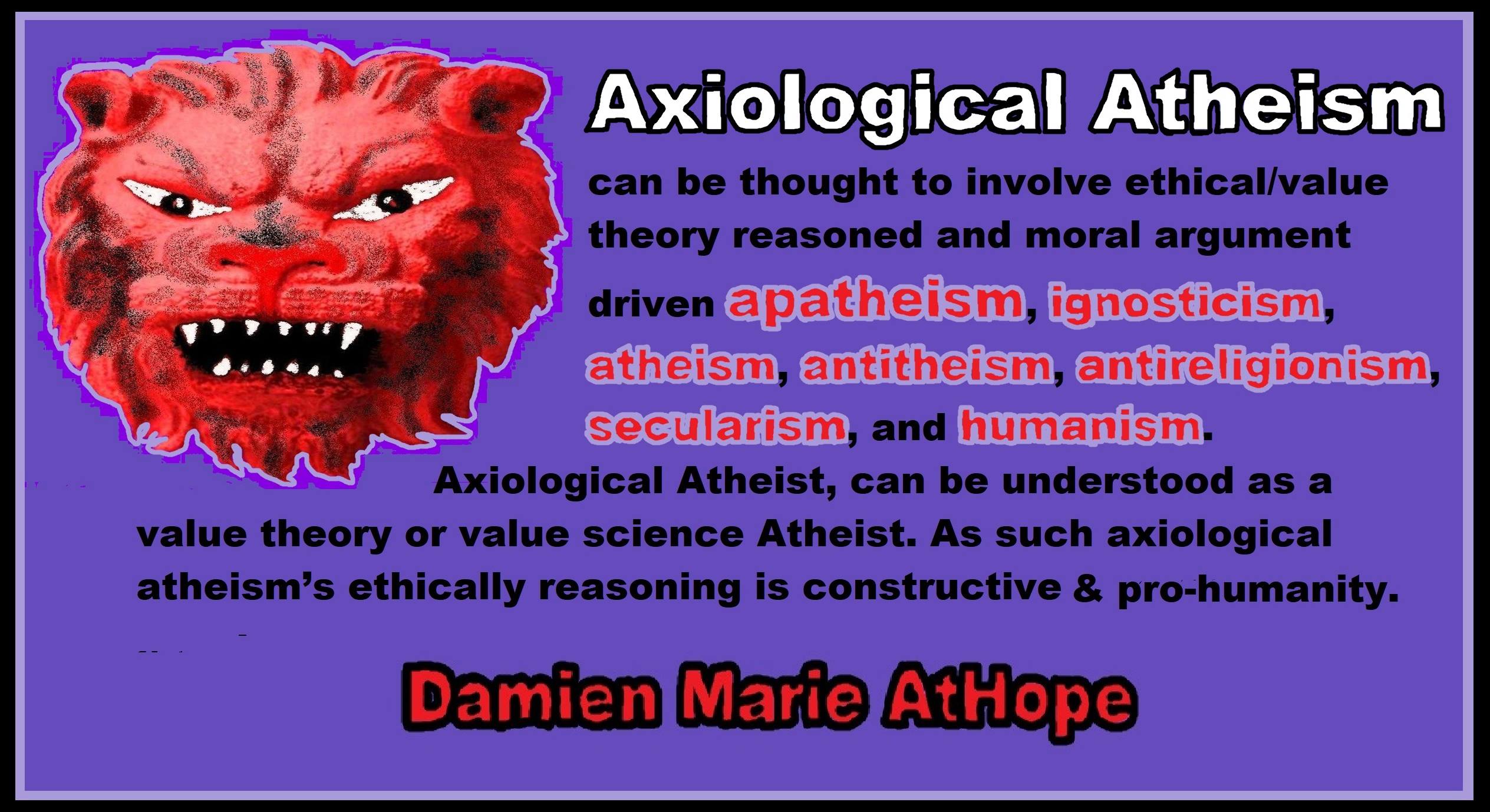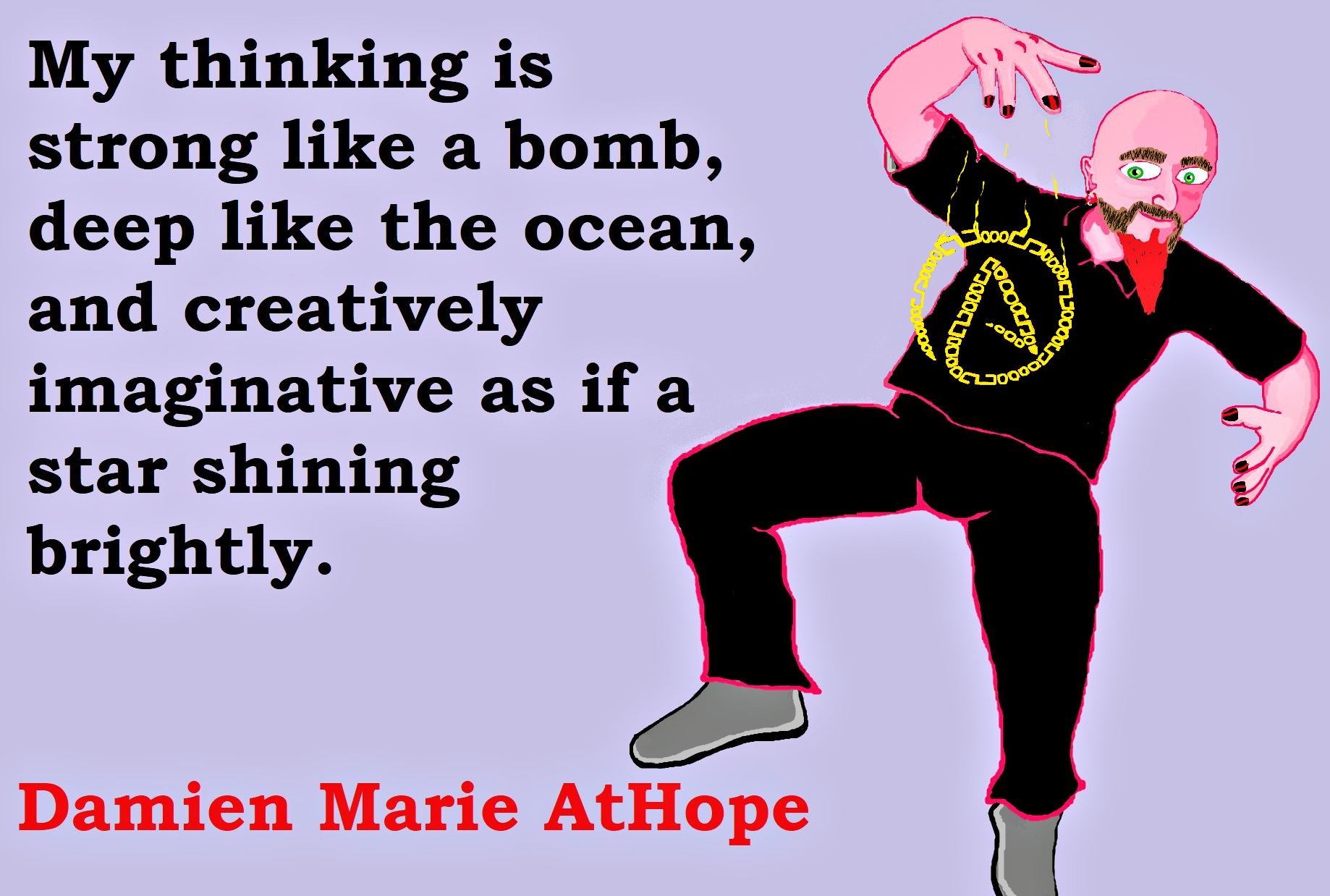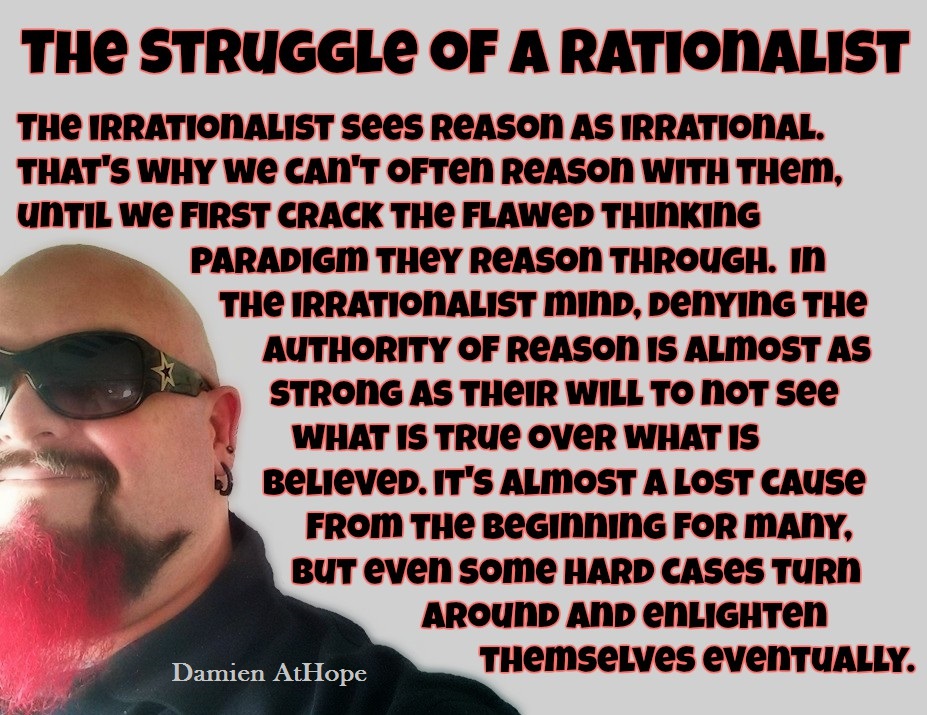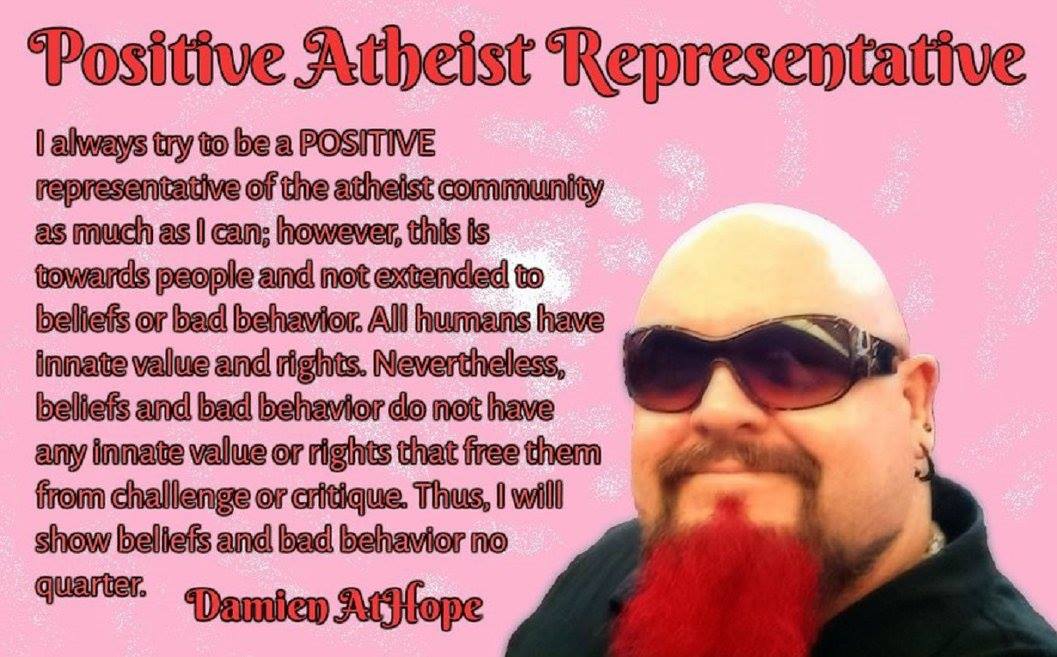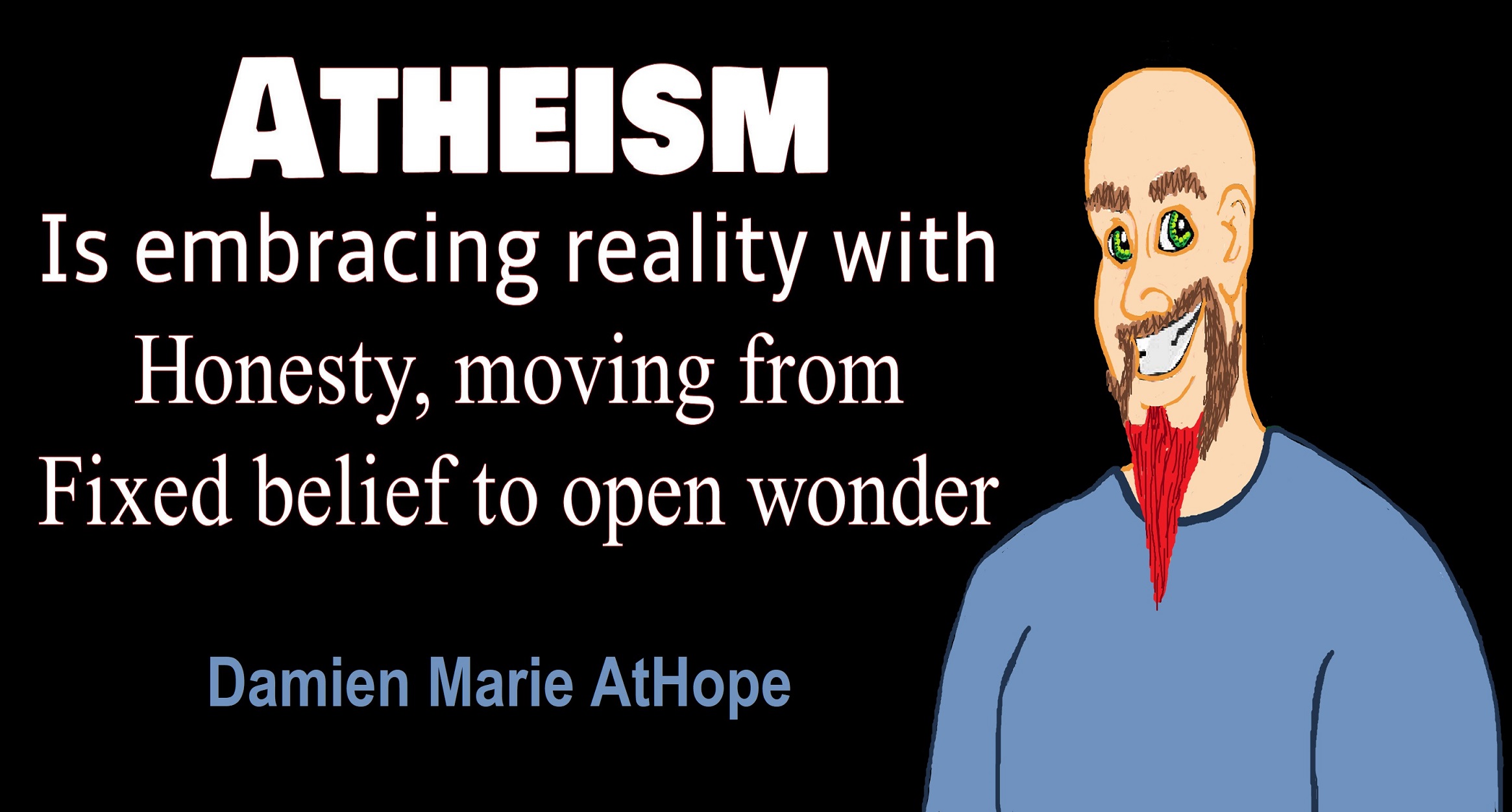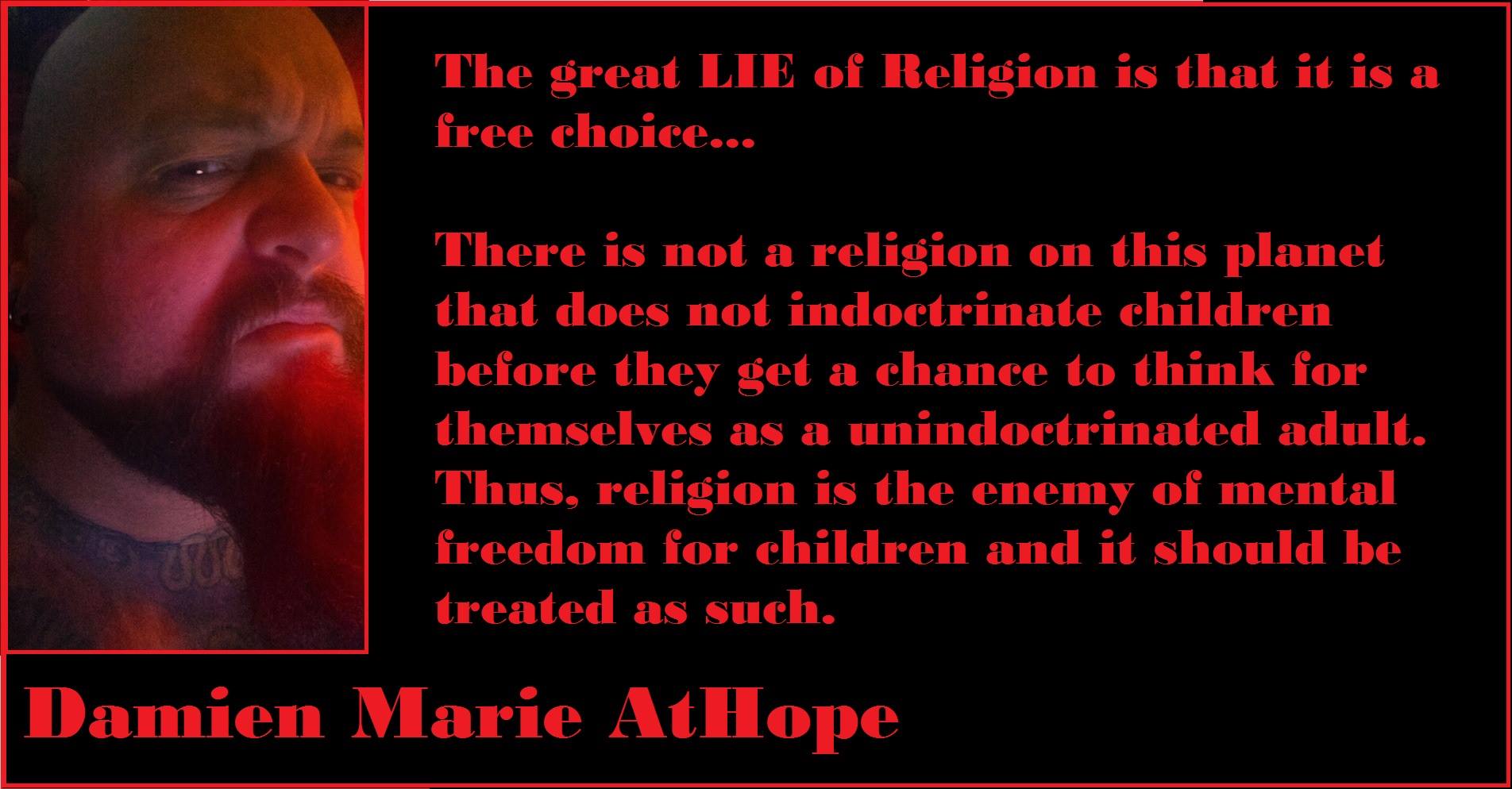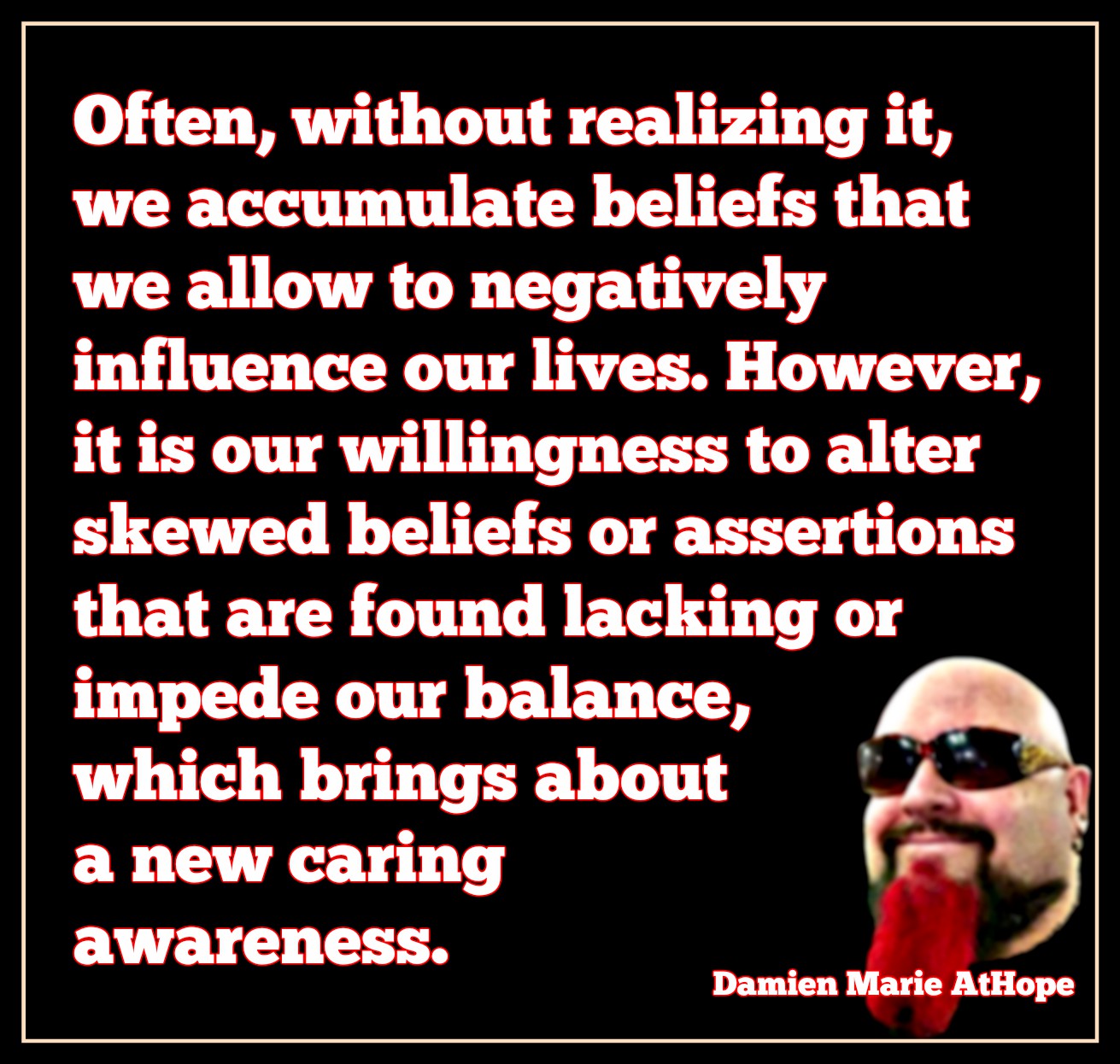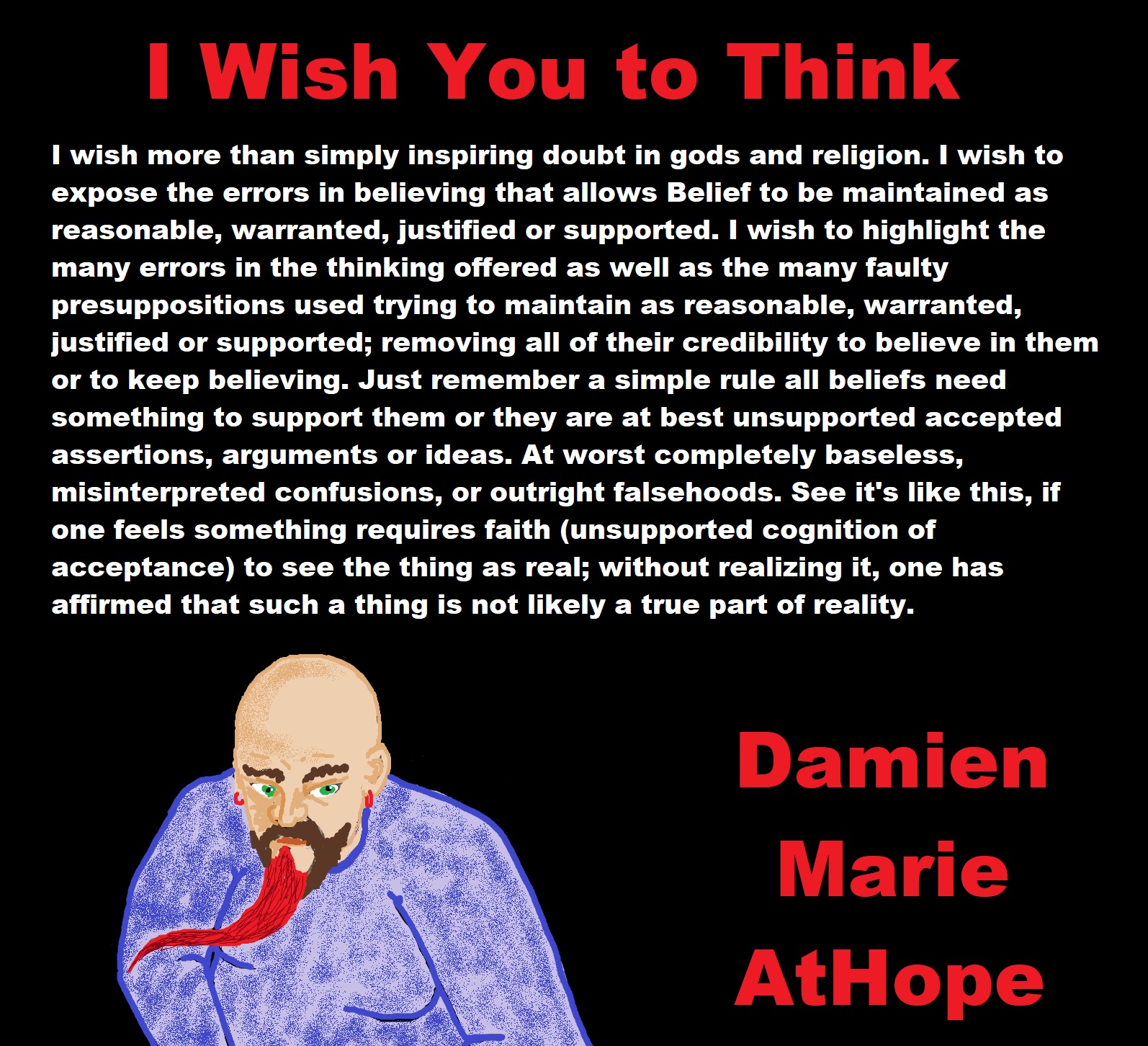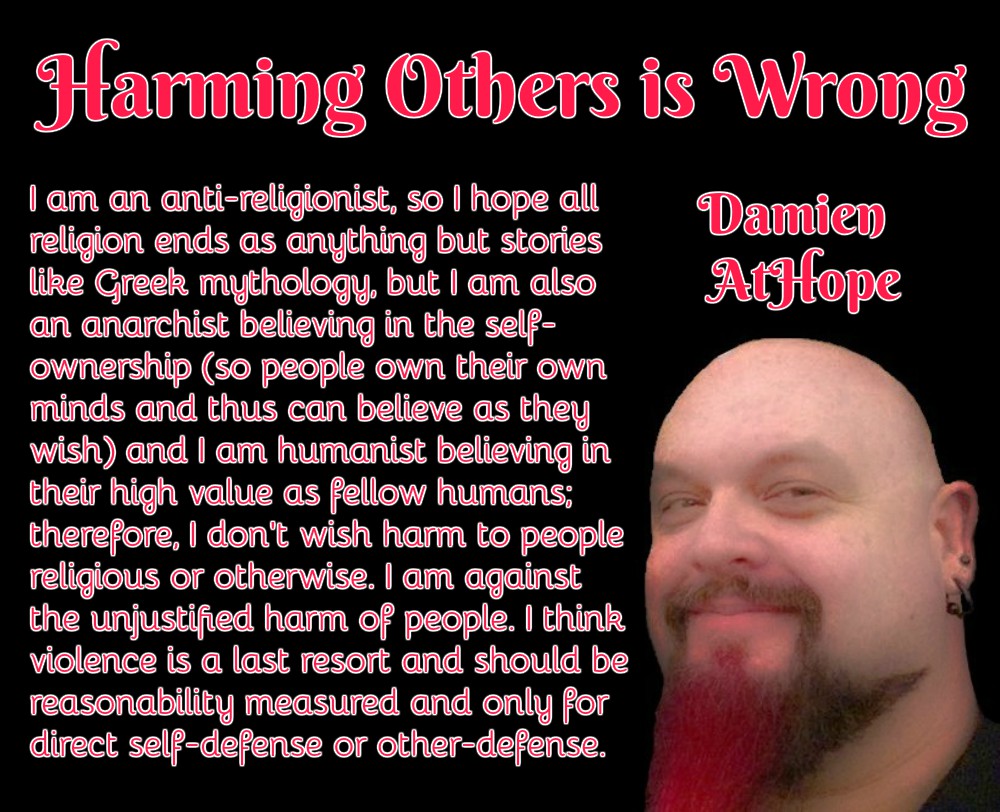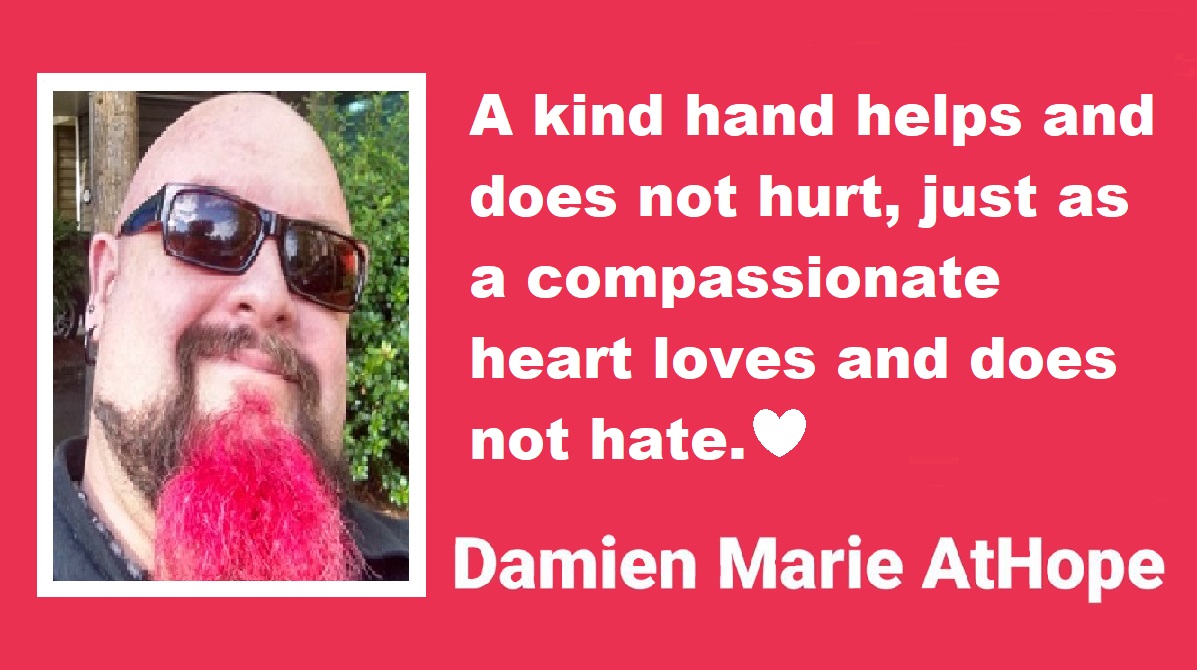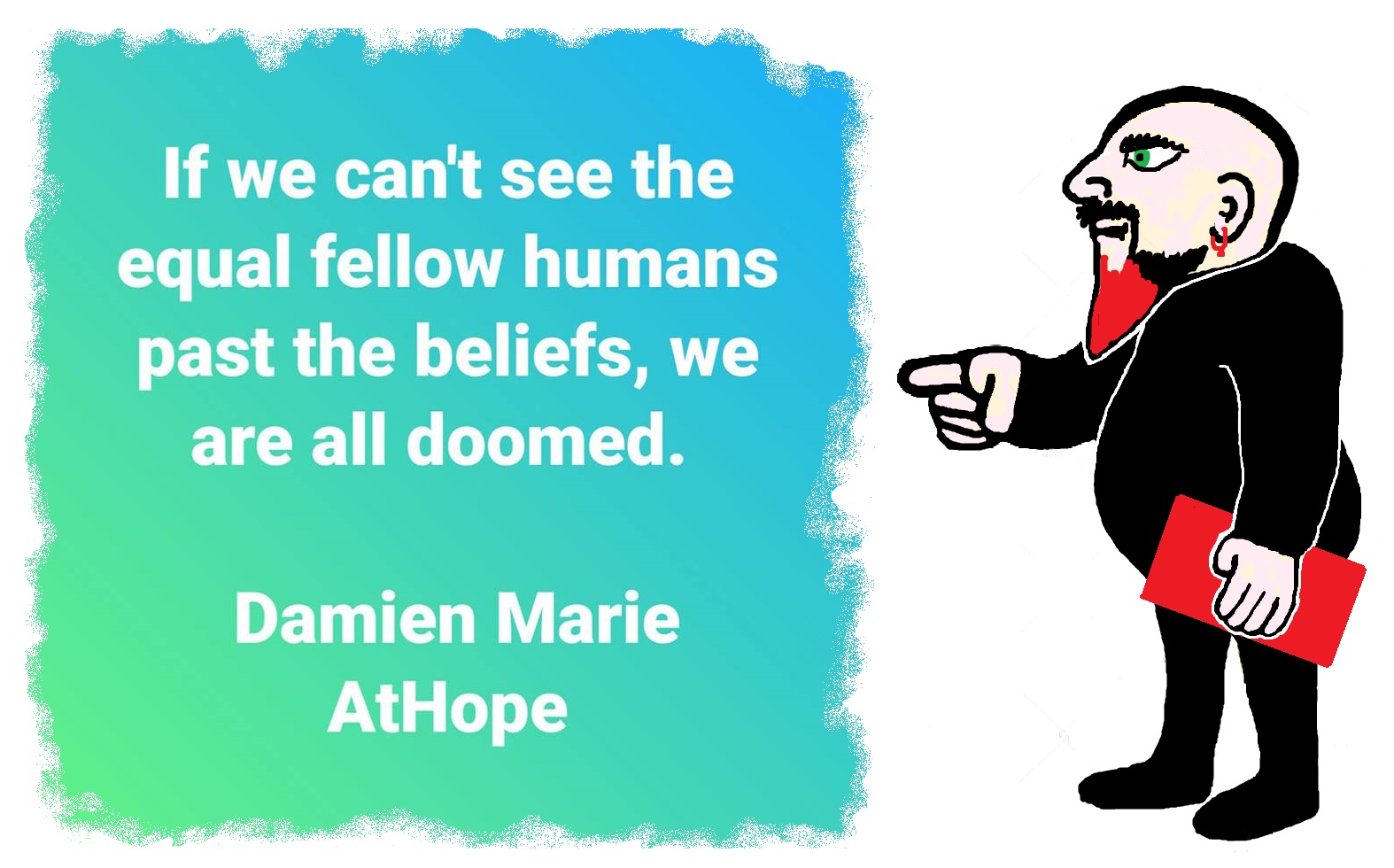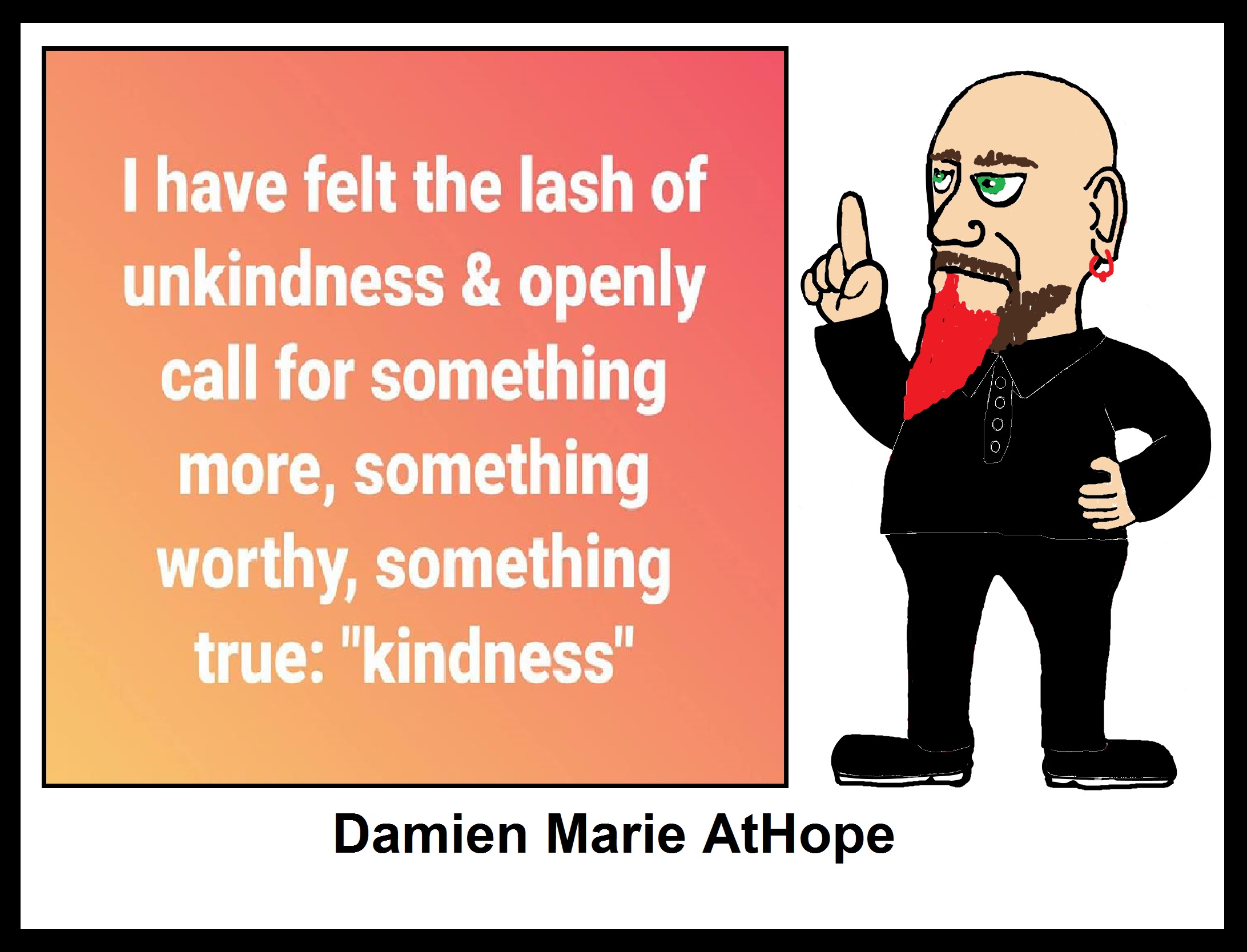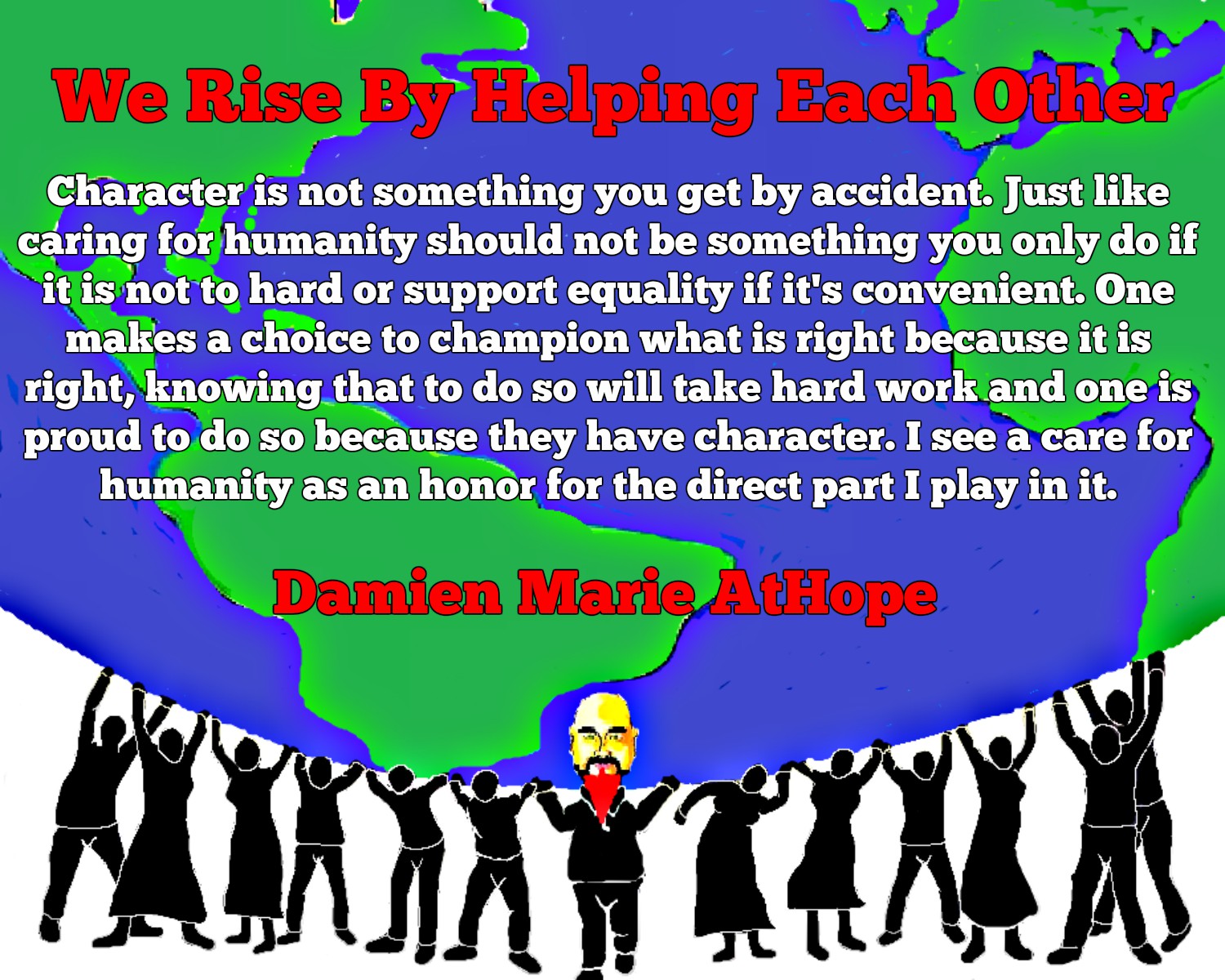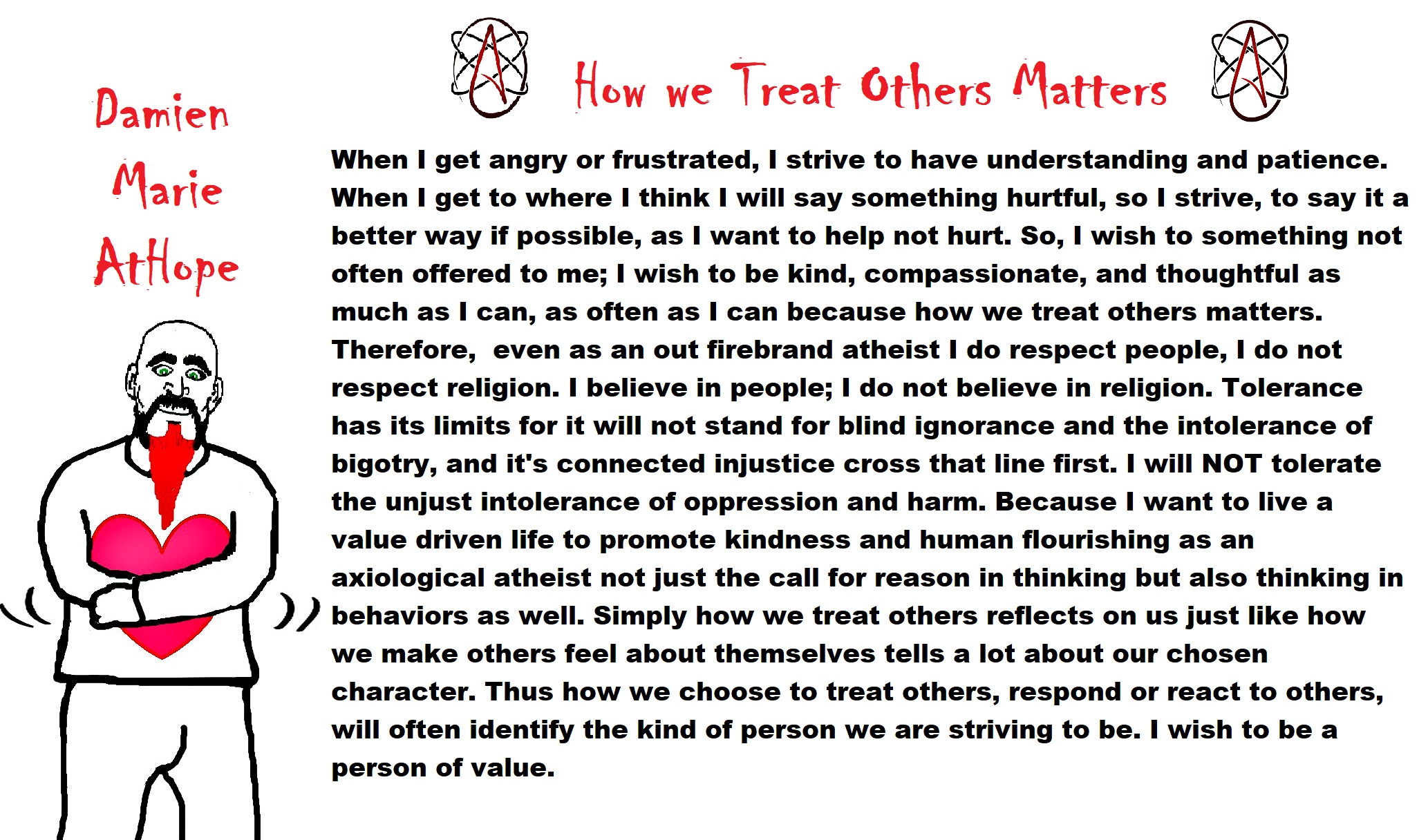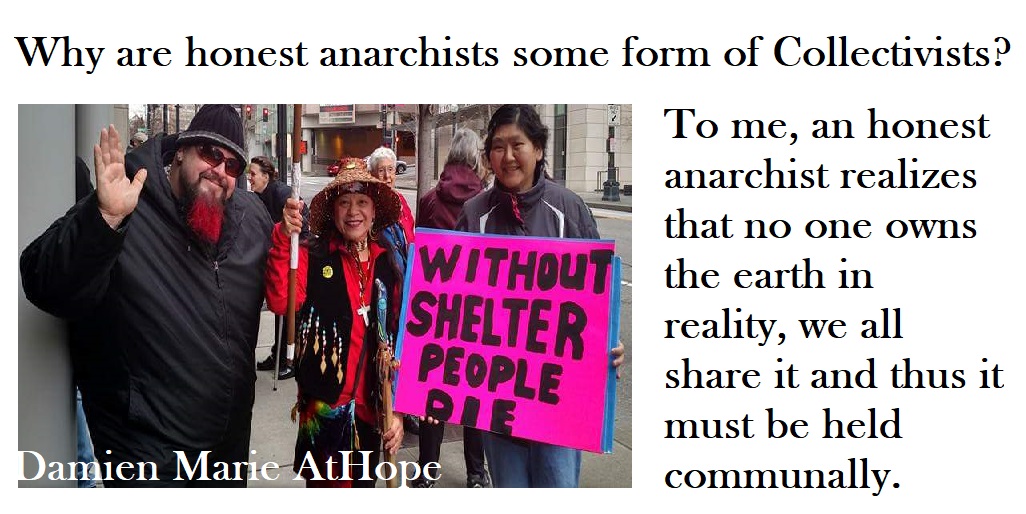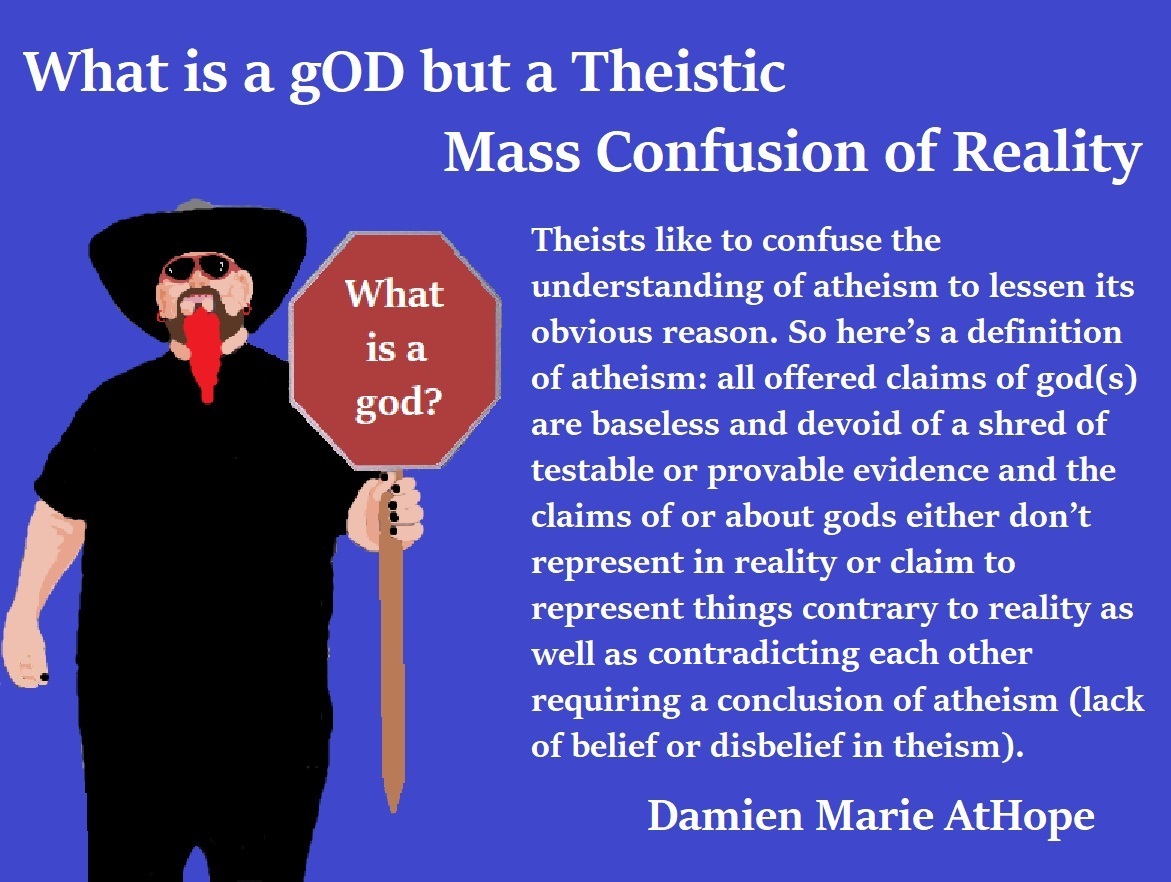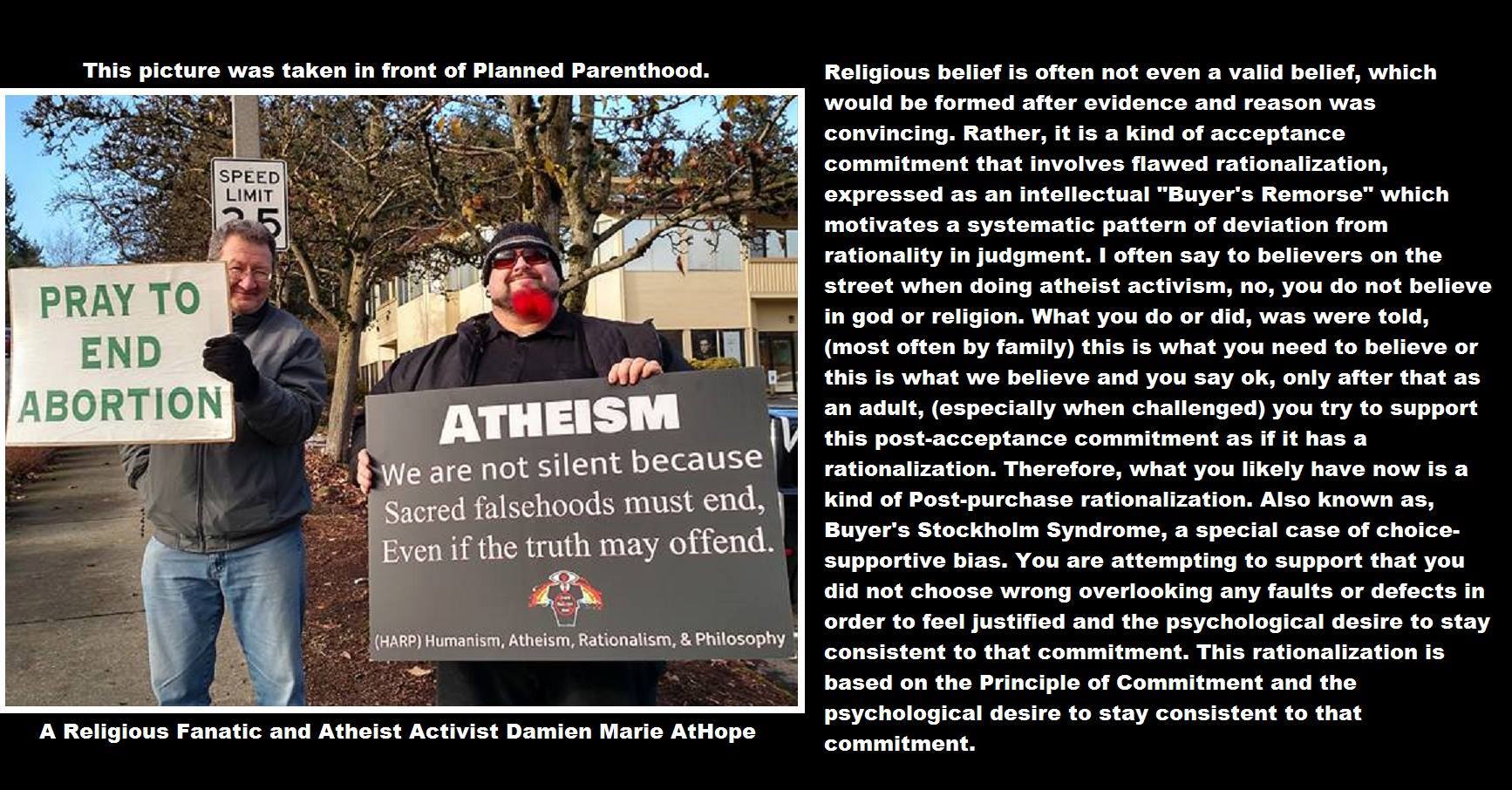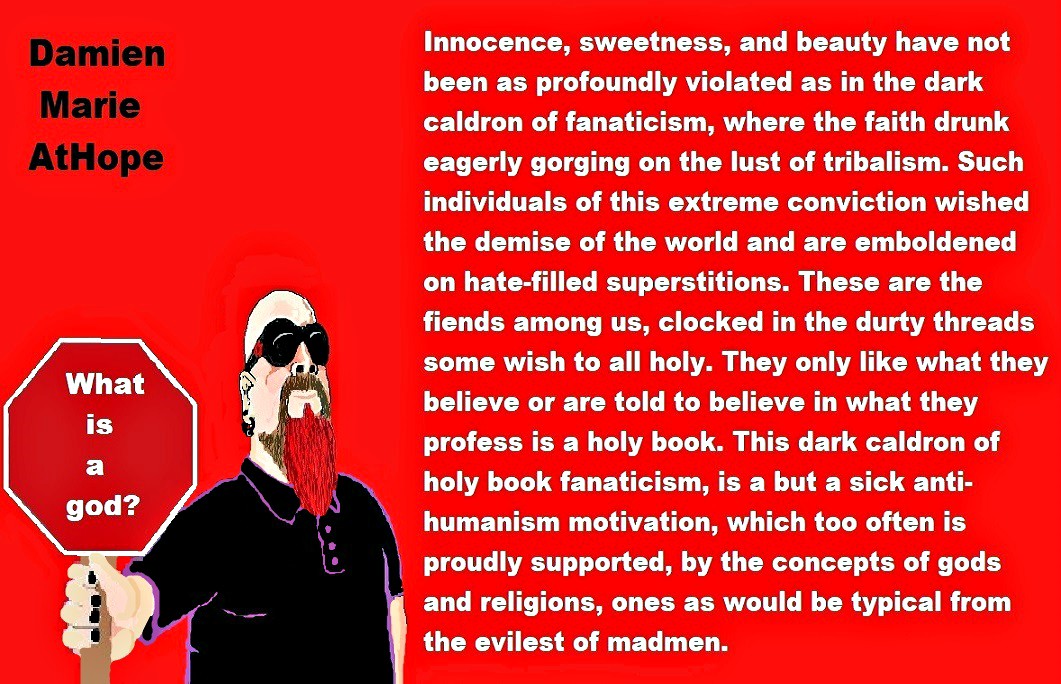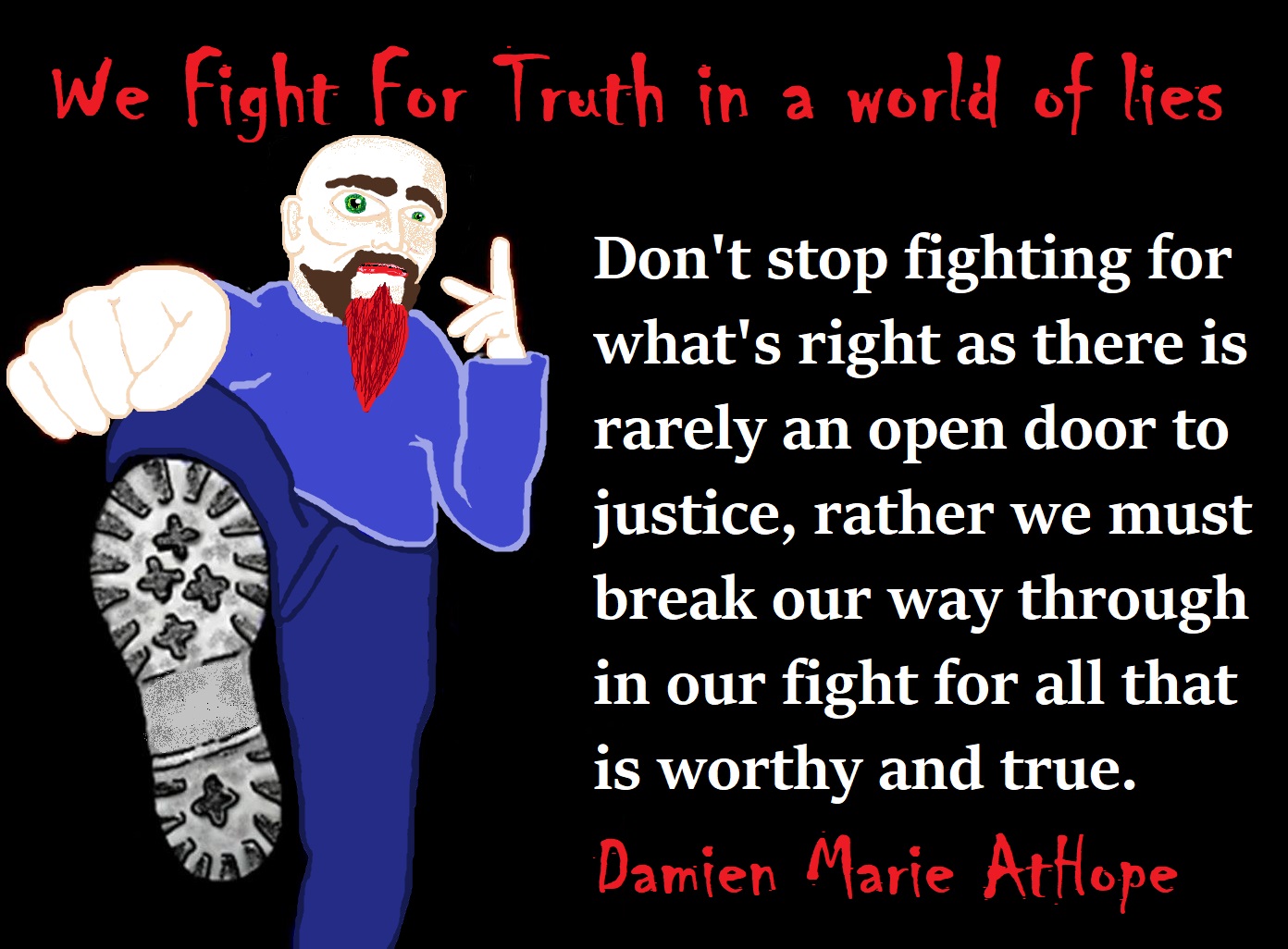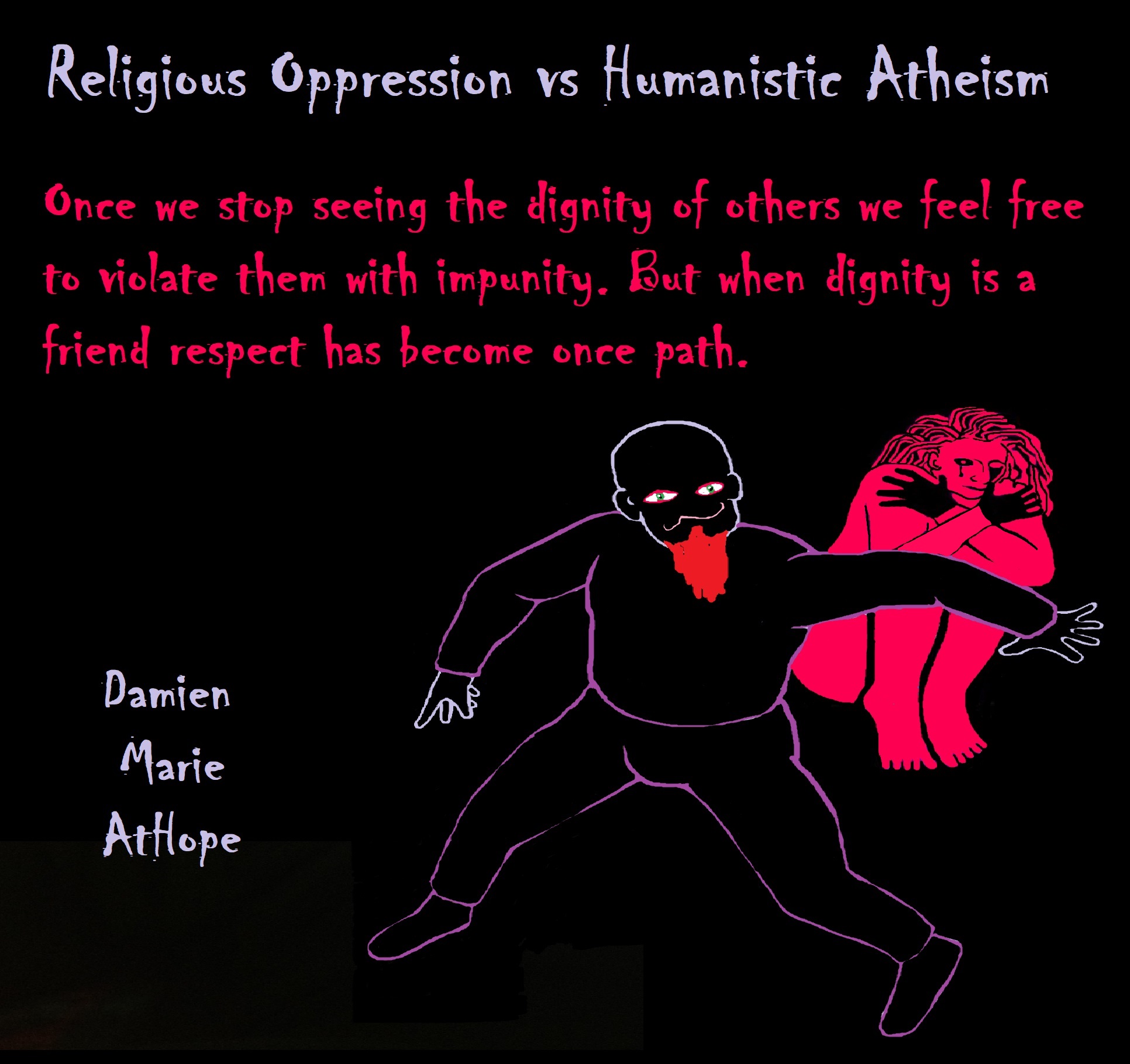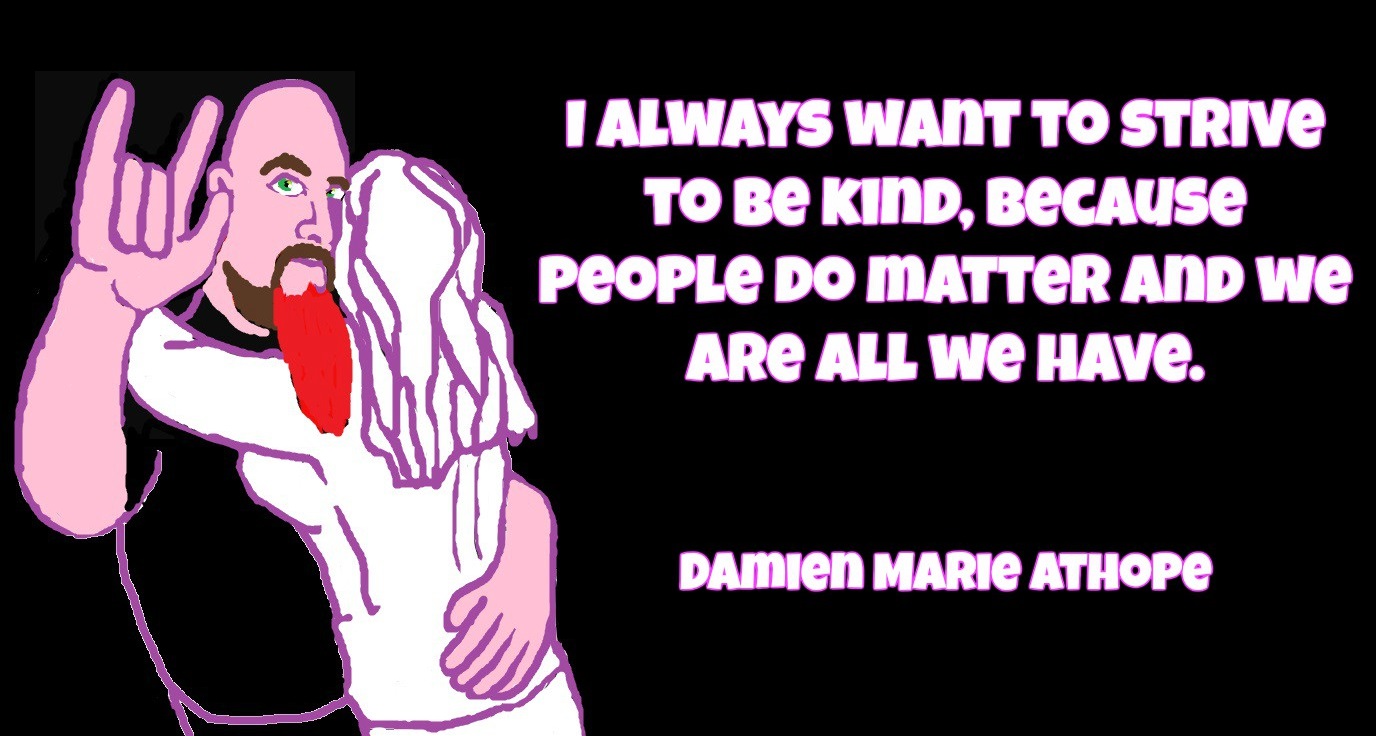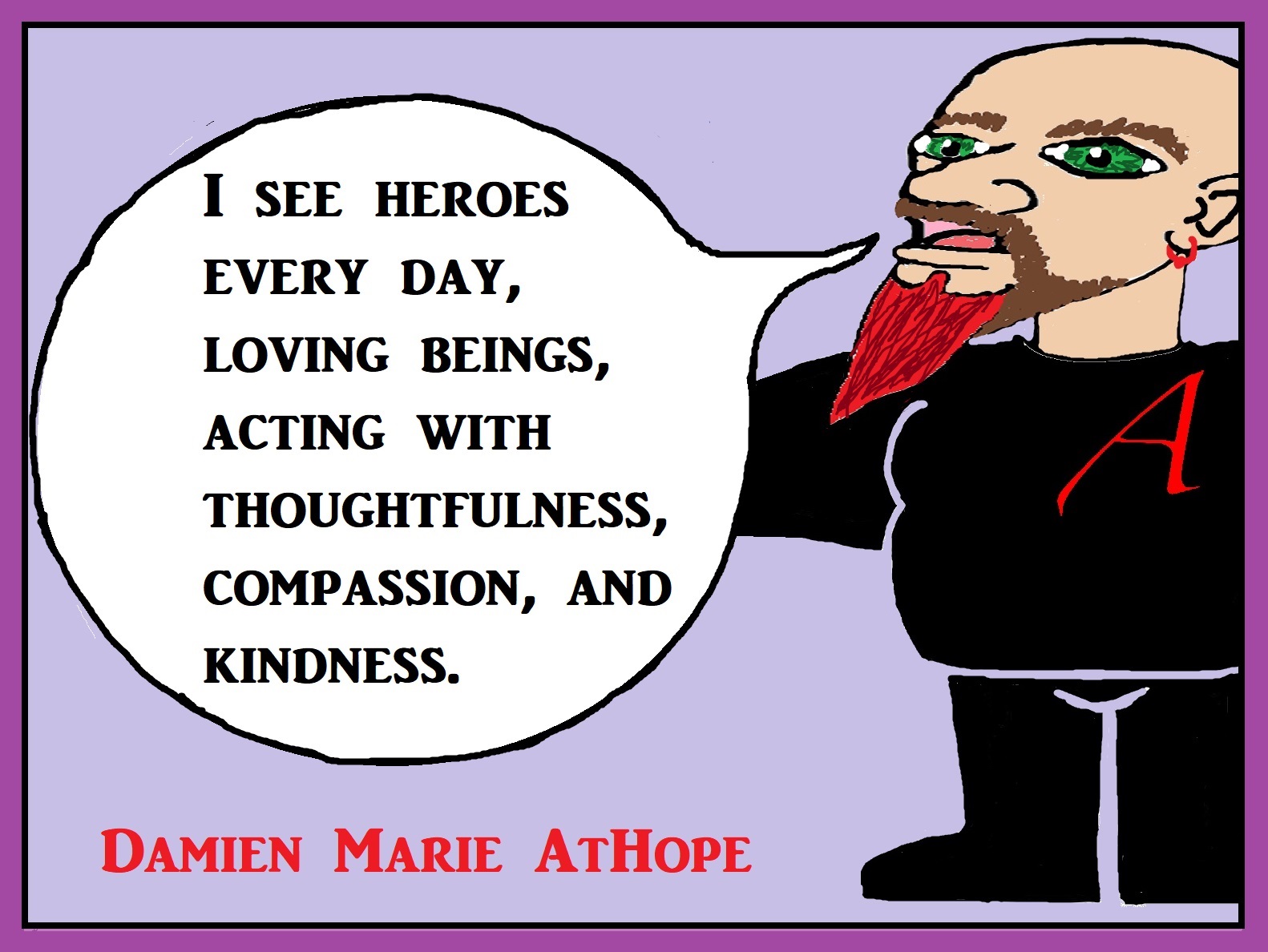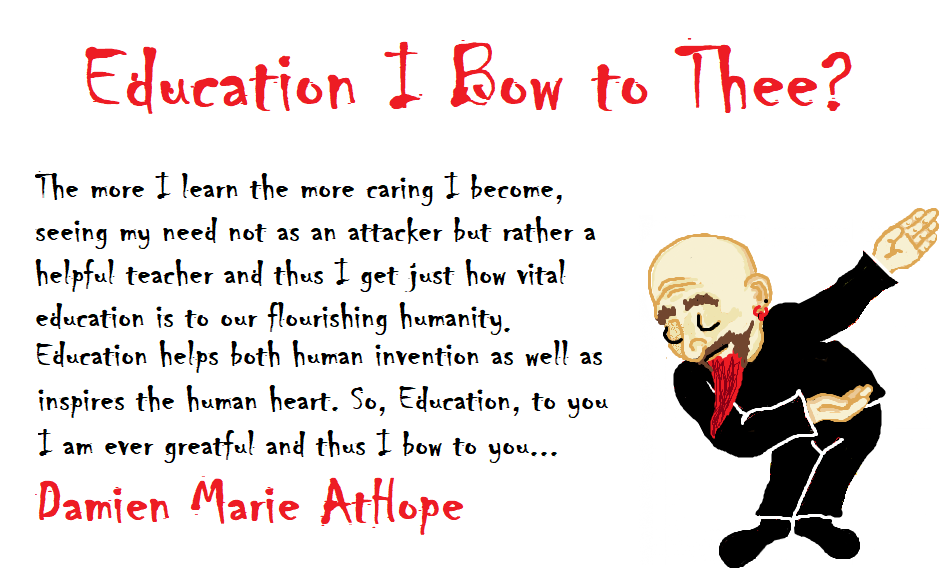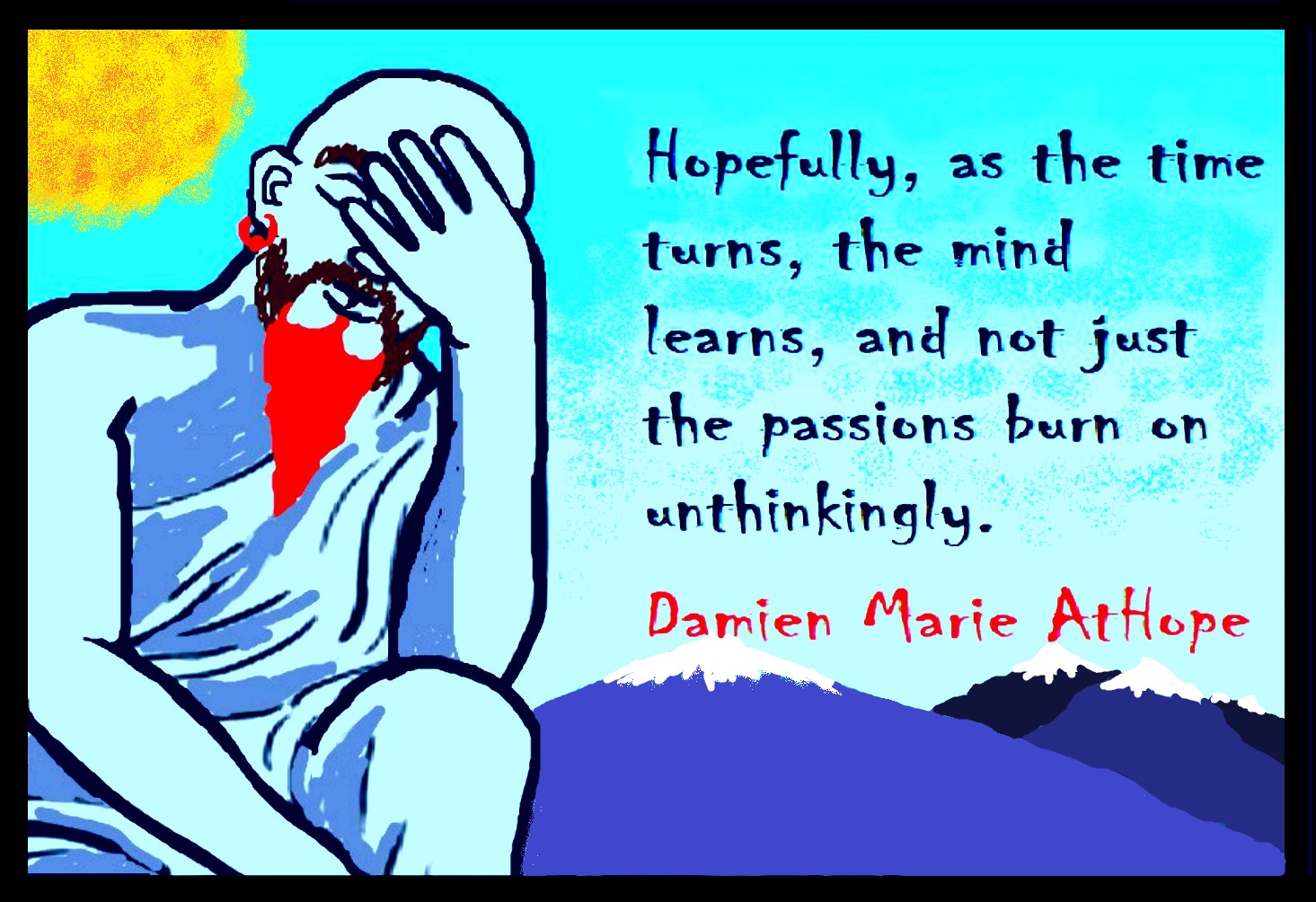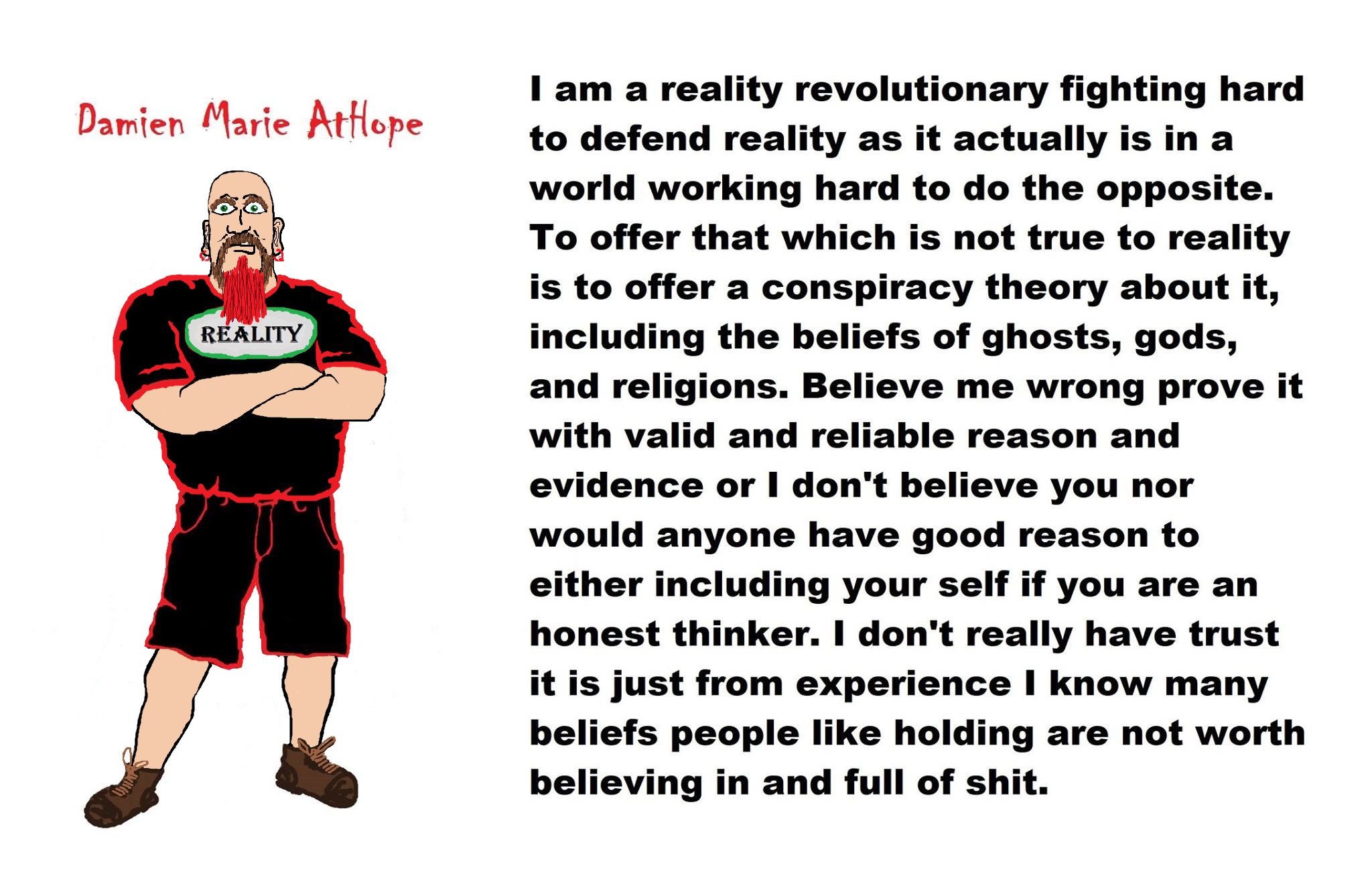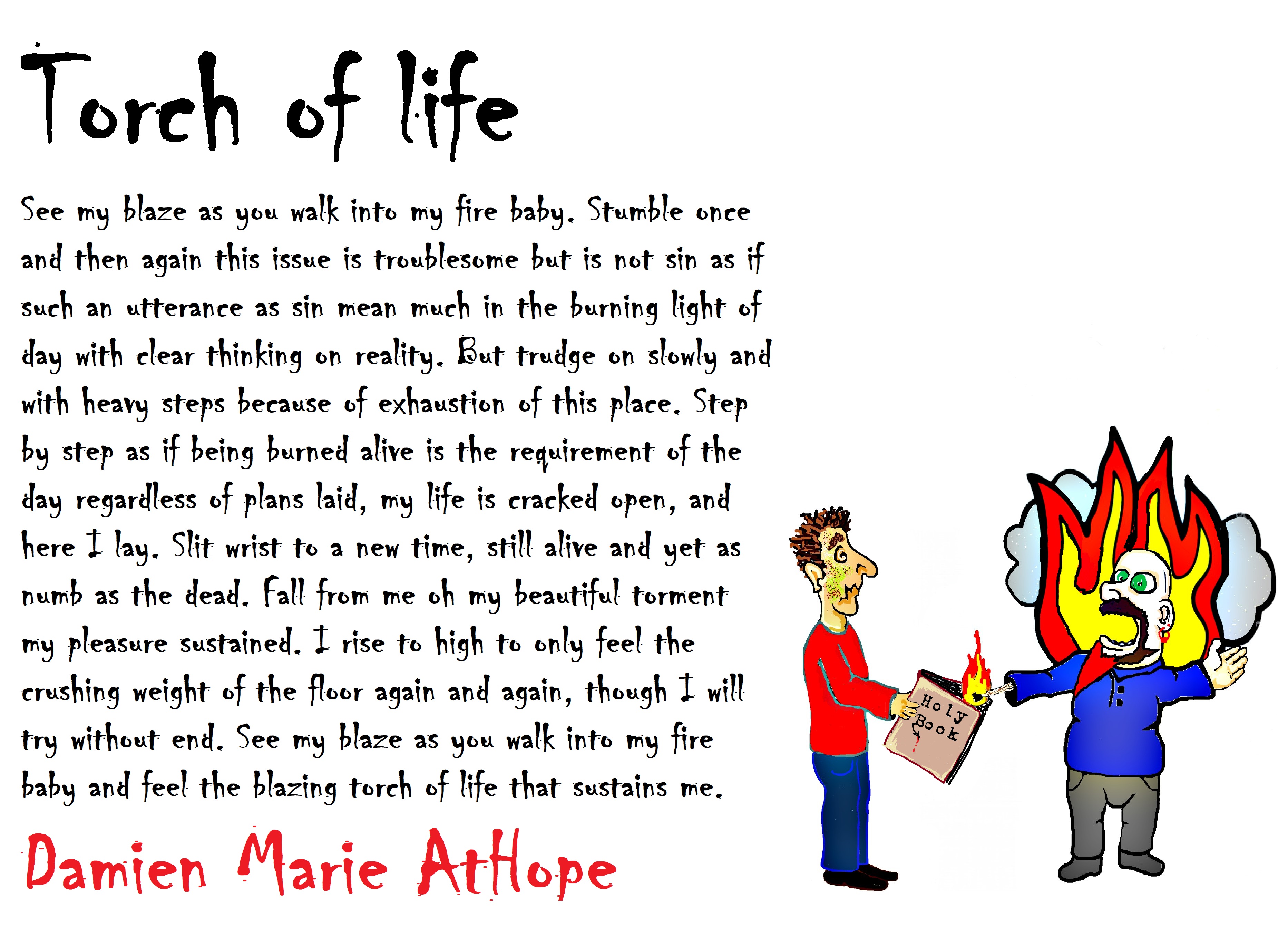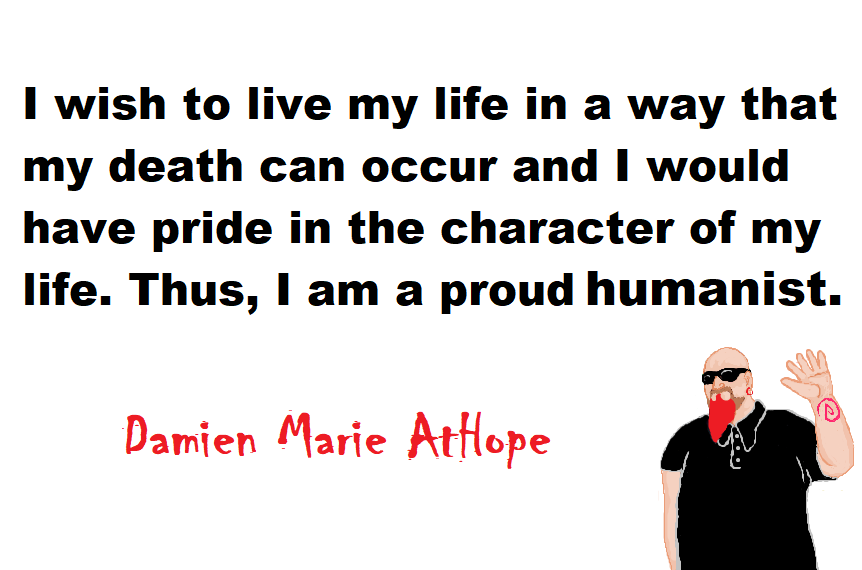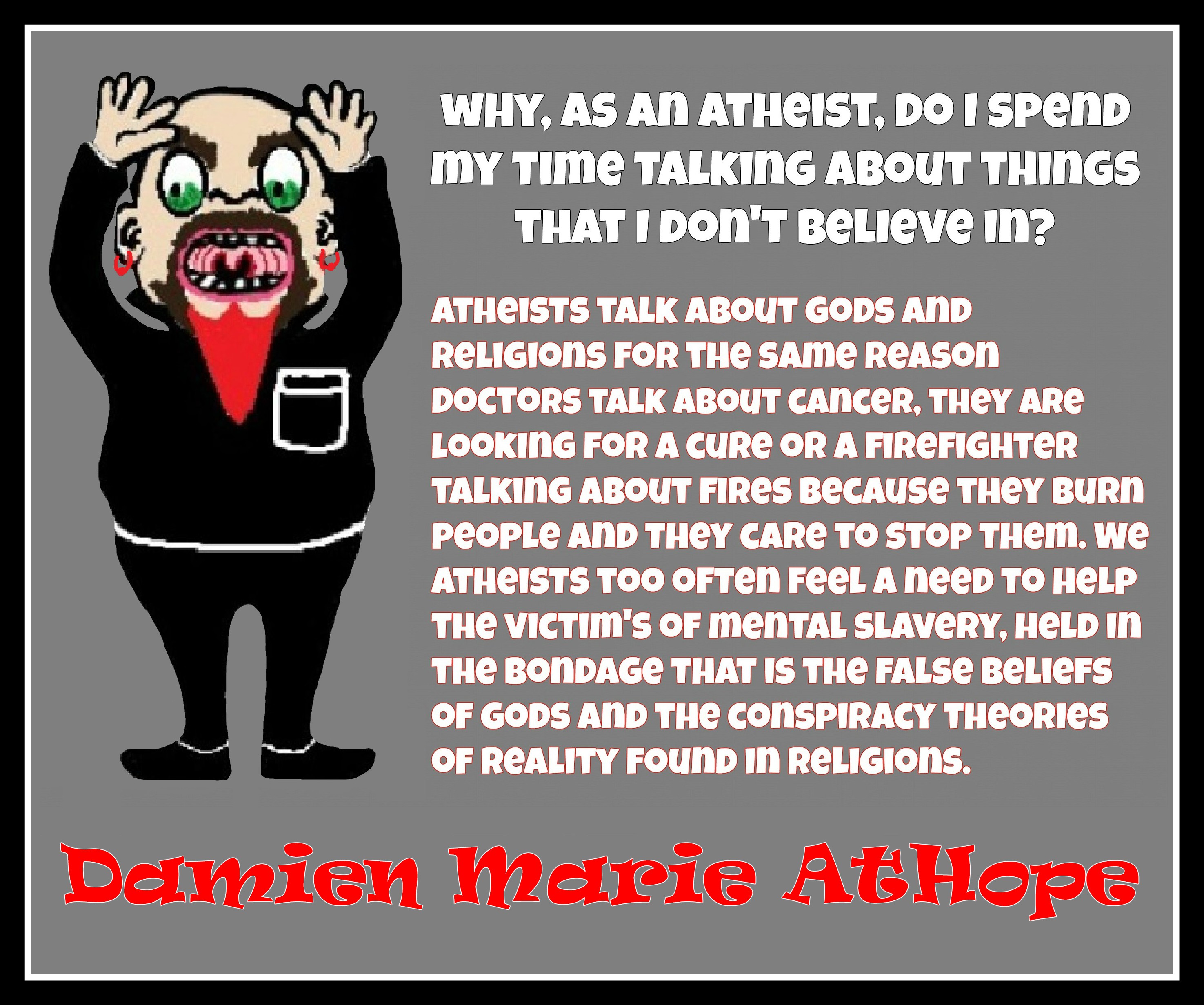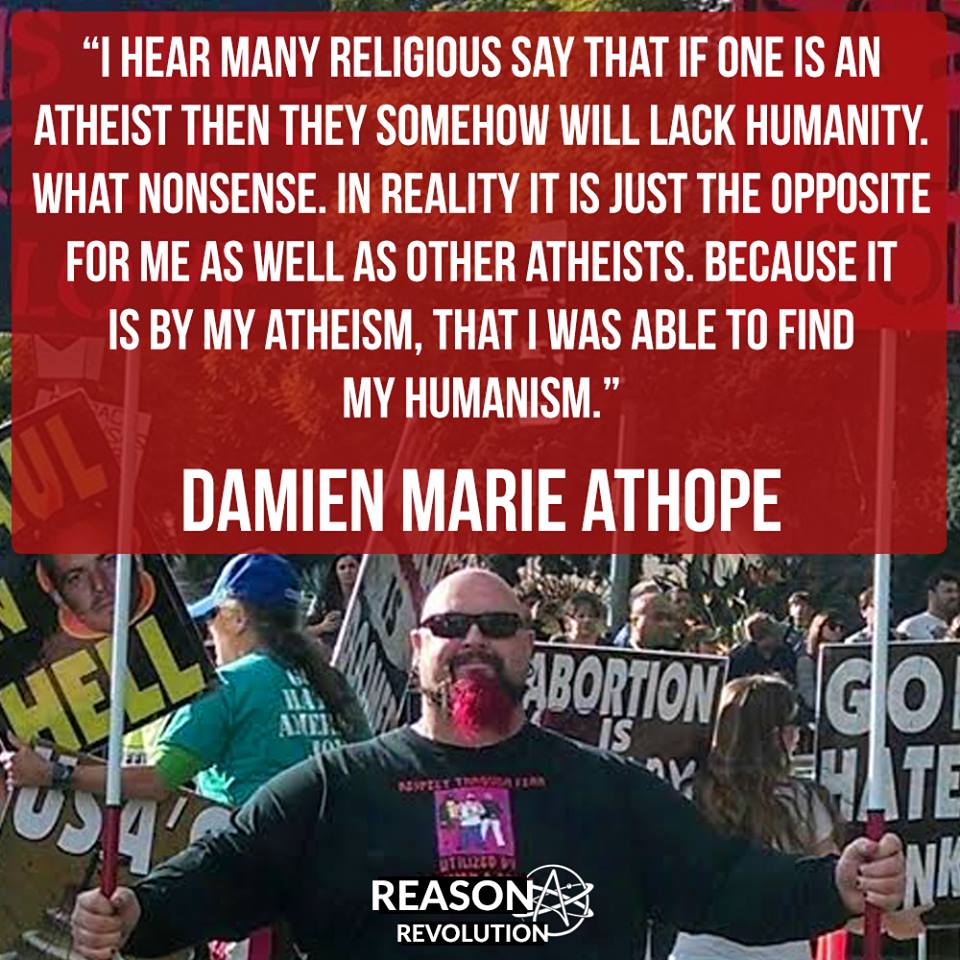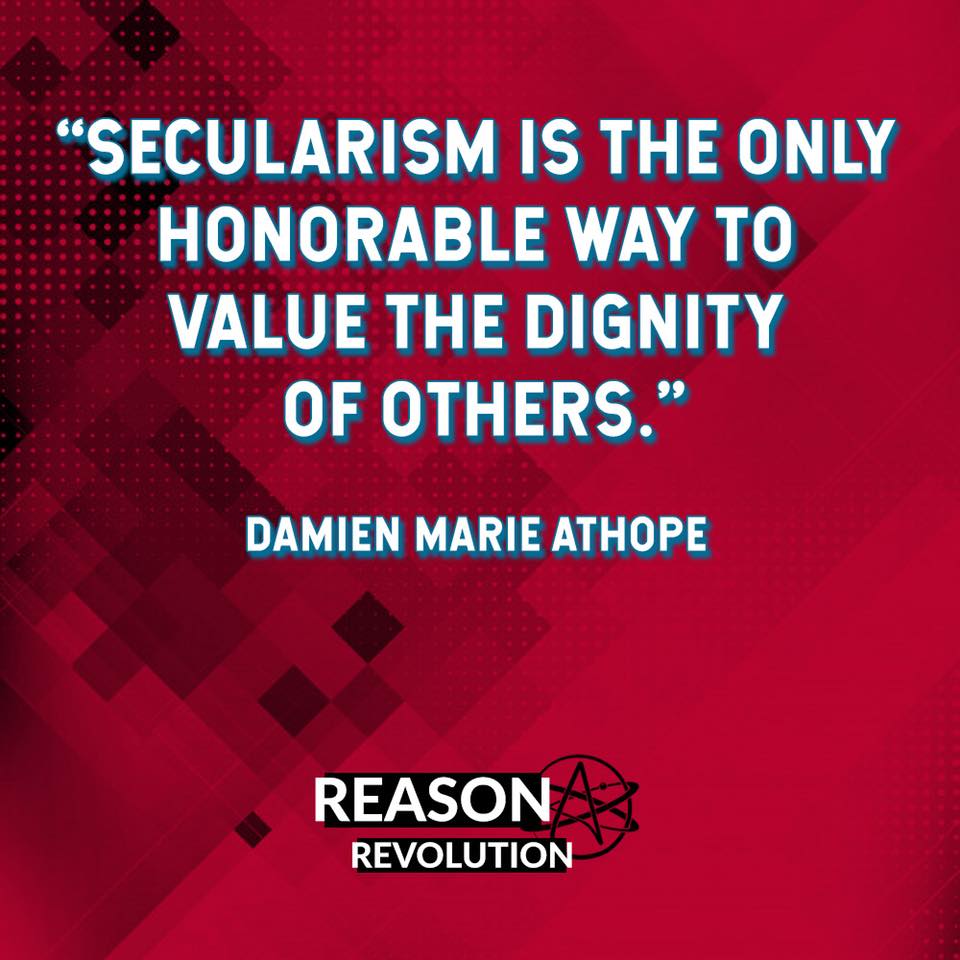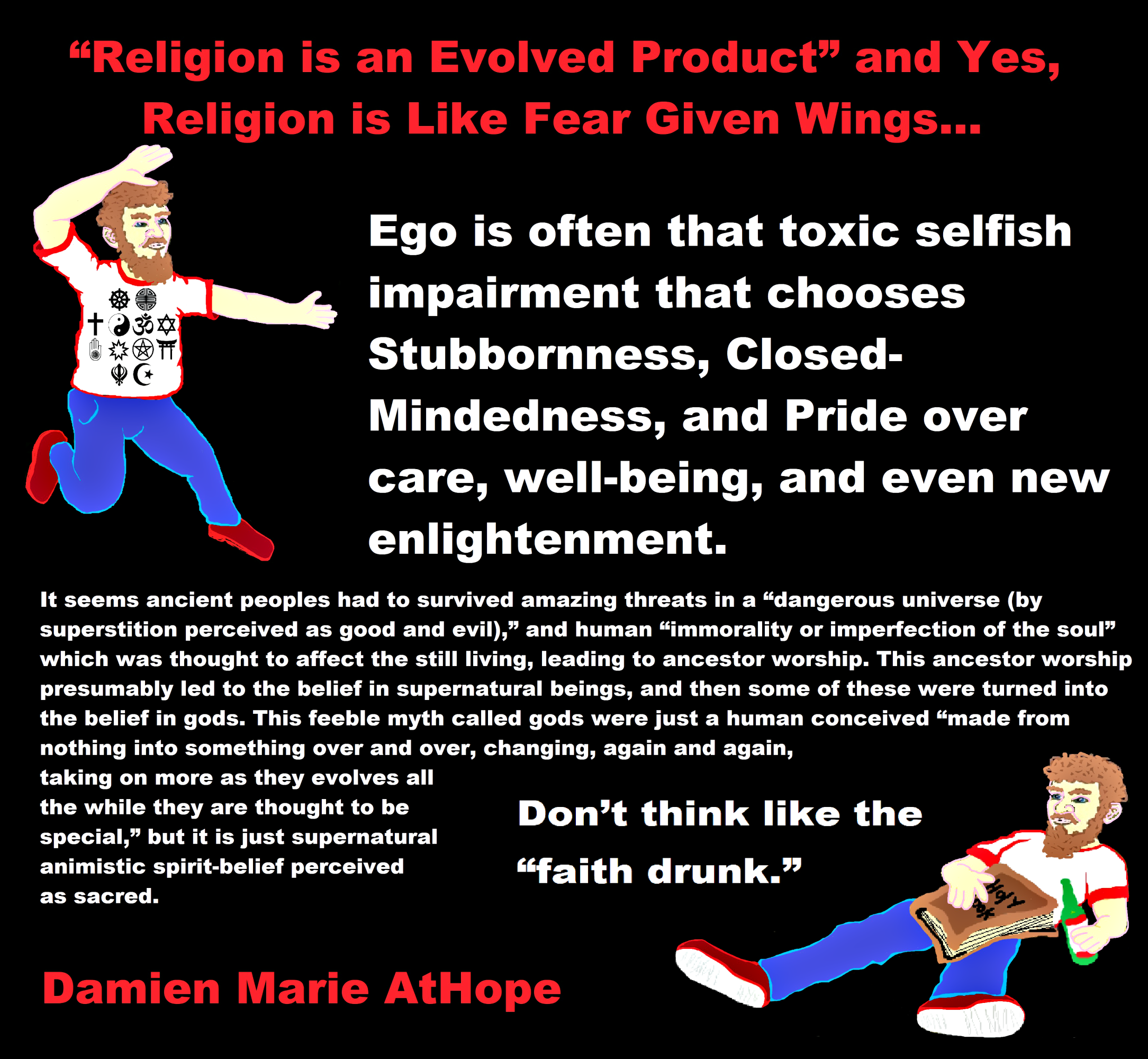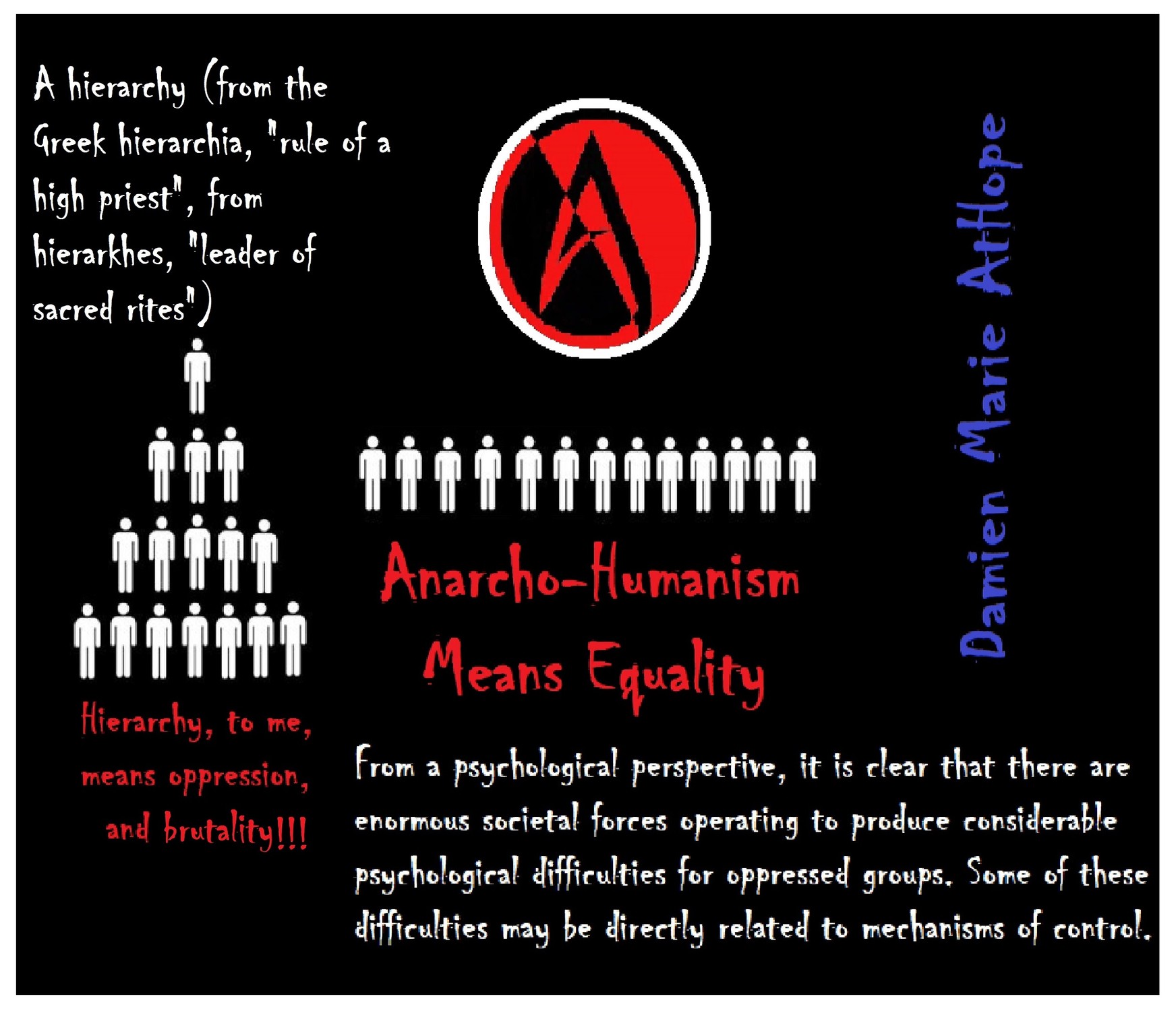
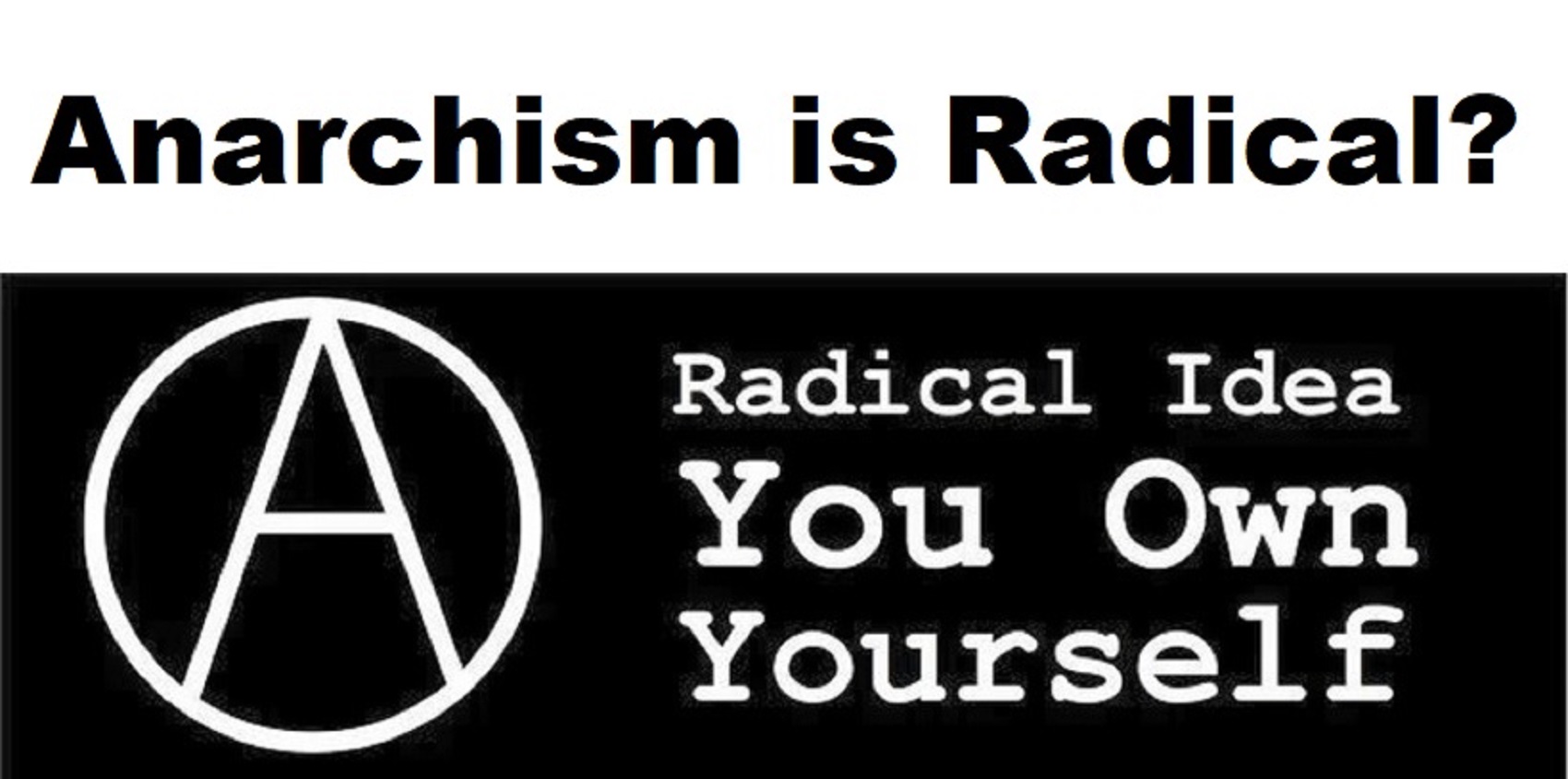
Atheist Anarchists Discussion
Militant Atheist?
Atheophobia and a Challenger to the Term
The Value of a Ball?
Was the Value of Ancient Women Different?
On the Value of Being a Real Person
I am an Axiological Atheist, with a Rationalist Persuasion, who Supports Anarcho-Humanism
What is Homelessness?
You keep attacking activists and while you’re doing that, other activists and I will keep fighting for change. Sadly, you may change a few people where they lose their way in the momentum of activism. However, happily, while you’re doing that, other activists and I will help positively change the world.
Authoritarian Truth Seekers and Anti-Authoritarian Truth Seekers?
What inspires my anarcho-humanism has three core truths to my ethical anarchist persuasion:
1. We are all one connected human family, proven by DNA showing we should treat each other as fellow dignity beings, supported equally (no gods and no masters = “Anarcho”).
2. No one owns the earth, we may make claims to it even draw lines on maps thinking this makes the fantasy borders, illusion supported by force and the potential for threat. Thus the ethical truth is we need to share the earth as communally as possible. And use the resources as safe and ethically as possible striving towards sharing and caring. (do no Harm and do good = Humanism)
3. If you can’t trust people with freedom how can you trust them with power? Government is only as good as what they provide but I don’t trust ones that have rights over my body. How much more of a violation do you need to show their harm? I am not anti-society, I value good governance just don’t need the extra dead weight of government. There is not one thing a government is valued for that a non-government group with the same financial support and resources could not also do. I get we rise by helping each other and supporting universal betterment and human flourishing. Helping is Helpful: Valuing, Motivating, Supporting humanity is limited by nationalism and the, us Vs them, as if you should feel connected to only a few humans just because people invented the mental concept of land ownership, you mean you assert that you will harm others for an amount of the earth’s surface. Seeing with anarcho-humanism eyes helps you see how to Grow in Our Positive Outcomes: Gratitude, Empathy and Kindness. We can become a more quality person by actively being aware and developing a gratitude for life, which supports as well as grows our feelings of empathy, that then motivates the behaviour of kindness. And kindness flourishes in openness and freedom. (No gods no masters as well as do no harm and do good = Anarcho-humanism)
Empathy and Human Dignity?
States may often have powers, but only citizens have the glue of morality we call rights. And, as they say, in my “dream society”, lots of things are free (aka. planting free food everywhere, free to everyone); but I wonder what you mean when people say you can’t just let things be free, I think, yeah, how can I take free stuff from a free earth.
We rise by helping each other.
How to best Help change the current value of Religion Freedom Rights over Child Rights?
I was a Republican before voting at 18 and was christian until 36 (2006) and had started becoming an anarchist a little before that hating first Republicans, then Democrats, then Libertarians, then Anarchist (undefined) and then do to interactions with anarcho-capitalists and voluntaryists, I realized I was not them further realizing I was a relatively a socialist anarchist. Then I evolved my own eclectic anarchism persuasion socialist-anarchist-collectivist-mututlism, which I call anarcho-humanism. Humanism, to me, can be summarised as humans can solve human problems with human means, not needing to appeal to religions or the gods they claim as real. Rather humanism, I feel is a positive awareness of the reality of humanity needs, with a seeming general goal valuing others and striving to make a positive ethical difference. Humanism should involve respecting and helping others seeing them as fellow dignity beings. I see humanism as and ethical caring that moves beyond the selfish thinking about only me, choosing to improve one’s self and others as well, it’s the humanity persuasion I aspire to fully emulate, an awakened humanity.
“Accommodationist” Atheist? I Just Say NO.
How to show an anarcho-capitalism they practice anarcho-fraudism”, what do they want all the property that had been obtained from unjust forced under statism to be redistributed equally or aloud to stay in the hands of the ones who reaped the most abusive entitlement benefits under the theft of station you so despise? I bet they want everything to stay the same right? They love all the abuse from every angle of capitulation but don’t like the one external pressure of the state. What confusion and as I see it they are just selfshism not Anarchism anything. One who exhibits quality in human character does not mean one never struggles, but that they triumph over them regardless, not that one never stumbles while trying to overcome detrimental obstacles, such as, one’s ego. To me human character is found in the best of human potential. Because character is one of the attributes or features that make up and distinguish an individual: a complex mix of behavioral/mental/ethical traits marking a main or essential nature especially as strongly marked and serving to distinguish ethical sensitivity, universal ethical standards, and boniface. Raise your head high my friend, for you are not some fallen wretch of a being, shackled with the notion of sin and inborn evil depravity. My “Atheistic Humanism,” is highly evolved yet simple, just one taking back their family name of self-ownership. l breath in the liberty and equality of free thinking glory, built on a godless realization and a connected compassion, seen to fruition as a passion for doing some good while you’re alive. Don’t be brought down by evilness of hate, instead rise to the goodness of kindness.
What Inspires My Anarcho-Humanism:
- We are all one connected human family.
- No one owns the earth.
- If you can’t trust people with freedom how can you trust them with power?
HUMANISM: the philosophic thinking that humans can solve human problems by human means, without feeling a need to appeal to the likes of holy books, mystical anything, nor the belief in gods or religions. But, instead, aspires to a true belief in humanity, viewing it with a persuasion of equality. This caring realist thinking found in humanism utilizes an unstated assumption or aspiration, to do no harm as much as posable and to do good whenever one can.
Rationalism, Freethinker, Humanism & Secular humanism?
My core definition of humanism is that humans can solve human problems by human means. I am not saying other things can’t or shouldn’t be added to it but to me, a definition of humanism must always contain something coherent to such a thinking or not contradict such as I have offered. Thus, why it is appropriate to say “good without god” when one is a humanist.
Check out my Atheist Sexuality page on Facebook: Atheist for Non-monogamy
Check out my Anti-Trump Atheist group on Facebook:Atheists Against Trump
Religion’s slave no more?
Ego is often that toxic selfish impairment that chooses Stubbornness, Closed-Mindedness, and Pride
Over care, well-being, and even new enlightenment.
Self-ownership, Human Rights, and Societal Liberty or Freedoms
The Need for Consent and the value of Body Ownership: Healthy Sex Talk with Kids
Self-ownership/Body-ownership: Sexial Consent, Abortion, Genital Mutilation, Prostitution, Drugs, and the Right to Die
Everyone Loves Ethics
Racism Hate, is Psychological/Emotional Violence?
Hate is a thing we find everywhere, at times in one’s own mind, where we forget to care. Hate left unchecked can entangle our reason and stifles our sense of care. Likewise, if we let hate overtake and consume us, we may sidestep our humanity, when we need it the most. May we all be what is good in the world letting our humanity, flourish.
Damien, is it possible, there’s a God you haven’t considered?
I Aspire to More than Anger and Hate
How often in my past did anger wet my lips and spill out over everyone such words can be heard? All too often has such emotions allowed me to stop seeing the need to care. How dangerous is the devaluing of those around us how easy we can think we stand firm upon the shore of the good yet are lost in the sea of me far from the world of the friendly. May my humanity push out such possible hate? It’s not that we need be blind to the reactionary things in life. No, I too see who people are and do get anger but I strive to keep it a feeling and not an abusive behavior. I am not saying I don’t fall short, as Of course I do everyone can we are all humans with a deep emotional reactiveness to stimuli in life. I strive to see the value of humanity above my desire to turn my feelings of anger into harmful behaviors.
Threatened, for my Caring Firebrand Atheist Activism Event: Indianapolis, In. May 5
Dear of Seed of Hate, I no longer love you.
Where did the seeds of hate come from you may ask: well, “That is only mine”, “only they are me”, “they are only allowed there” “only they are aloud this/that” or “only I matter”, all of which have quit often sent a seed of hate in the world and we have been responding to them for years on end. Who is wrong? Once I was wrong. And then wrong again. In fact, I have been wrong all my life. One has not found truth if they believe that they are never wrong. I am sure this plague of my side bias is a fantastic way of not learning new truth, if that matters to you? Dear thinkers welcome your being completely shown to be wrong, as who wants to spend another second believing a lie. You don’t honestly want to believe lies or half-truths do you?
How to best Help change the current value of Religion Freedom Rights over Child Rights?
Hate the Dogmatic-Propaganda Not the People
Religion is a joke to rationality, that sadly, too many believe. I hate the Dogmatic-Propaganda that is religion not the indoctrinated victims who believe it. Of course, that concession is only for the flawed belief. As I do hold people accountable for harmful behaviors and religion as it is today is not a reason for harm, it is a commonly used excuse employed by those who wish to harm.
I Hate Religion Just as I Hate Pseudoscience
HARP is Run by (Caring Firebrand Atheist Anarchist Damien Marie AtHope)Damien Marie AtHope (axiological atheist)https://damienmarieathope.com/
I am an Axiological Atheist, with a Rationalist Persuasion, who Supports Anarcho-Humanism: https://damienmarieathope.com/2018/01/i-am-an-axiological-atheist-with-a-rationalist-persuasion-who-supports-anarcho-humanism/
Truth Navigation: Techniques for Discussions or Debates
Damien Marie AtHope: Axiological Atheist, Anti-theist, Anti-religionist, Secular Humanist. Rationalist, Writer, Artist, Poet, Philosopher, Advocate, Activist, with schooling in Psychology and Sociology as well as an Autodidact in Science, Archeology, Anthropology, and Philosophy. Damien Promotes Science, Realism, Axiology, Liberty, Justice, Ethics, Anarchism, Socialism, Progressivism, Liberalism, Philosophy, Psychology, Archaeology, and Anthropology; advocating for Sexual, Gender, Child, Secular, LGBTQIA+, Race, Class Rights, and Equality.
Damien Marie AtHope’s Writer Facebook Page:https://www.facebook.com/DamienMarieAtHope/
Damien Marie AtHope’s Personal Facebook Page: https://www.facebook.com/profile.php?id=100012093571404Axiological
Freedom of Religion, not Coercive Hereditary Religion
Again, Axiological Atheism, can be thought to involve ethical/value theory reasoned and moral argument driven apatheism, ignosticism, atheism, anti-theism, anti-religionism, secularism, and humanism. Roughly understood axiological atheism = Strong Disbelief as well as Strong Secularism and Humanism.
New Mutualism
Axiological Atheism Explained:https://damienmarieathope.com/2015/10/30/axiological-atheism-explained/
Axiological Atheist Facebook:https://www.facebook.com/AxiologicalAtheist
When would skepticism NOT be reasonable?
Here is Damien Marie AtHope’s blog on the evolution of religion and the memes used are my art: https://damienmarieathope.com/2018/01/understanding-religion-evolution-animism-totemism-shamanism-paganism-progressed-organized-religion/
Being TROLLED for my holding OF an anti-faith sign in front of Ray Comfort?
The claim of hell are ridiculous and immoral, not just false.
Religion harm and a way to stop it’s Rights Violations?
Religion Freedom Rights vs. Child Rights?
Child Religion Freedom Rights Violations?
If axiology is a value-based ethics system, how are the ethical values established?
(HARP) Humanism, Atheism, Rationalism, & Philosophy
Atheist Reality TV Episode 1
https://www.youtube.com/watch?v=fbodTYnt4To
https://www.youtube.com/watch?v=MNdl4MGK-CA
https://www.youtube.com/watch?v=8v7i-El7rX4
https://www.youtube.com/watch?v=y56GnxwPYkA
https://www.youtube.com/watch?v=8tNIP15P2gE
https://www.youtube.com/watch?v=6NhVEiEzSv0
https://www.youtube.com/watch?v=uDQ0cfk79Ks
https://www.youtube.com/watch?v=Sz8TMqiyBbE
https://www.youtube.com/watch?v=UT_ZsuBLuk0
https://www.youtube.com/watch?v=Nh11hbiTyQc
Firebrand Atheists Unite: Damien Marie AtHope Interviews David Silverman
Challenging Agnosticism Assumptions
Anarchists for Atheism, Atheists for Anarchy
I am a “Real Anarchist” not an “Anarcho-Capitalist”
Feminist atheists as far back as the 1800s?
Black women of Courage: Elizabeth Jennings, Claudette Colvin, Rosa Parks, and Coretta Scott King.
Axiological Atheism, is Intellectualism
On the Nature of Value (axiology)
Speakers in the attached video
Courtney Connatser: https://damienmarieathope.com/2018/02/interview-courtney-connatser/
Michael McBride: https://www.facebook.com/profile.php?id=34417524&sk=wall
Damien Marie AtHope (axiological atheist) https://damienmarieathope.com/
I am an Axiological Atheist, with a Rationalist Persuasion, who Supports Anarcho-Humanism: https://damienmarieathope.com/2018/01/i-am-an-axiological-atheist-with-a-rationalist-persuasion-who-supports-anarcho-humanism/
Again, Axiological Atheism, can be thought to involve ethical/value theory reasoned and moral argument driven apatheism, ignosticism, atheism, anti-theism, anti-religionism, secularism, and humanism. Roughly understood axiological atheism = Strong Disbelief as well as Strong Secularism and Humanism.
Axiological Atheism Explained: https://damienmarieathope.com/2015/10/30/axiological-atheism-explained/
Axiological Atheist Facebook: https://www.facebook.com/AxiologicalAtheist
Caring Firebrand Atheist Activism Event: Indianapolis, In. May 5
Here is Damien Marie AtHope’s blog on the evolution of religion and the memes used are my art: https://damienmarieathope.com/2018/01/understanding-religion-evolution-animism-totemism-shamanism-paganism-progressed-organized-religion/
Mutualism, originally developed by Pierre-Joseph Proudhon, emerged from early nineteenth-century socialism, and is generally considered a market-oriented strand within the libertarian socialist tradition. Mutualists typically accept property rights, but with brief abandonment time periods. In a community in which mutuality property rules were upheld, a landowner would need to make (more or less) continuous use of his/her land; if he/she failed to do so, his/her ownership rights would be extinguished and the land could be homesteaded by someone else. A mutualist property regime is often described as one rooted in “possession,” “occupancy-and-use,” or “usufruct.” Nevertheless, Mutualism is also associated with the economic views of 19th-century US individualist anarchists such as Benjamin Tucker and William Batchelder Greene, and today Kevin Carson is a contemporary mutualist and author of Studies in Mutualist Political Economy who describes this work as “an attempt to revive individualist anarchist political economy, to incorporate the useful developments of the last hundred years, and to make it relevant to the problems of the twenty-first century.”
Collectivist anarchism (also known as anarcho-collectivism) is a revolutionary form of anarchism, commonly associated with Mikhail Bakunin and James Guillaume. It is a specific tendency, not to be confused with the broad category sometimes called collectivist or communitarian anarchism. The tendency emerged from the most radical wing.
Anarchist communism (also known as anarcho-communism and occasionally as free communism) is a theory of anarchism that advocates the abolition of the state, markets, money, capitalism, and private property.
Politically, anarchist communists advocate replacing the nation-state and representative government with a voluntary confederation of free communes (self-governing municipalities), with the commune replacing the nation as the core unit of social-political administration. Economically, anarchist communists believe in converting private property into the commons or public goods, while retaining respect for personal property). In practice, this means common ownership of the means of production, direct democracy with production organized through a horizontal network of voluntary associations and consumption based on the guiding principle: “from each according to his ability, to each according to his need“.
Some forms of anarchist communism such as insurrectionary anarchism are strongly influenced by egoism and radical individualism, believing anarcho-communism is the best social system for the realization of individual freedom. Most anarcho-communists view anarcho-communism as a way of reconciling the opposition between the individual and society. The ideas associated with anarchist communism developed out of radical socialist currents after the French revolution, but was first formulated as such in the Italian section of the First International. The theoretical work of Peter Kropotkin took importance later as it expanded and developed pro-organizational and insurrectionary anti-organizationalist sections.
In terms of its vision for a post-capitalist economy, it differs from anarcho-syndicalism in seeing the center of political-economic organization as the commune, rather than the workplace, with economic issues being administered primarily on a communal (territorial), rather than unionist (industrial), basis. Through most anarcho-syndicalists agree with the communist method of distribution – “from each according to ability, to each according to need” – they disagree with the commune-based method of organizing production and structuring society; making them communists in one sense, but not the other.
To date, the best-known examples of an anarchist communist society (i.e., established around the ideas as they exist today and achieving worldwide attention and knowledge in the historical canon), are the anarchist territories during the Spanish Revolution[34] and the Free Territory during the Russian Revolution. Through the efforts and influence of the Spanish Anarchists during the Spanish Revolution within the Spanish Civil War, starting in 1936 anarchist communism existed in most of Aragon, parts of the Levante and Andalusia, as well as in the stronghold of Anarchist Catalonia before being crushed by the combined forces of the regime that won the war, Hitler, Mussolini, Spanish Communist Party repression (backed by the USSR) as well as economic and armaments blockades from the capitalist countries and the Spanish Republic itself. During the Russian Revolution, anarchists such as Nestor Makhno worked to create and defend—through the Revolutionary Insurrectionary Army of Ukraine—anarchist communism in the Free Territory of the Ukraine from 1919 before being conquered by the Bolsheviks in 1921.
In the late 19th and early 20th century, revolutionary syndicalism emerged as a form of radical trade-union activism, sharing a close relationship with social anarchists of both the collectivist and communist tendencies. In the early 1920s, anarcho-syndicalism arose as a distinct school of thought within anarchism.
With a greater focus on the labor movement than previous forms of anarchism, syndicalism posits radical trade unions as a potential force for revolutionary social change, replacing capitalism and the state with a new society, democratically self-managed by the workers. Like anarchist-communists, anarcho-syndicalists seek to abolish the wage system and private ownership of the means of production, which they believe lead to class divisions. Important principles include workers’ solidarity, direct action (such as general strikes and workplace recuperations), and workers’ self-management of enterprises and the economy as a whole.
In terms of post-capitalist vision, anarcho-syndicalists most often subscribe to communist or collectivist anarchist economic systems on the issue of distributing goods. The aim is to use a radical trade union movement to achieve either a collectivist or communist (moneyless) mode of distribution; or first the former, then the latter, once a certain degree of technical-productive capacity has enabled production to outstrip consumption, making a moneyless economy more viable. However, anarcho-syndicalists differ from anarcho-communists on wanting federations of (trade-based) workers’ syndicates as the locus of organizing the economy, rather than confederations of (territory-based) free communes.
Its advocates propose labor organization as a means to create the foundations of a trade union-centered anarchist society within the current system and bring about social revolution. An early leading anarcho-syndicalist thinker was Rudolf Rocker, whose 1938 pamphlet Anarcho-syndicalism outlined a view of the movement’s origin, aims, and importance to the future of labor.
Although more often associated with labor struggles of the early 20th century (particularly in France and Spain), many syndicalist organizations are active today, united across national borders by membership in the International Workers Association, including the Central Organisation of the Workers of Sweden (SAC) in Sweden, the Unione Sindacale Italiana (USI) in Italy, the CNT and the CGT in Spain, the Workers’ Solidarity Movement (WSM) of Ireland, and the Industrial Workers of the World in the United States.
Platformism is a tendency (or organized school of thought) within the anarchist movement. It stresses the need for tightly organized anarchist organizations, that are able to influence working-class and peasant movements to achieve anarchist communism.
It is in many ways identical to specifism (especifismo), and has an antecedent in the work of Mikhail Bakunin, advocating a strategy of “organizational dualism”, which entails: (1) building specifically anarchist organizations with a general agreement on ideas and practices, and (2) anarchists working within broader popular organizations and movements that aren’t specifically anarchist, hoping to maintain theoretical consistency as well as pushing popular movements in a more anarchistic direction from within.
Platformist/specifist groups reject the model of Leninist vanguardism. They aim, instead, to “make anarchist ideas the leading ideas within the class struggle“.[39] The four main principles by which an anarchist organization should operate, according to the Organisational Platform for a General Union of Anarchists, are ideological unity, tactical unity, collective responsibility, and federalism.
In general, these groups aim to win the widest possible influence for anarchist ideas and methods in the working class and peasantry (the popular classes), oriented towards “ordinary” people, rather than to the extreme left milieu. This usually entails a willingness to work in single-issue campaigns, trade unionism, and community groups, and to fight for immediate reforms while linking this to a project of building popular consciousness and organization. They, therefore, reject approaches that they believe will prevent this, such as insurrectionist anarchism, as well as “views that dismiss activity in the unions” or that dismiss anti-imperialist movements.
The name “Platformist” derives from the 1926 Organisational Platform of the General Union of Anarchists (Draft). This was published by the Group of Russian Anarchists Abroad, in their journal Dielo Truda (“Workers’ Cause” in Russian). The group, which consisted of exiled Russian anarchist veterans of the 1917 October Revolution (notably Nestor Makhno who played a leading role in the anarchist revolution in the Ukraine of 1918–1921), based the Platform on their experiences of the revolution, and the eventual victory of the Bolsheviks over the anarchists and other groups. The Platform attempted to address and explain the anarchist movement’s failures during the Russian Revolution outside of the Ukraine.
The document drew both praise and criticism from anarchists worldwide and sparked a major debate within the anarchist movement. Today “Platformism” is an important current in international anarchism. Around thirty platformist and especifista organizations are linked together in the Anarkismo.net project, including groups from Africa, Latin America, North America, and Europe.
Inclusive Democracy is a political theory and political project that aim for direct democracy, economic democracy in a stateless, moneyless, and marketless economy, self-management (democracy in the social realm), and ecological democracy. The theoretical project of Inclusive Democracy (ID; as distinguished from the political project that is part of the democratic and autonomy traditions) emerged from the work of political philosopher, former academic, and activist Takis Fotopoulos in Towards An Inclusive Democracy and was further developed by him and other writers in the journal Democracy & Nature and its successor The International Journal of Inclusive Democracy, an electronic journal freely available and published by the International Network for Inclusive Democracy.
According to Arran Gare, Towards an Inclusive Democracy “offers a powerful new interpretation of the history and destructive dynamics of the market and provides an inspiring new vision of the future in place of both neo-liberalism and existing forms of socialism”. Also, as David Freeman points out, although Fotopoulos’ approach “is not openly anarchism, yet anarchism seems the formal category within which he works, given his commitment to direct democracy, municipality, and abolition of state, money and market economy”.
A hierarchy (from the Greek hierarchia, “rule of a high priest”, from hierarkhes, “leader of sacred rites”) is an arrangement of items (objects, names, values, categories, etc.) in which the items are represented as being “above”, “below”, or “at the same level as” one another.
A hierarchy can link entities either directly or indirectly, and either vertically or diagonally. The only direct links in a hierarchy, insofar as they are hierarchical, are to one’s immediate superior or to one of one’s subordinates, although a system that is largely hierarchical can also incorporate alternative hierarchies. Indirect hierarchical links can extend “vertically” upwards or downwards via multiple links in the same direction, following a path. All parts of the hierarchy which are not linked vertically to one another nevertheless can be “horizontally” linked through a path by traveling up the hierarchy to find a common direct or indirect superior, and then down again. This is akin to two co-workers or colleagues; each reports to a common superior, but they have the same relative amount of authority. Organizational forms exist that are both alternative and complementary to hierarchy. Heterarchy is one such form. Possibly the first use of the English word “hierarchy” cited by the Oxford English Dictionary was in 1880, when it was used in reference to the three orders of three angels as depicted by Pseudo-Dionysius the Areopagite (5th–6th centuries). Pseudo-Dionysius used the related Greek word (hierarchia) both in reference to the celestial hierarchy and the ecclesiastical hierarchy. The Greek term “ἱεραρχία” means “rule by priests” (from “ἱεράρχης” – ierarches, meaning “president of sacred rites, high-priest” and that from “ἱερεύς” – iereus, “priest” + “ἀρχή” – arche, amongst others “first place or power, rule”), and Dionysius is credited with the first use of it as an abstract noun. Since hierarchical churches, such as the Roman Catholic (see Catholic Church hierarchy) and Eastern Orthodox churches, had tables of organization that were “hierarchical” in the modern sense of the word (traditionally with God as the pinnacle or head of the hierarchy), the term came to refer to similar organizational methods in secular settings.
A heterarchy is a system of organization where the elements of the organization are unranked (non-hierarchical) or where they possess the potential to be ranked a number of different ways. Definitions of the term vary among the disciplines: in social and information sciences, heterarchies are networks of elements in which each element shares the same “horizontal” position of power and authority, each playing a theoretically equal role. But in biological taxonomy, the requisite features of heterarchy involve, for example, a species sharing, with a species in a different family, a common ancestor which it does not share with members of its own family. This is theoretically possible under principles of “horizontal gene transfer.”
A heterarchy may be parallel to a hierarchy, subsumed to a hierarchy, or it may contain hierarchies; the two kinds of structure are not mutually exclusive. In fact, each level in a hierarchical system is composed of a potentially heterarchical group that contains its constituent elements.
The concept of heterarchy was first employed in a modern context by Warren McCulloch in 1945. As Carole L. Crumley has summarised, “[h]e examined alternative cognitive structure(s), the collective organization of which he termed heterarchy. He demonstrated that the human brain, while reasonably orderly was not organized hierarchically. This understanding revolutionized the neural study of the brain and solved major problems in the fields of artificial intelligence and computer design.”
In a group of related items, heterarchy is a state wherein any pair of items is likely to be related in two or more differing ways. Whereas hierarchies sort groups into progressively smaller categories and subcategories, heterarchies divide and unite groups variously, according to multiple concerns that emerge or recede from view according to perspective. Crucially, no one way of dividing a heterarchical system can ever be a totalizing or all-encompassing view of the system, each division is clearly partial, and in many cases, a partial division leads us, as perceivers, to a feeling of contradiction that invites a new way of dividing things. (But of course, the next view is just as partial and temporary.) Heterarchy is a name for this state of affairs, and a description of a heterarchy usually requires ambivalent thought… a willingness to ambulate freely between unrelated perspectives.
However, because the requirements for a heterarchical system are not exactly stated, identifying a heterarchy through the use of archaeological materials can often prove to be difficult. Examples of heterarchical conceptualizations include the Gilles Deleuze/Félix Guattari conceptions of deterritorialization, rhizome, and body without organs.
Numerous observers in the information sciences have argued that heterarchical structure processes more information more effectively than hierarchical design. An example of the potential effectiveness of heterarchy would be the rapid growth of the heterarchical Wikipedia project in comparison with the failed growth of the Nupedia project. Heterarchy increasingly trumps hierarchy as complexity and rate of change increase.
Informational heterarchy can be defined as an organizational form somewhere between hierarchy and network that provides horizontal links that permit different elements of an organization to cooperate whilst individually optimizing different success criteria. In an organizational context, the value of heterarchy derives from the way in which it permits the legitimate valuation of multiple skills, types of knowledge, or working styles without privileging one over the other. In information science, therefore, heterarchy, responsible autonomy, and hierarchy are sometimes combined under the umbrella term Triarchy.
This concept has also been applied to the field of archaeology, where it has enabled researchers to better understand social complexity. For further reading see the works of Carole Crumley.
Anthropologist Dmitri Bondarenko follows Carole Crumley in her definition of heterarchy as “the relation of elements to one another when they are unranked or when they possess the potential for being ranked in a number of different ways” and argues that it is therefore not strictly the opposite of hierarchy, but is rather the opposite of homoarchy, which is itself defined as “the relation of elements to one another when they possess the potential for being ranked in one way only”.
David C. Stark has been contributing to developing the concept of heterarchy in the sociology of organizations.
Political hierarchies and heterarchies are systems in which multiple dynamic power structures govern the actions of the system. They represent different types of network structures that allow differing degrees of connectivity. In a (tree-structured) hierarchy every node is connected to at most one parent node and zero or more child nodes. In a heterarchy, however, a node can be connected to any of its surrounding nodes without needing to go through or get permission from some other node.
Socially, a heterarchy distributes privilege and decision-making among participants, while a hierarchy assigns more power and privilege to the members high in the structure. In a systemic perspective, Gilbert Probst, Jean-Yves Mercier, and others describe heterarchy as the flexibility of the formal relationships inside an organization. Domination and subordination links can be reversed and privileges can be redistributed in each situation, following the needs of the system.
A heterarchical network could be used to describe neuron connections or democracy, although there are clearly hierarchical elements in both.
The term heterarchy is used in conjunction with the concepts of holons and holarchy to describe individual systems at each level of a holarchy.
Direct democracy or pure democracy is a form of democracy in which people decide on policy initiatives directly. This differs from the majority of most currently established democracies, which are representative democracies.
In a representative democracy, people vote for representatives who then enact policy initiatives. In direct democracy, people decide on policies without any intermediary. Depending on the particular system in use, direct democracy might entail passing executive decisions, the use of sortition, making laws, directly electing or dismissing officials, and conducting trials. Two leading forms of direct democracy are participatory democracy and deliberative democracy.
Semi-direct democracies in which representatives administer day-to-day governance, but the citizens remain the sovereign, allow for three forms of popular action: referendum (plebiscite), initiative, and recall. The first two forms—referendums and initiatives—are examples of direct legislation.
Compulsory referendum subjects the legislation drafted by political elites to a binding popular vote. This is the most common form of direct legislation. Popular referendum empowers citizens to make a petition that calls existing legislation to a vote by the citizens. Institutions specify the timeframe for a valid petition and the number of signatures required, and may require signatures from diverse communities to protect minority interests. This form of direct democracy effectively grants the voting public a veto on laws adopted by the elected legislature, as is done in Switzerland.
Power of initiative allows members of the general public to propose specific statutory measures or constitutional reforms to the government and, as with referendums, the vote may be binding or simply advisory. Initiatives may be direct or indirect: With the direct initiative, a successful proposition is placed directly on the ballot to be subject to vote (as exemplified by California’s system). With an indirect initiative, a successful proposition is first presented to the legislature for their consideration; however, if no acceptable action is taken after a designated period of time, the proposition moves to direct popular vote. Such a form of indirect initiative is utilized by Switzerland for constitutional amendments.
Power of Recall gives the public the power to remove elected officials from office before the end of their term. Many residents, especially of smaller cities but even cities like Encinitas, California, with over 60,000 residents, in passing Prop A in 2013, insist on direct resident voting for some decisions. Such measures agree with anarchists, who have long argued against representative democracy. They argue that direct democracy opposes a strong central authority. That is because decision-making power can reside at only one level. A central authority keeps the people themselves from governing themselves.
The earliest known direct democracy is said to be the Athenian democracy in the 5th century BCE, although it was not an inclusive democracy: women, foreigners, and slaves were excluded from it. The main bodies in the Athenian democracy were the assembly, composed of male citizens; the boulê, composed of 500 citizens; and the law courts, composed of a massive number of jurors chosen by lot, with no judges. There were only about 30,000 male citizens, but several thousand of them were politically active in each year, and many of them quite regularly for years on end. The Athenian democracy was direct not only in the sense that decisions were made by the assembled people, but also in the sense that the people through the assembly, boulê, and law courts controlled the entire political process, and a large proportion of citizens were involved constantly in the public business. Modern democracies, being representative, not direct, do not resemble the Athenian system.
Also relevant to the history of direct democracy is the history of Ancient Rome, specifically the Roman Republic, beginning around 509 BCE. Rome displayed many aspects of democracy, both direct and indirect, from the era of Roman monarchy all the way to the collapse of the Roman Empire. Indeed, the Senate, formed in the first days of the city, lasted through the Kingdom, Republic, and Empire, and even continued after the decline of Western Rome; and its structure and regulations continue to influence legislative bodies worldwide. As to direct democracy, the ancient Roman Republic had a system of citizen lawmaking, or citizen formulation and passage of law, and a citizen veto of legislature-made law. Many historians mark the end of the Republic with the passage of a law named the Lex Titia, 27 November 43 BC, which eliminated many oversight provisions.
Modern-era citizen lawmaking began in the towns of Switzerland in the 13th century. In 1847, the Swiss added the “statute referendum” to their national constitution. They soon discovered that merely having the power to veto Parliament’s laws was not enough. In 1891, they added the “constitutional amendment initiative”. Swiss politics since 1891 have given the world a valuable experience base with the national-level constitutional amendment initiative. In the past 120 years, more than 240 initiatives have been put to referendums. The populace has been conservative, approving only about 10% of these initiatives; in addition, they have often opted for a version of the initiative rewritten by government. (See Direct democracy in Switzerland below.)
Some of the issues surrounding the related notion of a direct democracy using the Internet and other communications technologies are dealt with in e-democracy and below under the term electronic direct democracy. More concisely, the concept of open source governance applies principles of the free software movement to the governance of people, allowing the entire populace to participate in government directly, as much or as little as they please.
The pure form of direct democracy exists only in the Swiss cantons of Appenzell Innerrhoden and Glarus. The Swiss Confederation is a semi-direct democracy (representative democracy with strong instruments of direct democracy). The nature of direct democracy in Switzerland is fundamentally complemented by its federal governmental structures (in German also called the Subsidiaritätsprinzip).
Most western countries have representative systems. Switzerland is a rare example of a country with instruments of direct democracy (at the levels of the municipalities, cantons, and federal state). Citizens have more power than in a representative democracy. On any political level, citizens can propose changes to the constitution (popular initiative), or ask for an optional referendum to be held on any law voted by the federal, cantonal parliament, and/or municipal legislative body.
The list for mandatory or optional referendums on each political level are generally much longer in Switzerland than in any other country; for example, any amendment to the constitution must automatically be voted on by the Swiss electorate and cantons, on cantonal/communal levels often any financial decision of a certain substantial amount decreed by legislative and/or executive bodies as well.
Swiss citizens vote regularly on any kind of issue on every political level, such as financial approvals of a school house or the building of a new street, or the change of the policy regarding sexual work, or on constitutional changes, or on the foreign policy of Switzerland, four times a year. Between January 1995 and June 2005, Swiss citizens voted 31 times, on 103 federal questions besides many more cantonal and municipal questions. During the same period, French citizens participated in only two referendums. In Switzerland, simple majorities are sufficient at the municipal and cantonal level, but at the federal level double majorities are required on constitutional issues.
A double majority requires approval by a majority of individuals voting, and also by a majority of cantons. Thus, in Switzerland a citizen-proposed amendment to the federal constitution (i.e. popular initiative) cannot be passed at the federal level if a majority of the people approve but a majority of the cantons disapprove. For referendums or propositions in general terms (like the principle of a general revision of the Constitution), a majority of those voting is sufficient (Swiss Constitution, 2005).
In 1890, when the provisions for Swiss national citizen lawmaking were being debated by civil society and government, the Swiss adopted the idea of double majorities from the United States Congress, in which House votes were to represent the people and Senate votes were to represent the states. According to its supporters, this “legitimacy-rich” approach to national citizen lawmaking has been very successful. Kris Kobach claims that Switzerland has had tandem successes both socially and economically which are matched by only a few other nations. Kobach states at the end of his book, “Too often, observers deem Switzerland an oddity among political systems. It is more appropriate to regard it as a pioneer.” Finally, the Swiss political system, including its direct democratic devices in a multi-level governance context, becomes increasingly interesting for scholars of European Union integration.
Anarcho-communist Peter Kropotkin believed that in anarchy, workers would spontaneously self-organize to produce goods for all of society.
Pyotr Alexeevich Kropotkin (December 9, 1842 – February 8, 1921) was a Russian activist, scientist, and philosopher who advocated anarchism.
Born into an aristocratic land-owning family, he attended a military school and later served as an officer in Siberia, where he participated in several geological expeditions. He was imprisoned for his activism in 1874 and managed to escape two years later. He spent the next 41 years in exile in Switzerland, France (where he was imprisoned for almost four years), and in England. He returned to Russia after the Russian Revolution in 1917, but was disappointed by the Bolshevik form of state socialism.
Kropotkin was a proponent of a decentralized communist society free from central government and based on voluntary associations of self-governing communities and worker-run enterprises. He wrote many books, pamphlets, and articles, the most prominent being The Conquest of Bread and Fields, Factories and Workshops; and his principal scientific offering, Mutual Aid: A Factor of Evolution. He also contributed the article on anarchism to the Encyclopædia Britannica Eleventh Edition and left unfinished a work on anarchist ethical philosophy.
Pyotr Alexeevich Kropotkin was born in Moscow, into the second-highest level of the Russian aristocracy. His mother was the daughter of a Cossack general. His father, Alexei Petrovich Kropotkin, was a prince in Smolensk, of the Rurik dynasty which had ruled Russia before the rise of the Romanovs. Kropotkin’s father owned large tracts of land and nearly 1,200 male serfs in three provinces. “[U]nder the influence of republican teachings,” Kropotkin dropped his princely title at age 12, and “even rebuked his friends, when they so referred to him.”
In 1857, at age 14, Kropotkin enrolled in the Corps of Pages at St. Petersburg. Only 150 boys – mostly children of nobility belonging to the court – were educated in this privileged corps, which combined the character of a military school endowed with special rights and of a court institution attached to the Imperial Household. Kropotkin’s memoirs detail the hazing and other abuse of pages for which the Corps had become notorious.
In Moscow, Kropotkin developed an interest in the condition of the peasantry, and this interest grew as he grew older. Although his work as a page for Tsar Alexander II made Kropotkin skeptical about the tsar’s “liberal” reputation, Kropotkin was greatly pleased by the tsar’s decision to emancipate the serfs in 1861. In St. Petersburg, he read widely on his own account, and gave special attention to the works of the French encyclopædists and to French history. The years 1857–1861 witnessed a growth in the intellectual forces of Russia, and Kropotkin came under the influence of the new liberal-revolutionary literature, which largely expressed his own aspirations.
In 1862, Kropotkin graduated first in his class from the Corps of Pages, and entered the Tsarist army. The members of the corps had the prescriptive right to choose the regiment to which they would be attached. Following a desire to “be someone useful,” Kropotkin chose the difficult route of serving in a Cossack regiment in eastern Siberia. For some time, he was aide de camp to the governor of Transbaikalia at Chita. Later he was appointed attaché for Cossack affairs to the governor-general of East Siberia at Irkutsk.
The administrator under whom Kropotkin served, General Boleslar Kazimirovich Kukel (1829-1869) was a liberal and a democrat who maintained personal connections to various Russian radical political figures exiled to Siberia. These included the writer M. I. Mikhailov(1826-1865), to whom Kukel sent Kropotkin to warn the exiled intellectual that Moscow police agents were on the scene to examine his ongoing political activities in confinement. As a result of this assignment, Kropotkin made the acquaintance of Mikhailov, who provided the young Tsarist functionary with a copy of a book by the French anarchist Pierre-Joseph Proudhon — Kropotkin’s first introduction to anarchist ideas. Kukel was subsequently dismissed from his administrative position and Kropotkin moved from administration to state-sponsored scientific endeavors.
In 1864 Kropotkin accepted a position in a geographical survey expedition, crossing North Manchuria from Transbaikalia to the Amur, and soon was attached to another expedition up the Sungari River into the heart of Manchuria. The expeditions yielded valuable geographical results. The impossibility of obtaining any real administrative reforms in Siberia now induced Kropotkin to devote himself almost entirely to scientific exploration, in which he continued to be highly successful.
Kropotkin continued his political reading, including works by such prominent liberal thinkers as John Stuart Mill and Alexander Herzen. These readings, along with his experiences among peasants in Siberia, led him to declare himself an anarchist by 1872.
In 1867, Kropotkin resigned his commission in the army and returned to St. Petersburg, where he entered the Saint Petersburg Imperial University to study mathematics, becoming at the same time secretary to the geography section of the Russian Geographical Society.[25] His departure from a family tradition of military service prompted his father to disinherit him, “leaving him a ‘prince’ with no visible means of support”.
In 1871, Kropotkin explored the glacial deposits of Finland and Sweden for the Society. In 1873, he published an important contribution to science, a map, and paper in which he showed that the existing maps entirely misrepresented the physical features of Asia; the main structural lines were in fact from southwest to northeast, not from north to south or from east to west as had been previously supposed. During this work, he was offered the secretaryship of the Society, but he had decided that it was his duty not to work at fresh discoveries but to aid in diffusing existing knowledge among the people at large. Accordingly, he refused the offer and returned to St. Petersburg, where he joined the revolutionary party.
Kropotkin visited Switzerland in 1872 and became a member of the International Workingmen’s Association (IWA) at Geneva. However, he found that he did not like IWA’s style of socialism. Instead, he studied the program of the more radical Jura federation at Neuchâtel and spent time in the company of the leading members, and adopted the creed of anarchism.
On returning to Russia, Kropotkin’s friend Dmitri Klements introduced him to the Circle of Tchaikovsky, a socialist/populist group created in 1872. Kropotkin worked to spread revolutionary propaganda among peasants and workers, and acted as a bridge between the Circle and the aristocracy. Throughout this period, Kropotkin maintained his position within the Geographical Society in order to provide cover for his activities.
In 1872, Kropotkin was arrested and imprisoned in the Peter and Paul Fortress for subversive political activity, as a result of his work with the Circle of Tchaikovsky. Because of his aristocratic background, he received special privileges in prison, such as permission to continue his geographical work in his cell. He delivered his report on the subject of the Ice Age in 1876, where he argued that it had taken place in not as distant a past as originally thought.
In 1876, just before his trial, Kropotkin was moved to a low-security prison in St. Petersburg, from which he escaped with the help of his friends. On the night of the escape, Kropotkin and his friends celebrated by dining in one of the finest restaurants in St. Petersburg, assuming correctly that the police would not think to look for them there. After this, he boarded a boat, and headed to England. After a short stay there, he moved to Switzerland where he joined the Jura Federation. In 1877, he moved to Paris, where he helped start the socialist movement. In 1878, he returned to Switzerland where he edited the Jura Federation’s revolutionary newspaper Le Révolté, and published various revolutionary pamphlets.
In 1881, shortly after the assassination of Tsar Alexander II, he was expelled from Switzerland. After a short stay at Thonon(Savoy), he stayed in London for nearly a year. He attended the Anarchist Congress in London from July 14, 1881. Other delegates included Marie Le Compte, Errico Malatesta, Saverio Merlino, Louise Michel, Nicholas Tchaikovsky, and Émile Gautier. While respecting “complete autonomy of local groups”, the congress defined propaganda actions that all could follow and agreed that propaganda by the deed was the path to social revolution. The Radical of July 23, 1881 reported that the congress met on July 18 at the Cleveland Hall, Fitzroy Square, with speeches by Marie Le Compte, “the transatlantic agitator”, Louise Michel, and Kropotkin. Later Le Compte and Kropotkin gave talks to the Homerton Social Democratic Club and to the Stratford Radical and Dialectical Club.
Kropotkin returned to Thonon in late 1882. Soon he was arrested by the French government, tried at Lyon, and sentenced by a police-court magistrate (under a special law passed on the fall of the Paris Commune) to five years’ imprisonment, on the ground that he had belonged to the IWA (1883). The French Chamber repeatedly agitated on his behalf, and he was released in 1886. He was invited to Britain by Charlotte Wilson, with whom he co-founded the Freedom Press, an anarchist newspaper that continues to this day. Kropotkin was a regular contributor. He settled near London, living at various times in Harrow, then Bromley, where his daughter and only child, Alexandra, was born on April 15, 1887. He also lived for a number of years in Brighton. While living in London, Kropotkin became friends with a number of prominent English-speaking socialists, including William Morris and George Bernard Shaw.
In 1917, after the February Revolution, Kropotkin returned to Russia after 40 years of exile. His arrival was greeted by cheering crowds of tens of thousands of people. He was offered the ministry of education in the Provisional Government, which he promptly refused, feeling that working with them would be a violation of his anarchist principles.
His enthusiasm for the changes occurring in the Russian Empire expanded when Bolsheviks seized power in the October Revolution. He had this to say about the October Revolution: “During all the activities of the present revolutionary political parties we must never forget that the October movement of the proletariat, which ended in a revolution, has proved to everybody that a social revolution is within the bounds of possibility. And this struggle, which takes place worldwide, has to be supported by all means – all the rest is secondary. The party of the Bolsheviks was right to adopt the old, purely proletarian name of “Communist Party”. Even if it does not achieve everything that it would like to, it will nevertheless enlighten the path of the civilised countries for at least a century. Its ideas will slowly be adopted by the peoples in the same way as in the nineteenth century the world adopted the ideas of the Great French Revolution. That is the colossal achievement of the October Revolution.” …. “I see the October Revolution as an attempt to bring the preceding February Revolution to its logical conclusion with a transition to communism and federalism.”
Even though he led a life on the margins of the revolutionary upheaval, Kropotkin became increasingly critical of the methods of the Bolshevik dictatorship, and went on to express these feelings in writing. “Unhappily, this effort has been made in Russia under a strongly centralized party dictatorship. This effort was made in the same way as the extremely centralized and Jacobin endeavor of Babeuf. I owe it to you to say frankly that, according to my view, this effort to build a communist republic on the basis of a strongly centralized state communism under the iron law of party dictatorship is bound to end in failure. We are learning to know in Russia how not to introduce communism, even with a people tired of the old regime and opposing no active resistance to the experiments of the new rulers.”
Kropotkin died of pneumonia on February 8, 1921, in the city of Dmitrov, and was buried at the Novodevichy Cemetery in Moscow. Thousands of people marched in his funeral procession, including, with Vladimir Lenin‘s approval, anarchists carrying banners with anti-Bolshevik slogans. It was to become the last public demonstration of anarchists, which saw engaged speeches by Emma Goldman and Aron Baron. In some versions of Peter Kropotkin’s Conquest of Bread, it states in his mini biography, that this would be the last time that Kropotkin’s supporters would be allowed to freely rally in public.
In 1957, the Dvorets Sovetov station of the Moscow Metro was renamed Kropotkinskaya in his honor. Kropotkin pointed out what he considered to be the fallacies of the economic systems of feudalism and capitalism. He believed they create poverty and artificial scarcity while promoting privilege. Instead, he proposed a more decentralized economic system based on mutual aid, mutual support, and voluntary cooperation, asserting that the tendencies for this kind of organization already exist, both in evolution and in human society.
He disagreed with the Marxian critique of capitalism, including the labor theory of value, believing there was no necessary link between work performed and the prices of commodities. His attacks on the institution of wage-labor were based more on the power employers exerted over employees – which he claimed was made possible by the state protecting private ownership of productive resources – than the extraction of surplus value from their labor.
In 1902, Kropotkin published his book Mutual Aid: A Factor of Evolution, which provided an alternative view of animal and human survival, beyond the claims of interpersonal competition and natural hierarchy proffered at the time by some “social Darwinists” such as Francis Galton. He argued that “it was an evolutionary emphasis on cooperation instead of competition in the Darwinian sense that made for the success of species, including the human”. Kropotkin explored the widespread use of cooperation as a survival mechanism in human societies – through their many stages – and among animals. He used many real-life examples in an attempt to show that the main factor in facilitating evolution is cooperation between individuals in free-associated societies and groups, without central control, authority, or compulsion. He did so in order to counteract the concept of fierce competition as the core of evolution, which concept provided a rationalization for the dominant political, economic, and social theories of the time and for the prevalent interpretations of Darwinism.[citation needed] In the last chapter, he wrote:
In the animal world we have seen that the vast majority of species live in societies, and that they find in association the best arms for the struggle for life: understood, of course, in its wide Darwinian sense – not as a struggle for the sheer means of existence, but as a struggle against all natural conditions unfavourable to the species. The animal species[…] in which individual struggle has been reduced to its narrowest limits[…] and the practice of mutual aid has attained the greatest development[…] are invariably the most numerous, the most prosperous, and the most open to further progress. The mutual protection which is obtained in this case, the possibility of attaining old age and of accumulating experience, the higher intellectual development, and the further growth of sociable habits, secure the maintenance of the species, its extension, and its further progressive evolution. The unsociable species, on the contrary, are doomed to decay.
— Peter Kropotkin, Mutual Aid: A Factor of Evolution (1902), Conclusion.
Kropotkin did not deny the presence of competitive urges in humans, but did not see them as the driving force of history (as did capitalists and social Darwinists). He believed that seeking out conflict proved to be socially beneficial only in attempts to destroy unjust, authoritarian institutions such as the State or the Church, which he saw as stifling human creativity and freedom and impeding human instinctual drive towards sociality and cooperation.
Kropotkin’s observations of cooperative tendencies in indigenous peoples (pre-feudal, feudal, and those remaining in modern societies) led him to conclude that not all human societies were based on competition, such as those of industrialized Europe, and that many societies exhibited cooperation among individuals and groups as the norm. He also concluded that most pre-industrial and pre-authoritarian societies (where he claimed that leadership, central government, and class did not exist) actively defend against the accumulation of private property by, for example, equally distributing within the community a person’s possessions when he died, or by not allowing a gift to be sold, bartered or used to create wealth (see Gift economy).
In his 1892 book The Conquest of Bread, Kropotkin proposed a system of economics based on mutual exchanges made in a system of voluntary cooperation. He believed that should a society be socially, culturally, and industrially developed enough to produce all the goods and services required by it, then no obstacle, such as preferential distribution, pricing or monetary exchange will prevent everyone to take what they need from the social product. He supported the eventual abolition of money or tokens of exchange for goods and services.
Kropotkin believed that Bakunin‘s collectivist economic model was simply a wage system by a different name, and that such a system would breed the same type of centralization and inequality as a capitalist wage system. He stated that it is impossible to determine the value of an individual’s contributions to the products of social labor, and thought that anyone who was placed in a position of trying to make such determinations would wield authority over those whose wages they determined. He further developed these ideas in Fields, Factories, and Workshops.
According to Kirkpatrick Sale:
With Mutual Aid especially, and later with Fields, Factories, and Workshops, Kropotkin was able to move away from the absurdist limitations of individual anarchism and no-laws anarchism that had flourished during this period and provide instead a vision of communal anarchism, following the models of independent cooperative communities he discovered while developing his theory of mutual aid. It was an anarchism that opposed centralized government and state-level laws as traditional anarchism did, but understood that at a certain small scale, communities and communes and co-ops could flourish and provide humans with a rich material life and wide areas of liberty without centralized control.
Kropotkin’s focus on local production led to his view that a country should strive for self-sufficiency – manufacture its own goods and grow its own food, lessening dependence on imports. To these ends he advocated irrigation and greenhouses to boost local food production ability.
Mikhail Alexandrovich Bakunin (30 May [O.S. 18 May] 1814 – 1 July 1876) was a Russian revolutionary anarchist and founder of collectivist anarchism. He is considered among the most influential figures of anarchism, and one of the principal founders of the social anarchist tradition. Bakunin’s enormous prestige as an activist made him one of the most famous ideologues in Europe, and he gained substantial influence among radicals throughout Russia and Europe.
Bakunin grew up in Pryamukhino, a family estate in Tver Governorate, where he moved to study philosophy and began to read the French encyclopédistes, leading to enthusiasm for the philosophy of Fichte. From Fichte, Bakunin went on to immerse himself in the works of Hegel, the most influential thinker among German intellectuals at the time. That led to his embrace of Hegelianism, bedazzled by Hegel’s famous maxim, “Everything that exists is rational.” In 1840, Bakunin traveled to St. Petersburg and Berlin with the intention of preparing himself for a professorship in philosophy or history at the University of Moscow. In 1842, Bakunin moved from Berlin to Dresden. Eventually, he arrived in Paris, where he met Pierre-Joseph Proudhon and Karl Marx.
Bakunin’s increasing radicalism – including staunch opposition to imperialism in east and central Europe by Russia and other powers – changed his life, putting an end to hopes of a professorial career. He was eventually deported from France for speaking against Russia’s oppression of Poland. In 1849, Bakunin was apprehended in Dresden for his participation in the Czech rebellion of 1848, and turned over to Russia where he was imprisoned in the Peter-Paul Fortress in Saint Petersburg. He remained there until 1857, when he was exiled to a work camp in Siberia. Escaping to Japan, the US and finally ending up in London for a short time, he worked with Alexander Herzen on the journal Kolokol (The Bell). In 1863, he left to join the insurrection in Poland, but he failed to reach his destination and instead spent some time in Switzerland and Italy.
In 1868, Bakunin joined the socialist International Working Men’s Association, a federation of trade unions and workers’ organizations, which had sections in many European countries, as well as in Latin America and (after 1872) in North Africa and the Middle East. The “Bakuninist” or anarchist trend rapidly expanded in influence, especially in Spain, which constituted the largest section of the International at the time. A showdown loomed with Marx, who was a key figure in the General Council of the International. The 1872 Hague Congress was dominated by a struggle between Marx and his followers, who argued for the use of the state to bring about socialism, and the Bakunin/anarchist faction, which argued instead for the replacement of the state by federations of self-governing workplaces and communes. Bakunin could not attend the congress, as he could not reach the Netherlands. Bakunin’s faction present at the conference lost, and Bakunin was (in Marx’s view) expelled for supposedly maintaining a secret organization within the international.
However, the anarchists insisted the congress was unrepresentative and exceeded its powers, and held a rival conference of the International at Saint-Imier in Switzerland in 1872. This repudiated the Hague meeting, including Bakunin’s supposed expulsion. The great majority of sections of the International affiliated to the St. Imier body, making Marx’s victory rather more illusory than pro-Marxist accounts suggest. The far larger Bakuninist international outlasted its small Marxist rival, which was isolated in New York; it also greatly facilitated the global spread of anarcho-socialism. In the International, as well as in his writings, Bakunin articulated the basic ideas of syndicalism and of anarchism, and developed the basic anarchist analysis and strategy. He had by this stage abandoned the anti-imperialist nationalism of his youth.
From 1870 to 1876, Bakunin wrote some of his longer works, such as Statism and Anarchy and God and the State. Bakunin remained, however, a direct participant in struggles. In 1870, he was involved in an insurrection in Lyon, France, which foreshadowed the Paris Commune. The Paris Commune closely corresponded to many elements of Bakunin’s anarchist program – self-management, mandates delegates, a militia system with elected officers, and decentralization. Anarchists like Élisée Reclus, and those in the tradition of Pierre-Joseph Proudhon – who had greatly influenced Bakunin – were key figures in the Commune. Despite declining health, much a result of his years of imprisonment, Bakunin also sought to take part in a communal insurrection involving anarchists in Bologna, Italy, but was forced to return to Switzerland in disguise, where he settled in Lugano. He remained active in the worker’s and peasant’s movements of Europe and was also a major influence on movements in Egypt and Latin America.
Mikhail Alexandrovich Bakunin was born to a Russian noble family “of only modest means” (they owned 500 serfs) in the Pryamukhino village situated between Torzhok and Kuvshinovo. His father Alexander Mikhailovich Bakunin (1768—1854) (ru) was a career diplomat who spent years serving in Italy and France and upon his return settled down at the paternal estate and turned a Marshal of Nobility. According to the family legend, the Bakunin dynasty was founded in 1492 by one of the three brothers of the noble Báthory family who left Hungary to serve under Vasili III of Russia. In reality, the first documented ancestor was a Moscow dyak (clerk) Nikifor Evdokimov nicknamed Bakunya (from the Russian bakunya, bakulya meaning “chatterbox, phrase monger”) who lived during the 17th century. Alexander’s mother, knyazna Lubov Petrovna Myshetskaya, belonged to the impoverished Upper Oka Principalities branch of the Rurik dynasty founded by Mikhail Yurievich Tarussky, grandson of Michael of Chernigov.
In 1810 Alexander Bakunin married Varvara Alexandrovna Muravyova (1792—1864) who was 24 years younger than him. She came from the ancient noble Muravyov family that was founded during the 15th century by the Ryazan boyar Ivan Vasilievich Alapovsky nicknamed Muravey (translates simply as “ant”) who was granted lands in Veliky Novgorod. Among her second cousins were Nikita Muravyov and Sergey Muravyov-Apostol, some of the key figures of the Decembrist revolt. Alexander’s commitment to liberal ideas also led to his involvement with one in the Decembrist clubs. After Nicolas I became an Emperor, however, he gave up politics and devoted himself to the estate and his children — five girls and five boys, the oldest of whom was Mikhail.
At the age of 14 Bakunin left for Saint Petersburg and became a Junker at the Artillery School (known as Mikhailovskaya Military Artillery Academy today). In 1833 he received a rank of Praporshchik and was seconded to serve in the Minsk and Grodno Governorates in one of the artillery brigades. There was a legend that he was sent there as a punishment after offending General Ivan Sukhozanet, a school principal and brother of Nikolai Sukhozanet, but none of the serious sources ever confirmed it, including Bakunin himself. He didn’t enjoy army and, having a lot of free time on his hands, spent it on self-education. In 1835 he was seconded to Tver, and from there went straight to his village. Though his father wished him to continue in either the military or the civil service, Bakunin decided to abandon both and made his way to Moscow, hoping to study philosophy.
In Moscow, Bakunin soon became friends with a group of former university students and engaged in the systematic study of Idealist philosophy, grouped around the poet Nikolay Stankevich, “the bold pioneer who opened to Russian thought the vast and fertile continent of German metaphysics” (E. H. Carr). The philosophy of Kantinitially was central to their study, but they progressed to Schelling, Fichte, and Hegel. By autumn 1835, Bakunin had conceived of forming a philosophical circle in his home town of Pryamukhino. Moreover, by early 1836, Bakunin was back in Moscow, where he published translations of Fichte’s Some Lectures Concerning the Scholar’s Vocation and The Way to a Blessed Life, which became his favorite book. With Stankevich he also read Goethe, Schiller, and E.T.A. Hoffmann.
He became increasingly influenced by Hegel and provided the first Russian translation of his work. During this period he met slavophile Konstantin Aksakov, Piotr Chaadaev, and the socialists Alexander Herzen and Nikolay Ogarev. In this period he began to develop his panslavic views. After long wrangles with his father, Bakunin went to Berlin in 1840. His stated plan at the time was still to become a university professor (a “priest of truth,” as he and his friends imagined it), but he soon encountered and joined students of the Young Hegelians and the socialist movement in Berlin. In his 1842 essay “The Reaction in Germany”, he argued in favor of the revolutionary role of negation, summed up in the phrase “the passion for destruction is a creative passion.”
After three semesters in Berlin, Bakunin went to Dresden where he became friends with Arnold Ruge. Here he also read Lorenz von Stein‘s Der Sozialismus und Kommunismus des heutigen Frankreich and developed a passion for socialism. He abandoned his interest in an academic career, devoting more and more of his time to promoting revolution. The Russian government, becoming aware of this activity, ordered him to return to Russia. On his refusal, his property was confiscated. Instead, he went with Georg Herwegh to Zürich, Switzerland.
During his six-month stay in Zürich, he became closely associated with German communist Wilhelm Weitling. Until 1848 he remained on friendly terms with the German communists, occasionally calling himself a communist and writing articles on communism in the Schweitzerische Republikaner. He moved to Geneva in western Switzerland shortly before Weitling’s arrest. His name had appeared frequently in Weitling’s correspondence seized by the police. This led to reports being circulated to the imperial police. The Russian ambassador in Bern ordered Bakunin to return to Russia, but instead, he went to Brussels, where he met many leading Polish nationalists, such as Joachim Lelewel, co-member with Karl Marx and Friedrich Engels at Brussels. Lelewel greatly influenced him; however, he clashed with the Polish nationalists over their demand for a historic Poland based on the borders of 1776 (before the Partitions of Poland) as he defended the right of autonomy for the non-Polish peoples in these territories. He also did not support their clericalism and they did not support his calls for the emancipation of the peasantry.
In 1844 Bakunin went to Paris, then a center of the European political current. He established contact with Karl Marx and Pierre-Joseph Proudhon, who greatly impressed him and with whom he formed a personal bond. In December 1844, Emperor Nicholas issued a decree that stripped Bakunin of his privileges as a noble, confiscated his land in Russia, and condemned him to lifelong exile in Siberia. He responded with a long letter to La Réforme, denouncing the Emperor as a despot and calling for democracy in Russia and Poland (Carr, p. 139). In March 1846 in another letter to the Constitutionel he defended Poland, following the repression of Catholics there. Some Polish refugees from Kraków, following the defeat of the uprising there, invited him to speak at the meeting in November 1847 commemorating the Polish November Uprising of 1830.
In his speech, Bakunin called for an alliance between the Polish and Russian peoples against the Emperor, and looked forward to “the definitive collapse of despotism in Russia.” As a result, he was expelled from France and went to Brussels. Bakunin’s attempt to draw Alexander Herzen and Vissarion Belinsky into conspiratorial action for revolution in Russia fell on deaf ears. In Brussels, Bakunin renewed his contacts with revolutionary Poles and Karl Marx. He spoke at a meeting organized by Lelewel in February 1848 about a great future for the Slavs, whose destiny was to rejuvenate the Western world. Around this time the Russian embassy circulated rumors that Bakunin was a Russian agent who had exceeded his orders.
As the revolutionary movement of 1848 broke out, Bakunin was ecstatic, despite disappointment that little was happening in Russia. Bakunin obtained funding from some socialists in the Provisional Government, Ferdinand Flocon, Louis Blanc, Alexandre Auguste Ledru-Rollin, and Alexandre Martin, for a project for a Slav federation liberating those under the rule of Prussia, Austria-Hungary, and Otttoman Empire. He left for Germany traveling through Baden to Frankfurt and Cologne.
Bakunin supported the German Democratic Legion led by Herwegh in an abortive attempt to join Friedrich Hecker‘s insurrection in Baden. He broke with Marx over the latter’s criticism of Herwegh. Much later in 1871 Bakunin was to write:
“I must openly admit that in this controversy Marx and Engels were in the right. With characteristic insolence, they attacked Herwegh personally when he was not there to defend himself. In a face-to-face confrontation with them, I heatedly defended Herwegh, and our mutual dislike began then.”
Bakunin went on to Berlin but was stopped by the police from traveling to Posen, part of Polish territories gained by Prussia in the Partitions of Poland, where a nationalist insurrection was taking place. Instead, Bakunin went to Leipzig and Breslau and then on to Prague where he participated in the First Pan Slav Congress. The Congress was followed by an abortive insurrection that Bakunin had sought to promote and intensify but which was violently suppressed.
Richard Wagner writes in his autobiography about Bakunin’s visit:
First of all, however, with the view of adapting himself to the most Philistine culture, he had to submit his huge beard and bushy hair to the tender mercies of the razor and shears. As no barber was available, Rockel had to undertake the task. A small group of friends watched the operation, which had to be executed with a dull razor, causing no little pain, under which none but the victim himself remained passive. We bade farewell to Bakunin with the firm conviction that we should never see him again alive. But in a week he was back once more, as he had realised immediately what a distorted account he had received as to the state of things in Prague, where all he found ready for him was a mere handful of childish students. These admissions made him the butt of Rockel’s good-humoured chaff, and after this he won the reputation among us of being a mere revolutionary, who was content with theoretical conspiracy. Very similar to his expectations from the Prague students were his presumptions with regard to the Russian people.
Bakunin published his Appeal to the Slavs in the fall of 1848, in which he proposed that Slav revolutionaries unite with Hungarian, Italian and German revolutionaries to overthrow the three major European autocracies, the Russian Empire, the Austro-Hungarian Empire, and the Kingdom of Prussia.
Bakunin played a leading role in the May Uprising in Dresden in 1849, helping to organize the defense of the barricades against Prussian troops with Richard Wagner and Wilhelm Heine. Bakunin was captured in Chemnitz and held for thirteen months before being condemned to death by the government of Saxony. His sentence was commuted to life to allow his extradition to Russia and Austria both of whom were seeking to prosecute him. In June 1850, he was handed over to the Austrian authorities. Eleven months later he received a further death sentence but this too was commuted to life imprisonment. Finally, in May 1851, Bakunin was handed over to the Russian authorities.
Bakunin was taken to the Peter and Paul Fortress. At the beginning of his captivity, Count Orlov, an emissary of the Tsar, visited Bakunin and told him that the Tsar requested a written confession.
After three years in the underground dungeons of the Fortress of St Peter and St Paul, he spent another four years in the castle of Shlisselburg. It was here that he suffered from scurvy and all his teeth fell out as a result of the diet. He later recounted that he found some relief in mentally re-enacting the legend of Prometheus. His continuing imprisonment in these awful conditions led him to entreat his brother to supply him with poison.
Novelist Aleksandr Solzhenitsyn in his book The Gulag Archipelago (published in 1973) recounts that Bakunin “…abjectly groveled before Nicholas I – thereby avoiding execution. Was this wretchedness of soul? Or revolutionary cunning?”
Following the death of Nicholas I, the new Tsar, Alexander II personally struck Bakunin’s name off the amnesty list. In February 1857 his mother’s pleas to the Tsar were finally heeded and he was allowed to go into permanent exile in the western Siberian city of Tomsk. Within a year of arriving in Tomsk, Bakunin married Antonina Kwiatkowska, the daughter of a Polish merchant. He had been teaching her French. In August 1858 Bakunin received a visit from his second cousin, General Count Nikolay Muravyov-Amursky, who had been governor of Eastern Siberia for ten years.
Muravyov was a liberal and Bakunin, as his relative, became a particular favorite. In the spring of 1859 Muravyov helped Bakunin with a job for Amur Development Agency which enabled him to move with his wife to Irkutsk, the capital of Eastern Siberia. This enabled Bakunin to be part of the circle involved in political discussions centered on Muravyov’s colonial headquarters. Resenting the treatment of the colony by the Saint Petersburg bureaucracy, including its use as a dumping ground for malcontents, a proposal for a United States of Siberia emerged, independent of Russia and federated into a new United States of Siberia and America, following the example of the United States of America. The circle included Muravyov’s young Chief of Staff, Kukel – who Kropotkin related had the complete works of Alexander Herzen – the civil governor Izvolsky, who allowed Bakunin to use his address for correspondence, and Muravyov’s deputy and eventual successor, General Alexander Dondukov-Korsakov.
When Herzen criticized Muravyov in The Bell, Bakunin wrote vigorously in his patron’s defense. Bakunin tired of his job as a commercial traveler, but thanks to Muravyov’s influence, was able to keep his sinecure (worth 2,000 roubles a year) without having to perform any duties. Muravyov was forced to retire from his post as governor-general, partly because of his liberal views and partly due to fears he might take Siberia towards independence. He was replaced by Korsakov, who perhaps was even more sympathetic to the plight of the Siberian exiles. Korsakov was also related to Bakunin, Bakunin’s brother Paul having married his cousin. Taking Bakunin’s word, Korsakov issued him with a letter giving him passage on all ships on the Amur River and its tributaries as long as he was back in Irkutsk when the ice came.
On 5 June 1861 Bakunin left Irkutsk under cover of company business, ostensibly employed by a Siberian merchant to make a trip to Nikolaevsk. By 17 July he was on board the Russian warship Strelok bound for Kastri. However, in the port of Olga, Bakunin managed to persuade the American captain of the SS Vickery to take him on board. Despite bumping into the Russian Consul on board, Bakunin was able to sail away under the nose of the Russian Imperial Navy. By 6 August he had reached Hakodate in the northernmost Japanese island of Hokkaidō and was soon in Yokohama.
In Japan Bakunin met by chance Wilhelm Heine, one of his comrades-in arms from Dresden. He also met the German botanist Philipp Franz von Siebold who had been involved in opening up Japan to Europeans (particularly Russians and the Dutch) and was a friend of Bakunin’s patron Muraviev. Von Siebold’s son wrote some 40 years later:
In that Yokohama boarding-house we encountered an outlaw from the Wild West Heine, presumably as well as many other interesting guests. The presence of the Russian revolutionist Michael Bakunin, in flight from Siberia, was as far as one could see being winked at by the authorities. He was well-endowed with money, and none who came to know him could fail to pay their respects.
Bakunin, his ideas still developing, left Japan from Kanagawa on the SS Carrington, as one of nineteen passengers including Heine, Rev. P. F. Koe, and Joseph Heco. Heco was a Japanese American, who eight years later played a significant role giving political advice to Kido Takayoshi and Itō Hirobumi during the revolutionary overthrow of the feudal Tokugawa shogunate. They arrived in San Francisco on 15 October. In the period before the transcontinental railroads had been completed, the quickest way to New York was via Panama. Bakunin boarded the Orizaba for Panama, where after waiting for two weeks he boarded the Champion for New York.
In Boston, Bakunin visited Karol Forster, a partisan of Ludwik Mieroslawski during the 1848 Revolution in Paris, and caught up with other “Forty-Eighters“, veterans of the 1848 revolutions in Europe, such as Friedrich Kapp. He then sailed for Liverpool arriving on December 27. Bakunin immediately went to London to see Herzen. That evening he burst into the drawing-room where the family was having supper. “What! Are you sitting down eating oysters! Well! Tell me the news. What is happening, and where?!”
Having re-entered Western Europe, Bakunin immediately immersed himself in the revolutionary movement. In 1860, while still in Irkutsk Bakunin and his political associates had been greatly impressed by Giuseppe Garibaldi and his expedition to Sicily, during which he declared himself dictator in the name of Victor Emmanuel II. Following his return to London, he wrote to Garibaldi on 31 January 1862:
- If you could have seen as I did the passionate enthusiasm of the whole town of Irkutsk, the capital of Eastern Siberia, at the news of your triumphal march across the possession of the mad king of Naples, you would have said as I did that there is no longer space or frontiers.[26]
Bakunin asked Garibaldi to participate in a movement encompassing Italians, Hungarians, and South Slavs against both Austria and Turkey. Garibaldi was then engaged in preparations for the Expedition against Rome. By May, Bakunin’s correspondence focused on Italian-Slavic unity and the developments in Poland. By June, he had resolved to move to Italy, but was waiting for his wife to join him. When he left for Italy in August, Mazzini wrote to Maurizio Quadrio, one of his key supporters that Bakunin was a good and dependable person. However, with the news of the failure at Aspromonte Bakunin paused in Paris where he was briefly involved with Ludwik Mierosławski. However, Bakunin rejected Mieroslawski’s chauvinism and refusal to grant any concessions to the peasants.
Bakunin returned to England in September and focussed on Polish affairs. When the Polish insurrection broke out in January 1863, he sailed to Copenhagen where he hoped to join the Polish insurgents. They planned to sail across the Baltic in the SS Ward Jackson to join the insurrection. This attempt failed, and Bakunin met his wife in Stockholm before returning to London. Now he focussed again on going to Italy and his friend Aurelio Saffi wrote him letters of introduction for Florence, Turin, and Milan. Mazzini wrote letters of commendation to Federico Campanella in Genoa and Giuseppe Dolfi in Florence. Bakunin left London in November 1863 traveling by way of Brussels, Paris, and Vevey (Switzerland) arriving in Italy on 11 January 1864. It was here that he first began to develop his anarchist ideas.
He conceived the plan of forming a secret organization of revolutionaries to carry on propaganda work and prepare for direct action. He recruited Italians, Frenchmen, Scandinavians, and Slavs into the International Brotherhood, also called the Alliance of Revolutionary Socialists.
By July 1866 Bakunin was informing Herzen and Ogarev about the fruits of his work over the previous two years. His secret society then had members in Sweden, Norway, Denmark, Belgium, England, France, Spain, and Italy, as well as Polish and Russian members. Among his Polish associates was the former insurgent, Walery Mroczkowski who became a friend and translator into French. In his Catechism of a Revolutionary of 1866, he opposed religion and the state, advocating the “absolute rejection of every authority including that which sacrifices freedom for the convenience of the state.”
Giuseppe Fanelli met Bakunin at Ischia in 1866. In October 1868 Bakunin sponsored Fanelli to travel to Barcelona to share his libertarian visions and recruit revolutionists to the International Workingmen’s Association. Fanelli’s trip and the meeting he organized during his travels provided the catalyst for the Spanish exiles, the largest workers’ and peasants’ movement in modern Spain, and the largest Anarchist movement in modern Europe. Fanelli’s tour took him first to Barcelona, where he met and stayed with Elisée Reclus. Reclus and Fanelli were at odds over Reclus’ friendships with Spanish republicans, and Fanelli soon left Barcelona for Madrid. Fanelli stayed in Madrid until the end of January 1869, conducting meetings to introduce Spanish workers, including Anselmo Lorenzo, to the First International. In February 1869 Fanelli left Madrid, journeying home via Barcelona. While in Barcelona again, he met with painter Josep Lluís Pellicer and his cousin, Rafael Farga Pellicer along with others who were to play an important role in establishing the International in Barcelona, as well as the Alliance section.
During the 1867–1868 period, Bakunin responded to Émile Acollas‘s call and became involved in the League of Peace and Freedom (LPF), for which he wrote a lengthy essay Federalism, Socialism, and Anti-Theologism Here he advocated a federalist socialism, drawing on the work of Proudhon. He supported freedom of association and the right of secession for each unit of the federation, but emphasized that this freedom must be joined with socialism for: “Liberty without socialism is privilege, injustice; socialism without liberty is slavery and brutality.”…..
Bakunin played a prominent role in the Geneva Conference (September 1867), and joined the Central Committee. The founding conference was attended by 6,000 people. As Bakunin rose to speak:
the cry passed from mouth to mouth: ‘Bakunin!’ Garibaldi, who was in the chair, stood up, advanced a few steps and embraced him. This solemn meeting of two old and tried warriors of the revolution produced an astonishing impression… Everyone rose and there was a prolonged and enthusiastic clapping of hands.
At the Bern Congress of the League (1868) he and other socialists (Élisée Reclus, Aristide Rey, Jaclard, Giuseppe Fanelli, N. Joukovsky, V. Mratchkovsky, and others) found themselves in a minority. They seceded from the League establishing their own International Alliance of Socialist Democracy which adopted a revolutionary socialist program.
In 1868, Bakunin joined the Geneva section of the First International, in which he remained very active until he was expelled from the International by Karl Marx and his followers at the Hague Congress in 1872. Bakunin was instrumental in establishing branches of the International in Italy and Spain.
In 1869, the Social Democratic Alliance was refused entry to the First International, on the grounds that it was an international organization in itself, and only national organizations were permitted membership in the International. The Alliance dissolved and the various groups which it comprised joined the International separately.
Between 1869 and 1870, Bakunin became involved with the Russian revolutionary Sergey Nechayev in a number of clandestine projects. However, Bakunin publicly broke with Nechaev over what he described as the latter’s “Jesuit” methods, by which all means were justified to achieve revolutionary ends, but privately attempted to maintain contact.
In 1870 Bakunin led a failed uprising in Lyon on the principles later exemplified by the Paris Commune, calling for a general uprising in response to the collapse of the French government during the Franco-Prussian War, seeking to transform an imperialist conflict into social revolution. In his Letters to A Frenchman on the Present Crisis, he argued for a revolutionary alliance between the working class and the peasantry, advocated a system of militias with elected officers as part of a system of self-governing communes and workplaces, and argued the time was ripe for revolutionary action:
we must spread our principles, not with words but with deeds, for this is the most popular, the most potent, and the most irresistible form of propaganda.
These ideas corresponded strikingly closely with the program of the Paris Commune of 1871, much of which was developed by followers of Pierre-Joseph Proudhon; the Marxist and Blanquist factions had voted for confrontation with the army while the Proudhonions had supported a truce. Bakunin was a strong supporter of the Commune, which was brutally suppressed by the French government. He saw the Commune as above all a “rebellion against the State,” and commended the Communards for rejecting not only the State but also revolutionary dictatorship. In a series of powerful pamphlets, he defended the Commune and the First International against the Italian nationalist Giuseppe Mazzini, thereby winning over many Italian republicans to the International and the cause of revolutionary socialism.
Bakunin’s disagreements with Marx, which led to the attempt by the Marx party to expel him at the Hague Congress (see below), illustrated the growing divergence between the “anti-authoritarian” sections of the International, which advocated the direct revolutionary action and organization of the workers and peasants in order to abolish the state and capitalism, and the sections allied with Marx, which advocated the conquest of political power by the working class. Bakunin was “Marx’s flamboyant chief opponent”, and “presciently warned against the emergence of a communist authoritarianism that would take power over working people.”
The anti-authoritarian majority, which included most sections of the International, created their own First International at the St. Imier Congress, adopted a revolutionary anarchist program, and repudiated the Hague resolutions, rescinding Bakunin’s alleged expulsion. Although Bakunin accepted elements of Marx’s class analysis and theories regarding capitalism, acknowledging “Marx’s genius”, he thought Marx’s analysis was one-sided, and that Marx’s methods would compromise the social revolution. More importantly, Bakunin criticized “authoritarian socialism” (which he associated with Marxism) and the concept of dictatorship of the proletariat which he adamantly refused.
If you took the most ardent revolutionary, vested him in absolute power, within a year he would be worse than the Tsar himself.
In 1874 he retired with his young wife Antonia Kwiatkowska and three children to Minusio (near Locarno in Switzerland), in a villa called “La Baronata” that the leader of the Italian anarchists Carlo Cafiero had bought for him by selling his own estates in his native town Barletta (Apulia). He died in Bern on 1 July 1876.
His grave can be found in Bremgarten Cemetery of Bern, box 9201, grave 68. His original epitaph reads: “Remember those who sacrificed everything for the freedom of their country”. In 2015 the commemorative plate was replaced in form of a bronze portrait of Bakunin by Swiss artist Daniel Garbade containing Bakunin’s quote: “By striving to do the impossible, man has always achieved what is possible”. It was sponsored by the Dadaists of Cabaret Voltaire Zurich, who adopted Bakunin post-mortem.
Bakunin’s political beliefs rejected statist and hierarchical systems of power in every name and shape, from the idea of God downwards, and every form of hierarchical authority, whether emanating from the will of a sovereign or even from a state that allowed universal suffrage. He wrote in Dieu et l’État (God and the State):
The liberty of man consists solely in this, that he obeys the laws of nature because he has himself recognized them as such, and not because they have been imposed upon him externally by any foreign will whatsoever, human or divine, collective or individual.
Bakunin similarly rejected the notion of any privileged position or class, since the social and economic inequality implied by class systems were incompatible with individual freedom. Whereas liberalism insisted that free markets and constitutional governments enabled individual freedom, Bakunin insisted that both capitalism and the state, in any form, were incompatible with the individual freedom of the working class and peasantry.
it is the peculiarity of privilege and of every privileged position to kill the intellect and heart of man. The privileged man, whether he be privileged politically or economically, is a man depraved in intellect and heart.
Bakunin’s political beliefs were based on several interrelated concepts: (1) liberty; (2) socialism; (3) federalism; (4) anti-theism; and (5) materialism. He also developed a critique of Marxism, predicting that if the Marxists were successful in seizing power, they would create a party dictatorship “all the more dangerous because it appears as a sham expression of the people’s will.”
When the people are being beaten with a stick, they are not much happier if it is called “the People’s Stick“.
— Mikhail Bakunin, 1873, Statism and Anarchy
Bakunin thought that “Does it follow that I reject all authority? Far from me such a thought. In the matter of boots, I refer to the authority of the bootmaker; concerning houses, canals, or railroads, I consult that of the architect or the engineer. For such or such special knowledge I apply to such or such a savant. But I allow neither the bootmaker nor the architect nor savant to impose his authority upon me. I listen to them freely and with all the respect merited by their intelligence, their character, their knowledge, reserving always my incontestable right of criticism and censure. I do not content myself with consulting a single authority in any special branch; I consult several; I compare their opinions, and choose that which seems to me the soundest. But I recognize no infallible authority, even in special questions; consequently, whatever respect I may have for the honesty and the sincerity of such or such individual, I have no absolute faith in any person.”
He saw that
“Therefore there is no fixed and constant authority, but a continual exchange of mutual, temporary, and, above all, voluntary authority and subordination. This same reason forbids me, then, to recognise a fixed, constant and universal authority, because there is no universal man, no man capable of grasping in all that wealth of detail, without which the application of science to life is impossible, all the sciences, all the branches of social life.”
According to political philosopher Carl Schmitt, “in comparison with later anarchists, Proudhon was a moralistic petit bourgeois who continued to subscribe to the authority of the father and the principle of the monogamous family. Bakunin was the first to give the struggle against theology the complete consistency of an absolute naturalism…For him, therefore, there was nothing negative and evil except the theological doctrine of God and sin, which stamps man as a villain in order to provide a pretext for domination and the hunger for power.”
Bakunin thought that religion originated from the human ability for abstract thinking and fantasizing. According to Bakunin, religion is sustained by indoctrination and conformism. Another factor in the survival of religion is the existence of poverty, suffering, and exploitation in real life, from which religion promises the salvation in the afterlife. Oppressors take advantage from religion, according to Bakunin, because many religious people reconcile themselves with injustice on earth by the promise of happiness in heaven.
Bakunin argues that oppressors receive authority from religion. Religious people are in many cases obedient to the priests, because many religious people believe that the statements of priests are based on direct divine revelation or scripture. The obedience to divine revelation or scripture is considered as the ethical criteria by many religious people, because God is considered as the omniscient, omnipotent, and omnibenevolent being. Therefore, each statement which is considered derived from an infallible God cannot be criticized by humans. According to this religious way of thinking, humans cannot know by themselves what is just, but that only God decides what is good or wrong. People who disobey the “messengers of God” are threatened with punishment in hell.
According to Bakunin, the alternative for a religious power monopoly is the acknowledgment that all humans are equally inspired by God, but that means that multiple contradictory teachings are assigned to an infallible God, which is logically impossible. Therefore, Bakunin considers religion as necessarily authoritarian. Bakunin argued in his book God and the State that “the idea of God implies the abdication of human reason and justice; it is the most decisive negation of human liberty, and necessarily ends in the enslavement of mankind, in theory and practice.” Consequently, Bakunin reversed Voltaire‘s famous aphorism that if God did not exist, it would be necessary to invent Him, writing instead that “if God really existed, it would be necessary to abolish Him.”
Bakunin was an early proponent of the term “political theology” in his 1871 text “The Political Theology of Mazzini and the International” to which Schmitt’s book was a response. Political theology is a branch of both political philosophyand theology that investigates the ways in which theological concepts or ways of thinking underlie political, social, economic, and cultural discourses.
Bakunin’s methods of realizing his revolutionary program were consistent with his principles. The working class and peasantry were to organize from below, through local structures interlinked on a federalist basis, “creating not only the ideas, but also the facts of the future itself.” Their movements would prefigure the future, in their ideas and practices, creating the building blocks of the new society.
This approach was exemplified by syndicalism, an anarchist strategy championed by Bakunin, according to which trade unions would provide both the means to defend and improve workers’ conditions, rights, and incomes in the present, and the basis for a social revolution based upon workplace occupations. The syndicalist unions would organize the occupations, as well as provide the radically democratic structures through which workplaces would be self-managed, and the larger economy coordinated. Thus, for Bakunin, the workers’ unions would “take possession of all the tools of production as well as buildings and capital.”
Bakunin did not reduce the revolution to syndicalist unions, however, stressing the need to organize working-class neighborhoods, as well as the unemployed. Meanwhile, the peasants were to “take the land and throw out those landlords who live by the labor of others.” Bakunin did not dismiss the skilled workers, as is sometimes claimed; indeed, the watchmakers of the Jura region were central to the St. Imier International’s creation and operations. However, at a time when unions largely ignored the unskilled, Bakunin placed great emphasis on the need to organize as well amongst “the rabble,” “the great masses of the poor and exploited, the so-called “lumpenproletariat,” to “inaugurate and bring to triumph the Social Revolution.”
Bakunin’s socialism was known as “collectivist anarchism“, where “socially: it seeks the confirmation of political equality by economic equality. This is not the removal of natural individual differences, but equality in the social rights of every individual from birth; in particular, equal means of subsistence, support, education, and opportunity for every child, boy or girl, until maturity, and equal resources and facilities in adulthood to create his own well-being by his own labor.”
Collectivist anarchism advocates the abolition of both the state and private ownership of the means of production. It instead envisions the means of production being owned collectively and controlled and managed by the producers themselves. For the collectivization of the means of production, it was originally envisaged that workers will revolt and forcibly collectivize the means of production. Once collectivization takes place, money would be abolished to be replaced with labor notes, and workers‘ salaries would be determined in democratic organizations based on job difficulty and the amount of time they contributed to the production. These salaries would be used to purchase goods in a communal market.
The dispute between Mikhail Bakunin and Karl Marx highlighted the differences between anarchism and Marxism. He strongly rejected Marx’s concept of the “dictatorship of the proletariat“, a concept that vanguardist socialism including Marxist–Leninism would use to justify one-party rule from above by a party ‘representing’ the proletariat. Bakunin insisted that revolutions must be led by the people directly while any “enlightened elite” must only exert influence by remaining “invisible…not imposed on anyone…[and] deprived of all official rights and significance”. He held that the state should be immediately abolished because all forms of government eventually lead to oppression. Libertarian Marxists argue Marx used the phrase to mean the worker control at the point of production, not a party, would still be a state until society is reorganized according to socialist principles.
They [the Marxists] maintain that only a dictatorship—their dictatorship, of course—can create the will of the people, while our answer to this is: No dictatorship can have any other aim but that of self-perpetuation, and it can beget only slavery in the people tolerating it; freedom can be created only by freedom, that is, by a universal rebellion on the part of the people and free organization of the toiling masses from the bottom up.
— Mikhail Bakunin, Statism and Anarchism
…we are convinced that liberty without socialism is privilege and injustice; and that socialism without liberty is slavery and brutality.
— Mikhail Bakunin, Federalism, Socialism, Anti-Theologism, 1867
While both social anarchists and Marxists share the same final goal, the creation of a free, egalitarian society without social classes and government, they strongly disagree on how to achieve this goal. Anarchists believe that the classless, stateless society should be established by the direct action of the masses, culminating in social revolution, and refuse any intermediate stage such as the dictatorship of the proletariat, on the basis that such a dictatorship will become a self-perpetuating fundament. For Bakunin, the fundamental contradiction is that for the Marxists, “anarchism or freedom is the aim, while the state and dictatorship is the means, and so, in order to free the masses, they have first to be enslaved.”[61]
However, Bakunin also wrote of meeting Marx in 1844 that:
As far as learning was concerned, Marx was, and still is, incomparably more advanced than I. I knew nothing at that time of political economy, I had not yet rid myself of my metaphysical observations… He called me a sentimental idealist and he was right; I called him a vain man, perfidious and crafty, and I also was right.
Bakunin found Marx’s economic analysis very useful and began the job of translating Das Kapital into Russian. In turn, Marx wrote of the rebels in the Dresden insurrection of 1848 that “In the Russian refugee Michael Bakunin they found a capable and cool-headed leader.” Marx wrote to Engels of meeting Bakunin in 1864 after his escape to Siberia saying “On the whole he is one of the few people whom I find not to have retrogressed after 16 years, but to have developed further.”
Bakunin has sometimes been called the first theorist of the “new class“, meaning that a ‘class’ of intellectuals and bureaucrats running the state in the name of the people or the proletariat – but in reality in their own interests alone. Bakunin argued that the “State has always been the patrimony of some privileged class: a priestly class, an aristocratic class, a bourgeois class. And finally, when all the other classes have exhausted themselves, the State then becomes the patrimony of the bureaucratic class and then falls—or, if you will, rises—to the position of a machine.”
By federalism, Bakunin meant the organization of society “from the base to the summit—from the circumference to the center—according to the principles of free association and federation.” Consequently, society would be organized “on the basis of the absolute freedom of individuals, of the productive associations, and of the communes,” with “every individual, every association, every commune, every region, every nation” having “the absolute right to self-determination, to associate or not to associate, to ally themselves with whomever they wish.”
By “liberty”, Bakunin did not mean an abstract ideal but a concrete reality based on the equal liberty of others. In a positive sense, liberty consists of “the fullest development of all the faculties and powers of every human being, by education, by scientific training, and by material prosperity.” Such a conception of liberty is “eminently social, because it can only be realized in society,” not in isolation. In a negative sense, liberty is “the revolt of the individual against all divine, collective, and individual authority.”
Bakunin denied religious concepts of a supernatural sphere, and advocated a ‘materialist‘ explanation of natural phenomena: “the manifestations of organic life, chemical properties and reactions, electricity, light, warmth and the natural attraction of physical bodies, constitute in our view so many different but no less closely interdependent variants of that totality of real beings which we call matter” (Selected Writings, page 219). The “mission of science is, by observation of the general relations of passing and real facts, to establish the general laws inherent in the development of the phenomena of the physical and social world.”
Bakunin had a different view as compared to Marx’s on the revolutionary potential of the lumpenproletariat and the proletariat. As such “Both agreed that the proletariat would play a key role, but for Marx the proletariat was the exclusive, leading revolutionary agent while Bakunin entertained the possibility that the peasants and even the lumpenproletariat (-proletarians in rags- the unemployed, common criminals, etc.) could rise to the occasion. Bakunin “considers workers’ integration in capital as destructive of more primary revolutionary forces. For Bakunin, the revolutionary archetype is found in a peasant milieu (which is presented as having longstanding insurrectionary traditions, as well as a communist archetype in its current social form—the peasant commune) and amongst educated unemployed youth, assorted marginals from all classes, brigands, robbers, the impoverished masses, and those on the margins of society who have escaped, been excluded from, or not yet subsumed in the discipline of emerging industrial work…in short, all those whom Marx sought to include in the category of the lumpenproletariat.”
Bakunin is remembered as a major figure in the history of anarchism and as an opponent of Marxism, especially of Marx’s idea of dictatorship of the proletariat, and for his predictions that Marxist regimes would be one-party dictatorships over the proletariat, not of the proletariat itself. God and the State was translated multiple times by other anarchists, such as Benjamin Tucker, Marie Le Compte, and Emma Goldman, and he continues to be an influence on modern-day anarchists, such as Noam Chomsky. Bakunin biographer Mark Leier has asserted that “Bakunin had a significant influence on later thinkers, ranging from Peter Kropotkin and Errico Malatesta to the Wobblies and Spanish anarchists in the Civil War to Herbert Marcuse, E.P. Thompson, Neil Postman, and A.S. Neill, down to the anarchists gathered these days under the banner of ‘anti-globalization.'” In short, Bakunin has had a major influence on labor, peasant, and leftwing movements, although this was overshadowed from the 1920s by the rise of Marxist regimes. With the collapse of those regimes – and growing awareness of how closely those regimes corresponded to the dictatorships Bakunin predicted – Bakunin’s ideas have rapidly gained ground amongst activists, in some cases again overshadowing Marxism.
Pierre-Joseph Proudhon (15 January 1809 – 19 January 1865) was a French politician and the founder of mutualist philosophy. He was the first person to declare himself an anarchist and is widely regarded as one of the ideology’s most influential theorists. Proudhon is even considered by many to be the “father of anarchism”. He became a member of the French Parliament after the revolution of 1848, whereafter he referred to himself as a federalist.
Proudhon, who was born in Besançon, was a printer who taught himself Latin in order to better print books in the language. His best-known assertion is that Property is Theft!, contained in his first major work, What is Property? Or, an Inquiry into the Principle of Right and Government (Qu’est-ce que la propriété? Recherche sur le principe du droit et du gouvernement), published in 1840. The book’s publication attracted the attention of the French authorities. It also attracted the scrutiny of Karl Marx, who started a correspondence with its author. The two influenced each other: they met in Paris while Marx was exiled there. Their friendship finally ended when Marx responded to Proudhon’s The System of Economic Contradictions, or The Philosophy of Poverty with the provocatively titled The Poverty of Philosophy. The dispute became one of the sources of the split between the anarchist and Marxist wings of the International Working Men’s Association. Some, such as Edmund Wilson, have contended that Marx’s attack on Proudhon had its origin in the latter’s defense of Karl Grün, whom Marx bitterly disliked, but who had been preparing translations of Proudhon’s work.
Proudhon favored workers’ associations or co-operatives, as well as individual worker/peasant possession, over private ownership or the nationalization of land and workplaces. He considered social revolution to be achievable in a peaceful manner. In The Confessions of a Revolutionary Proudhon asserted that, Anarchy is Order Without Power, the phrase which much later inspired, in the view of some, the anarchist circled-A symbol, today “one of the most common graffiti on the urban landscape.” He unsuccessfully tried to create a national bank, to be funded by what became an abortive attempt at an income tax on capitalists and shareholders. Similar in some respects to a credit union, it would have given interest-free loans.
Proudhon was born in Besançon, France on 15 January 1809 at 23 Rue du Petit Battant in the suburb of Battant. His father, Claude-François Proudhon who worked as a brewer and a cooper, was originally from the village of Chasnans, near the border with Switzerland. His mother, Catherine Simonin was from Cordiron. Claude-François and Catherine had five boys together, two of whom died at a very young age. Proudhon’s brothers Jean-Etienne and Claude were born in 1811 and 1816, respectively, and both maintained a very close relationship with Proudhon.
As a boy, he mostly worked in the family tavern, helped with basic agricultural work, and spent time playing outdoors in the countryside. Proudhon received no formal education as a child, but was taught to read by his mother, who had him spelling words by age three. However, until he was 10, the only books that he was exposed to were the Gospels and the Four Aymon Brothers, and some local almanacs. In 1820, Proudhon’s mother began trying to get him admitted into the city college in Besançon. The family was far too poor to afford the tuition, but with the help of one of Claude-François’ former employers, she managed to gain a bursary which deducted 120 francs a year from the cost. Proudhon was unable to afford books (or even shoes) to attend school, which caused him great difficulties, and often made him the object of scorn by his wealthier classmates. In spite of this, Proudhon showed a strong will to learn, and spent much time in the school library with a pile of books, exploring a variety of subjects in his free time outside of class.
In 1827 Proudhon began an apprenticeship at a printing press in the house of Bellevaux, in Battant; on Easter of the following year, he transferred to a press in Besançon owned by the family of one of his schoolmates, Antoine Gauthier. Besançon was an important center of religious thought at the time, and most of the works published at Gauthier were ecclesiastical works. Proudhon, during the course of his work, spent hours every day reading this Christian literature and began to question many of his long-held religious beliefs which eventually led him to reject Christianity altogether.
Over the years, Proudhon rose to be a corrector for the press, proofreading their publications. By 1829, he began to become more interested in social issues than religious theory. Of particular importance during this period was his encounter with Charles Fourier, who in 1829 came to Gauthier as a customer seeking to publish his work Le Nouveau Monde Industriel et Sociétaire. Proudhon supervised the printing of the book, which gave him ample opportunity to talk with Fourier about a variety of social and philosophical issues. These discussions left a strong impression on Proudhon, and influenced him throughout his life. It was also during this time that Proudhon formed one of his closest friendships, with Gustave Fallot, a scholar from Montebéliard who came from a family of wealthy French industrialists. Impressed by Proudhon’s corrections of one of his Latin manuscripts, Fallot sought out his friendship, and the two were soon regularly spending their evenings together discussing French literature by Montaigne, Rabelais, Rousseau, Voltaire, Diderot, and many other authors to whom Proudhon had not been exposed during his years of theological readings.
In September 1830, Proudhon became certified as a journeyman compositor. The period following this was marked by unemployment and poverty, with Proudhon traveling around France (and also, briefly, to Neuchâtel, Switzerland) where he unsuccessfully sought stable employment in printing and as a schoolteacher. During this period, Fallot offered financial assistance to Proudhon if he came to Paris to study philosophy. Proudhon accepted his offer, despite concerns about how it might disrupt his career in the printing trade. He walked from Besançon to Paris, arriving in March at the Rue Mazarin, in the Latin Quarter, where Fallot was living at the time. Proudhon began mingling amongst the circle of metropolitan scholars surrounding Fallot, but felt out of place and uncomfortable amidst people who were both wealthier, and more accustomed to scholarly debate. Ultimately, Proudhon found that he preferred to spend the majority of his time studying alone, and was not fond of urban life, longing to return home to Besançon. The cholera outbreak in Paris granted him his wish, as Fallot was struck with the illness, making him unable to financially support Proudhon any longer. After Proudhon left, he never saw Fallot (who died in 1836) again. However, this friendship was one of the most important events in Proudhon’s life, as it is what motivated him to leave the printing trade and pursue his studies of philosophy instead.
In 1838, after an unsuccessful printing business venture, Proudhon decided to dedicate himself fully to scholarly pursuits. He applied for the Suard Pension, a bursary that would enable him to study at the Academy of Besançon. Proudhon was selected out of several candidates, primarily due to the fact that his income was much lower than the others, and the judges were extremely impressed by his writing, and the level of education he had given himself while working as an artisan. Proudhon arrived in Paris towards the end of autumn in 1838.
In 1839 the Academy of Besançon held an essay competition on the subject of ‘the utility of the celebration of Sunday in regard to hygiene, morality, and the relationship of the family and the city’. Proudhon’s entry, titled De la Célébration du dimanche, essentially used the essay subject as a pretext for discussing a variety of political and philosophical ideas, and in it one can find the seeds of his later revolutionary ideas. Many of his ideas on authority, morality, and property disturbed the essay judges at the Academy, and Proudhon was only awarded the bronze medal (something in which Proudhon took pride, because he felt that this was an indicator that his writing made elite academics uncomfortable).[20]
In 1840 he published his first work Qu’est-ce que la propriété (or “What Is Property“).
His third memoir on property was a letter to the Fourierist, M. Considérant, published in 1842 under the title Warning to Proprietors. He was tried for it at Besançon, but was acquitted when the jury found that they could not condemn him for a philosophy that they themselves could not understand.
In 1846, he published the Système des contradictions économiques ou Philosophie de la misère (or “The System of Economic Contradictions, or The Philosophy of Poverty”), which prompted a book-length critique from Karl Marx entitled The Poverty of Philosophy, commencing a rift between Marxists and anarchists that lasts to this day.
For some time, Proudhon ran a small printing establishment at Besançon, but without success; afterwards he became connected as a kind of manager with a commercial firm in Lyon, France. In 1847, he left this job and finally settled in Paris, where he was now becoming celebrated as a leader of innovation. In this year he also became a Freemason.
Proudhon was surprised by the Revolutions of 1848 in France. He participated in the February uprising and the composition of what he termed “the first republican proclamation” of the new republic. But he had misgivings about the new provisional government, headed by Dupont de l’Eure (1767–1855), who, since the French Revolution in 1789, had been a longstanding politician, although often in the opposition. Besides Dupont de l’Eure, the provisional government was dominated by liberals such as Lamartine (Foreign Affairs), Ledru-Rollin (Interior), Crémieux (Justice), Burdeau (War), etc., because it was pursuing political reform at the expense of the socio-economic reform, which Proudhon considered basic. As during the 1830 July Revolution, the Republican-Socialist Party had set up a counter-government in the Hotel de Ville, including Louis Blanc, Armand Marrast, Ferdinand Flocon, and Alexandre Martin.
Proudhon published his own perspective for reform which was completed in 1849, Solution du problème social (“Solution of the Social Problem“), in which he laid out a program of mutual financial cooperation among workers. He believed this would transfer control of economic relations from capitalists and financiers to workers. The central part of his plan was the establishment of a bank to provide credit at a very low rate of interest and the issuing of exchange notes that would circulate instead of money based on gold.
During the Second French Republic (1848–1852), Proudhon had his biggest public effect through journalism. He got involved with four newspapers: Le Représentant du Peuple (February 1848 – August 1848); Le Peuple (September 1848 – June 1849); La Voix du Peuple (September 1849 – May 1850); Le Peuple de 1850 (June 1850 – October 1850). His polemical writing style, combined with his perception of himself as a political outsider, produced a cynical, combative journalism that appealed to many French workers but alienated others. He repeatedly criticized the government’s policies and promoted reformation of credit and exchange. He tried to establish a popular bank (Banque du peuple) early in 1849, but despite over 13,000 people signing up (mostly workers), receipts were limited falling short of 18,000FF and the whole enterprise was essentially stillborn.
Proudhon ran for the constituent assembly in April 1848, but was not elected, although his name appeared on the ballots in Paris, Lyon, Besançon, and Lille, France. He was successful, in the complementary elections of June 4, and served as a deputy during the debates over the National Workshops, created by the 25 February 1848 decree passed by Republican Louis Blanc. The workshops were to give work to the unemployed. Proudhon was never enthusiastic about such workshops, perceiving them to be essentially charitable institutions that did not resolve the problems of the economic system. He was against their elimination unless an alternative could be found for the workers who relied on the workshops for subsistence.
In 1848 the closing of the National Workshops provoked the June Days Uprising and the violence shocked Proudhon. Visiting the barricades personally, he later reflected that his presence at the Bastille at this time was “one of the most honorable acts of my life”. But in general, during the tumultuous events of 1848, Proudhon opposed insurrection by preaching peaceful conciliation, a stance that was in accord with his lifelong stance against violence. He disapproved of the revolts and demonstrations of February, May, and June 1848, though sympathetic to the social and psychological injustices that the insurrectionists had been forced to endure.
In Spain Ramón de la Sagra established anarchist journal El Porvenir in La Coruña in 1845 which was inspired by Proudhon´s ideas. The Catalan politician Francesc Pi i Margall became the principal translator of Proudhon’s works into Spanish and later briefly became president of Spain in 1873 while being the leader of the Democratic Republican Federal Party. According to George Woodcock “These translations were to have a profound and lasting effect on the development of Spanish anarchism after 1870, but before that time Proudhonian ideas, as interpreted by Pi, already provided much of the inspiration for the federalist movement which sprang up in the early 1860’s.” According to the Encyclopædia Britannica “During the Spanish revolution of 1873, Pi y Margall attempted to establish a decentralized, or “cantonalist,” political system on Proudhonian lines.”
Proudhon was arrested for insulting the president Louis-Napoléon Bonaparte and was imprisoned from 1849 to 1852. After his release, he remained in exile from 1858 to 1862 in Belgium. Upon the liberalization of the empire in 1863 he returned to France.
According to Mikhail Bakunin, Proudhon was the first person to refer to himself as an anarchist. In What is Property?, published in 1840, he defined anarchy as “the absence of a master, of a sovereign” and wrote, “As man seeks justice in equality, so society seeks order in anarchy.” He declared in 1849 in “Confessions of a Revolutionary” that “Whoever lays his hand on me to govern me is a usurper and tyrant, and I declare him my enemy.”
In The General idea of the Revolution 1851 Proudhon urged a “society without authority.” In a subchapter called “What is Government?” he wrote:
To be GOVERNED is to be watched, inspected, spied upon, directed, law-driven, numbered, regulated, enrolled, indoctrinated, preached at, controlled, checked, estimated, valued, censured, commanded, by creatures who have neither the right nor the wisdom nor the virtue to do so. To be GOVERNED is to be at every operation, at every transaction noted, registered, counted, taxed, stamped, measured, numbered, assessed, licensed, authorized, admonished, prevented, forbidden, reformed, corrected, punished. It is, under pretext of public utility, and in the name of the general interest, to be place[d] under contribution, drilled, fleeced, exploited, monopolized, extorted from, squeezed, hoaxed, robbed; then, at the slightest resistance, the first word of complaint, to be repressed, fined, vilified, harassed, hunted down, abused, clubbed, disarmed, bound, choked, imprisoned, judged, condemned, shot, deported, sacrificed, sold, betrayed; and to crown all, mocked, ridiculed, derided, outraged, dishonored. That is government; that is its justice; that is its morality.
“Capital”… in the political field is analogous to “government”… The economic idea of capitalism, the politics of government or of authority, and the theological idea of the Church are three identical ideas, linked in various ways. To attack one of them is equivalent to attacking all of them . . . What capital does to labour, and the State to liberty, the Church does to the spirit. This trinity of absolutism is as baneful in practice as it is in philosophy. The most effective means for oppressing the people would be simultaneously to enslave its body, its will and its reason.
Proudhon in his earliest works analyzed the nature and problems of the capitalist economy. While deeply critical of capitalism, he also objected to those contemporary socialists who advocated centralized, hierarchical forms of association or state control of the economy. In a sequence of commentaries, from What is Property? (1840), posthumously published in the Théorie de la propriété (Theory of Property, 1863–64), he declared in turn that “property is theft”, “property is impossible”, “property is despotism”, and “property is freedom”. When he said “property is theft”, he was referring to the landowner or capitalist who he believed “stole” the profits from laborers. For Proudhon, the capitalist’s employee was “subordinated, exploited: his permanent condition is one of obedience”.
In asserting that property is freedom, he was referring not only to the product of an individual’s labor, but to the peasant or artisan’s home and tools of his trade and the income he received by selling his goods. For Proudhon, the only legitimate source of property is labor. What one produces is one’s property and anything beyond that is not. He advocated worker self-management and was opposed to the private ownership of the means of production. As he put it in 1848:
Under the law of association, transmission of wealth does not apply to the instruments of labour, so cannot become a cause of inequality… We are socialists… under universal association, ownership of the land and of the instruments of labour is social ownership… We want the mines, canals, railways handed over to democratically organised workers’ associations… We want these associations to be models for agriculture, industry and trade, the pioneering core of that vast federation of companies and societies, joined together in the common bond of the democratic and social Republic.
Proudhon called himself a socialist, but he opposed state ownership of capital goods in favor of ownership by workers themselves in associations. This makes him one of the first theorists of libertarian socialism. Proudhon was one of the main influences on the theory of workers’ self-management (autogestion), in the late 19th and 20th centuries.
Proudhon strenuously rejected the ownership of the products of labor by society or the state, arguing in What is Property? that while “property in product … does not carry with it property in the means of production” “The right to product is exclusive … the right to means is common” and applied this to the land (“the land is […] a common thing”) and workplaces (“all accumulated capital being social property, no one can be its exclusive proprietor”.) He argued that while society owned the means of production or land, users would control and run them (under supervision from society), with the “organizing of regulating societies” in order to “regulate the market”.
This use-ownership he called “possession”, and this economic system mutualism. Proudhon had many arguments against entitlement to land and capital, including reasons based on morality, economics, politics, and individual liberty. One such argument was that it enabled profit, which in turn led to social instability and war by creating cycles of debt that eventually overcame the capacity of labor to pay them off. Another was that it produced “despotism” and turned workers into wage workers subject to the authority of a boss.
In What Is Property? Proudhon wrote:
Property, acting by exclusion and encroachment, while population was increasing, has been the life-principle and definitive cause of all revolutions. Religious wars, and wars of conquest, when they have stopped short of the extermination of races, have been only accidental disturbances, soon repaired by the mathematical progression of the life of nations. The downfall and death of societies are due to the power of accumulation possessed by property.
Towards the end of his life, Proudhon modified some of his earlier views. In The Principle of Federation (1863) he modified his earlier anti-state position, arguing for “the balancing of authority by liberty” and put forward a decentralized “theory of federal government”. He also defined anarchy differently as “the government of each by himself”, which meant “that political functions have been reduced to industrial functions, and that social order arises from nothing but transactions and exchanges.” This work also saw him call his economic system an “agro-industrial federation”, arguing that it would provide “specific federal arrangements is to protect the citizens of the federated states from capitalist and financial feudalism, both within them and from the outside” and so stop the re-introduction of “wage labor.” This was because “political right requires to be buttressed by economic right.”
In the posthumously published Theory of Property, he argued that “property is the only power that can act as a counterweight to the State.” Hence, “Proudhon could retain the idea of property as theft, and at the same time offer a new definition of it as liberty. There is the constant possibility of abuse, and exploitation, which spells theft. At the same time property is a spontaneous creation of society and a bulwark against the ever-encroaching power of the State.”
He continued to oppose both capitalist and state property. In Theory of Property he maintains: “Now in 1840, I categorically rejected the notion of property…for both the group and the individual”, but then states his new theory of property: “property is the greatest revolutionary force which exists, with an unequaled capacity for setting itself against authority…” and the “principal function of private property within the political system will be to act as a counterweight to the power of the State, and by so doing to ensure the liberty of the individual.” However, he continued to oppose concentrations of wealth and property, arguing for small-scale property ownership associated with peasants and artisans. He still opposed private property in land: “What I cannot accept, regarding land, is that the work put in gives a right to ownership of what has been worked on.” In addition, he still believed that “property” should be more equally distributed and limited in size to that actually used by individuals, families, and workers associations. He supported the right of inheritance, and defended it “as one of the foundations of the family and society.” However, he refused to extend this beyond personal possessions arguing that “[u]nder the law of association, the transmission of wealth does not apply to the instruments of labor.”
As a consequence of his opposition to profit, wage labor, worker exploitation, ownership of land and capital, as well as to state property, Proudhon rejected both capitalism and communism. He adopted the term mutualism for his brand of anarchism, which involved control of the means of production by the workers. In his vision, self-employed artisans, peasants, and cooperatives would trade their products on the market. For Proudhon, factories and other large workplaces would be run by “labor associations” operating on directly democratic principles. The state would be abolished; instead, society would be organized by a federation of “free communes” (a commune is a local municipality in French). In 1863 Proudhon said: “All my economic ideas as developed over twenty-five years can be summed up in the words: agricultural-industrial federation. All my political ideas boil down to a similar formula: political federation or decentralization.”
Proudhon opposed the charging of interest and rent, but did not seek to abolish them by law: “I protest that when I criticized… the complex of institutions of which property is the foundation stone, I never meant to forbid or suppress, by sovereign decree, ground rent and interest on capital. I think that all these manifestations of human activity should remain free and voluntary for all: I ask for them no modifications, restrictions, or suppressions, other than those which result naturally and of necessity from the universalization of the principle of reciprocity which I propose.”
Proudhon was a revolutionary, but his revolution did not mean violent upheaval or civil war, but rather the transformation of society. This transformation was essentially moral in nature and demanded the highest ethics from those who sought change. It was monetary reform, combined with organizing a credit bank and workers associations, that Proudhon proposed to use as a lever to bring about the organization of society along new lines.
He made no public criticisms of Marx or Marxism, because in his lifetime Marx was a relatively minor thinker; it was only after Proudhon’s death that Marxism became a large movement. He did, however, criticize authoritarian socialists of his period. This included the state socialist Louis Blanc, of whom Proudhon said, “Let me say to M. Blanc: you desire neither Catholicism nor monarchy nor nobility, but you must have a God, a religion, a dictatorship, a censorship, a hierarchy, distinctions, and ranks. For my part, I deny your God, your authority, your sovereignty, your judicial State, and all your representative mystifications.” It was Proudhon’s book What is Property? that convinced the young Karl Marx that private property should be abolished.
In one of his first works, The Holy Family, Marx said, “Not only does Proudhon write in the interest of the proletarians, he is himself a proletarian, an ouvrier. His work is a scientific manifesto of the French proletariat.” Marx, however, disagreed with Proudhon’s anarchism and later published vicious criticisms of Proudhon. Marx wrote The Poverty of Philosophy as a refutation of Proudhon’s The Philosophy of Poverty.
In their letters, Proudhon expressed disagreement with Marx’s views on revolution: “I believe we have no need of it in order to succeed; and that consequently, we should not put forward revolutionary action as a means of social reform, because that pretended means would simply be an appeal to force, to arbitrariness, in brief, a contradiction”
Proudhon opposed militarism, dictatorship, and war, arguing that the “end of militarism is the mission of the nineteenth century, under pain of indefinite decadence” and that the “workers alone are capable of putting an end to war by creating economic equilibrium. This presupposes a radical revolution in ideas and morals.” As Robert L. Hoffman notes that War and Peace “ends by condemning war without reservation” and its “conclusion [is] that war is obsolete.” Marxist philosopher John Ehrenberg summarized Proudhon’s position:
If injustice was the cause of war, it followed that conflict could not be eliminated until society was reorganised along egalitarian lines. Proudhon had wanted to prove that the reign of political economy would be the reign of peace, finding it difficult to believe that people really thought he was defending militarism. — Proudhon and His Age, p. 145
Proudhon argued that under mutualism “[t]here will no longer be nationality, no longer fatherland, in the political sense of the words: they will mean only places of birth. Man, of whatever race or color he may be, is an inhabitant of the universe; citizenship is everywhere an acquired right.”
Proudhon also rejected dictatorship, stating in the 1860s that “what I will always be . . . a republican, a democrat even, and a socialist into the bargain.” Henri de Lubac argued that, in terms of Proudhon’s critique of democracy, “we must not allow all this to hoodwink us. His invectives against democracy were not those of a counter-revolutionary. They were aimed at what he himself called ‘the false democracy’…They attacked an apparently liberal ‘pseudo-democracy’ which ‘was not economic and social’ … ‘a Jacobinical democracy'” Proudhon “did not want to destroy, but complete, the work of 1789” and while “he had a grudge against the ‘old democracy’, the democracy of Robespierre and Marat” he repeatedly contrasted it “with a ‘young democracy’, which was a ‘social democracy.'”
According to historian of anarchism George Woodcock, some positions Proudhon took “sorted oddly with his avowed anarchism”. Woodcock cited for example Proudhon’s proposition that each citizen perform one or two years militia service. The proposal appeared in the Programme Revolutionaire, an electoral manifesto issued by Proudhon after he was asked to run for a position in the provisional government. The text reads: “7° ‘L’armée. – Abolition immédiate de la conscription et des remplacements; obligation pour tout citoyen de faire, pendant un ou deux ans, le service militaire ; application de l’armée aux services administratifs et travaux d’utilité publique.” (“Military service by all citizens is proposed as an alternative to conscription and the practice of “replacement”, by which those who could avoided such service.”) However, in the same document, Proudhon described the “form of government” he was proposing as “a centralization analogous with that of the State, but in which no one obeys, no one is dependent, and everyone is free and sovereign.”
In addition to being considered a founding father of anarchism some have tried to link him to the extreme right. He was first used as a reference in the Cercle Proudhon, a right-wing association formed in 1911 by Georges Valois and Edouard Berth. Both had been brought together by the syndicalist Georges Sorel. But they would tend toward a synthesis of socialism and nationalism, mixing Proudhon’s mutualism with Charles Maurras‘ integralist nationalism. In 1925, Georges Valois founded the Faisceau, the first fascist league, which took its name from Mussolini‘s fasci. Historian of fascism, in particular of French fascists, Zeev Sternhell, has noted this use of Proudhon by the far right. In The Birth of Fascist Ideology, he states that
the Action Française…from its inception regarded the author of La philosophie de la misère as one of its masters. He was given a place of honour in the weekly section of the journal of the movement entitled, precisely, ‘Our Masters.’ Proudhon owed this place in L’Action française to what the Maurrassians saw as his antirepublicanism, his anti-Semitism, his loathing of Rousseau, his disdain for the French Revolution, democracy, and parliamentarianism: and his championship of the nation, the family, tradition, and the monarchy.
K. Steven Vincent, however, states that “to argue that Proudhon was a proto-fascist suggests that one has never looked seriously at Proudhon’s writings.”
J. Salwyn Schapiro argued in 1945 that Proudhon was a racist, “a glorifier of war for its own sake” and his “advocacy of personal dictatorship and his laudation of militarism can hardly be equaled in the reactionary writings of his or of our day.”
Other scholars have rejected Schapiro’s claims. Robert Graham states that while Proudhon was personally racist, “anti-semitism formed no part of Proudhon’s revolutionary program.”
Albert Meltzer has said that though Proudhon used the term “anarchist”, he was not one, and that he never engaged in “anarchist activity or struggle” but rather in “parliamentary activity”.
Proudhon also engaged in an exchange of published letters, between 1849 and 1850, with Frédéric Bastiat discussing the legitimacy of interest. As Robert Lerouxargued, Bastiat had the conviction that Proudhon’s anti-interest doctrine “was the complete antithesis of any serious approach”. Proudhon famously lost his temper and declared to Bastiat: “Your intelligence is asleep, or rather it has never been awake…You are a man for whom logic does not exist…You do not hear anything, you do not understand anything…You are without philosophy, without science, without humanity…Your ability to reason, like your ability to pay attention and make comparisons, is zero…Scientifically, Mr. Bastiat, you are a dead man.”
Stewart Edwards, the editor of the Selected Writings of Pierre-Joseph Proudhon, remarks: “Proudhon’s diaries (Carnets, ed. P. Haubtmann, Marcel Rivière, Paris 1960 to date) reveal that he had almost paranoid feelings of hatred against the Jews. In 1847 he considered publishing an article against the Jewish race, which he said he “hated”. The proposed article would have “called for the expulsion of the Jews from France.” It would have stated, “The Jew is the enemy of the human race…This race must be sent back to Asia, or exterminated…H. Heine, A. Weil, and others are simply secret spies…Rothschild, Crémieux, Marx, Fould, evil choleric, envious, bitter men…who hate us.” (Carnets, vol. 2, p. 337: No VI, 178).
His diary entry dated 26 December 1847 states: Jews. Write an article against this race that poisons everything by meddling everywhere without ever joining itself to another people. Demand their expulsion from France with the exception of those individuals married to French women. Abolish synagogues and not admit them to any employment; pursue finally the abolition of this cult. It is not for nothing that the Christians call them deicides. The Jew is the enemy of the human race. One must send this race back to Asia or exterminate it…by fire or by fusion, or by expulsion the Jew must disappear’. Proudhon differentiated his antisemitism from that of the Middle Ages, presenting it as quasi-scientific:‘What the peoples of the Middle Ages hated by instinct, I hate upon reflection and irrevocably’.
In an introduction to Proudhon’s works Iain McKay, author of ‘An Anarchist FAQ‘ (AK Press, 2007), cautions readers: “This is not to say that Proudhon was without flaws, for he had many.”
He was not consistently libertarian in his ideas, tactics and language. His personal bigotries are disgusting and few modern anarchists would tolerate them – Namely, racism and sexism. He made some bad decisions and occasionally ranted in his private notebooks (where the worst of his anti-Semitism was expressed). While he did place his defence of the patriarchal family at the core of his ideas, they are in direct contradiction to his own libertarian and egalitarian ideas. In terms of racism, he sometimes reflected the less-than-enlightened assumptions and prejudices of the nineteenth century. While this does appear in his public work, such outbursts are both rare and asides (usually an extremely infrequent passing anti-Semitic remark or caricature). In short, “racism was never the basis of Proudhon’s political thinking” (Gemie, 200-1) and “anti-Semitism formed no part of Proudhon’s revolutionary programme.” (Robert Graham, “Introduction”, General Idea of the Revolution, xxxvi) To quote Proudhon: “There will no longer be nationality, no longer fatherland, in the political sense of the words: they will mean only places of birth. Man, of whatever race or colour he may be, is an inhabitant of the universe; citizenship is everywhere an acquired right.” (General Idea of the Revolution, 283)
— Iain McKay, “Property Is Theft! A Pierre-Joseph Proudhon Anthology. AK Press UK – Edinburgh, 2011” p. 36
Nevertheless, while racism was not overtly part of his political philosophy, Proudhon did express sexist beliefs. He held patriarchal views on women’s nature and their proper role in the family and society at large. In his Carnets (Notebooks), unpublished until the 1960s, Proudhon maintained that a woman’s choice was to be “courtesan or housekeeper…” To a woman, a man is “a father, a chief, a master: above all, a master.” His justification for patriarchy is men’s greater physical strength. And he recommended that men use this greater strength to keep women in their place. “A woman does not at all hate being used with violence, indeed even being violated.” In her study of Gustave Courbet, who painted the portrait of Proudhon and his children (1865) – art historian Linda Nochlin points out that alongside his early articulations of anarchism Proudhon also wrote and published “the most consistent anti-feminist tract of its time, or perhaps, any other,” La Pornocratie ou les femmes dans les temps modernes, which “raises all the main issues about woman’s position is society and her sexuality with a paranoid intensity unmatched in any other text.” (Nochlin, Courbet. Thames & Hudson, 2007. p. 220, note 34)
Proudhon’s defenses of patriarchy did not go unchallenged in his lifetime; Joseph Déjacque attacked Proudhon’s anti-feminism as a contradiction of anarchist principles. Déjacque directed Proudhon “either to ‘speak out against man’s exploitation of woman’ or ‘do not describe yourself as an anarchist.'” (Jesse Cohn “Anarchism and gender” in: The International Encyclopedia of Revolution and Protest. Immanuel Ness (Ed.), 2009)
Anarcho-Humanism
I am an Axiological Atheist, with a Rationalist Persuasion, who Supports Anarcho-Humanism
My Atheistic (socialist-anarchist) Humanism?
What Inspires My Anarcho-Humanism?
I am an Anarchist and Strive to Fight Injustice
Pro-feminism and Atheism Article
“At first blush, it would seem that an atheist movement would be exactly the sort of thing that would attract many women. After all, much of the oppression of women—from forced veiling to restricting abortion rights—is a direct result of religion. Unsurprisingly, then, feminism has a long tradition of outspoken atheists and religious skeptics within its ranks. Suffragist Elizabeth Cady Stanton preferred “rational ideas based on scientific facts” to “religious superstition.” Major feminist philosopher Simone de Beauvoir argued that belief in God exists in part to “repress any impulse toward revolt in the downtrodden female.” Modern feminist writer Katha Pollitt received the “Emperor Has No Clothes” award from the Freedom From Religion Foundation in 2001, where she said that religion is dangerous because “it connects with very terrible social energies that have lain in civilization for a very long time.” But despite the natural and cozy fit of atheism and feminism, the much-ballyhooed “New Atheism” that was supposed to be a more aggressive, political form of atheism has instead been surprisingly male-dominated. The reason has, in recent years, become quite apparent: Many of the most prominent leaders of the New Atheism are quick to express deeply sexist ideas. Despite their supposed love of science and rationality, many of them are nearly as quick as their religious counterparts to abandon reason in order to justify regressive views about women. Sam Harris, a prominent atheist author who has previously been criticized for his knee-jerk Islamophobic tendencies, recently came under fire when he added women to the category of people he makes thoughtless generalizations about. Washington Post religion reporter Michelle Boorstein interviewed Harris, and during the interview, she asked him why most atheists are male. “There’s something about that critical posture that is to some degree intrinsically male and more attractive to guys than to women.” He added, “The atheist variable just has this— it doesn’t obviously have this nurturing, coherence-building extra estrogen vibe that you would want by default if you wanted to attract as many women as men.” There was an immediate uproar among female atheists, and understandably so, as Harris didn’t even consider that it could be atheism that has a problem, instead immediately assuming that the problem is women themselves. His reaction to the criticism, which was immediate and probably a bit overwhelming was not, however, a demonstration of the tough “critical posture” he characterized as “intrinsically male.” Harris replied to his critics with a hyper-defensive and tediously long blog post titled, “I’m Not the Sexist Pig You’re Looking For.” His strategy for disproving accusations of sexism was to engage in more sexist declarations, in the time-honored bigot strategy of saying it’s not bigotry if it’s true. First, he warmed up with the “women are humorless” gambit, declaring his “estrogen vibe” comment a joke that simply flew over female heads. He then moved on to produce an awesome cornucopia of sexist blather: Women’s value is their service to men. (“I was raised by a single mother. I have two daughters. Most of my editors have been women, and my first, last, and best editor is always my wife.”) Women’s inherent desire to serve rather than lead explains their second-class status. (“For instance, only 5 percent of Fortune 500 companies are run by women…How much is due to the disproportionate (and heroic) sacrifices women make in their 20s or 30s to have families?”) Putting women on a pedestal is better than treating them like equals. (“I tend to respect women more than men.”) Women who don’t defer to men are bitchy. (“However, I don’t think I’ll ever forget the mixture of contempt and pity my words elicited from this young woman.”) Needless to say, for women who reject religion because it so frequently portrays women as mentally inferior helpmeets who exist to serve men’s needs, Sam Harris is not offering any hope that atheism will give them a meaningful alternative. It would be nice to dismiss Harris as an outlier, but sadly, pompous sexism followed up by defensive posturing is the order of the day for the dominant male leadership of the loosely organized world of atheism. In a lengthy investigative piece for Buzzfeed, Mark Oppenheimer demonstrated that the problem extends beyond sexist condescension. Instead, the bros-before-hos attitude of much of atheist leadership is quite likely serving to protect actual sexual predators. While Oppenheimer focused on a number of prominent sexists in atheism, such as Penn Jillette and now-deceased Christopher Hitchens (who also was a fan of the “women are humorless” trope), he focused most of piece on accusations against prominent skeptic writer Michael Shermer. Oppenheimer quoted two named women accusing Shermer of sexually harassing them. A third named women had a more alarming accusation: That Shermer had taken her to his room while she was too drunk to consent to sex and had sex with her anyway. The reaction to Oppenheimer’s story was swift and did much to support the claim that the atheist community protects sexual predators, much like the Catholic Church did during the priest pedophilia scandal. Richard Dawkins, possibly the most famous atheist in the world, immediately went on a tear on Twitter, blaming victims for their own rapes if they were drinking. “Officer, it’s not my fault I was drunk driving. You see, somebody got me drunk,” he tweeted, comparing being forced to have sex with the choice to drive drunk. When called out on it, he doubled down by suggesting that rape victims are the real predators, out to get men put in jail: “If you want to be in a position to testify & jail a man, don’t get drunk.” For someone who is a supposed rationalist, Dawkins refused to even acknowledge the basic difference between making the choice to break the law and being the victim of a crime. But only for rape, of course. It’s unlikely Dawkins would think it’s your fault if you are standing there minding your own business, while drunk, and someone hits you for no reason. But if the assault occurs with a penis instead of a fist, in Dawkins’ mind, suddenly the victim is the person at fault. Again, this situation is no outlier. Dawkins has spent the past few years using Twitter as a platform to rail against feminists for daring to speak up about sexual harassment and abuse. He not only rushed to Shermer’s defense regarding allegations of sexual assault, but rushed to Harris’ defense regarding allegations of sexism, even though Harris’ sexism is so off the charts it becomes downright comical. Dawkins used to cling to the idea that he was an outspoken critic against the oppression of women, but lately he’s more occupied with praising professional anti-feminist Christina Hoff Sommers. There are many excellent feminist speakers and writers in the atheist movement, men and women who bring the same critical eye to sexism that they apply to religion. Most of them, however, are mostly known only within atheist circles. People like Dawkins, Shermer, and Harris are the public face of atheism. And that public face is one that is defensively and irrationally sexist. It’s not only turning women away from atheism, it’s discrediting the idea that atheists are actually people who argue from a position of rationality. How can they be, when they cling to the ancient, irrational tradition of treating women like they aren’t quite as human as men?” Ref
Anti-feminism and Atheism Article
“The word Feminism in this article is intended to describe modern Feminism, as this is the most common form and which I consider to be radical Feminism. If you identify as a Feminist and genuinely use the term to mean equality for all, if you genuinely fight for Women’t rights worldwide and not simply complain about how far apart Men’s legs are when they sit down, AND if you actively acknowledge and condemn your fellow Feminists when they do so then know you are in the minority, and also know that this is not aimed at you…also, you are probably Christina Hoff Sommers. Recently, yesterday, in fact, I was in a discussion about Feminism on a news story by the Telegraph through their Facebook posts, they post a lot of pro-Feminism stories because it’s considered to be politically correct and I often reply to them and end up arguing my points with feminists who invariably leave the conversation once facts are brought into play. On this occasion, however, the chap I was debating against decided to go a step further than usual and check out my Facebook page for ‘ammunition’. This led to what he must have thought was a brilliant question: “HOW CAN YOU BE AN ATHEIST AND NOT A FEMINIST?” Don’t those two things go together? He asked smugly, explaining that he felt that all Atheists should be Feminists because of the inherent levels of misogyny in religious texts and how religion often attempts to perpetuate the traditional Male-Female dynamic. I found this logic flawed and felt compelled to write a rather lengthy reply, explaining exactly why I believe that Feminism is equally worthy of my disdain as religion. Naturally, he promptly disappeared from existence after this, but it did inspire me to write this piece to explain my feelings regarding Atheism, Feminism, and religion and why I find it perfectly natural to feel about Feminism as I feel about religion. It seems that wherever I look there are Atheists who identify as Feminists and I recently learned of an attempt to subvert Atheism into the Feminist agenda (which seems incredibly silly, considering that Atheism is simply a lack of belief in God/s) called Atheism+, which appears to mean Atheism plus misandry from what I can tell. As such, I expect that this article will alienate anyone who arrived here thinking that I might feel the same way, or support such a ludicrous and bizarre idea as Atheism+ but I’ve never been afraid of alienating those who don’t want to hear opposing arguments so let’s get started by asking a question: “IS FEMINISM A RELIGION?” Feminism, historically speaking, was intended as an equality movement, during a time when Women were not always given the same rights as Men in the Western world, and in this sense it was a noble enough cause (if you ignore the hypocrisy of some of those who paved the way, I suppose) and if this was still the intention of Feminism then today we would be seeing modern Feminists bravely tackling the subjugation of Women in cultures such as Islam and I’d be right there with them, supporting their efforts and cheering them on in their noble cause! Instead, though, modern Feminism has no real intention of doing anything quite so fraught with the danger of being deemed politically incorrect or which might simply be too difficult to deal with. What we see from Feminism these days is a movement which picks its fights carefully for the most part, sure there are those who fight the good fight as best they can, but those who are identified as Feminist leaders are far too concerned with furthering their own cause to bother actually trying to help Women who actually need help. Much like religion these days, Feminism is a business and, for the professional victims who appear daily on our TV and PC screens, business is good! But is Feminism a religion? Well, in a literal sense, no. But there are plenty of parallels to be drawn between Feminism and cults, and what is a religion but a cult which has simply outgrown the term? DRAWING PARALLELS? OK, so perhaps Feminism isn’t a religion per se, but there are plenty of parallels to be drawn between the two, in fact, many of the reasons for my dislike of feminism are the same as for my dislike of religions in their various forms. Both assume that Men are potential rapists. Feminism makes no bones about this one of course, buzzwords, and phrases such as ‘rape culture’ and ‘teach Men not to rape’ are used to sow the seeds of suspicion in followers, the idea, which has been said in so many words, is that all men are potential rapists (in fact, try typing “all men are” into Google and you’ll find a whole world of hate-fuelled articles and propaganda from Feminists). This is something that religion is known for believing too of course. A great example, without even needing to flick through holy scripture, is the Niqab in Islamic culture. It is used predominantly to subjugate and control Women but the general idea is that if a Muslim Woman doesn’t cover up then she may expect to be raped by sex-crazed Men who simply cannot contain their urge to rape any longer. Both refuse to acknowledge or condemn extremists. Feminism, like religion, has its extremist element. Most movements do, the key similarity here is that, while both are more than happy to proclaim extremists to be ‘not real feminists/members of said religion’, they are less eager to condemn their actions because in both cases, the moderate element realises that what the extremists are enacting is precisely what their religion or movement has prescribed and that ultimately, speaking against these actions will result in a backlash. While they may not agree with the methods, they realize that in-fighting will be detrimental to their overall aims. Both operate as a marketable brand. As previously mentioned, it’s common knowledge that religion is business, there is money to be made from religion and people have been doing so for many years to great success. More recently, however, Feminism has become a brand in itself. radicals such as Anita Sarkeesian and Brianna Wu have successfully made a very good living as ‘professional victims’, offering little to society other than the ability to blame their shortcomings on sexist attitudes rather than their own ineptitude in their chosen fields and yet, managing to become inexplicably successful and famous as a result (thus completely disproving much of Feminist theory). Feminism is also being marketed in the shops with such theoretically ridiculous premises as ‘Feminist lingerie‘ (I think they misunderstood the point of lingerie with this one since it’s just regular underwear) suddenly bursting onto the scene. Both use fear to control. If you do not subscribe to our religion then you will burn in Hell is the general gist of religion. If you are an infidel you will die horribly or some other awful threat. We all know that religion has used fear as one of its main tools as a form of control since religion was first invented. Feminism too uses fear as a device to keep people in line because let’s not forget that all Men are potential rapists and that without Feminism they’d simply run rampant, subjugating and having their way with all Women. In fact, for a movement that claims to be focused on empowering Women, Feminism seems to spend much of its time telling Women how weak they are, how child-like they are that they should be completely unable to handle criticism like the rest of us, and how afraid they should constantly be of the big, bad Men. Neither work without perpetuating myths. Once again, religion works exclusively based on myths and fairy tales and once again, Feminism follows suit here. We hear a lot about the gender pay gap as well as rape culture and most supporters of Feminism never really seem to stop to wonder if these things might be true. There’s no statistical proof for either of these things and in fact, the statistics that are often used to ‘prove’ them have been refuted and disproven many times over already, and yet, these same myths are perpetuated daily as though they were facts. Sound familiar? Both are oppressive. Not only that, but both oppress Women, ironically. While religion is well known for its oppression of Women, Feminism is widely regarded as either being about equal rights for Women or for being a hate group against Men. Either way, it’s hard to imagine that Feminism itself would ever oppress Women right? Well, try telling a Feminist that you don’t identify as a Feminist! Just ask the various unsuspecting celebrity Women who did so, they were portrayed as being stupid and lacking common sense in the Feminist and regularly asked to reconsider their foolish decision until, more often than not, they were forced to cave in and accept Feminism as their personal savior. Much like apostasy is a crime in some religions, not being a Feminist will see you tarred and feathered in the media. Reason and logic are their natural enemy. Of course, when you have a religion or a movement which employs tactics such as media manipulation and myth perpetuation, reasoned discussion and logic are their natural enemy. To demonstrate this, try to have a discussion about evolution with a religious zealot or better yet, try to explain to a Feminist how having a movement for ‘gender equality’ and calling it FEMinism is akin to having a movement for racial equality and calling it Whitism, and see how long it takes before they result to name-calling and/or outright ignoring you. They both have a Devil: Beware the evil Patriarchy. This sinister and completely fictional organization is always out there, trying to hold down Women in our society because, while we marry and spend our lives with them, we obviously secretly hate them and want them to stay out of our jobs, our places, and our nerd cultures because reasons. This is the true face of evil and if you’re not a good Feminist then you’ll spend your days trapped in a world of rape culture, eternally tortured by the Patriarchy monster. And so, fellow Atheists and Dudebros (I’m taking that word back since I can’t seem to find it offensive), can we at least accept that Atheism and Feminism do not go hand-in-hand? Feel free to let me know your thoughts.” Ref
Atheism Plus and Feminism?
|
It’s time for a new wave of atheism … that cares about how religion affects everyone and that applies skepticism to everything, including social issues like sexism, racism, politics, poverty, and crime.
|
| —Jen McCreight |
Atheism Plus (also rendered Atheism+) was a movement proposed in 2012 by blogger Jen McCreight. Its original definition was rather nebulous, but in general, it encouraged progressive atheists to move beyond the question of (non-)belief and to address additional issues, including critical thinking, skepticism, social justice, feminism, anti-racism, and combating homophobia and transphobia. The idea originated as a reaction to the nastiness flung about during a controversy over (sexual) harassment policies at atheist/skeptical conferences, which in turn was a re-ignition of the controversy over sexism in those two movements that had been smoldering since Elevatorgate. The initiative largely went nowhere, and even proponents don’t really use the term anymore. The phrase remains current, deployed as a snarl word by Reddit anti-feminists, Gamergate, the Slymepit, fans of Thunderf00t, and other assholes who are active in atheist circles. According to McCreight’s original “Atheism+” blog post: “Atheists plus we care about social justice, Atheists plus we support women’s rights, Atheists plus we protest racism, Atheists plus we fight homophobia and transphobia, Atheists plus we use critical thinking and skepticism.” The concept originated in August of 2012 from a blog post by Jen McCreight. McCreight, who is an atheist plus a feminist, had previously spearheaded a protest known as “Boobquake“, in which women dressed in revealing clothing on a specific day to lampoon the claim of Kazem Seddiqi (Iran‘s answer to Jerry Falwell) that earthquakes were caused by women dressing in revealing clothing. (Islamic leaders were noticeably quiet when no remarkable seismic events happened on that day.) Many atheists, particularly those on the Internet, assumed that McCreight would only dress revealingly or call attention to her breasts if she were a slut. McCreight was swamped with invitations from strangers throughout the U.S., not to talk about atheism or anything of that sort, but to have sex; and on the occasions when she was invited to give a talk, online comments centered around her appearance and her breasts. This is sexual harassment, and McCreight asked people to stop, but Internet cranks and such types are notoriously bad at doing what they are told, and things continued much as before. Furthermore, McCreight recounts being told that she could not credibly object to all this attention being paid to her breasts because she had drawn attention to them herself during Boobquake; according to these adversaries, “a joke about my boobs was eternal ‘consent’.” The misogynistic backlash she experienced caused McCreight to become more political on her blog. However, each post she made about feminism attracted floods of hostile comments describing her in highly gendered and less-than-flattering terms. This caused her to realize that many atheists were also misogynists, a realization that crystallized in the wake of the Elevatorgate controversy and the more egregious antics of that eminent YouTube jerk, TheAmazingAtheist, after which she felt less safe in the atheist movement than she did “walking down the fucking sidewalk” (emphasis hers). This caused her to conclude that the atheist movement needed to re-brand itself in order to shut these unruly and vain talkers up. Drawing an analogy with the three waves of feminism, she called this proposed re-branding a new “wave” of atheism. The first wave she identified as being “the traditional philosophers, freethinkers, and academics.” The second wave were those who broke bold new ground by publicly criticizing religion, who are generally identified as Richard Dawkins and the other New Atheists. The latest wave, then, would be the new wave McCreight was proposing, a wave that focuses more on sociopolitical issues and “applies skepticism to everything.” Very surprisingly, the deluge of hostile comments that had graced her similar articles on these topics abruptly ceased, and 95% of the comments on this post were positive. Her hand strengthened by this show of support, she officially kicked off her proposed third wave of atheism, calling it “Atheism+”. After these two posts, however, the hostile comments resumed, reaching such a fever pitch that it caused her to step back from blogging regularly for an indeterminate amount of time. It didn’t stop the hatestorm. There have been some questions as to how Atheism Plus would differ from secular humanism. According to PZ Myers, Atheism Plus represents an attempt at a new variant of secular humanism that does not appropriate the religious trappings of many secular humanist groups. Alternatively, Atheism Plus represents a wedding of the New Atheist‘s in-your-face attitude about religion with social justice concerns. Either way, Atheism Plus is secular humanism that explicitly takes a skeptical approach to common social prejudices such as misogyny and racism; the specific reference to atheism acknowledges that atheism itself is only a small part of a skeptical take on the world. In response to these questions, Jen McCreight wrote a blog post to clarify her position. McCreight maintained that not all humanists are atheists or skeptical, and that not all skeptics are atheists or humanists. She further argued that the general public does not really understand what “humanist” means. Furthermore, the humanist community puts a lot of focus on replicating church-like communities and having chaplaincies, a standard that atheists could be opposed to. In general, atheists are united by one factor: disbelief in deities. While many atheists share similar views (skepticism, humanism), not all of them do; atheists may be superstitious, selfish, fanatical, or bigoted. The fact that atheism is not a framework of values leaves individuals seeking such a framework with few options. While humanism is popular, the term itself has a long history, with attendant baggage, and historically most humanists were not atheists. Atheism Plus, like humanism, presents itself as a set of values not only concerned with the general morality or goodwill but also with more explicit attitudes regarding social equality and justice; but unlike humanism, it includes atheism as an essential component. In addition to the continuing personal attacks against McCreight, Atheism Plus itself has provoked fierce opposition from groups that see it as a feminist incursion on atheism, especially misogynist groups like the Men’s Rights movement. Their critiques misrepresent Atheism Plus as a simple repackaging of old-school feminism, or at least a straw-man version thereof, in which feminists are leading a secret and powerful conspiracy to cut men’s gonads off and/or spoil their fun, a la Andrea Dworkin or Valerie Solanas. Under this belief, they have launched massive broadsides of abuse at Atheism Plus supporters, specifically the women among them, who became the targets of, i.a., sexualized insults and rape threats. In contrast to this straw-man vision of feminism, Atheism Plus is explicitly not sex-negative, although it is emphatically opposed to creepiness and sexual harassment. Thus, while those who bring such flak against it probably think they are arguing for Free Love or something of the kind, in the real world it works out to arguing for the legitimization of sexual harassment. Although Atheism Plus began with a strong emphasis on the feminist part of its formal agenda, this was partially due to its roots in a response to sexual harassment and sexually violent language being tossed at women within the atheist community, and partially due to the actions of the misogynists themselves, who have kept the focus on gender issues. For example, there has been nowhere near this level of controversy over the anti-racist plank of the Atheism Plus platform (but no doubt there are some Bell Curvers out there waiting to inject some “race realism” into the matter). There have also been objections from atheists who believe that atheism, as a concept, should not be tied to a specific socio-political agenda, including some humanists who support the agenda in question. McCreight has also described how some atheists believe that the concept is needlessly tearing the atheist movement apart, or that the atheist movement should be tackling more relevant issues, such as “debunking homeopathy for the 983258th time or thinking up yet another great zinger to use against Young Earth Creationists,” rather than engaging in socio-political advocacy. Shortly after the introduction of the symbol, it came to light that the Atheism Plus symbol is almost identical to a symbol that’s been used by Non-Believers Giving Aid for at least four years. This may be intentional plagiarism, cryptomnesia (unintentional plagiarism), or (most likely) coincidental. Adding a + sign to the atheism symbol is fairly obvious and perhaps two groups can think that up independently. In any case, the Atheism Plus website wound up picking a somewhat different symbol resembling an @ sign with a + in it. Several other bloggers/writers have advocated nearly identical viewpoints, adopting names like Positive Atheism (as distinct from positive atheism) or Ethical Atheism. It is commonplace for people who don’t like Atheism+ and don’t like RationalWiki to assert that RW is A+ or was taken over by A+. However, there are still 0 people we know of in common between them. Ref
Atheism, Feminism, and Equality?
I am not shy with what I think is right, especially about equality.
I have strong opinions when it comes to women’s equality, LGBTQIA equality, race equality, as well as class equality and it amazes me how many atheists are still not on the same page. What the hell is up with that? Here is one of my blog posts: Atheism and LGBTQI rights or support? And yeah, I am a feminist. I am not cool with the so-called Men’s rights movement is mostly an anti-feminism movement. Here is an article about: 5 Uncomfortable Truths Behind the Men’s Rights Movement. As a humanist and a secularist, I also have a hard time getting how others that see value in such labels don’t hold equality as a must in any aware humanity; now I know many do but why not all? Also as a one who is found of socialist anarchism which I know almost all are supporters of equality as well as often feminist, maybe not in some specific feminist movement (though they may be anarcha-feminists), I too am in this anarcha-feminist line of thinking so for me and many others it’s about the no gods no masters and women should not be seen as equal, they are actually equal and should never been treated as less than equal. And just as we still have racism today we still have sexism. To me we all should see a reason to be feminist just as we all should see a reason to be for LGBTQIA equality, race equality, as well and yes to me, the so-called Men’s rights makes even women feel ashamed to say they are a feminist (I am not saying everyone claiming feminism holds values I agree with but in life, this is true with most groups or movements. I can’t stand that it’s just bullying, oppression, or discrimination, and am pro-equality for all.
More about Feminism
“We Rise by Helping Each Other”
Planned Parenthood and Anarchy
“Margaret Higgins Sanger (born Margaret Louise Higgins, September 14, 1879 – September 6, 1966, also known as Margaret Sanger Slee) was an American birth control activist, sex educator, writer, and nurse. Sanger popularized the term “birth control”, opened the first birth control clinic in the United States, and established organizations that evolved into the Planned Parenthood Federation of America. In 1911, after a fire destroyed their home in Hastings-on-Hudson, the Sangers abandoned the suburbs for a new life in New York City. Margaret Sanger worked as a visiting nurse in the slums of the East Side, while her husband worked as an architect and a house painter. Already imbued with her husband’s leftist politics, Margaret Sanger also threw herself into the radical politics and modernist values of pre-World War I Greenwich Village bohemia. She joined the Women’s Committee of the New York Socialist party, took part in the labor actions of the Industrial Workers of the World (including the notable 1912 Lawrence textile strike and the 1913 Paterson silk strike), and became involved with local intellectuals, left-wing artists, socialists and social activists, including John Reed, Upton Sinclair, Mabel Dodge, and Emma Goldman. Sanger’s political interests, emerging feminism, and nursing experience led her to write two series of columns on sex education entitled “What Every Mother Should Know” (1911–12) and “What Every Girl Should Know” (1912–13) for the socialist magazine New York Call. By the standards of the day, Sanger’s articles were extremely frank in their discussion of sexuality, and many New York Call readers were outraged by them. Other readers, however, praised the series for its candor. One stated that the series contained “a purer morality than whole libraries full of hypocritical cant about modesty”. Both were published in book form in 1916. During her work among working-class immigrant women, Sanger met women who underwent frequent childbirth, miscarriages, and self-induced abortions for lack of information on how to avoid unwanted pregnancy. Access to contraceptive information was prohibited on grounds of obscenity by the 1873 federal Comstock law and a host of state laws. Seeking to help these women, Sanger visited public libraries, but was unable to find information on contraception. In 1914 Sanger launched The Woman Rebel, an eight-page monthly newsletter that promoted contraception using the slogan “No Gods, No Masters“. Sanger, collaborating with anarchist friends, popularized the term “birth control” as a more candid alternative to euphemisms such as “family limitation” and proclaimed that each woman should be “the absolute mistress of her own body.” In these early years of Sanger’s activism, she viewed birth control as a free-speech issue, and when she started publishing The Woman Rebel, one of her goals was to provoke a legal challenge to the federal anti-obscenity laws which banned dissemination of information about contraception. Though postal authorities suppressed five of its seven issues, Sanger continued publication, all the while preparing Family Limitation, another challenge to anti-birth control laws. This 16-page pamphlet contained detailed and precise information and graphic descriptions of various contraceptive methods. In August 1914 Margaret Sanger was indicted for violating postal obscenity laws by sending The Woman Rebel through the postal system. Rather than stand trial, she fled the country.” Ref
Black anarchism?
Black anarchism is a loose term sometimes applied in the United States to group together a number of people of African descent who identify with anarchism. They include Ashanti Alston, Lorenzo Kom’boa Ervin, Kuwasi Balagoon, Kai Lumumba Barrow, Greg Jackson, and Martin Sostre. Critics of the term suggest that it elides major political differences between these individuals, incorrectly presenting these individuals as having a shared theory or movement, while imposing a label that these individuals do not (or did not) all accept. The individuals to whom the label has been applied all oppose the existence of the State, the subjugation and domination of black people, and other groups, and favor a non-hierarchical organization of society. In general, these individuals argue for class struggle while stressing the importance of ending racial and national oppression, opposing white supremacy, patriarchy, capitalism, and the state. They have generally rejected narrow or vulgar forms of “anarchism” that ignore issues of race and national oppression, a deformed “white, petty-bourgeois Anarchism that cannot relate to the people” and that refuses to deal with issues of race saying “No, don’t talk about racism unless it is in that very abstract sense of we-are-all-equal-let’s-sing-kumbayas-and-pretend-the-color-of-our-skin-does-not-matter” anti-racism. Ashanti Alston (who has explicitly used the term “Black Anarchism”) also argued that: Black culture has always been oppositional and is all about finding ways to creatively resist oppression here, in the most racist country in the world [the United States]. So, when I speak of a Black anarchism, it is not so tied to the color of my skin but who I am as a person, as someone who can resist, who can see differently when I am stuck, and thus live differently. He added that, as an anarchist, he viewed black nationalism as progressive yet also as deeply limited: “Panther anarchism is ready, willing and able to challenge old nationalist and revolutionary notions that have been accepted as ‘common-sense.’ It also challenges the bullshit in our lives and in the so-called movement that holds us back from building a genuine movement based on the enjoyment of life, diversity, practical self-determination and multi-faceted resistance to the Babylonian Pigocracy. This Pigocracy is in our ‘heads,’ our relationships as well as in the institutions that have a vested interest in our eternal domination. ref
Anarchism and the Black Revolution?
Dedication For the second edition of Anarchism and the Black Revolution
Chapter 1. An Analysis of White Supremacy
How the Capitalists Use Racism
Race and Class: the Combined Character of Black Oppression
So What Type of Anti-Racist Group is Needed?
Chapter 2. Where is the Black struggle and where should it be going?
A Call for a New Black Protest Movement
What form will this movement take?
Revolutionary strategy and tactics
A National Rent Strike and Urban Squatting
A Boycott of American Business
The Commune: Community Control of the Black Community
Building A Black survival program
The Need for a Black Labor Federation
The Drug Epidemic: A New Form of Black Genocide?
Armed Defense of the Black Commune
Chapter 3. Anarchist Theory and Practice
Anarchist Versus Marxist-Leninist Thought on Organization of Society
General Principles of Anarchist-Communism
Capitalism, the State and Private Property
Anarchism, Violence and Authority
Black Anarchism: A Reader – (PDF) – Black Rose Anarchist Federation
In the expansive terrain of anarchist history, few events loom as large as the Spanish Civil War (1936-1939). Countless books, films, songs, pamphlets, buttons, t-shirts, and more are rightfully devoted to this transformative struggle for social revolution by Spanish workers and peasants. But digging through the mountain of available material, little can be found on black militants in the Spanish revolution, like the one featured in the powerful photo on the cover of this reader — a member of the Bakunin Barracks in Barcelona, Spain 1936, and a symbol of both the profound presence and absence of Black anarchism internationally. For more than 150 years, black anarchists have played a critical role in shaping various struggles around the globe, including mass strikes, national liberation movements, tenant organizing, prisoner solidarity, queer liberation, the formation of autonomous black liberation organizations, and more. Our current political moment is one characterized by a global resurgence of Black rebellion in response to racialized state violence, criminalization, and dispossession. Black and Afro-diasporic communities in places like Britain, South Africa, Brazil, Haiti, Colombia and the US have initiated popular social movements to resist conditions of social death and forge paths toward liberation on their own terms. Given the anti-authoritarian spirit of these struggles, the time is ripe to take a closer look at anarchism more broadly, and Black anarchism in particular. The deceptive absence of Black anarchist politics in the existing literature can be attributed to an inherent contradiction found within the Eurocentric canon of classical anarchism which, in its allegiance to a Western conception of universalism, overlooks and actively mutes the contributions by colonized peoples. In recent years, Black militants, and others dedicated to Black anarchist politics, have gone a long way toward bringing Black anarchism into focus through numerous essays, books, interviews, and public talks, many of which are brought together for the first time in this reader. Our hope is that this reader will serve as a fruitful contribution to ongoing dialogues, debates, and struggles occurring throughout the Black diaspora about how to move forward toward our liberation globally. “Anarchism,” noted Hannibal Abdul Shakur, “like anything else finds a radical new meaning when it meets blackness.” While this reader brings us closer to “a radical new meaning” for anarchism, there are glaring gaps that need to be filled to get a fuller picture of Black anarchism, particularly the vital contributions of black women, queer militants, and more folks from the Global South. ref
Anarcho-pacifism
Anarcho-pacifism (also pacifist anarchism or anarchist pacifism) is a tendency within anarchism that rejects the use of violence in the struggle for social change and the abolition of the state. The main early influences were the thought of Henry David Thoreau and Leo Tolstoy while later the ideas of Mahatma Gandhi gained importance. Pacifist anarchism “appeared mostly in the Netherlands, Britain, and the United States, before and after the Second World War and has continued since then in the deep in the anarchist involvement in the protests against nuclear armament.”. Henry David Thoreau (1817–1862) was an important early influence in individualist anarchist thought in the United States and Europe. Thoreau’s essay “Civil Disobedience” (Resistance to Civil Government) was named as an influence by Mohandas Gandhi, Martin Luther King, Jr., Martin Buber and Leo Tolstoy due to its advocacy of nonviolent resistance. According to the Peace Pledge Union of Britain, it was also the main precedent for anarcho-pacifism. Thoreau himself did not subscribe to pacifism, and did not reject the use of armed revolt. He demonstrated this with his unqualified support for John Brown and other violent abolitionists, writing of Brown that “The question is not about the weapon, but the spirit in which you use it.” In the 1840s, the American abolitionist and advocate of nonresistance Henry Clarke Wright and his English follower Joseph Barker rejected the idea of governments and advocated a form of pacifist individualist anarchism. At some point anarcho-pacifism had as its main proponent Christian anarchism. The Tolstoyan movement in Russia was the first large-scale anarcho-pacifist movement. Violence has always been controversial in anarchism. While many anarchists embraced violent propaganda of the deed during the nineteenth century, anarcho-pacifists directly opposed violence as a means for change. Tolstoy argued that anarchism must be nonviolent since it is, by definition, opposition to coercion and force, and that since the state is inherently violent, meaningful pacifism must likewise be anarchistic. Ferdinand Domela Nieuwenhuis was also instrumental in establishing the pacifist trend within the anarchist movement. In France anti-militarism appeared strongly in individualist anarchist circles, as Émile Armand co-founded “Ligue Antimilitariste” in December 1902 with fellow anarchists Georges Yvetot, Henri Beylie, Paraf-Javal, Albert Libertad and Émile Janvion. The Ligue antimilitariste was to become the French section of the Association internationale antimilitariste (AIA) founded in Amsterdam in 1904. Tolstoy’s philosophy was cited as a major inspiration by Mohandas Gandhi, an Indian independence leader and pacifist who self-identified as an anarchist. “Gandhi’s ideas were popularised in the West in books such as Richard Gregg‘s The Power of Nonviolence(1935), and Bart de Ligt‘s The Conquest of Violence (1937). The latter is particularly important for anarchists since, as one himself, de Ligt specifically addressed those who lust for revolution. ‘The more violence, the less revolution,’ he declared. He also linked Gandhian principled nonviolence with the pragmatic nonviolent direct action of the syndicalists. (The General Strike is an expression of total noncooperation by workers, though it should be added that most syndicalists believed that the revolution should be defended by armed workers.)” The Conquest of Violence alludes to Kropotkin’s The Conquest of Bread. As a global movement, anarchist pacifism emerged shortly before World War II in the Netherlands, United Kingdom and United States and was a strong presence in the subsequent campaigns for nuclear disarmament. The American writer Dwight Macdonald endorsed anarcho-pacifist views in the 1940s and used his journal politics to promote these ideas. For Andrew Cornell “Many young anarchists of this period departed from previous generations both by embracing pacifism and by devoting more energy to promoting avant-garde culture, preparing the ground for the Beat Generation in the process. The editors of the anarchist journal Retort, for instance, produced a volume of writings by WWII draft resistors imprisoned at Danbury, Connecticut, while regularly publishing the poetry and prose of writers such as Kenneth Rexroth and Norman Mailer. From the 1940s to the 1960s, then, the radical pacifist movement in the United States harbored both social democrats and anarchists, at a time when the anarchist movement itself seemed on its last legs.” A leading British anarcho-pacifist was Alex Comfort who considered himself “an aggressive anti-militarist,” and he believed that pacifism rested “solely upon the historical theory of anarchism.” He was an active member of CND. Among the works on anarchism by Comfort is Peace and Disobedience (1946), one of many pamphlets he wrote for Peace News and the Peace Pledge Union, and Authority and Delinquency in the Modern State (1950). He exchanged public correspondence with George Orwell defending pacifism in the open letter/poem “Letter to an American Visitor” under the pseudonym “Obadiah Hornbrooke.” “In the 1950s and 1960s anarcho-pacifism began to gel, tough-minded anarchists adding to the mixture their critique of the state, and tender-minded pacifists their critique of violence.”. Within the context of the emergence of the New Left and the Civil Rights Movement“several themes, theories, actions, all distinctly libertarian, began to come to the fore and were given intellectual expression by the American anarcho-pacifist, Paul Goodman.” Other notable anarcho-pacifist historical figures include Ammon Hennacy, Dorothy Day and, for a brief period between 1939 and 1940, Jean-Paul Sartre. Dorothy Day, (November 8, 1897 – November 29, 1980) was an American journalist, social activist and devout Catholicconvert; she advocated the Catholic economic theory of distributism. She was also considered to be an anarchist, and did not hesitate to use the term. In the 1930s, Day worked closely with fellow activist Peter Maurin to establish the Catholic Worker movement, a nonviolent, pacifist movement that continues to combine direct aid for the poor and homeless with nonviolent direct action on their behalf. The cause for Day’s canonization is open in the Catholic Church. Ammon Hennacy (July 24, 1893 – January 14, 1970) was an American pacifist, Christian anarchist, vegetarian, social activist, member of the Catholic Worker Movement and a Wobbly. He established the “Joe Hill House of Hospitality” in Salt Lake City, Utah and practiced tax resistance. Charles-Auguste Bontempswas a prolific author mainly in the anarchist, freethinking, pacifist and naturist press of the time. His view on anarchism was based around his concept of “Social Individualism” on which he wrote extensively. He defended an anarchist perspective which consisted on “a collectivism of things and an individualism of persons.” Gérard de Lacaze-Duthiers was a French writer, art critic, pacifist and anarchist. Lacaze-Duthiers, an art critic for the Symbolist review journal La Plume, was influenced by Oscar Wilde, Nietzsche and Max Stirner. His (1906) L’Ideal Humain de l’Art helped found the ‘Artistocracy’ movement – a movement advocating life in the service of art. His ideal was an anti-elitist aestheticism: “All men should be artists”. Jean-René Saulière (also René Saulière) (Bordeaux, September 6, 1911- January 2, 1999) was a French anarcho-pacifist, individualist anarchist and freethought writer and militant who went under the pseudonym André Arru. During the late 1950s he establishes inside the Fédération des Libres Penseurs des Bouches du Rhône, the Group Francisco Ferrer and in 1959 he joins the Union des Pacifistes de France (Union of Pacifists of France). From 1968 to 1982, Arru alongside the members of the Group Francisco Ferrer publishes La Libre Pensée des Bouches du Rhône. Movement for a New Society (MNS), a national network of feminist radical pacifist collectives that existed from 1971 to 1988″, is sometimes identified as anarchist, although they did not identify themselves as such. For Andrew Cornell “MNS popularized consensus decision-making, introduced the spokescouncil method of organization to activists in the United States, and was a leading advocate of a variety of practices—communal living, unlearning oppressive behavior, creating co-operatively owned businesses—that are now often subsumed under the rubric of “prefigurative politics.” MNS leader George Lakey stated that, “The anarchists claim me but I’m always a little surprised when they do because I’m fond of social democracy as it’s been developed in Norway.” (Lakey has supported electoral politics, including the re-election of Barack Obama as U.S. president). From “An Anarchist FAQ“: “the attraction of pacifism to anarchists is clear. Violence is authoritarian and coercive, and so its use does contradict anarchist principles… (Errico) Malatesta is even more explicit when he wrote that the “main plank of anarchism is the removal of violence from human relations”. Anarcho-pacifists tend to see the state as ‘organised violence’ and so they see that “it would therefore seem logical that anarchists should reject all violence”. Anarcho-pacifism criticizes the separation between means and ends. “Means… must not merely be consistent with ends; this principle, though preferable to ‘the end justifies the means’, is based on a misleading dichotomy. Means are ends, never merely instrumental but also always expressive of values; means are end-creating or ends-in-the making”. An anarcho-pacifist critique of capitalism was provided by Bart de Ligt in his The Conquest of Violence. An Anarchist FAQ reports how “all anarchists would agree with de Ligt on, to use the name of one of his book’s chapters, “the absurdity of bourgeois pacifism.” For de Ligt, and all anarchists, violence is inherent in the capitalist system and any attempt to make capitalism pacifistic is doomed to failure. This is because, on the one hand, war is often just economic competition carried out by other means. Nations often go to war when they face an economic crisis, what they cannot gain in economic struggle they attempt to get by conflict. On the other hand, “violence is indispensable in modern society… [because] without it the ruling class would be completely unable to maintain its privileged position with regard to the exploited masses in each country. The army is used first and foremost to hold down the workers… when they become discontented.” [Bart de Ligt, Op. Cit., p. 62] As long as the state and capitalism exist, violence is inevitable and so, for anarcho-pacifists, the consistent pacifist must be an anarchist just as the consistent anarchist must be a pacifist.” A main component of anarcho-pacifist strategy is civil disobedience as advocated by the early anarchist thinker Henry David Thoreau in the essay of the same name from 1849 (although Thoreau strongly supported the gun rights and self-defense). Leo Tolstoy was influenced by it and he saw that a “great weapon for undermining (rather than overthrowing) the state was the refusal by individuals to cooperate with it and obey its immoral demands”. Also the concepts of passive and active resistance have relevance as they were developed later by Mohandas Gandhi. For anarchist historian George Woodcock “the modern pacifist anarchists,…have tended to concentrate their attention largely on the creation of libertarian communities — particularly farming communities — within present society, as a kind of peaceful version of the propaganda by deed. They divide, however, over the question of action.”. Anarcho-pacifists can even accept “the principle of resistance and even revolutionary action (nonviolent revolution), provided it does not incur violence, which they see as a form of power and therefore nonanarchist in nature. This change in attitude has led the pacifist anarchists to veer toward the anarcho-syndicalists, since the latter’s concept of the general strike as the great revolutionary weapon made an appeal to those pacifists who accepted the need for fundamental social change but did not wish to compromise their ideal by the use of negative (i.e., violent) means.” ref
Anarcha-Feminism Origins?
Well, Mikhail Bakunin opposed patriarchy and the way the law “[subjected women] to the absolute domination of the man.” He argued that “[e]qual rights must belong to men and women” so that women could “become independent and be free to forge their own way of life.” Bakunin foresaw the end of “the authoritarian juridical family” and “the full sexual freedom of women.” Proudhon, on the other hand, viewed the family as the most basic unit of society and of his morality and believed that women had the responsibility of fulfilling a traditional role within the family. Since the 1860s, anarchism’s radical critique of capitalism and the state has been combined with a critique of patriarchy. Anarcha-feminists thus start from the precept that modern society is dominated by men. Authoritarian traits and values—domination, exploitation, aggression, competition, etc.—are integral to hierarchical civilizations and are seen as “masculine”. In contrast, non-authoritarian traits and values—cooperation, sharing, compassion, sensitivity—are regarded as “feminine”, and devalued. Anarcha-feminists have thus espoused creation of a non-authoritarian, anarchist society. They refer to the creation of a society, based on cooperation, sharing, mutual aid, etc. as the “feminization of society”. Anarcha-feminism began with late 19th and early 20th century authors and theorists such as anarchist feminists Emma Goldman, Voltairine de Cleyre and Lucy Parsons.]In the Spanish Civil War, an anarcha-feminist group, Mujeres Libres (“Free Women”), linked to the Federación Anarquista Ibérica, organized to defend both anarchist and feminist ideas. Stirnerist Nietzschean feminist Federica Montseny held that the “emancipation of women would lead to a quicker realization of the social revolution” and that “the revolution against sexism would have to come from intellectual and militant ‘future-women’”. According to this Nietzschean concept of Federica Montseny’s, women could “realize through art and literature the need to revise their own roles”. In China, the anarcha-feminist He Zhen argued that without women’s liberation, society could not be liberated. In Argentina, Virginia Bolten is responsible for the publication of a newspaper called La Voz de la Mujer (English: The Woman’s Voice), which was published nine times in Rosario between January 8, 1896 and January 1, 1897, and was briefly revived in 1901. A similar paper with the same name was reportedly published later in Montevideo, which suggests that Bolten may also have founded and edited it after her deportation. “La Voz de la Mujer” described itself as “dedicated to the advancement of Communist Anarchism”. Its central theme was the multiple natures of women’s oppression. An editorial asserted, “We believe that in present-day society, nothing and nobody has a more wretched situation than unfortunate women.” They said that women were doubly oppressed by both bourgeois society and men. Its beliefs can be seen from its attack on marriage and upon male power over women. Its contributors, like anarchist feminists elsewhere, developed a concept of oppression that focused on gender. They saw marriage as a bourgeois institution which restricted women’s freedom, including their sexual freedom. Marriages entered into without love, fidelity maintained through fear rather than desire, and oppression of women by men they hated were all seen as symptomatic of the coercion implied by the marriage contract. It was this alienation of the individual’s will that the anarchist feminists deplored and sought to remedy, initially through free love, and then more thoroughly through social revolution. Free love advocates sometimes traced their roots back to Josiah Warren and to experimental communities, which viewed sexual freedom as a clear, direct expression of an individual’s self-ownership. Free love particularly stressed women’s rights since most sexual laws discriminated against women, such as marriage laws and anti-birth control measures. The most important American free love journal was Lucifer the Lightbearer (1883–1907), edited by Moses Harman and Lois Waisbrooker. Ezra and Angela Heywood’s The Word was also published from 1872–1890 and in 1892–1893. M. E. Lazarus was also an important American individualist anarchist who promoted free love. In Europe, the main propagandist of free love within individualist anarchism was Émile Armand. He proposed the concept of la camaraderie amoureuse – to speak of free love as the possibility of voluntary sexual encounter between consenting adults. He was also a consistent proponent of polyamory. In France there was also feminist activity inside French individualist anarchism as promoted by individualist feminists Marie Küge, Anna Mahé, Rirette Maîtrejean, and Sophia Zaïkovska. Brazilian individualist anarchist Maria Lacerda de Moura lectured on topics such as education, women’s rights, free love, and antimilitarism. Her writings and essays landed her attention not only in Brazil, but also in Argentina and Uruguay. In February 1923 she launched Renascença, a periodical linked with the anarchist, progressive, and freethinking circles of the period. Her thought was mainly influenced by individualist anarchists such as Han Ryner and Émile Armand. Voltairine de Cleyre (November 17, 1866 – June 20, 1912) was an American anarchist writer and feminist. She was a prolific writer and speaker, opposing the state, marriage, and the domination of religion in sexuality and women’s lives. She began her activist career in the freethought movement. De Cleyre was initially drawn to individualist anarchism but evolved through mutualism to an “anarchism without adjectives.” She was a colleague of Emma Goldman, with whom she respectfully disagreed with on many issues. Many of her essays were in the Collected Works of Voltairine de Cleyre, published posthumously by Mother Earth in 1914. In her 1895 lecture entitled Sex Slavery, de Cleyre condemns ideals of beauty that encourage women to distort their bodies and child socialization practices that create unnatural gender roles. The title of the essay refers not to traffic in women for purposes of prostitution, although that is also mentioned, but rather to marriage laws that allow men to rape their wives without consequences. Such laws make “every married woman what she is, a bonded slave, who takes her master’s name, her master’s bread, her master’s commands, and serves her master’s passions”. Although she was hostile to first-wave feminism and its suffragist goals, Emma Goldman advocated passionately for the rights of women, and is today heralded as a founder of anarcha-feminism. In 1897 she wrote: “I demand the independence of woman, her right to support herself; to live for herself; to love whomever she pleases, or as many as she pleases. I demand freedom for both sexes, freedom of action, freedom in love and freedom in motherhood.” In 1906, Goldman wrote a piece entitled “The Tragedy of Woman’s Emancipation” in which she argued that traditional suffragists and first-wave feminists were achieving only a superficial good for women by pursuing the vote and a movement from the home sphere. In it she writes that in the ideal world women would be free to pursue their own destinies, yet “emancipation of woman, as interpreted and practically applied today, has failed to reach that great end.” She pointed to the “so-called independence” of the modern woman whose true nature—her love and mother instincts—were rebuked and stifled by the suffragist and early feminist movements. Goldman’s arguments in this text are arguably much more in line with the ideals of modern third-wave feminism than with the feminism of her time, especially given her emphasis on allowing women to pursue marriage and motherhood if they so desired. In Goldman’s eyes, the early twentieth century idea of the emancipated woman had a “tragic effect upon the inner life of woman” by restricting her from fully fulfilling her nature and having a well-rounded life with a companion in marriage. A nurse by training, Goldman was an early advocate for educating women about birth control. Like many contemporary feminists, she saw abortion as a tragic consequence of social conditions, and birth control as a positive alternative. Goldman was also an advocate of free love, and a strong critic of marriage. She saw early feminists as confined in their scope and bounded by social forces of Puritanism and capitalism. She wrote: “We are in need of unhampered growth out of old traditions and habits. The movement for women’s emancipation has so far made but the first step in that direction.” When Margaret Sanger, an advocate of access to birth control, coined the term “birth control” and disseminated information about various methods in the June 1914 issue of her magazine The Woman Rebel, she received aggressive support from Goldman. Sanger was arrested in August under the Comstock laws, which prohibited the dissemination of “obscene, lewd, or lascivious articles”—including information relating to birth control. Although they later split from Sanger over charges of insufficient support, Goldman and Reitman distributed copies of Sanger’s pamphlet Family Limitation (along with a similar essay of Reitman’s). In 1915, Goldman conducted a nationwide speaking tour in part to raise awareness about contraception options. Although the nation’s attitude toward the topic seemed to be liberalizing, Goldman was arrested in February 1916 and charged with violation of the Comstock Law. Refusing to pay a $100 fine, she spent two weeks in a prison workhouse, which she saw as an “opportunity” to reconnect with those rejected by society. Goldman was also an outspoken critic of prejudice against homosexuals. Her belief that social liberation should extend to gay men and lesbians was virtually unheard of at the time, even among anarchists. As Magnus Hirschfeld wrote, “she was the first and only woman, indeed the first and only American, to take up the defense of homosexual love before the general public.” In numerous speeches and letters, she defended the right of gay men and lesbians to love as they pleased and condemned the fear and stigma associated with homosexuality. As Goldman wrote in a letter to Hirschfeld, “It is a tragedy, I feel, that people of a different sexual type are caught in a world which shows so little understanding for homosexuals and is so crassly indifferent to the various gradations and variations of gender and their great significance in life.” Milly Witkop was a Ukrainian-born Jewish anarcho-syndicalist, feminist writer and activist. She was the common-law wife of Rudolf Rocker. In November 1918, Witkop and Rocker moved to Berlin; Rocker had been invited by Free Association of German Trade Unions (FVdG) chairman Fritz Kater to join him in building up what would become the Free Workers’ Union of Germany (FAUD), an anarcho-syndicalist trade union. Both Rocker and Witkop became members of the FAUD. After its founding in early 1919, a discussion about the role of girls and women in the union started. The male-dominated organization had at first ignored gender issues, but soon women started founding their own unions, which were organized parallel to the regular unions, but still formed part of the FAUD. Witkop was one of the leading founders of the Women’s Union in Berlin in 1920. On October 15, 1921, the women’s unions held a national congress in Düsseldorf and the Syndicalist Women’s Union (SFB) was founded on a national level. Shortly thereafter, Witkop drafted Was will der Syndikalistische Frauenbund? (What Does the Syndicalist Women’s Union Want?) as a platform for the SFB. From 1921, the Frauenbund was published as a supplement to the FAUD organ Der Syndikalist, Witkop was one of its primary writers. Witkop reasoned that proletarian women were exploited not only by capitalism like male workers, but also by their male counterparts. She contended therefore that women must actively fight for their rights, much like workers must fight capitalism for theirs. She also insisted on the necessity of women taking part in class struggle. Housewives could use boycotts to support this struggle. From this, she concluded the necessity of an autonomous women’s organization in the FAUD. Witkop also held that domestic work should be deemed equally valuable to wage labor. Mujeres Libres (English: Free Women) was an anarchist women’s organization in Spain that aimed to empower working class women. It was founded in 1936 by Lucía Sánchez Saornil, Mercedes Comaposada and Amparo Poch y Gascón and had approximately 30,000 members. The organization was based on the idea of a “double struggle” for women’s liberation and social revolution and argued that the two objectives were equally important and should be pursued in parallel. In order to gain mutual support, they created networks of women anarchists. Flying day-care centres were set up in efforts to involve more women in union activities. The organization also produced propaganda through radio, traveling libraries and propaganda tours, in order to promote their cause. Organizers and activists traveled through rural parts of Spain to set up rural collectives and support for women. To prepare women for leadership roles in the anarchist movement, they organized schools, women-only social groups and a women-only newspaper to help women gain self-esteem and confidence in their abilities and network with one another to develop their political consciousness. Many of the female workers in Spain were illiterate and the Mujeres Libres sought to educate them through literacy programs, technically oriented classes, and social studies classes. Schools were also created for train nurses to help injured in emergency medical clinics. Medical classes also provided women with information on sexual health and pre and post-natal care. The Mujeres Libres also created a woman run magazine to keep all of its members informed. The first monthly issue of Mujeres Libres was published on May 20, 1936 (ack 100). However the magazine only had 14 issues. The last issue was still being printed when the civil war battlefront reached Barcelona, and no copies survived. The magazine addressed working class women and focused on “awakening the female conscience toward libertarian ideas.” Lucía Sánchez Saornil (December 13, 1895 – June 2, 1970), was a Spanish poet, militant anarchist and feminist. She is best known as one of the founders of Mujeres Libres. She served in the Confederación Nacional del Trabajo (CNT) and Solidaridad Internacional Antifascista (SIA). By 1919, she had been published in a variety of journals, including Los Quijotes, Tableros, Plural, Manantial and La Gaceta Literaria. Working under a male pen name, she was able to explore lesbian themes at a time when homosexuality was criminalized and subject to censorship and punishment. Writing in anarchist publications such as Earth and Freedom, the White Magazine and Workers’ Solidarity, Lucía outlined her perspective as a feminist. Although quiet on the subject of birth control, she attacked the essentialism of gender roles in Spanish society. In this way, Lucía established herself as one of the most radical of voices among anarchist women, rejecting the ideal of female domesticity which remained largely unquestioned. In a series of articles for Workers’ Solidarity, she boldly refuted Gregorio Marañón‘s identification of motherhood as the nucleus of female identity. An important aspect of anarcha-feminism is its opposition to traditional concepts of family, education and gender roles. The institution of marriage is one of the most widely opposed. De Cleyre argued that marriage stifled individual growth, and Goldman argued that it “is primarily an economic arrangement… [woman] pays for it with her name, her privacy, her self-respect, her very life.” Anarcha-feminists have also argued for non-hierarchical family and educational structures, and had a prominent role in the creation of the Modern School in New York City, based on the ideas of Francesc Ferrer i Guàrdia. “The Fine Art of Labeling: The Convergence of Anarchism, Feminism, and Bisexuality”, by Lucy Friedland and Liz Highleyman, is a piece in Bi Any Other Name: Bisexual People Speak Out (1991), an anthology edited by Loraine Hutchins and Lani Ka’ahumanuwhich is one of the seminal books in the history of the modern bisexual rights movement. Contemporary anarcha-feminism has been noted for its heavy influence on ecofeminism.”Ecofeminists rightly note that except for anarcha-feminist, no feminist perspective has recognized the importance of healing the nature/culture division.” Contemporary anarcha-feminist writers/theorists include Maria Mies, Peggy Kornegger, L. Susan Brown, the eco-feminist Starhawk and the post-left anarchist and anarcho-primitivist Lilith. In the past decades two films have been produced about anarcha-feminism. Libertarias is a historical drama made in 1996 about the Spanish anarcha-feminist organization Mujeres Libres. In 2010 the argentinian film Ni dios, ni patrón, ni marido was released which is centered on the story of anarcha-feminist Virginia Bolten and her publishing of the newspaper La Voz de la Mujer(English: The Woman’s Voice). Ref
Planned Parenthood and Anarchy
“Margaret Higgins Sanger (born Margaret Louise Higgins, September 14, 1879 – September 6, 1966, also known as Margaret Sanger Slee) was an American birth control activist, sex educator, writer, and nurse. Sanger popularized the term “birth control”, opened the first birth control clinic in the United States, and established organizations that evolved into the Planned Parenthood Federation of America. In 1911, after a fire destroyed their home in Hastings-on-Hudson, the Sangers abandoned the suburbs for a new life in New York City. Margaret Sanger worked as a visiting nurse in the slums of the East Side, while her husband worked as an architect and a house painter. Already imbued with her husband’s leftist politics, Margaret Sanger also threw herself into the radical politics and modernist values of pre-World War I Greenwich Village bohemia. She joined the Women’s Committee of the New York Socialist party, took part in the labor actions of the Industrial Workers of the World (including the notable 1912 Lawrence textile strike and the 1913 Paterson silk strike) and became involved with local intellectuals, left-wing artists, socialists and social activists, including John Reed, Upton Sinclair, Mabel Dodge and Emma Goldman. Sanger’s political interests, emerging feminism and nursing experience led her to write two series of columns on sex education entitled “What Every Mother Should Know” (1911–12) and “What Every Girl Should Know” (1912–13) for the socialist magazine New York Call. By the standards of the day, Sanger’s articles were extremely frank in their discussion of sexuality, and many New York Call readers were outraged by them. Other readers, however, praised the series for its candor. One stated that the series contained “a purer morality than whole libraries full of hypocritical cant about modesty”. Both were published in book form in 1916. During her work among working-class immigrant women, Sanger met women who underwent frequent childbirth, miscarriages and self-induced abortions for lack of information on how to avoid unwanted pregnancy. Access to contraceptive information was prohibited on grounds of obscenity by the 1873 federal Comstock law and a host of state laws. Seeking to help these women, Sanger visited public libraries, but was unable to find information on contraception. In 1914 Sanger launched The Woman Rebel, an eight-page monthly newsletter which promoted contraception using the slogan “No Gods, No Masters“. Sanger, collaborating with anarchist friends, popularized the term “birth control” as a more candid alternative to euphemisms such as “family limitation” and proclaimed that each woman should be “the absolute mistress of her own body.” In these early years of Sanger’s activism, she viewed birth control as a free-speech issue, and when she started publishing The Woman Rebel, one of her goals was to provoke a legal challenge to the federal anti-obscenity laws which banned dissemination of information about contraception. Though postal authorities suppressed five of its seven issues, Sanger continued publication, all the while preparing Family Limitation, another challenge to anti-birth control laws. This 16-page pamphlet contained detailed and precise information and graphic descriptions of various contraceptive methods. In August 1914 Margaret Sanger was indicted for violating postal obscenity laws by sending The Woman Rebel through the postal system. Rather than stand trial, she fled the country.” Ref
Anarchy and Atheism?
Anarchy atheism: advocate of freethought and anti-religious activism. If you don’t believe any god should control you, you shouldn’t believe any other human being should believe in a sky king or supernatural master and more than human kings or masters. An anarchist would most likely be atheist, anti-theist, agnostic or apatheist believing there should be no rulers thus reject god whether they think one does or doesn’t exist. Certainly excludes rulers like gods, kings, or the state. Anarchy atheism likewise could be anti-religion as well seeing parallels between organized religion external control instead of the individual (even if god was removed) and the state (the primary target of most anarchists) are striking thus rejected. Politicians and preachers are one and the same: both work for a higher power than you, money and power. Ultimately, anarchy to atheism, goes past a simple atheism tendency to only attack god, while ignoring the state, capital, and other possible forms of domination, when anarchy atheists believe they have to attack all of it. Ref
Why not just “Humanism”?
Here is a complimentary blog post: Rhetoric & Stereotypes: Rethinking How We Think
I am an Axiological Atheist, with a Rationalist Persuasion, who Supports Anarcho-Humanism
Don’t let fake borders, just coercive force lines on paper, divided by wars, tell you to hate or love. I am anti-natiomnalism.
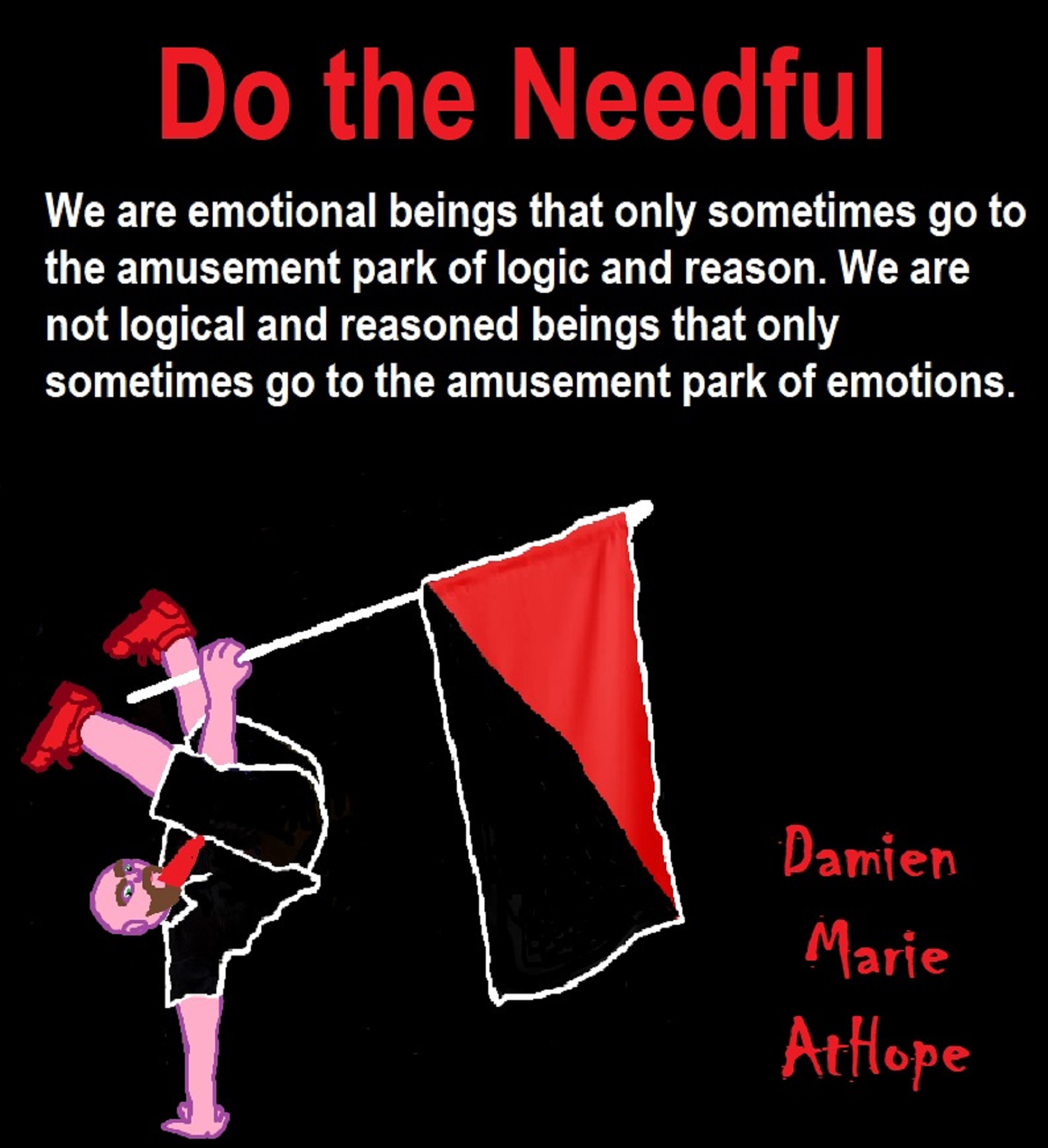

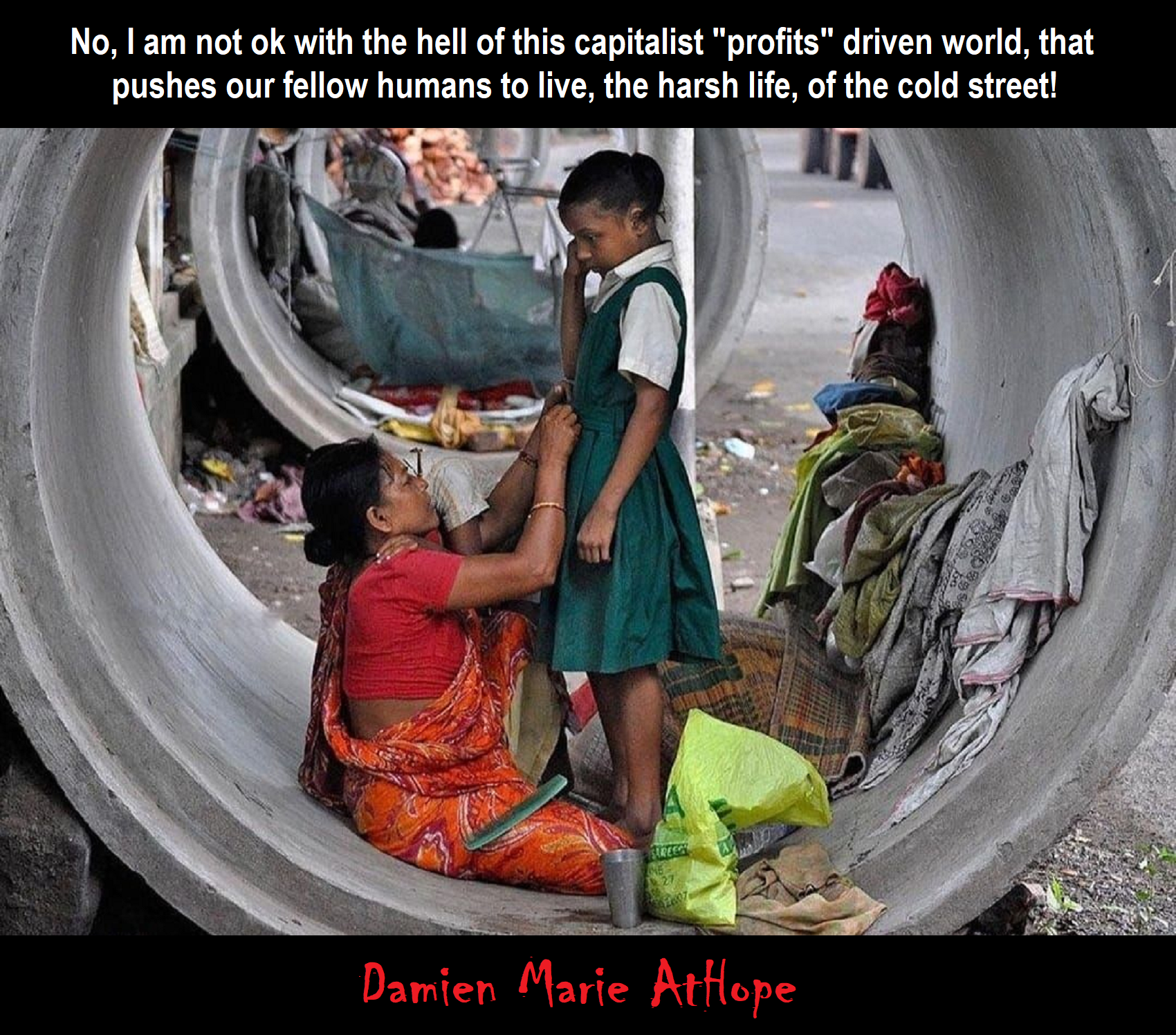

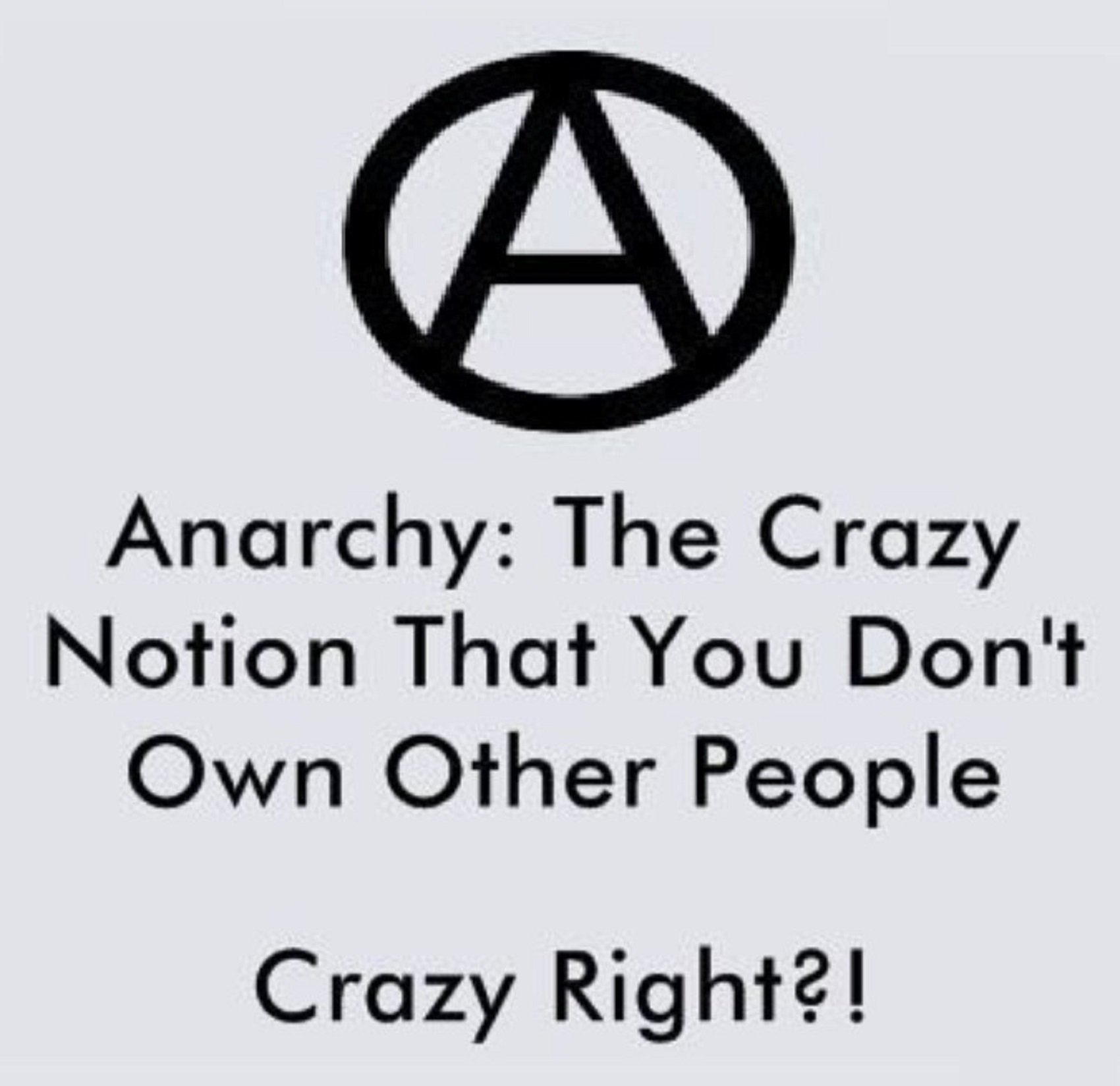

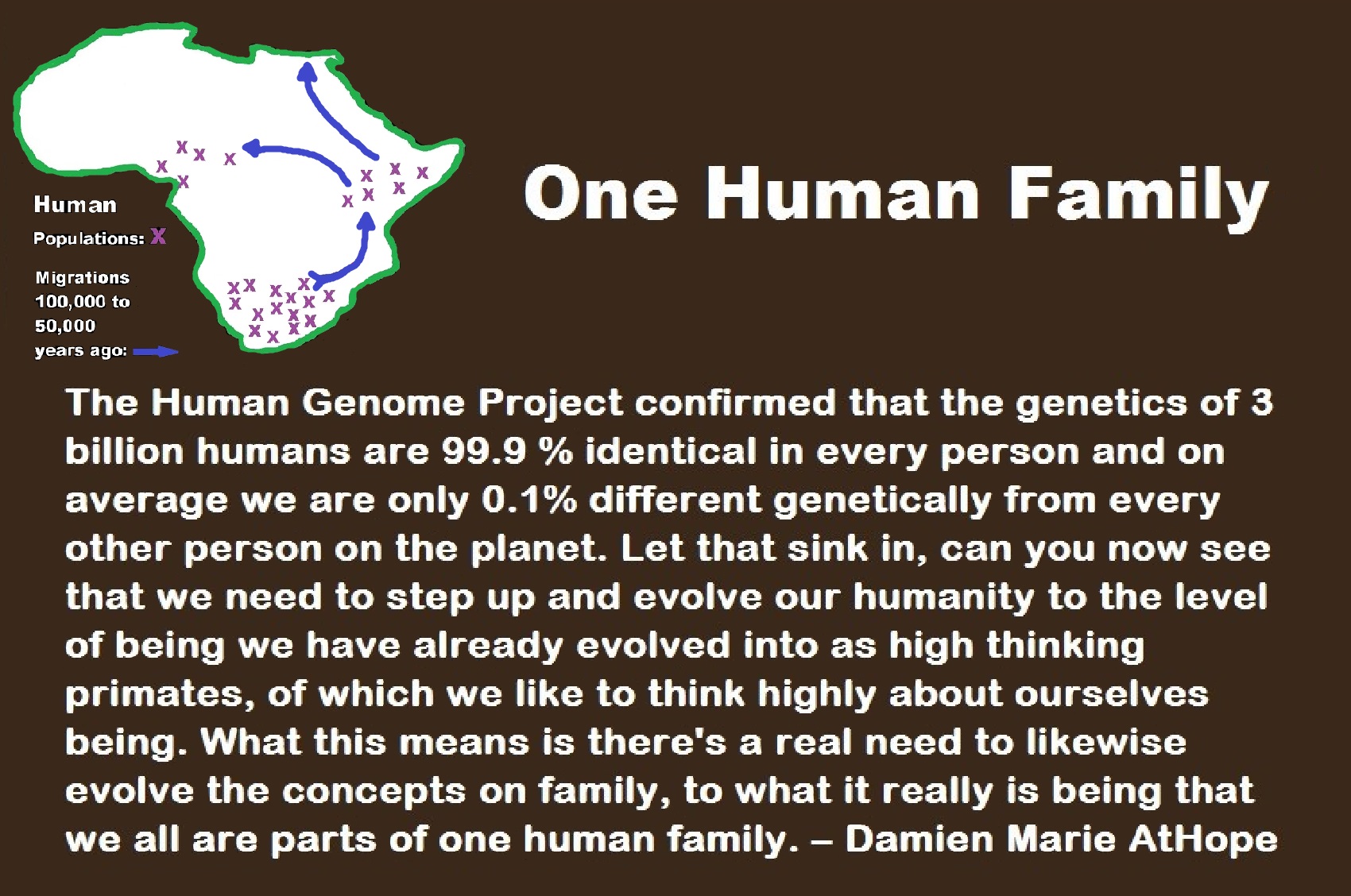

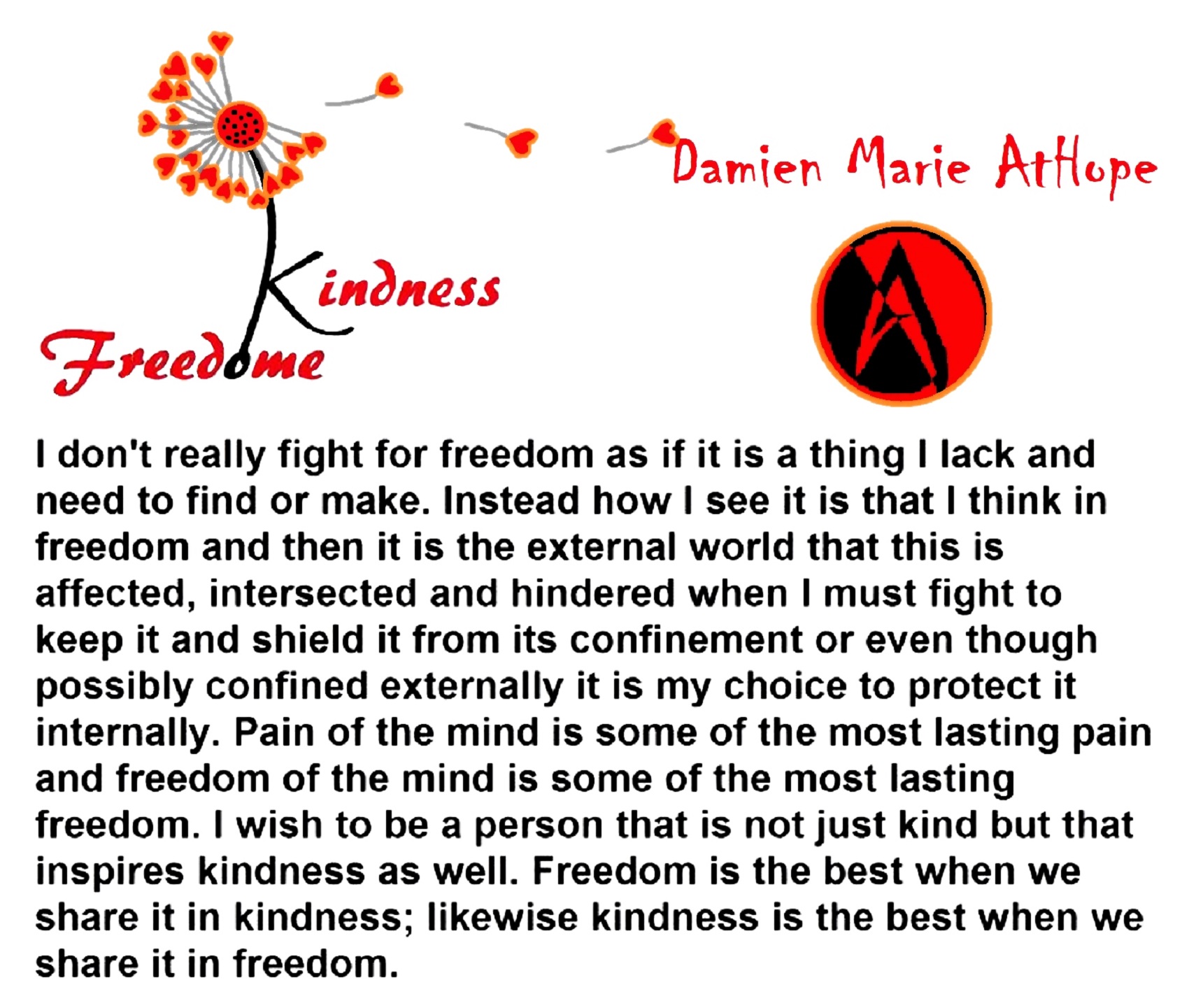
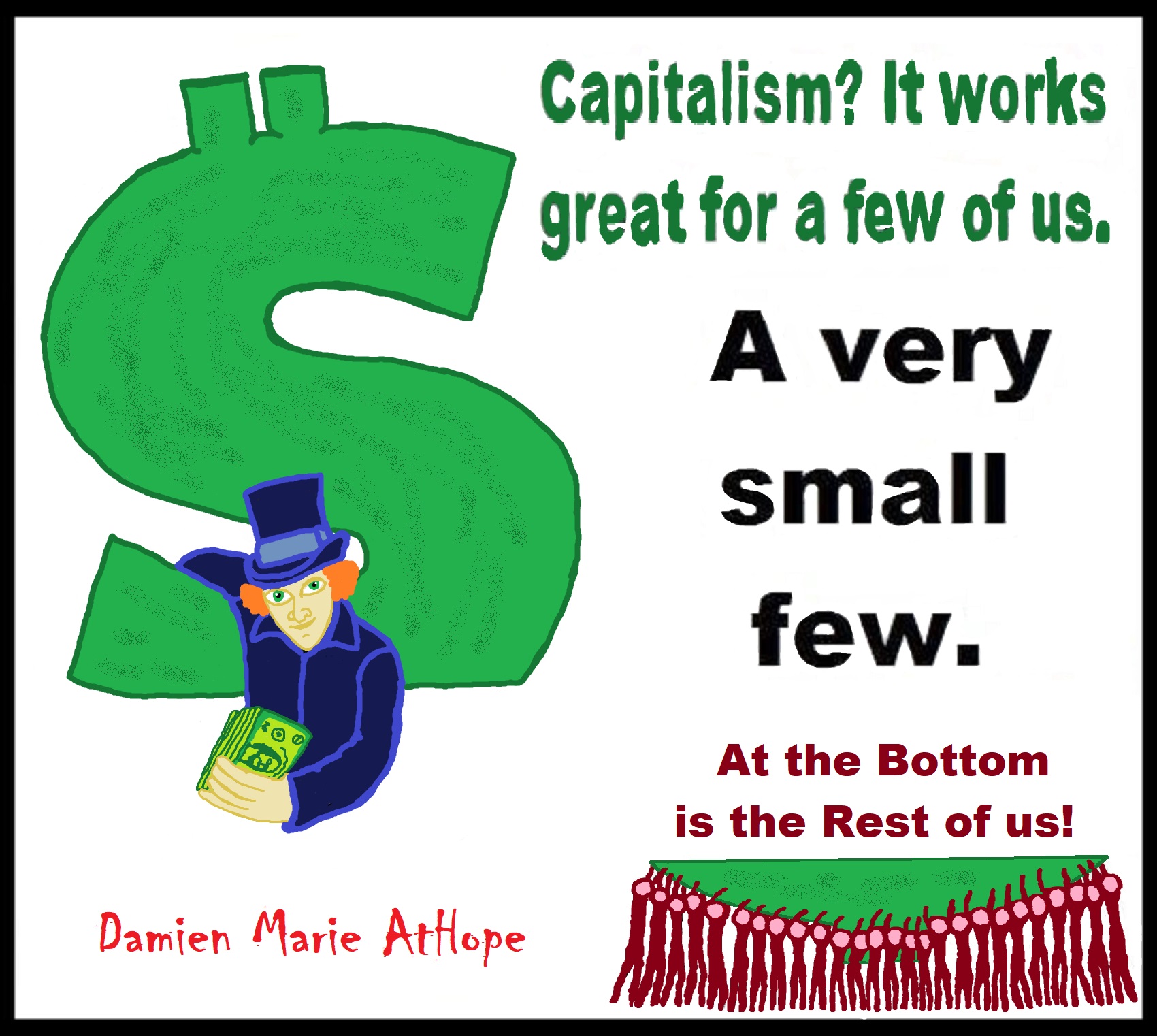
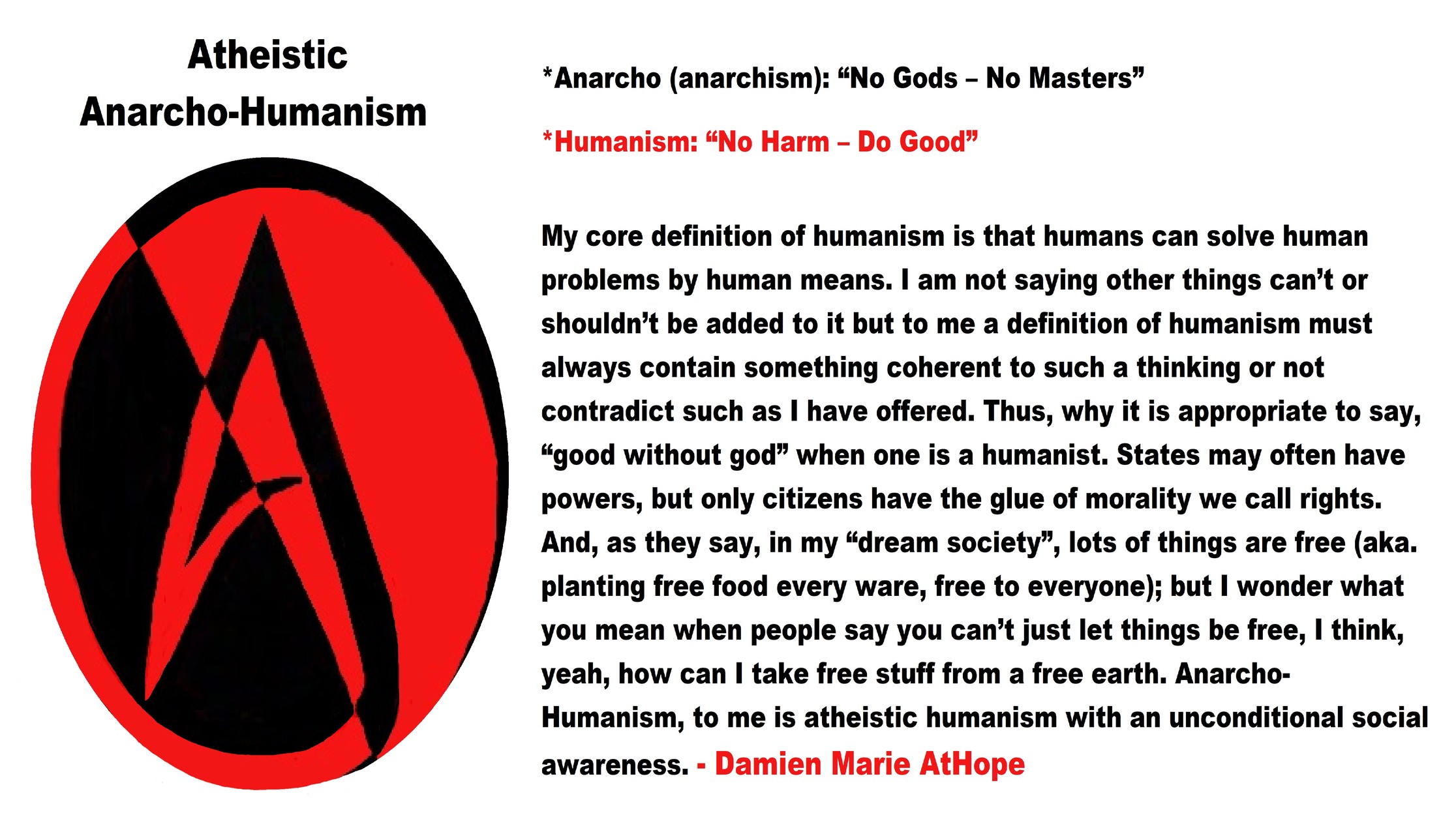
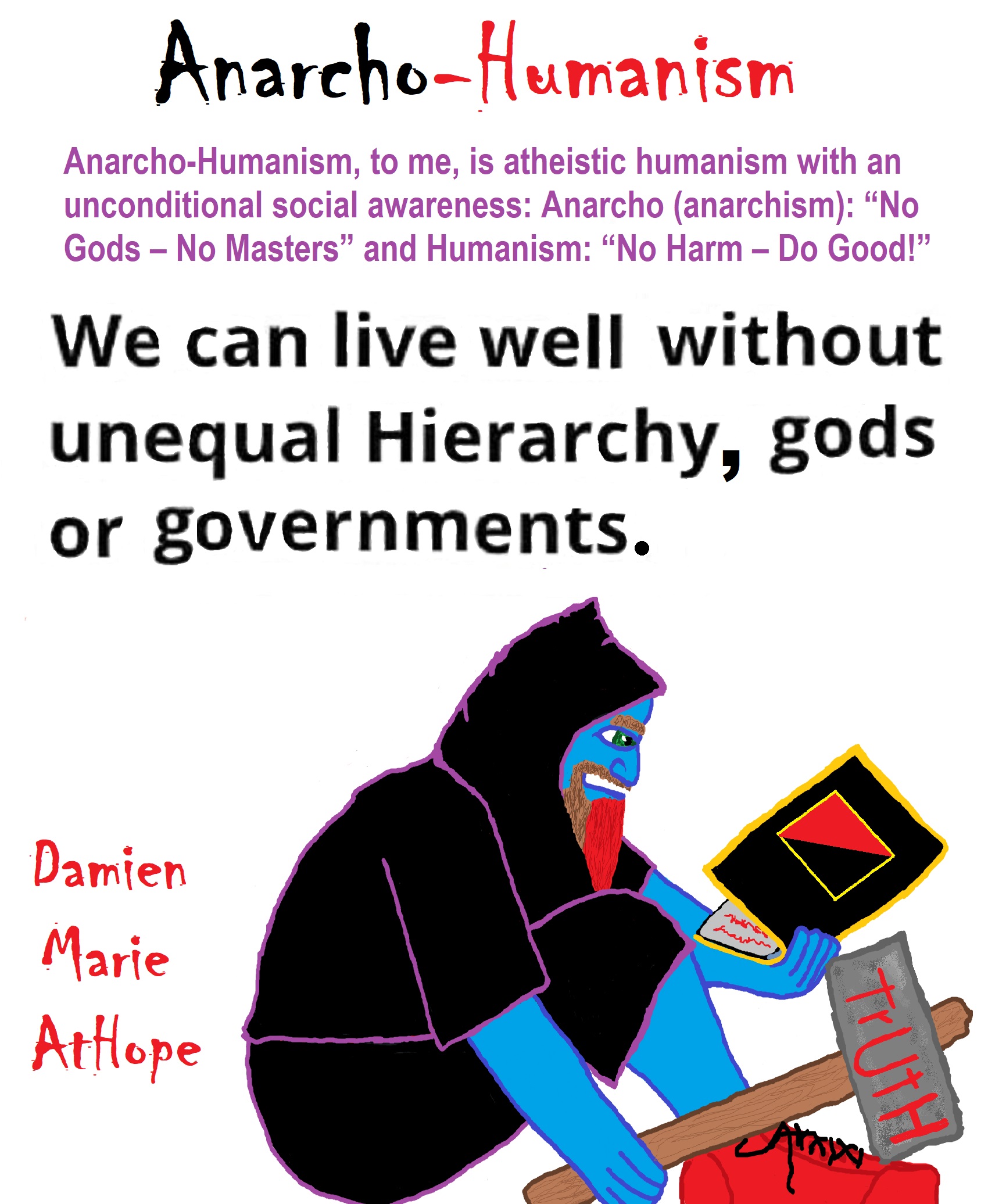
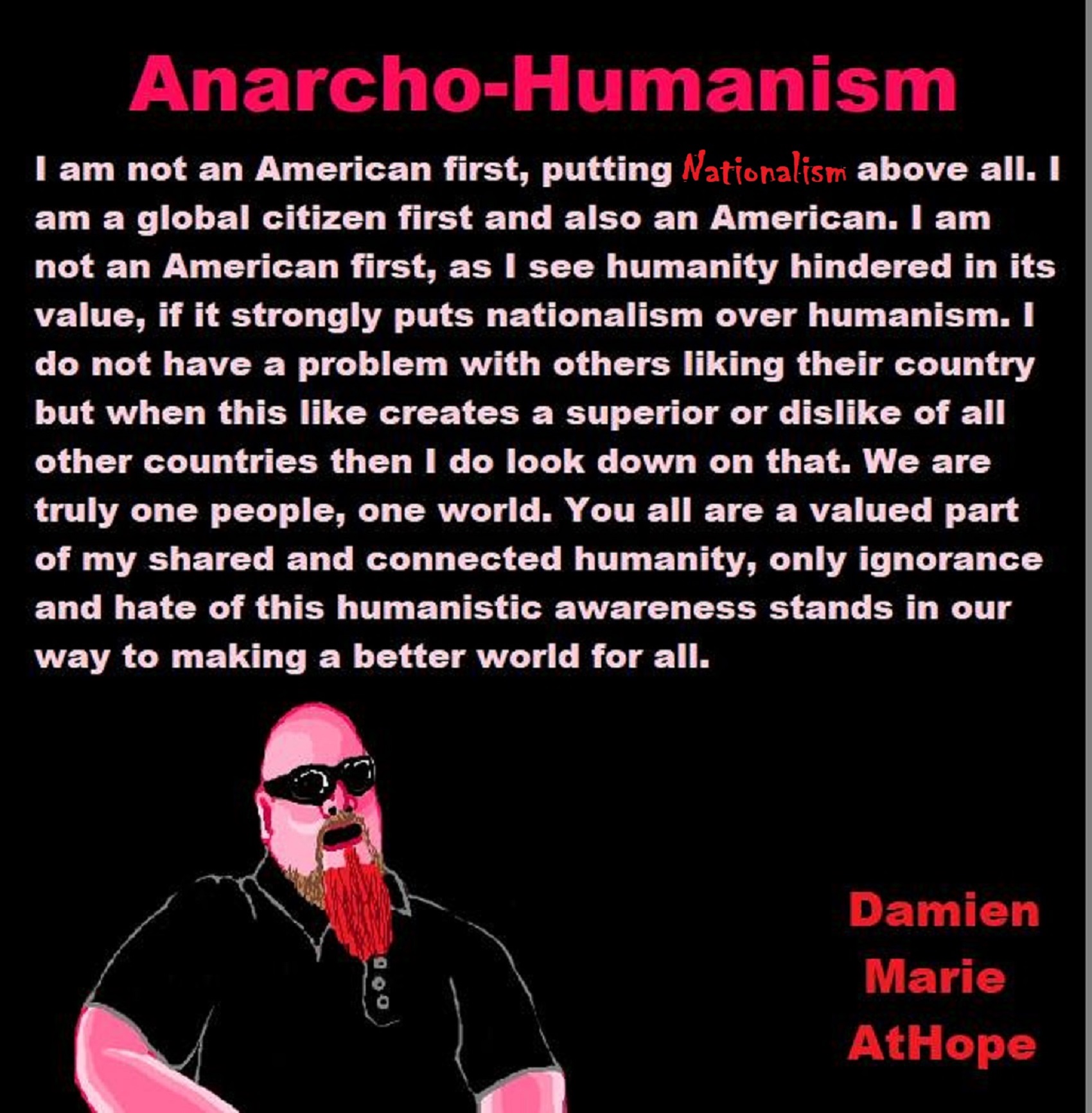
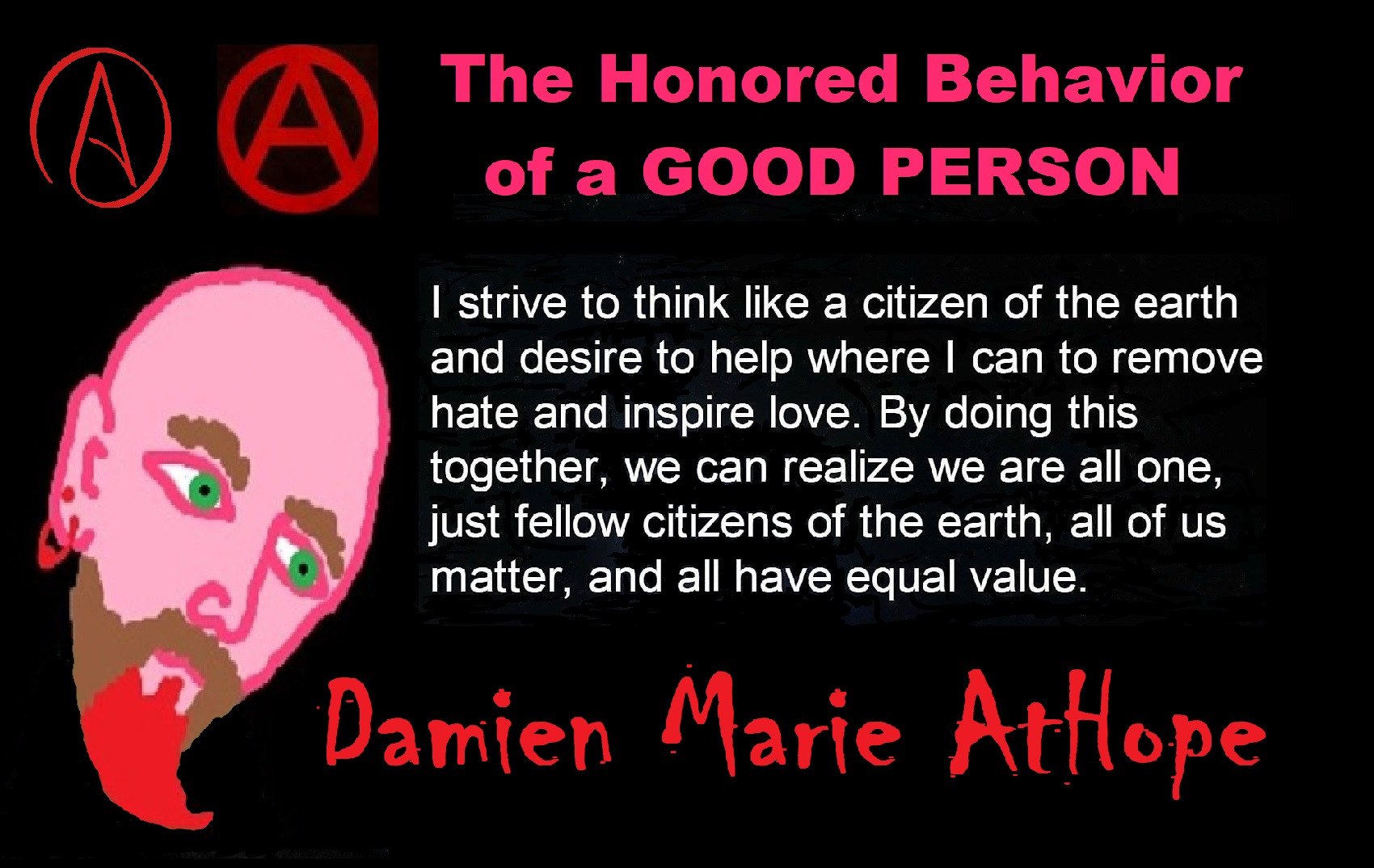
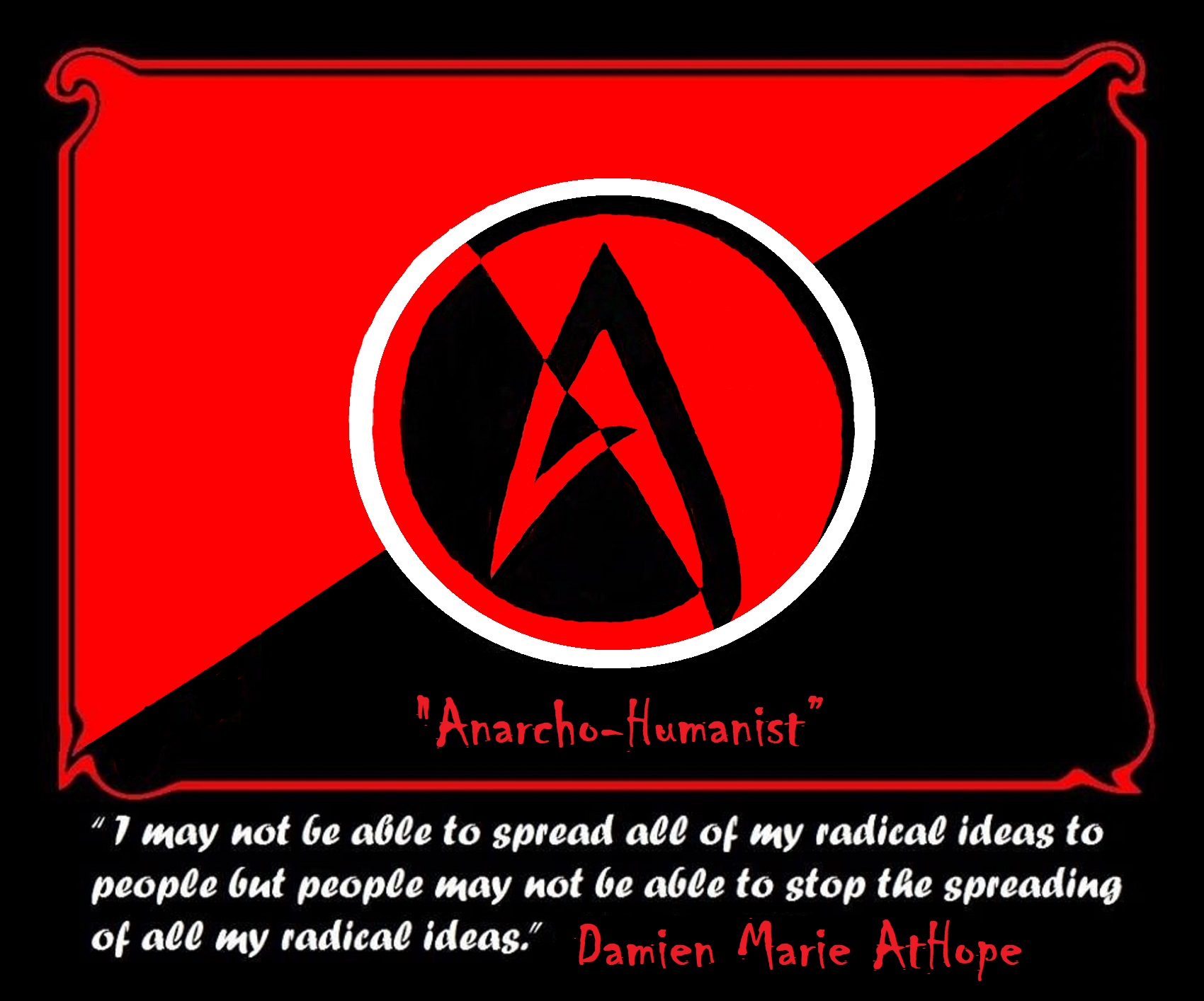
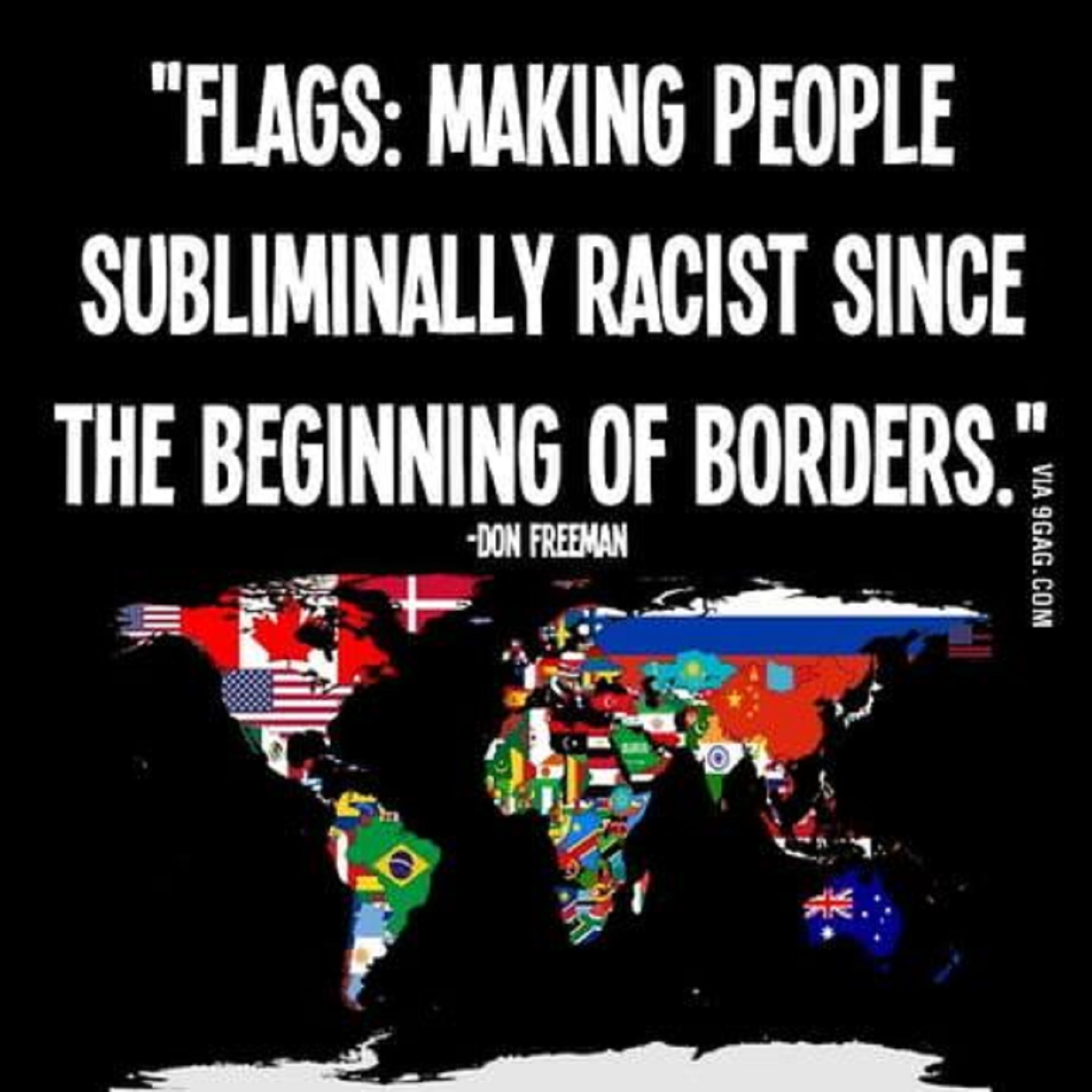
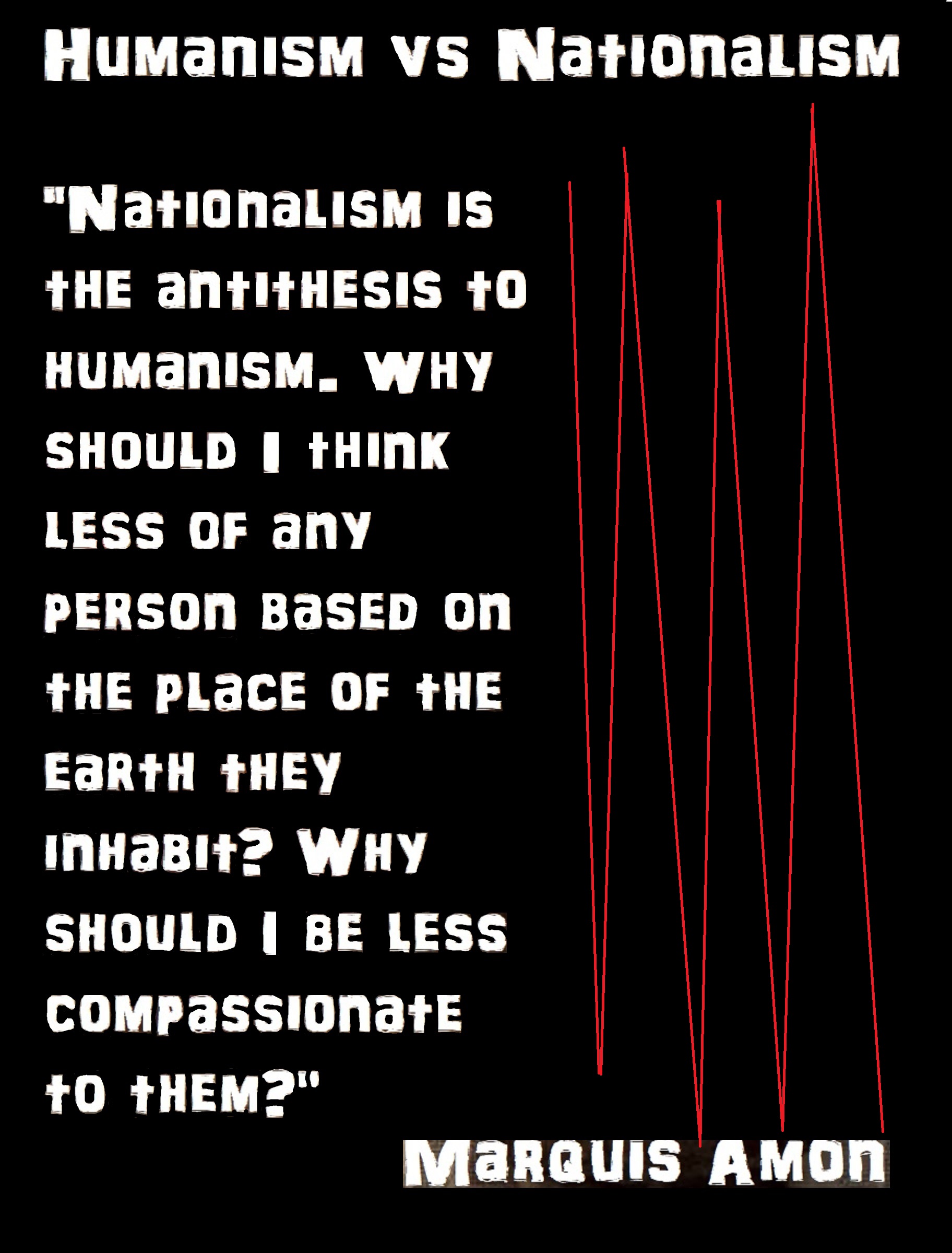


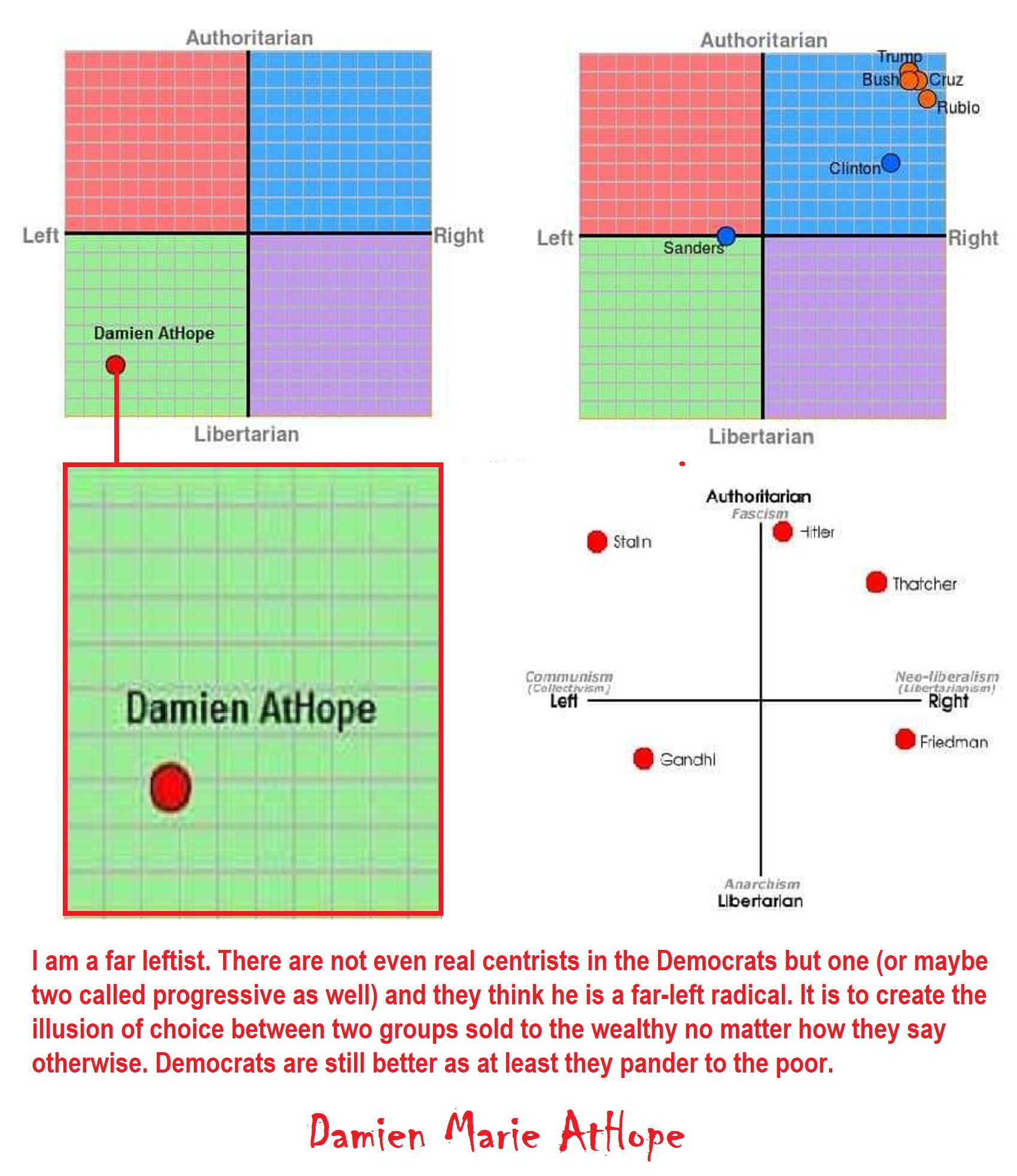
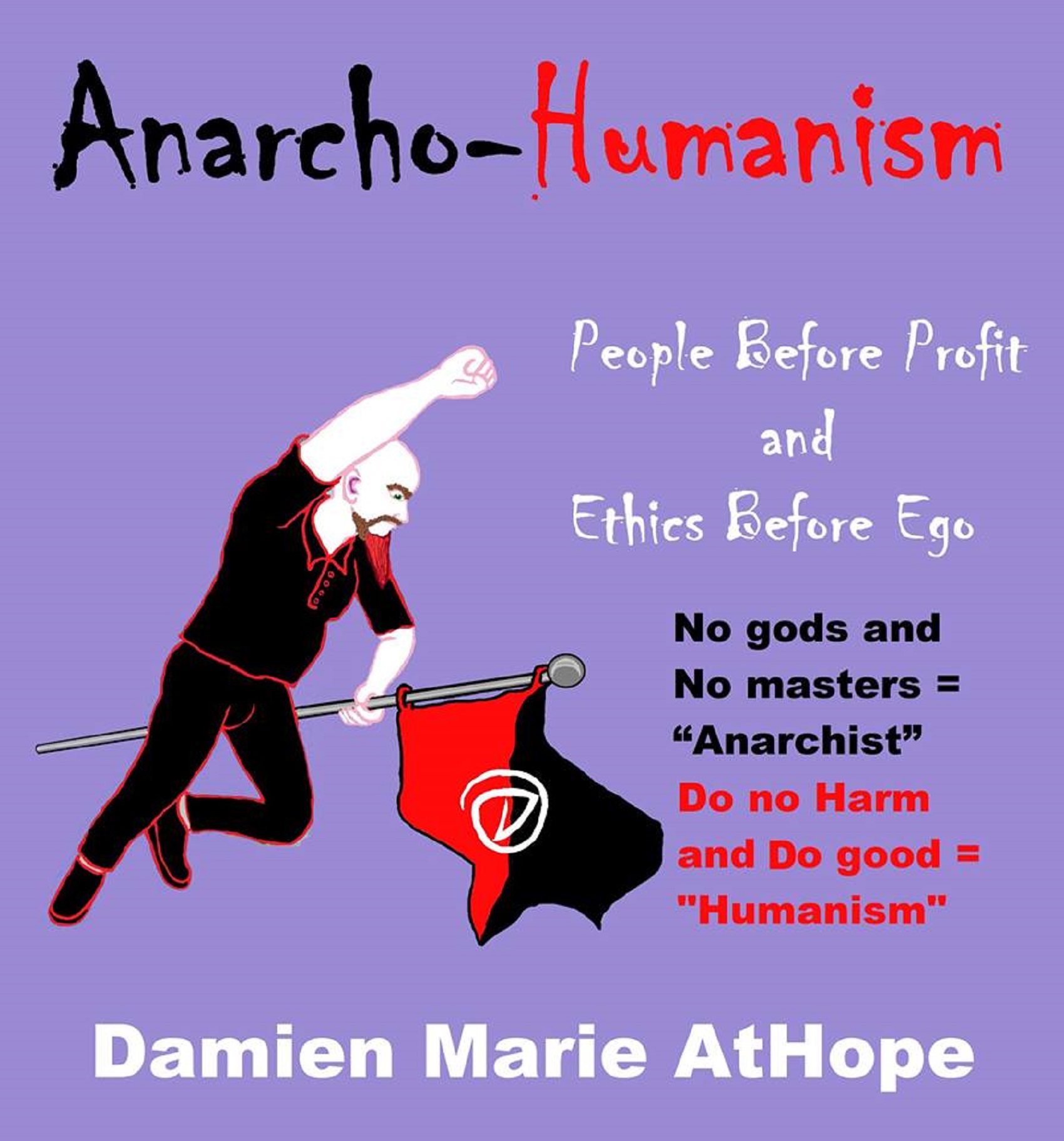
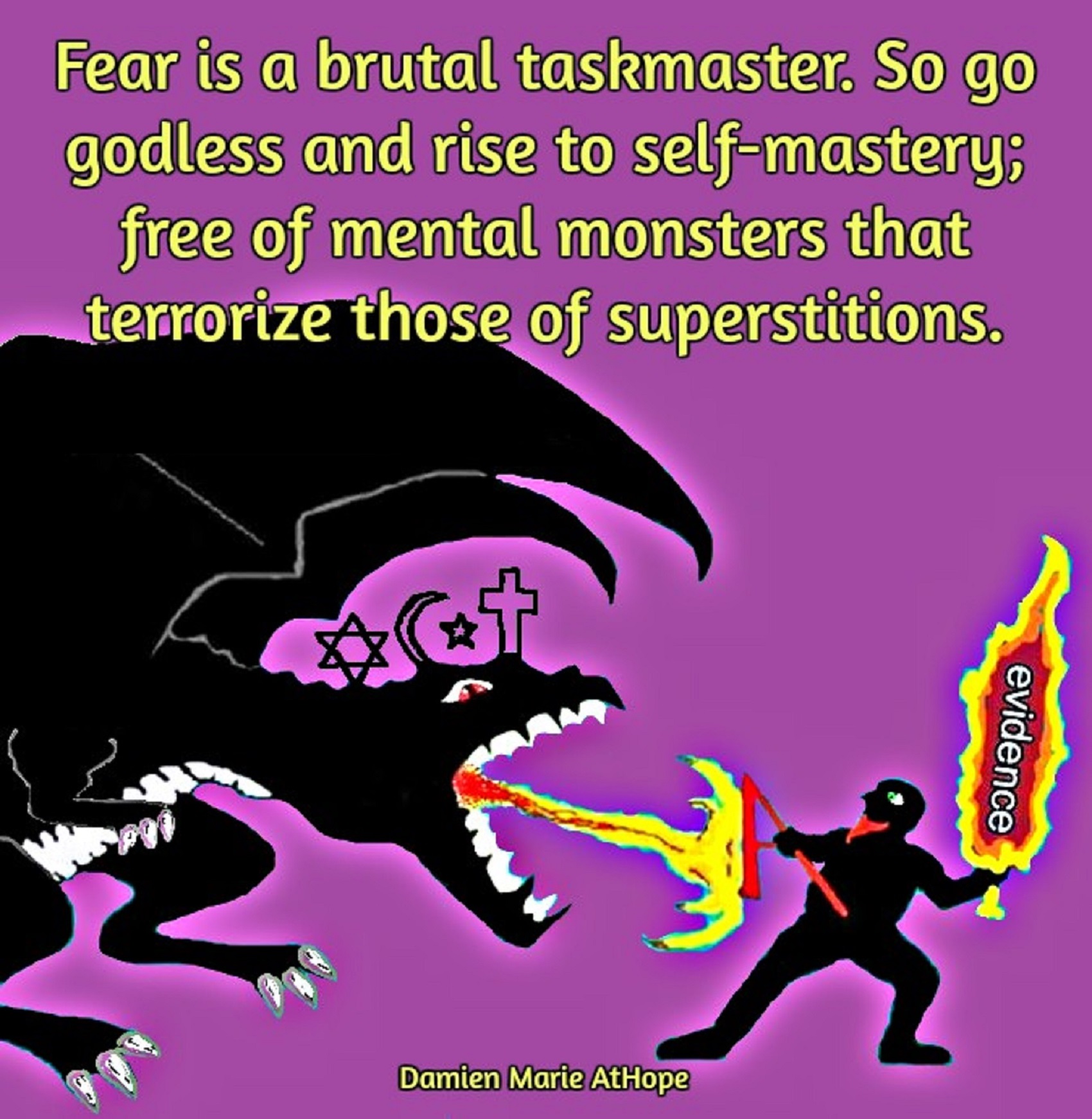


People don’t commonly teach religious history, even that of their own claimed religion. No, rather they teach a limited “pro their religion” history of their religion from a religious perspective favorable to the religion of choice.

Do you truly think “Religious Belief” is only a matter of some personal choice?
Do you not see how coercive one’s world of choice is limited to the obvious hereditary belief, in most religious choices available to the child of religious parents or caregivers? Religion is more commonly like a family, culture, society, etc. available belief that limits the belief choices of the child and that is when “Religious Belief” is not only a matter of some personal choice and when it becomes hereditary faith, not because of the quality of its alleged facts or proposed truths but because everyone else important to the child believes similarly so they do as well simply mimicking authority beliefs handed to them. Because children are raised in religion rather than being presented all possible choices but rather one limited dogmatic brand of “Religious Belief” where children only have a choice of following the belief as instructed, and then personally claim the faith hereditary belief seen in the confirming to the belief they have held themselves all their lives. This is obvious in statements asked and answered by children claiming a faith they barely understand but they do understand that their family believes “this or that” faith, so they feel obligated to believe it too. While I do agree that “Religious Belief” should only be a matter of some personal choice, it rarely is… End Hereditary Religion!

Animism: Respecting the Living World by Graham Harvey
“How have human cultures engaged with and thought about animals, plants, rocks, clouds, and other elements in their natural surroundings? Do animals and other natural objects have a spirit or soul? What is their relationship to humans? In this new study, Graham Harvey explores current and past animistic beliefs and practices of Native Americans, Maori, Aboriginal Australians, and eco-pagans. He considers the varieties of animism found in these cultures as well as their shared desire to live respectfully within larger natural communities. Drawing on his extensive casework, Harvey also considers the linguistic, performative, ecological, and activist implications of these different animisms.” ref

We are like believing machines we vacuum up ideas, like Velcro sticks to almost everything. We accumulate beliefs that we allow to negatively influence our lives, often without realizing it. Our willingness must be to alter skewed beliefs that impend our balance or reason, which allows us to achieve new positive thinking and accurate outcomes.

My thoughts on Religion Evolution with external links for more info:
- (Pre-Animism Africa mainly, but also Europe, and Asia at least 300,000 years ago), (Pre-Animism – Oxford Dictionaries)
- (Animism Africa around 100,000 years ago), (Animism – Britannica.com)
- (Totemism Europe around 50,000 years ago), (Totemism – Anthropology)
- (Shamanism Siberia around 30,000 years ago), (Shamanism – Britannica.com)
- (Paganism Turkey around 12,000 years ago), (Paganism – BBC Religion)
- (Progressed Organized Religion “Institutional Religion” Egypt around 5,000 years ago), (Ancient Egyptian Religion – Britannica.com)
- (CURRENT “World” RELIGIONS after 4,000 years ago) (Origin of Major Religions – Sacred Texts)
- (Early Atheistic Doubting at least by 2,600 years ago) (History of Atheism – Wikipedia)
“Religion is an Evolved Product” and Yes, Religion is Like Fear Given Wings…
Atheists talk about gods and religions for the same reason doctors talk about cancer, they are looking for a cure, or a firefighter talks about fires because they burn people and they care to stop them. We atheists too often feel a need to help the victims of mental slavery, held in the bondage that is the false beliefs of gods and the conspiracy theories of reality found in religions.
Understanding Religion Evolution:
- Pre-Animism (at least 300,000 years ago)
- Animism (Africa: 100,000 years ago)
- Totemism (Europe: 50,000 years ago)
- Shamanism (Siberia: 30,000 years ago)
- Paganism (Turkey: 12,000 years ago)
- Progressed organized religion (Egypt: 5,000 years ago), (Egypt, the First Dynasty 5,150 years ago)
- CURRENT “World” RELIGIONS (after 4,000 years ago)
- Early Atheistic Doubting (at least by 2,600 years ago)
“An Archaeological/Anthropological Understanding of Religion Evolution”
It seems ancient peoples had to survived amazing threats in a “dangerous universe (by superstition perceived as good and evil),” and human “immorality or imperfection of the soul” which was thought to affect the still living, leading to ancestor worship. This ancestor worship presumably led to the belief in supernatural beings, and then some of these were turned into the belief in gods. This feeble myth called gods were just a human conceived “made from nothing into something over and over, changing, again and again, taking on more as they evolve, all the while they are thought to be special,” but it is just supernatural animistic spirit-belief perceived as sacred.
Quick Evolution of Religion?
Pre-Animism (at least 300,000 years ago) pre-religion is a beginning that evolves into later Animism. So, Religion as we think of it, to me, all starts in a general way with Animism (Africa: 100,000 years ago) (theoretical belief in supernatural powers/spirits), then this is physically expressed in or with Totemism (Europe: 50,000 years ago) (theoretical belief in mythical relationship with powers/spirits through a totem item), which then enlists a full-time specific person to do this worship and believed interacting Shamanism (Siberia/Russia: 30,000 years ago) (theoretical belief in access and influence with spirits through ritual), and then there is the further employment of myths and gods added to all the above giving you Paganism (Turkey: 12,000 years ago) (often a lot more nature-based than most current top world religions, thus hinting to their close link to more ancient religious thinking it stems from). My hypothesis is expressed with an explanation of the building of a theatrical house (modern religions development). Progressed organized religion (Egypt: 5,000 years ago) with CURRENT “World” RELIGIONS (after 4,000 years ago).
Historically, in large city-state societies (such as Egypt or Iraq) starting around 5,000 years ago culminated to make religion something kind of new, a sociocultural-governmental-religious monarchy, where all or at least many of the people of such large city-state societies seem familiar with and committed to the existence of “religion” as the integrated life identity package of control dynamics with a fixed closed magical doctrine, but this juggernaut integrated religion identity package of Dogmatic-Propaganda certainly did not exist or if developed to an extent it was highly limited in most smaller prehistoric societies as they seem to lack most of the strong control dynamics with a fixed closed magical doctrine (magical beliefs could be at times be added or removed). Many people just want to see developed religious dynamics everywhere even if it is not. Instead, all that is found is largely fragments until the domestication of religion.
Religions, as we think of them today, are a new fad, even if they go back to around 6,000 years in the timeline of human existence, this amounts to almost nothing when seen in the long slow evolution of religion at least around 70,000 years ago with one of the oldest ritual worship. Stone Snake of South Africa: “first human worship” 70,000 years ago. This message of how religion and gods among them are clearly a man-made thing that was developed slowly as it was invented and then implemented peace by peace discrediting them all. Which seems to be a simple point some are just not grasping how devastating to any claims of truth when we can see the lie clearly in the archeological sites.
I wish people fought as hard for the actual values as they fight for the group/clan names political or otherwise they think support values. Every amount spent on war is theft to children in need of food or the homeless kept from shelter.
Here are several of my blog posts on history:
- To Find Truth You Must First Look
- (Magdalenian/Iberomaurusian) Connections to the First Paganists of the early Neolithic Near East Dating from around 17,000 to 12,000 Years Ago
- Natufians: an Ancient People at the Origins of Agriculture and Sedentary Life
- Possible Clan Leader/Special “MALE” Ancestor Totem Poles At Least 13,500 years ago?
- Jewish People with DNA at least 13,200 years old, Judaism, and the Origins of Some of its Ideas
- Baltic Reindeer Hunters: Swiderian, Lyngby, Ahrensburgian, and Krasnosillya cultures 12,020 to 11,020 years ago are evidence of powerful migratory waves during the last 13,000 years and a genetic link to Saami and the Finno-Ugric peoples.
- The Rise of Inequality: patriarchy and state hierarchy inequality
- Fertile Crescent 12,500 – 9,500 Years Ago: fertility and death cult belief system?
- 12,400 – 11,700 Years Ago – Kortik Tepe (Turkey) Pre/early-Agriculture Cultic Ritualism
- Ritualistic Bird Symbolism at Gobekli Tepe and its “Ancestor Cult”
- Male-Homosexual (female-like) / Trans-woman (female) Seated Figurine from Gobekli Tepe
- Could a 12,000-year-old Bull Geoglyph at Göbekli Tepe relate to older Bull and Female Art 25,000 years ago and Later Goddess and the Bull cults like Catal Huyuk?
- Sedentism and the Creation of goddesses around 12,000 years ago as well as male gods after 7,000 years ago.
- Alcohol, where Agriculture and Religion Become one? Such as Gobekli Tepe’s Ritualistic use of Grain as Food and Ritual Drink
- Neolithic Ritual Sites with T-Pillars and other Cultic Pillars
- Paganism: Goddesses around 12,000 years ago then Male Gods after 7,000 years ago
- First Patriarchy: Split of Women’s Status around 12,000 years ago & First Hierarchy: fall of Women’s Status around 5,000 years ago.
- Natufians: an Ancient People at the Origins of Agriculture and Sedentary Life
- J DNA and the Spread of Agricultural Religion (paganism)
- Paganism: an approximately 12,000-year-old belief system
- Paganism 12,000 years old: related to “Anarchism and Socialism” (Pre-Capitalism)
- Shaman burial in Israel 12,000 years ago and the Shamanism Phenomena
- Need to Mythicized: gods and goddesses
- 12,000 – 7,000 Years Ago – Paleo-Indian Culture (The Americas)
- 12,000 – 2,000 Years Ago – Indigenous-Scandinavians (Nordic)
- Norse did not wear helmets with horns?
- Pre-Pottery Neolithic Skull Cult around 11,500 to 8,400 Years Ago?
- 10,400 – 10,100 Years Ago, in Turkey the Nevail Cori Religious Settlement
- 9,000-6,500 Years Old Submerged Pre-Pottery/Pottery Neolithic Ritual Settlements off Israel’s Coast
- Catal Huyuk “first religious designed city” around 9,500 to 7,700 years ago (Turkey)
- Cultic Hunting at Catal Huyuk “first religious designed city”
- Special Items and Art as well as Special Elite Burials at Catal Huyuk
- New Rituals and Violence with the appearance of Pottery and People?
- Haplogroup N and its related Uralic Languages and Cultures
- Ainu people, Sámi people, Native Americans, the Ancient North Eurasians, and Paganistic-Shamanism with Totemism
- Ideas, Technology and People from Turkey, Europe, to China and Back again 9,000 to 5,000 years ago?
- First Pottery of Europe and the Related Cultures
- 9,000 years old Neolithic Artifacts Judean Desert and Hills Israel
- 9,000-7,000 years-old Sex and Death Rituals: Cult Sites in Israel, Jordan, and the Sinai
- 9,000-8500 year old Horned Female shaman Bad Dürrenberg Germany
- Neolithic Jewelry and the Spread of Farming in Europe Emerging out of West Turkey
- 8,600-year-old Tortoise Shells in Neolithic graves in central China have Early Writing and Shamanism
- Swing of the Mace: the rise of Elite, Forced Authority, and Inequality begin to Emerge 8,500 years ago?
- Migrations and Changing Europeans Beginning around 8,000 Years Ago
- My “Steppe-Anatolian-Kurgan hypothesis” 8,000/7,000 years ago
- Around 8,000-year-old Shared Idea of the Mistress of Animals, “Ritual” Motif
- Pre-Columbian Red-Paint (red ochre) Maritime Archaic Culture 8,000-3,000 years ago
- 7,522-6,522 years ago Linear Pottery culture which I think relates to Arcane Capitalism’s origins
- Arcane Capitalism: Primitive socialism, Primitive capital, Private ownership, Means of production, Market capitalism, Class discrimination, and Petite bourgeoisie (smaller capitalists)
- 7,500-4,750 years old Ritualistic Cucuteni-Trypillian culture of Moldova, Romania, and Ukraine
- Roots of a changing early society 7,200-6,700 years ago Jordan and Israel
- Agriculture religion (Paganism) with farming reached Britain between about 7,000 to 6,500 or so years ago and seemingly expressed in things like Western Europe’s Long Barrows
- My Thoughts on Possible Migrations of “R” DNA and Proto-Indo-European?
- “Millet” Spreading from China 7,022 years ago to Europe and related Language may have Spread with it leading to Proto-Indo-European
- Proto-Indo-European (PIE), ancestor of Indo-European languages: DNA, Society, Language, and Mythology
- The Dnieper–Donets culture and Asian varieties of Millet from China to the Black Sea region of Europe by 7,022 years ago
- Kurgan 6,000 years ago/dolmens 7,000 years ago: funeral, ritual, and other?
- 7,020 to 6,020-year-old Proto-Indo-European Homeland of Urheimat or proposed home of their Language and Religion
- Ancient Megaliths: Kurgan, Ziggurat, Pyramid, Menhir, Trilithon, Dolman, Kromlech, and Kromlech of Trilithons
- The Mytheme of Ancient North Eurasian Sacred-Dog belief and similar motifs are found in Indo-European, Native American, and Siberian comparative mythology
- Elite Power Accumulation: Ancient Trade, Tokens, Writing, Wealth, Merchants, and Priest-Kings
- Sacred Mounds, Mountains, Kurgans, and Pyramids may hold deep connections?
- Between 7,000-5,000 Years ago, rise of unequal hierarchy elite, leading to a “birth of the State” or worship of power, strong new sexism, oppression of non-elites, and the fall of Women’s equal status
- Paganism 7,000-5,000 years old: related to “Anarchism and Socialism” (Capitalism) (World War 0) Elite & their slaves
- Hell and Underworld mythologies starting maybe as far back as 7,000 to 5,000 years ago with the Proto-Indo-Europeans?
- The First Expression of the Male God around 7,000 years ago?
- White (light complexion skin) Bigotry and Sexism started 7,000 years ago?
- Around 7,000-year-old Shared Idea of the Divine Bird (Tutelary and/or Trickster spirit/deity), “Ritual” Motif
- Nekhbet an Ancient Egyptian Vulture Goddess and Tutelary Deity
- 6,720 to 4,920 years old Ritualistic Hongshan Culture of Inner Mongolia with 5,000-year-old Pyramid Mounds and Temples
- First proto-king in the Balkans, Varna culture around 6,500 years ago?
- 6,500–5,800 years ago in Israel Late Chalcolithic (Copper Age) Period in the Southern Levant Seems to Express Northern Levant Migrations, Cultural and Religious Transfer
- KING OF BEASTS: Master of Animals “Ritual” Motif, around 6,000 years old or older…
- Around 6000-year-old Shared Idea of the Solid Wheel & the Spoked Wheel-Shaped Ritual Motif
- “The Ghassulian Star,” a mysterious 6,000-year-old mural from Jordan; a Proto-Star of Ishtar, Star of Inanna or Star of Venus?
- Religious/Ritual Ideas, including goddesses and gods as well as ritual mounds or pyramids from Northeastern Asia at least 6,000 years old, seemingly filtering to Iran, Iraq, the Mediterranean, Europe, Egypt, and the Americas?
- Maykop (5,720–5,020 years ago) Caucasus region Bronze Age culture-related to Copper Age farmers from the south, influenced by the Ubaid period and Leyla-Tepe culture, as well as influencing the Kura-Araxes culture
- 5-600-year-old Tomb, Mummy, and First Bearded Male Figurine in a Grave
- Kura-Araxes Cultural 5,520 to 4,470 years old DNA traces to the Canaanites, Arabs, and Jews
- Minoan/Cretan (Keftiu) Civilization and Religion around 5,520 to 3,120 years ago
- Evolution Of Science at least by 5,500 years ago
- 5,500 Years old birth of the State, the rise of Hierarchy, and the fall of Women’s status
- “Jiroft culture” 5,100 – 4,200 years ago and the History of Iran
- Stonehenge: Paganistic Burial and Astrological Ritual Complex, England (5,100-3,600 years ago)
- Around 5,000-year-old Shared Idea of the “Tree of Life” Ritual Motif
- Complex rituals for elite, seen from China to Egypt, at least by 5,000 years ago
- Around 5,000 years ago: “Birth of the State” where Religion gets Military Power and Influence
- The Center of the World “Axis Mundi” and/or “Sacred Mountains” Mythology Could Relate to the Altai Mountains, Heart of the Steppe
- Progressed organized religion starts, an approximately 5,000-year-old belief system
- China’s Civilization between 5,000-3,000 years ago, was a time of war and class struggle, violent transition from free clans to a Slave or Elite society
- Origin of Logics is Naturalistic Observation at least by around 5,000 years ago.
- Paganism 5,000 years old: progressed organized religion and the state: related to “Anarchism and Socialism” (Kings and the Rise of the State)
- Ziggurats (multi-platform temples: 4,900 years old) to Pyramids (multi-platform tombs: 4,700 years old)
- Did a 4,520–4,420-year-old Volcano In Turkey Inspire the Bible God?
- Finland’s Horned Shaman and Pre-Horned-God at least 4,500 years ago?
- 4,000-year-Old Dolmens in Israel: A Connected Dolmen Religious Phenomenon?
- Creation myths: From chaos, Ex nihilo, Earth-diver, Emergence, World egg, and World parent
- Bronze Age “Ritual” connections of the Bell Beaker culture with the Corded Ware/Single Grave culture, which were related to the Yamnaya culture and Proto-Indo-European Languages/Religions
- Low Gods (Earth/ Tutelary deity), High Gods (Sky/Supreme deity), and Moralistic Gods (Deity enforcement/divine order)
- The exchange of people, ideas, and material-culture including, to me, the new god (Sky Father) and goddess (Earth Mother) religion between the Cucuteni-Trypillians and others which is then spread far and wide
- Koryaks: Indigenous People of the Russian Far East and Big Raven myths also found in Tlingit, Haida, Tsimshian, and other Indigenous People of North America
- 42 Principles Of Maat (Egyptian Goddess of the justice) around 4,400 years ago, 2000 Years Before Ten Commandments
- “Happy Easter” Well Happy Eostre/Ishter
- 4,320-3,820 years old “Shimao” (North China) site with Totemistic-Shamanistic Paganism and a Stepped Pyramid
- 4,250 to 3,400 Year old Stonehenge from Russia: Arkaim?
- 4,100-year-old beaker with medicinal & flowering plants in a grave of a woman in Scotland
- Early European Farmer ancestry, Kelif el Boroud people with the Cardial Ware culture, and the Bell Beaker culture Paganists too, spread into North Africa, then to the Canary Islands off West Africa
- Flood Accounts: Gilgamesh epic (4,100 years ago) Noah in Genesis (2,600 years ago)
- Paganism 4,000 years old: related to “Anarchism and Socialism” (First Moralistic gods, then the Origin time of Monotheism)
- When was the beginning: TIMELINE OF CURRENT RELIGIONS, which start around 4,000 years ago.
- Early Religions Thought to Express Proto-Monotheistic Systems around 4,000 years ago
- Kultepe? An archaeological site with a 4,000 years old women’s rights document.
- Single God Religions (Monotheism) = “Man-o-theism” started around 4,000 years ago with the Great Sky Spirit/God Tiān (天)?
- Confucianism’s Tiān (Shangdi god 4,000 years old): Supernaturalism, Pantheism or Theism?
- Yes, Your Male God is Ridiculous
- Mythology, a Lunar Deity is a Goddess or God of the Moon
- Sacred Land, Hills, and Mountains: Sami Mythology (Paganistic Shamanism)
- Horse Worship/Sacrifice: mythical union of Ruling Elite/Kingship and the Horse
- The Amorite/Amurru people’s God Amurru “Lord of the Steppe”, relates to the Origins of the Bible God?
- Bronze Age Exotic Trade Routes Spread Quite Far as well as Spread Religious Ideas with Them
- Sami and the Northern Indigenous Peoples Landscape, Language, and its Connection to Religion
- Prototype of Ancient Analemmatic Sundials around 3,900-3,150 years ago and a Possible Solar Connection to gods?
- Judaism is around 3,450 or 3,250 years old. (“Paleo-Hebrew” 3,000 years ago and Torah 2,500 years ago)
- The Weakening of Ancient Trade and the Strengthening of Religions around 3000 years ago?
- Are you aware that there are religions that worship women gods, explain now religion tears women down?
- Animistic, Totemistic, and Paganistic Superstition Origins of bible god and the bible’s Religion.
- Myths and Folklore: “Trickster gods and goddesses”
- Jews, Judaism, and the Origins of Some of its Ideas
- An Old Branch of Religion Still Giving Fruit: Sacred Trees
- Dating the BIBLE: naming names and telling times (written less than 3,000 years ago, provable to 2,200 years ago)
- Did a Volcano Inspire the bible god?
- Dené–Yeniseian language, Old Copper Complex, and Pre-Columbian Mound Builders?
- No “dinosaurs and humans didn’t exist together just because some think they are in the bible itself”
- Sacred Shit and Sacred Animals?
- Everyone Killed in the Bible Flood? “Nephilim” (giants)?
- Hey, Damien dude, I have a question for you regarding “the bible” Exodus.
- Archaeology Disproves the Bible
- Bible Battle, Just More, Bible Babble
- The Jericho Conquest lie?
- Canaanites and Israelites?
- Accurate Account on how did Christianity Began?
- Let’s talk about Christianity.
- So the 10 commandments isn’t anything to go by either right?
- Misinformed christian
- Debunking Jesus?
- Paulism vs Jesus
- Ok, you seem confused so let’s talk about Buddhism.
- Unacknowledged Buddhism: Gods, Savior, Demons, Rebirth, Heavens, Hells, and Terrorism
- His Foolishness The Dalai Lama
- Yin and Yang is sexist with an ORIGIN around 2,300 years ago?
- I Believe Archaeology, not Myths & Why Not, as the Religious Myths Already Violate Reason!
- Archaeological, Scientific, & Philosophic evidence shows the god myth is man-made nonsense.
- Aquatic Ape Theory/Hypothesis? As Always, Just Pseudoscience.
- Ancient Aliens Conspiracy Theorists are Pseudohistorians
- The Pseudohistoric and Pseudoscientific claims about “Bakoni Ruins” of South Africa
- Why do people think Religion is much more than supernaturalism and superstitionism?
- Religion is an Evolved Product
- Was the Value of Ancient Women Different?
- 1000 to 1100 CE, human sacrifice Cahokia Mounds a pre-Columbian Native American site
- Feminist atheists as far back as the 1800s?
- Promoting Religion as Real is Mentally Harmful to a Flourishing Humanity
- Screw All Religions and Their Toxic lies, they are all fraud
- Forget Religions’ Unfounded Myths, I Have Substantiated “Archaeology Facts.”
- Religion Dispersal throughout the World
- I Hate Religion Just as I Hate all Pseudoscience
- Exposing Scientology, Eckankar, Wicca and Other Nonsense?
- Main deity or religious belief systems
- Quit Trying to Invent Your God From the Scraps of Science.
- Archaeological, Scientific, & Philosophic evidence shows the god myth is man-made nonsense.
- Ancient Alien Conspiracy Theorists: Misunderstanding, Rhetoric, Misinformation, Fabrications, and Lies
- Misinformation, Distortion, and Pseudoscience in Talking with a Christian Creationist
- Judging the Lack of Goodness in Gods, Even the Norse God Odin
- Challenging the Belief in God-like Aliens and Gods in General
- A Challenge to Christian use of Torture Devices?
- Yes, Hinduism is a Religion
- Trump is One of the Most Reactionary Forces of Far-right Christian Extremism
- Was the Bull Head a Symbol of God? Yes!
- Primate Death Rituals
- Christian – “God and Christianity are objectively true”
- Australopithecus afarensis Death Ritual?
- You Claim Global Warming is a Hoax?
- Doubter of Science and Defamer of Atheists?
- I think that sounds like the Bible?
- History of the Antifa (“anti-fascist”) Movements
- Indianapolis Anti-Blasphemy Laws #Free Soheil Rally
- Damien, you repeat the golden rule in so many forms then you say religion is dogmatic?
- Science is a Trustable Methodology whereas Faith is not Trustable at all!
- Was I ever a believer, before I was an atheist?
- Atheists rise in reason
- Mistrust of science?
- Open to Talking About the Definition of ‘God’? But first, we address Faith.
- ‘United Monarchy’ full of splendor and power – Saul, David, and Solomon? Most likely not.
- Is there EXODUS ARCHAEOLOGY? The short answer is “no.”
- Lacking Proof of Bigfoots, Unicorns, and Gods is Just a Lack of Research?
- Religion and Politics: Faith Beliefs vs. Rational Thinking
- Hammer of Truth that lying pig RELIGION: challenged by an archaeologist
- “The Hammer of Truth” -ontology question- What do You Mean by That?
- Navigation of a bad argument: Ad Hominem vs. Attack
- Why is it Often Claimed that Gods have a Gender?
- Why are basically all monotheistic religions ones that have a male god?
- Shifting through the Claims in support of Faith
- Dear Mr. AtHope, The 20th Century is an Indictment of Secularism and a Failed Atheist Century
- An Understanding of the Worldwide Statistics and Dynamics of Terrorist Incidents and Suicide Attacks
- Intoxication and Evolution? Addressing and Assessing the “Stoned Ape” or “Drunken Monkey” Theories as Catalysts in Human Evolution
- Sacred Menstrual cloth? Inanna’s knot, Isis knot, and maybe Ma’at’s feather?
- Damien, why don’t the Hebrews accept the bible stories?
- Dealing with a Troll and Arguing Over Word Meaning
- Knowledge without Belief? Justified beliefs or disbeliefs worthy of Knowledge?
- Afrocentrism and African Religions
- Crecganford @crecganford offers history & stories of the people, places, gods, & culture
- Empiricism-Denier?
I am not an academic. I am a revolutionary that teaches in public, in places like social media, and in the streets. I am not a leader by some title given but from my commanding leadership style of simply to start teaching everywhere to everyone, all manner of positive education.









ref, ref, ref, ref, ref, ref, ref, ref, ref, ref, ref, ref, ref, ref, ref, ref, ref, ref, ref, ref, ref
Low Gods “Earth” or Tutelary deity and High Gods “Sky” or Supreme deity
“An Earth goddess is a deification of the Earth. Earth goddesses are often associated with the “chthonic” deities of the underworld. Ki and Ninhursag are Mesopotamian earth goddesses. In Greek mythology, the Earth is personified as Gaia, corresponding to Roman Terra, Indic Prithvi/Bhūmi, etc. traced to an “Earth Mother” complementary to the “Sky Father” in Proto-Indo-European religion. Egyptian mythology exceptionally has a sky goddess and an Earth god.” ref
“A mother goddess is a goddess who represents or is a personification of nature, motherhood, fertility, creation, destruction or who embodies the bounty of the Earth. When equated with the Earth or the natural world, such goddesses are sometimes referred to as Mother Earth or as the Earth Mother. In some religious traditions or movements, Heavenly Mother (also referred to as Mother in Heaven or Sky Mother) is the wife or feminine counterpart of the Sky father or God the Father.” ref
“Any masculine sky god is often also king of the gods, taking the position of patriarch within a pantheon. Such king gods are collectively categorized as “sky father” deities, with a polarity between sky and earth often being expressed by pairing a “sky father” god with an “earth mother” goddess (pairings of a sky mother with an earth father are less frequent). A main sky goddess is often the queen of the gods and may be an air/sky goddess in her own right, though she usually has other functions as well with “sky” not being her main. In antiquity, several sky goddesses in ancient Egypt, Mesopotamia, and the Near East were called Queen of Heaven. Neopagans often apply it with impunity to sky goddesses from other regions who were never associated with the term historically. The sky often has important religious significance. Many religions, both polytheistic and monotheistic, have deities associated with the sky.” ref
“In comparative mythology, sky father is a term for a recurring concept in polytheistic religions of a sky god who is addressed as a “father”, often the father of a pantheon and is often either a reigning or former King of the Gods. The concept of “sky father” may also be taken to include Sun gods with similar characteristics, such as Ra. The concept is complementary to an “earth mother“. “Sky Father” is a direct translation of the Vedic Dyaus Pita, etymologically descended from the same Proto-Indo-European deity name as the Greek Zeûs Pater and Roman Jupiter and Germanic Týr, Tir or Tiwaz, all of which are reflexes of the same Proto-Indo-European deity’s name, *Dyēus Ph₂tḗr. While there are numerous parallels adduced from outside of Indo-European mythology, there are exceptions (e.g. In Egyptian mythology, Nut is the sky mother and Geb is the earth father).” ref
Tutelary deity
“A tutelary (also tutelar) is a deity or spirit who is a guardian, patron, or protector of a particular place, geographic feature, person, lineage, nation, culture, or occupation. The etymology of “tutelary” expresses the concept of safety and thus of guardianship. In late Greek and Roman religion, one type of tutelary deity, the genius, functions as the personal deity or daimon of an individual from birth to death. Another form of personal tutelary spirit is the familiar spirit of European folklore.” ref
“A tutelary (also tutelar) in Korean shamanism, jangseung and sotdae were placed at the edge of villages to frighten off demons. They were also worshiped as deities. Seonangshin is the patron deity of the village in Korean tradition and was believed to embody the Seonangdang. In Philippine animism, Diwata or Lambana are deities or spirits that inhabit sacred places like mountains and mounds and serve as guardians. Such as: Maria Makiling is the deity who guards Mt. Makiling and Maria Cacao and Maria Sinukuan. In Shinto, the spirits, or kami, which give life to human bodies come from nature and return to it after death. Ancestors are therefore themselves tutelaries to be worshiped. And similarly, Native American beliefs such as Tonás, tutelary animal spirit among the Zapotec and Totems, familial or clan spirits among the Ojibwe, can be animals.” ref
“A tutelary (also tutelar) in Austronesian beliefs such as: Atua (gods and spirits of the Polynesian peoples such as the Māori or the Hawaiians), Hanitu (Bunun of Taiwan‘s term for spirit), Hyang (Kawi, Sundanese, Javanese, and Balinese Supreme Being, in ancient Java and Bali mythology and this spiritual entity, can be either divine or ancestral), Kaitiaki (New Zealand Māori term used for the concept of guardianship, for the sky, the sea, and the land), Kawas (mythology) (divided into 6 groups: gods, ancestors, souls of the living, spirits of living things, spirits of lifeless objects, and ghosts), Tiki (Māori mythology, Tiki is the first man created by either Tūmatauenga or Tāne and represents deified ancestors found in most Polynesian cultures). ” ref, ref, ref, ref, ref, ref, ref
Mesopotamian Tutelary Deities can be seen as ones related to City-States
“Historical city-states included Sumerian cities such as Uruk and Ur; Ancient Egyptian city-states, such as Thebes and Memphis; the Phoenician cities (such as Tyre and Sidon); the five Philistine city-states; the Berber city-states of the Garamantes; the city-states of ancient Greece (the poleis such as Athens, Sparta, Thebes, and Corinth); the Roman Republic (which grew from a city-state into a vast empire); the Italian city-states from the Middle Ages to the early modern period, such as Florence, Siena, Ferrara, Milan (which as they grew in power began to dominate neighboring cities) and Genoa and Venice, which became powerful thalassocracies; the Mayan and other cultures of pre-Columbian Mesoamerica (including cities such as Chichen Itza, Tikal, Copán and Monte Albán); the central Asian cities along the Silk Road; the city-states of the Swahili coast; Ragusa; states of the medieval Russian lands such as Novgorod and Pskov; and many others.” ref
“The Uruk period (ca. 4000 to 3100 BCE; also known as Protoliterate period) of Mesopotamia, named after the Sumerian city of Uruk, this period saw the emergence of urban life in Mesopotamia and the Sumerian civilization. City-States like Uruk and others had a patron tutelary City Deity along with a Priest-King.” ref
“Chinese folk religion, both past, and present, includes myriad tutelary deities. Exceptional individuals, highly cultivated sages, and prominent ancestors can be deified and honored after death. Lord Guan is the patron of military personnel and police, while Mazu is the patron of fishermen and sailors. Such as Tu Di Gong (Earth Deity) is the tutelary deity of a locality, and each individual locality has its own Earth Deity and Cheng Huang Gong (City God) is the guardian deity of an individual city, worshipped by local officials and locals since imperial times.” ref
“A tutelary (also tutelar) in Hinduism, personal tutelary deities are known as ishta-devata, while family tutelary deities are known as Kuladevata. Gramadevata are guardian deities of villages. Devas can also be seen as tutelary. Shiva is the patron of yogis and renunciants. City goddesses include: Mumbadevi (Mumbai), Sachchika (Osian); Kuladevis include: Ambika (Porwad), and Mahalakshmi. In NorthEast India Meitei mythology and religion (Sanamahism) of Manipur, there are various types of tutelary deities, among which Lam Lais are the most predominant ones. Tibetan Buddhism has Yidam as a tutelary deity. Dakini is the patron of those who seek knowledge.” ref
“A tutelary (also tutelar) The Greeks also thought deities guarded specific places: for instance, Athena was the patron goddess of the city of Athens. Socrates spoke of hearing the voice of his personal spirit or daimonion:
You have often heard me speak of an oracle or sign which comes to me … . This sign I have had ever since I was a child. The sign is a voice which comes to me and always forbids me to do something which I am going to do, but never commands me to do anything, and this is what stands in the way of my being a politician.” ref
“Tutelary deities who guard and preserve a place or a person are fundamental to ancient Roman religion. The tutelary deity of a man was his Genius, that of a woman her Juno. In the Imperial era, the Genius of the Emperor was a focus of Imperial cult. An emperor might also adopt a major deity as his personal patron or tutelary, as Augustus did Apollo. Precedents for claiming the personal protection of a deity were established in the Republican era, when for instance the Roman dictator Sulla advertised the goddess Victory as his tutelary by holding public games (ludi) in her honor.” ref
“Each town or city had one or more tutelary deities, whose protection was considered particularly vital in time of war and siege. Rome itself was protected by a goddess whose name was to be kept ritually secret on pain of death (for a supposed case, see Quintus Valerius Soranus). The Capitoline Triad of Juno, Jupiter, and Minerva were also tutelaries of Rome. The Italic towns had their own tutelary deities. Juno often had this function, as at the Latin town of Lanuvium and the Etruscan city of Veii, and was often housed in an especially grand temple on the arx (citadel) or other prominent or central location. The tutelary deity of Praeneste was Fortuna, whose oracle was renowned.” ref
“The Roman ritual of evocatio was premised on the belief that a town could be made vulnerable to military defeat if the power of its tutelary deity were diverted outside the city, perhaps by the offer of superior cult at Rome. The depiction of some goddesses such as the Magna Mater (Great Mother, or Cybele) as “tower-crowned” represents their capacity to preserve the city. A town in the provinces might adopt a deity from within the Roman religious sphere to serve as its guardian, or syncretize its own tutelary with such; for instance, a community within the civitas of the Remi in Gaul adopted Apollo as its tutelary, and at the capital of the Remi (present-day Rheims), the tutelary was Mars Camulus.” ref
Household deity (a kind of or related to a Tutelary deity)
“A household deity is a deity or spirit that protects the home, looking after the entire household or certain key members. It has been a common belief in paganism as well as in folklore across many parts of the world. Household deities fit into two types; firstly, a specific deity – typically a goddess – often referred to as a hearth goddess or domestic goddess who is associated with the home and hearth, such as the ancient Greek Hestia.” ref
“The second type of household deities are those that are not one singular deity, but a type, or species of animistic deity, who usually have lesser powers than major deities. This type was common in the religions of antiquity, such as the Lares of ancient Roman religion, the Gashin of Korean shamanism, and Cofgodas of Anglo-Saxon paganism. These survived Christianisation as fairy-like creatures existing in folklore, such as the Anglo-Scottish Brownie and Slavic Domovoy.” ref
“Household deities were usually worshipped not in temples but in the home, where they would be represented by small idols (such as the teraphim of the Bible, often translated as “household gods” in Genesis 31:19 for example), amulets, paintings, or reliefs. They could also be found on domestic objects, such as cosmetic articles in the case of Tawaret. The more prosperous houses might have a small shrine to the household god(s); the lararium served this purpose in the case of the Romans. The gods would be treated as members of the family and invited to join in meals, or be given offerings of food and drink.” ref
“In many religions, both ancient and modern, a god would preside over the home. Certain species, or types, of household deities, existed. An example of this was the Roman Lares. Many European cultures retained house spirits into the modern period. Some examples of these include:
- Brownie (Scotland and England) or Hob (England) / Kobold (Germany) / Goblin / Hobgoblin
- Domovoy (Slavic)
- Nisse (Norwegian or Danish) / Tomte (Swedish) / Tonttu (Finnish)
- Húsvættir (Norse)” ref
“Although the cosmic status of household deities was not as lofty as that of the Twelve Olympians or the Aesir, they were also jealous of their dignity and also had to be appeased with shrines and offerings, however humble. Because of their immediacy they had arguably more influence on the day-to-day affairs of men than the remote gods did. Vestiges of their worship persisted long after Christianity and other major religions extirpated nearly every trace of the major pagan pantheons. Elements of the practice can be seen even today, with Christian accretions, where statues to various saints (such as St. Francis) protect gardens and grottos. Even the gargoyles found on older churches, could be viewed as guardians partitioning a sacred space.” ref
“For centuries, Christianity fought a mop-up war against these lingering minor pagan deities, but they proved tenacious. For example, Martin Luther‘s Tischreden have numerous – quite serious – references to dealing with kobolds. Eventually, rationalism and the Industrial Revolution threatened to erase most of these minor deities, until the advent of romantic nationalism rehabilitated them and embellished them into objects of literary curiosity in the 19th century. Since the 20th century this literature has been mined for characters for role-playing games, video games, and other fantasy personae, not infrequently invested with invented traits and hierarchies somewhat different from their mythological and folkloric roots.” ref
“In contradistinction to both Herbert Spencer and Edward Burnett Tylor, who defended theories of animistic origins of ancestor worship, Émile Durkheim saw its origin in totemism. In reality, this distinction is somewhat academic, since totemism may be regarded as a particularized manifestation of animism, and something of a synthesis of the two positions was attempted by Sigmund Freud. In Freud’s Totem and Taboo, both totem and taboo are outward expressions or manifestations of the same psychological tendency, a concept which is complementary to, or which rather reconciles, the apparent conflict. Freud preferred to emphasize the psychoanalytic implications of the reification of metaphysical forces, but with particular emphasis on its familial nature. This emphasis underscores, rather than weakens, the ancestral component.” ref
“William Edward Hearn, a noted classicist, and jurist, traced the origin of domestic deities from the earliest stages as an expression of animism, a belief system thought to have existed also in the neolithic, and the forerunner of Indo-European religion. In his analysis of the Indo-European household, in Chapter II “The House Spirit”, Section 1, he states:
The belief which guided the conduct of our forefathers was … the spirit rule of dead ancestors.” ref
“In Section 2 he proceeds to elaborate:
It is thus certain that the worship of deceased ancestors is a vera causa, and not a mere hypothesis. …
In the other European nations, the Slavs, the Teutons, and the Kelts, the House Spirit appears with no less distinctness. … [T]he existence of that worship does not admit of doubt. … The House Spirits had a multitude of other names which it is needless here to enumerate, but all of which are more or less expressive of their friendly relations with man. … In [England] … [h]e is the Brownie. … In Scotland this same Brownie is well known. He is usually described as attached to particular families, with whom he has been known to reside for centuries, threshing the corn, cleaning the house, and performing similar household tasks. His favorite gratification was milk and honey.” ref

ref, ref, ref, ref, ref, ref, ref, ref, ref, ref, ref, ref, ref, ref, ref, ref, ref
“These ideas are my speculations from the evidence.”
I am still researching the “god‘s origins” all over the world. So you know, it is very complicated but I am smart and willing to look, DEEP, if necessary, which going very deep does seem to be needed here, when trying to actually understand the evolution of gods and goddesses. I am sure of a few things and less sure of others, but even in stuff I am not fully grasping I still am slowly figuring it out, to explain it to others. But as I research more I am understanding things a little better, though I am still working on understanding it all or something close and thus always figuring out more.
Sky Father/Sky God?
“Egyptian: (Nut) Sky Mother and (Geb) Earth Father” (Egypt is different but similar)
Turkic/Mongolic: (Tengri/Tenger Etseg) Sky Father and (Eje/Gazar Eej) Earth Mother *Transeurasian*
Hawaiian: (Wākea) Sky Father and (Papahānaumoku) Earth Mother *Austronesian*
New Zealand/ Māori: (Ranginui) Sky Father and (Papatūānuku) Earth Mother *Austronesian*
Proto-Indo-European: (Dyḗus/Dyḗus ph₂tḗr) Sky Father and (Dʰéǵʰōm/Pleth₂wih₁) Earth Mother
Indo-Aryan: (Dyaus Pita) Sky Father and (Prithvi Mata) Earth Mother *Indo-European*
Italic: (Jupiter) Sky Father and (Juno) Sky Mother *Indo-European*
Etruscan: (Tinia) Sky Father and (Uni) Sky Mother *Tyrsenian/Italy Pre–Indo-European*
Hellenic/Greek: (Zeus) Sky Father and (Hera) Sky Mother who started as an “Earth Goddess” *Indo-European*
Nordic: (Dagr) Sky Father and (Nótt) Sky Mother *Indo-European*
Slavic: (Perun) Sky Father and (Mokosh) Earth Mother *Indo-European*
Illyrian: (Deipaturos) Sky Father and (Messapic Damatura’s “earth-mother” maybe) Earth Mother *Indo-European*
Albanian: (Zojz) Sky Father and (?) *Indo-European*
Baltic: (Perkūnas) Sky Father and (Saulė) Sky Mother *Indo-European*
Germanic: (Týr) Sky Father and (?) *Indo-European*
Colombian-Muisca: (Bochica) Sky Father and (Huythaca) Sky Mother *Chibchan*
Aztec: (Quetzalcoatl) Sky Father and (Xochiquetzal) Sky Mother *Uto-Aztecan*
Incan: (Viracocha) Sky Father and (Mama Runtucaya) Sky Mother *Quechuan*
China: (Tian/Shangdi) Sky Father and (Dì) Earth Mother *Sino-Tibetan*
Sumerian, Assyrian and Babylonian: (An/Anu) Sky Father and (Ki) Earth Mother
Finnish: (Ukko) Sky Father and (Akka) Earth Mother *Finno-Ugric*
Sami: (Horagalles) Sky Father and (Ravdna) Earth Mother *Finno-Ugric*
Puebloan-Zuni: (Ápoyan Ta’chu) Sky Father and (Áwitelin Tsíta) Earth Mother
Puebloan-Hopi: (Tawa) Sky Father and (Kokyangwuti/Spider Woman/Grandmother) Earth Mother *Uto-Aztecan*
Puebloan-Navajo: (Tsohanoai) Sky Father and (Estsanatlehi) Earth Mother *Na-Dene*
ref, ref, ref, ref, ref, ref, ref, ref, ref, ref, ref, ref, ref, ref, ref, ref, ref, ref, ref, ref, ref, ref, ref, ref, ref, ref, ref

Hinduism around 3,700 to 3,500 years old. ref
Judaism around 3,450 or 3,250 years old. (The first writing in the bible was “Paleo-Hebrew” dated to around 3,000 years ago Khirbet Qeiyafa is the site of an ancient fortress city overlooking the Elah Valley. And many believe the religious Jewish texts were completed around 2,500) ref, ref
Judaism is around 3,450 or 3,250 years old. (“Paleo-Hebrew” 3,000 years ago and Torah 2,500 years ago)
“Judaism is an Abrahamic, its roots as an organized religion in the Middle East during the Bronze Age. Some scholars argue that modern Judaism evolved from Yahwism, the religion of ancient Israel and Judah, by the late 6th century BCE, and is thus considered to be one of the oldest monotheistic religions.” ref
“Yahwism is the name given by modern scholars to the religion of ancient Israel, essentially polytheistic, with a plethora of gods and goddesses. Heading the pantheon was Yahweh, the national god of the Israelite kingdoms of Israel and Judah, with his consort, the goddess Asherah; below them were second-tier gods and goddesses such as Baal, Shamash, Yarikh, Mot, and Astarte, all of whom had their own priests and prophets and numbered royalty among their devotees, and a third and fourth tier of minor divine beings, including the mal’ak, the messengers of the higher gods, who in later times became the angels of Judaism, Christianity and Islam. Yahweh, however, was not the ‘original’ god of Israel “Isra-El”; it is El, the head of the Canaanite pantheon, whose name forms the basis of the name “Israel”, and none of the Old Testament patriarchs, the tribes of Israel, the Judges, or the earliest monarchs, have a Yahwistic theophoric name (i.e., one incorporating the name of Yahweh).” ref
“El is a Northwest Semitic word meaning “god” or “deity“, or referring (as a proper name) to any one of multiple major ancient Near Eastern deities. A rarer form, ‘ila, represents the predicate form in Old Akkadian and in Amorite. The word is derived from the Proto-Semitic *ʔil-, meaning “god”. Specific deities known as ‘El or ‘Il include the supreme god of the ancient Canaanite religion and the supreme god of East Semitic speakers in Mesopotamia’s Early Dynastic Period. ʼĒl is listed at the head of many pantheons. In some Canaanite and Ugaritic sources, ʼĒl played a role as father of the gods, of creation, or both. For example, in the Ugaritic texts, ʾil mlk is understood to mean “ʼĒl the King” but ʾil hd as “the god Hadad“. The Semitic root ʾlh (Arabic ʾilāh, Aramaic ʾAlāh, ʾElāh, Hebrew ʾelōah) may be ʾl with a parasitic h, and ʾl may be an abbreviated form of ʾlh. In Ugaritic the plural form meaning “gods” is ʾilhm, equivalent to Hebrew ʾelōhîm “powers”. In the Hebrew texts this word is interpreted as being semantically singular for “god” by biblical commentators. However the documentary hypothesis for the Old Testament (corresponds to the Jewish Torah) developed originally in the 1870s, identifies these that different authors – the Jahwist, Elohist, Deuteronomist, and the Priestly source – were responsible for editing stories from a polytheistic religion into those of a monotheistic religion. Inconsistencies that arise between monotheism and polytheism in the texts are reflective of this hypothesis.” ref
Jainism around 2,599 – 2,527 years old. ref
Confucianism around 2,600 – 2,551 years old. ref
Buddhism around 2,563/2,480 – 2,483/2,400 years old. ref
Christianity around 2,o00 years old. ref
Shinto around 1,305 years old. ref
Islam around 1407–1385 years old. ref

Knowledge to Ponder:
Stars/Astrology:
- Possibly, around 30,000 years ago (in simpler form) to 6,000 years ago, Stars/Astrology are connected to Ancestors, Spirit Animals, and Deities.
- The star also seems to be a possible proto-star for Star of Ishtar, Star of Inanna, or Star of Venus.
- Around 7,000 to 6,000 years ago, Star Constellations/Astrology have connections to the “Kurgan phenomenon” of below-ground “mound” stone/wood burial structures and “Dolmen phenomenon” of above-ground stone burial structures.
- Around 6,500–5,800 years ago, The Northern Levant migrations into Jordon and Israel in the Southern Levant brought new cultural and religious transfer from Turkey and Iran.
- “The Ghassulian Star,” a mysterious 6,000-year-old mural from Jordan may have connections to the European paganstic kurgan/dolmens phenomenon.
“Astrology is a range of divinatory practices, recognized as pseudoscientific since the 18th century, that claim to discern information about human affairs and terrestrial events by studying the apparent positions of celestial objects. Different cultures have employed forms of astrology since at least the 2nd millennium BCE, these practices having originated in calendrical systems used to predict seasonal shifts and to interpret celestial cycles as signs of divine communications. Most, if not all, cultures have attached importance to what they observed in the sky, and some—such as the Hindus, Chinese, and the Maya—developed elaborate systems for predicting terrestrial events from celestial observations. Western astrology, one of the oldest astrological systems still in use, can trace its roots to 19th–17th century BCE Mesopotamia, from where it spread to Ancient Greece, Rome, the Islamicate world and eventually Central and Western Europe. Contemporary Western astrology is often associated with systems of horoscopes that purport to explain aspects of a person’s personality and predict significant events in their lives based on the positions of celestial objects; the majority of professional astrologers rely on such systems.” ref
Around 5,500 years ago, Science evolves, The first evidence of science was 5,500 years ago and was demonstrated by a body of empirical, theoretical, and practical knowledge about the natural world. ref
Around 5,000 years ago, Origin of Logics is a Naturalistic Observation (principles of valid reasoning, inference, & demonstration) ref
Around 4,150 to 4,000 years ago: The earliest surviving versions of the Sumerian Epic of Gilgamesh, which was originally titled “He who Saw the Deep” (Sha naqba īmuru) or “Surpassing All Other Kings” (Shūtur eli sharrī) were written. ref
Hinduism:
- 3,700 years ago or so, the oldest of the Hindu Vedas (scriptures), the Rig Veda was composed.
- 3,500 years ago or so, the Vedic Age began in India after the collapse of the Indus Valley Civilization.
Judaism:
- around 3,000 years ago, the first writing in the bible was “Paleo-Hebrew”
- around 2,500 years ago, many believe the religious Jewish texts were completed
Myths: The bible inspired religion is not just one religion or one myth but a grouping of several religions and myths
- Around 3,450 or 3,250 years ago, according to legend, is the traditionally accepted period in which the Israelite lawgiver, Moses, provided the Ten Commandments.
- Around 2,500 to 2,400 years ago, a collection of ancient religious writings by the Israelites based primarily upon the Hebrew Bible, Tanakh, or Old Testament is the first part of Christianity’s bible.
- Around 2,400 years ago, the most accepted hypothesis is that the canon was formed in stages, first the Pentateuch (Torah).
- Around 2,140 to 2,116 years ago, the Prophets was written during the Hasmonean dynasty, and finally the remaining books.
- Christians traditionally divide the Old Testament into four sections:
- The first five books or Pentateuch (Torah).
- The proposed history books telling the history of the Israelites from their conquest of Canaan to their defeat and exile in Babylon.
- The poetic and proposed “Wisdom books” dealing, in various forms, with questions of good and evil in the world.
- The books of the biblical prophets, warning of the consequences of turning away from God:
- Henotheism:
- Exodus 20:23 “You shall not make other gods besides Me (not saying there are no other gods just not to worship them); gods of silver or gods of gold, you shall not make for yourselves.”
- Polytheism:
- Judges 10:6 “Then the sons of Israel again did evil in the sight of the LORD, served the Baals and the Ashtaroth, the gods of Aram, the gods of Sidon, the gods of Moab, the gods of the sons of Ammon, and the gods of the Philistines; thus they forsook the LORD and did not serve Him.”
- 1 Corinthians 8:5 “For even if there are so-called gods whether in heaven or on earth, as indeed there are many gods and many lords.”
- Monotheism:
- Isaiah 43:10 “You are my witnesses,” declares the LORD, “and my servant whom I have chosen, so that you may know and believe me and understand that I am he. Before me no god was formed, nor will there be one after me.
Around 2,570 to 2,270 Years Ago, there is a confirmation of atheistic doubting as well as atheistic thinking, mainly by Greek philosophers. However, doubting gods is likely as old as the invention of gods and should destroy the thinking that belief in god(s) is the “default belief”. The Greek word is apistos (a “not” and pistos “faithful,”), thus not faithful or faithless because one is unpersuaded and unconvinced by a god(s) claim. Short Definition: unbelieving, unbeliever, or unbelief.

Expressions of Atheistic Thinking:
- Around 2,600 years ago, Ajita Kesakambali, ancient Indian philosopher, who is the first known proponent of Indian materialism. ref
- Around 2,535 to 2,475 years ago, Heraclitus, Greek pre-Socratic philosopher, a native of the Greek city Ephesus, Ionia, on the coast of Anatolia, also known as Asia Minor or modern Turkey. ref
- Around 2,500 to 2,400 years ago, according to The Story of Civilization book series certain African pygmy tribes have no identifiable gods, spirits, or religious beliefs or rituals, and even what burials accrue are without ceremony. ref
- Around 2,490 to 2,430 years ago, Empedocles, Greek pre-Socratic philosopher and a citizen of Agrigentum, a Greek city in Sicily. ref
- Around 2,460 to 2,370 years ago, Democritus, Greek pre-Socratic philosopher considered to be the “father of modern science” possibly had some disbelief amounting to atheism. ref
- Around 2,399 years ago or so, Socrates, a famous Greek philosopher was tried for sinfulness by teaching doubt of state gods. ref
- Around 2,341 to 2,270 years ago, Epicurus, a Greek philosopher known for composing atheistic critics and famously stated, “Is God willing to prevent evil, but not able? Then he is not omnipotent. Is he able, but not willing? Then he is malevolent. Is he both able and willing? Then whence cometh evil? Is he neither able nor willing? Then why call him god?” ref
This last expression by Epicurus, seems to be an expression of Axiological Atheism. To understand and utilize value or actually possess “Value Conscious/Consciousness” to both give a strong moral “axiological” argument (the problem of evil) as well as use it to fortify humanism and positive ethical persuasion of human helping and care responsibilities. Because value-blindness gives rise to sociopathic/psychopathic evil.


While hallucinogens are associated with shamanism, it is alcohol that is associated with paganism.
The Atheist-Humanist-Leftist Revolutionaries Shows in the prehistory series:
Show two: Pre-animism 300,000 years old and animism 100,000 years old: related to “Anarchism and Socialism”
Show tree: Totemism 50,000 years old: related to “Anarchism and Socialism”
Show four: Shamanism 30,000 years old: related to “Anarchism and Socialism”
Show five: Paganism 12,000 years old: related to “Anarchism and Socialism”
Show six: Emergence of hierarchy, sexism, slavery, and the new male god dominance: Paganism 7,000-5,000 years old: related to “Anarchism and Socialism” (Capitalism) (World War 0) Elite and their slaves!
Prehistory: related to “Anarchism and Socialism” the division of labor, power, rights, and recourses: VIDEO
Pre-animism 300,000 years old and animism 100,000 years old: related to “Anarchism and Socialism”: VIDEO
Totemism 50,000 years old: related to “Anarchism and Socialism”: VIDEO
Shamanism 30,000 years old: related to “Anarchism and Socialism”: VIDEO
Paganism 12,000 years old: related to “Anarchism and Socialism” (Pre-Capitalism): VIDEO
Paganism 7,000-5,000 years old: related to “Anarchism and Socialism” (Capitalism) (World War 0) Elite and their slaves: VIEDO
Paganism 5,000 years old: progressed organized religion and the state: related to “Anarchism and Socialism” (Kings and the Rise of the State): VIEDO
Paganism 4,000 years old: related to “Anarchism and Socialism” (First Moralistic gods, then the Origin time of Monotheism): VIEDO
I do not hate simply because I challenge and expose myths or lies any more than others being thought of as loving simply because of the protection and hiding from challenge their favored myths or lies.
The truth is best championed in the sunlight of challenge.
An archaeologist once said to me “Damien religion and culture are very different”
My response, So are you saying that was always that way, such as would you say Native Americans’ cultures are separate from their religions? And do you think it always was the way you believe?
I had said that religion was a cultural product. That is still how I see it and there are other archaeologists that think close to me as well. Gods too are the myths of cultures that did not understand science or the world around them, seeing magic/supernatural everywhere.
I personally think there is a goddess and not enough evidence to support a male god at Çatalhöyük but if there was both a male and female god and goddess then I know the kind of gods they were like Proto-Indo-European mythology.
This series idea was addressed in, Anarchist Teaching as Free Public Education or Free Education in the Public: VIDEO
Our 12 video series: Organized Oppression: Mesopotamian State Force and the Politics of power (9,000-4,000 years ago), is adapted from: The Complete and Concise History of the Sumerians and Early Bronze Age Mesopotamia (7000-2000 BC): https://www.youtube.com/watch?v=szFjxmY7jQA by “History with Cy“
Show #1: Mesopotamian State Force and the Politics of Power (Samarra, Halaf, Ubaid)
Show #2: Mesopotamian State Force and the Politics of Power
Show #3: Mesopotamian State Force and the Politics of Power (Uruk and the First Cities)
Show #4: Mesopotamian State Force and the Politics of Power (First Kings)
Show #5: Mesopotamian State Force and the Politics of Power (Early Dynastic Period)
Show #6: Mesopotamian State Force and the Politics of Power
Show #7: Mesopotamian State Force and the Politics of Power (Sargon and Akkadian Rule)
Show #9: Mesopotamian State Force and the Politics of Power (Gudea of Lagash and Utu-hegal)
Show #12: Mesopotamian State Force and the Politics of Power (Aftermath and Legacy of Sumer)

The “Atheist-Humanist-Leftist Revolutionaries”
Cory Johnston ☭ Ⓐ Atheist Leftist @Skepticallefty & I (Damien Marie AtHope) @AthopeMarie (my YouTube & related blog) are working jointly in atheist, antitheist, antireligionist, antifascist, anarchist, socialist, and humanist endeavors in our videos together, generally, every other Saturday.
Why Does Power Bring Responsibility?
Think, how often is it the powerless that start wars, oppress others, or commit genocide? So, I guess the question is to us all, to ask, how can power not carry responsibility in a humanity concept? I know I see the deep ethical responsibility that if there is power their must be a humanistic responsibility of ethical and empathic stewardship of that power. Will I be brave enough to be kind? Will I possess enough courage to be compassionate? Will my valor reach its height of empathy? I as everyone, earns our justified respect by our actions, that are good, ethical, just, protecting, and kind. Do I have enough self-respect to put my love for humanity’s flushing, over being brought down by some of its bad actors? May we all be the ones doing good actions in the world, to help human flourishing.
I create the world I want to live in, striving for flourishing. Which is not a place but a positive potential involvement and promotion; a life of humanist goal precision. To master oneself, also means mastering positive prosocial behaviors needed for human flourishing. I may have lost a god myth as an atheist, but I am happy to tell you, my friend, it is exactly because of that, leaving the mental terrorizer, god belief, that I truly regained my connected ethical as well as kind humanity.
Cory and I will talk about prehistory and theism, addressing the relevance to atheism, anarchism, and socialism.
At the same time as the rise of the male god, 7,000 years ago, there was also the very time there was the rise of violence, war, and clans to kingdoms, then empires, then states. It is all connected back to 7,000 years ago, and it moved across the world.
Cory Johnston: https://damienmarieathope.com/2021/04/cory-johnston-mind-of-a-skeptical-leftist/?v=32aec8db952d
The Mind of a Skeptical Leftist (YouTube)
Cory Johnston: Mind of a Skeptical Leftist @Skepticallefty
The Mind of a Skeptical Leftist By Cory Johnston: “Promoting critical thinking, social justice, and left-wing politics by covering current events and talking to a variety of people. Cory Johnston has been thoughtfully talking to people and attempting to promote critical thinking, social justice, and left-wing politics.” http://anchor.fm/skepticalleft
Cory needs our support. We rise by helping each other.
Cory Johnston ☭ Ⓐ @Skepticallefty Evidence-based atheist leftist (he/him) Producer, host, and co-host of 4 podcasts @skeptarchy @skpoliticspod and @AthopeMarie
Damien Marie AtHope (“At Hope”) Axiological Atheist, Anti-theist, Anti-religionist, Secular Humanist. Rationalist, Writer, Artist, Poet, Philosopher, Advocate, Activist, Psychology, and Armchair Archaeology/Anthropology/Historian.
Damien is interested in: Freedom, Liberty, Justice, Equality, Ethics, Humanism, Science, Atheism, Antiteism, Antireligionism, Ignosticism, Left-Libertarianism, Anarchism, Socialism, Mutualism, Axiology, Metaphysics, LGBTQI, Philosophy, Advocacy, Activism, Mental Health, Psychology, Archaeology, Social Work, Sexual Rights, Marriage Rights, Woman’s Rights, Gender Rights, Child Rights, Secular Rights, Race Equality, Ageism/Disability Equality, Etc. And a far-leftist, “Anarcho-Humanist.”
I am not a good fit in the atheist movement that is mostly pro-capitalist, I am anti-capitalist. Mostly pro-skeptic, I am a rationalist not valuing skepticism. Mostly pro-agnostic, I am anti-agnostic. Mostly limited to anti-Abrahamic religions, I am an anti-religionist.
To me, the “male god” seems to have either emerged or become prominent around 7,000 years ago, whereas the now favored monotheism “male god” is more like 4,000 years ago or so. To me, the “female goddess” seems to have either emerged or become prominent around 11,000-10,000 years ago or so, losing the majority of its once prominence around 2,000 years ago due largely to the now favored monotheism “male god” that grow in prominence after 4,000 years ago or so.
My Thought on the Evolution of Gods?
Animal protector deities from old totems/spirit animal beliefs come first to me, 13,000/12,000 years ago, then women as deities 11,000/10,000 years ago, then male gods around 7,000/8,000 years ago. Moralistic gods around 5,000/4,000 years ago, and monotheistic gods around 4,000/3,000 years ago.

Damien Marie AtHope (Said as “At” “Hope”)/(Autodidact Polymath but not good at math):
Axiological Atheist, Anti-theist, Anti-religionist, Secular Humanist, Rationalist, Writer, Artist, Jeweler, Poet, “autodidact” Philosopher, schooled in Psychology, and “autodidact” Armchair Archaeology/Anthropology/Pre-Historian (Knowledgeable in the range of: 1 million to 5,000/4,000 years ago). I am an anarchist socialist politically. Reasons for or Types of Atheism
My Website, My Blog, & Short-writing or Quotes, My YouTube, Twitter: @AthopeMarie, and My Email: damien.marie.athope@gmail.com

